Evergreen stories: Lifelong devotion from a Fort Atkinson Hmong-American soldier
(Originally published Nov. 10, 2022.)
Editor’s note: This is the second in an ongoing series titled: “Evergreen stories,” which features the history associated with Fort Atkinson’s Evergreen Cemetery and the people who are interred within. President of the Evergreen Cemetery Association Brad Wilcox has described the cemetery as “an outdoor museum,” and serves as a source for finding and sharing the stories featured within this series.
By Kim McDarison
Fort Atkinson resident and Hmong-American Solo Yang said he and his siblings knew little about their father’s service during the Vietnam War. When Wang Chou Yang died in June, his children began researching the war’s history and the situation in which many Hmong families, like their own, found themselves after the United States withdrew from the war in 1973.
Solo was 4 when his family fled Laos, he said. He is one of nine children, four of whom were born in Laos, and five of whom were born in the United States. He believed his oldest sister, Choua, then 8, likely remembered first-hand more about the family’s departure from Laos. She also was the person responsible for much of the history shared by the family within Wang Chou’s obituary, which recounted some of his time during the Vietnam War, as he served within an army comprised of his ethnic countrymen in support of the U.S. Military.
The history was not often talked about within his family, Solo said, but upon the occasion of his father’s death, it became important because his father, although reticent about the war throughout his life, remained proud of his service, and wished to be buried with military honors.
Looking back at the history and the stories his father never shared, Solo said: “It would have been nice if he would have told me, but I understand why he didn’t. I’m sure doing work like that, he had to take lives, and it would have brought bad memories.”
About a year before his father died at the age of 76, he became ill, Solo said. He was diagnosed with Creutzfeld-Jakob Disease, which Solo described as a human equivalent to Chronic Wasting Disease found in deer.
“The neurologist told us it was just bad luck; one in one million chance of getting it. We don’t know how he contracted the disease,” he said.
When his father was dying, he told the family that he wanted a military funeral, Solo said.
“He said he wanted to wear his dress blues from the U.S. Army. The uniform was from his time when he served in a Hmong group called the National Defense Force. They were a group that helped out with FEMA (Federal Emergency Management Agency),” Solo said.
He was part to that group while living in the United States, Solo added.
“He had a uniform from his association with that group. He was attached to his history and was proud to have served with the U.S. military back then (in Laos) and he was proud to be attached with the group that worked with FEMA,” he noted.
Still, Solo said, when Wang Chou, along with his family, escaped from Laos, he, like so many Hmong refugees, burned and buried his military uniform, weapons and any pictures taken during that time. To have such things in his possession would have put everyone in danger.
According to Solo and his brother-in-law, Lee Her, who is married to Choua, many of the Hmong who arrived in the United States, and other countries, share the same story: They fled in fear for their lives in the wake of what the two men described as a genocide that was taking place in Laos.
Both expressed a need for the story of the Hmong to be told, noting that families living in America today helped the United States during the Vietnam War, and when the Americans left the country, the communists in charge, allegedly, history recounts, waged war on the Hmong.
Both men pointed to a book by Jane Hamiton-Merritt, titled: “Tragic Mountains: the Hmong, the Americans, and the secret wars for Laos, 1942-1992.”
The book documents what it describes as a “secret war,” during which the American military engaged with the Hmong, helping them to form a gorilla army under the leadership of General Vang Pao. The group came to be known as the Secret Army or the Hmong Army. It fought against the Pathet Lao, also known as the Lao People’s Liberation Army, and the People’s Army of Vietnam. Both had connections to the Communist Party of Vietnam.
In 1975, Vang Pao was among those emigrating to the United States after the communists took control of Laos.
Escape from Laos
While Solo remembers little of the journey, he does know the story.
“We escaped across the MeKong River. We were on a boat. My father paid somebody to get us across with a boat,” he said, noting that the river runs between Laos and Thailand. Large numbers of refugees were gathering in refugee camps in Thailand, he said.
The family fled after hearing “through the grapevine” that the Vietnamese were coming for anyone who helped the Americans during the Vietnam War, Solo said.
His father was among those who joined with a gorilla group that worked to help the Americans. He was 16 when he joined, Solo added.
According to information presented by the family in Wang Chou’s obituary, he was recruited by the United States in 1961 and sent to Thailand for military training to serve alongside the United States Army. He and others “served, suffered or sacrificed in the secret war in the years 1961-1975 in support of the armed forces of the United States.”
The obituary notes that some 35,000 Hmong soldiers lost their lives protecting trapped, lost or captured American soldiers and pilots in Laos.
During that time, the obituary continued, Wang Chou performed pararescue services. He was dropped by parachute behind enemy lines, tasked with the job of locating and rescuing downed pilots and injured soldiers. Additionally, he served as a paramedic and military chaplain, providing first aid and administering last rites.
During his service, he achieved the rank of two-star lieutenant, according to his obituary.
In 1963, Wang Chou married Nao Thao. With the withdrawal of the U.S. military from the Vietnam War, the couple and their children — Choua, Chia, Solo and Kennedy — fled their homeland as refugees.
After the Americans left, the Hmong had to leave Laos or be killed. They traveled from the north of the country to the south where they could cross the river into Thailand, Solo said.
Lee’s family also fled the country after the Americans left.
As an ethnic group, the Hmong were easy to identify and they were targeted, Lee said.
Those looking to escape the country traveled by car or walked, often at night. At the time, Lee said, he was 12. He recalled that his in-law family drove across the country from the north to the south at night.
Said Lee: “There was an underground that would hide people and help them get to the river. The underground charged a high fee; they made money running refugees from Laos to Thailand. If you ran into a patrol, they shoot you down, or you could drown from capsizing of the boat. Many did die.
“My in-law family, they made it. Then they were staying in Thailand for a short while. There were refugee camps in Thailand where people would resettle and be processed. It was a compound. There were multiple camps, and at least two major ones. At the camp, you could be processed and sent to almost anywhere. Some families were sent to Australia, France or Canada, but mostly they were sent to the United States.”
Describing the camp, Lee said “There were a few thousand, children, families, everyone.”
Lee said those traveling from the camps to other countries did so under sponsorship and in consideration of their status with the military.
“The people at the camp decided who was in the largest danger and needed to leave more quickly. They would match the refugees with a sponsor. Because of Solo’s father’s relationship with the military, the family was in the camp for less than a year,” he said.
Lee recalled that both his and his in-law family left Laos in 1975.
“We were just kids then,” Lee said of himself and his wife, noting that they were later reunited in America and married.
“This is not just our family’s story. It is the story of the Hmong people,” Lee said.
A life in Fort Atkinson
In 1976, Solo and Lee recalled, the family of Wang Chou arrived in Fort Atkinson.
They were aided through sponsorship by the Trinity Lutheran Church of Fort Atkinson.
After the family arrived, it grew to include five additional children: Malia, Nathalie, Amy, Elizabeth and Abraham, Solo said.
Upon its arrival, the family lived in a dwelling that was provided by the church.
Wang Chou found a job working at NASCO, and later Thomas Industries, in Fort Atkinson, and then at Schweiger Industries in Jefferson.
According to Solo, the family lived in several locations in Fort Atkinson, including a rented home next to PJ’s Bar and a duplex on the south side of town near Luther Elementary School.
His parents purchased their first home on West Cramer Street.
All the while, he said, his parents dreamed of owning a hobby farm where they could grow their own produce. The dream came true in the late 1990s when they purchased a nine-acre farm and began raising meat birds, including pheasant, chickens and doves, and vegetables which they sold at the Fort Atkinson and Whitewater farmers markets.
Wang Chou retired in 2010, his obituary reports. At the time, he was working for Friskies Purina in Jefferson.
Making a military funeral
After Wang Chou died, the family began making plans to provide him with a military funeral.
Help from the U.S. military did not come as readily as they had hoped: “Dad was not given full military honors by the U.S. government because he wasn’t directly recruited by it,” Solo said, adding that he was never officially a member.
The government representative with whom they were working expressed disappointment that the family’s request could not be granted, citing protocols, Solo said.
Not knowing how best to proceed, the family sought help from Nathan Dunlap, the owner and director of Dunlap Memorial Home in Fort Atkinson.
Nathan and the family pooled ideas and resources to create a funeral they believed would honor Wang Chou, Solo said.
The result included a horse-drawn caisson contracted through Hoof Beats Express LLC in Oconomowoc.
“Dad wished for that because back in Laos, when a high-ranking officer passed away, they had a horse-drawn carriage,” Solo said.
In addition, Dunlap placed the family in contact with American Legion Post 166 Sergeant-at-Arms Richard Miles, who helped organize and assemble an honor guard, and the necessary individuals to perform Taps and a 21-gun salute.
With honors, Wang Chou was placed in his final resting place in Evergreen Cemetery on July 9, cemetery association president Brad Wilcox said.
A monument was placed over the grave on October 31.
An inscription reads: “Wang Chou Yang serve alongside the United States Army in the Secret War in Laos during the Vietnam War from 1961-1975. He achieved the rank of Two Star Lieutenant. His sacrifice was not about bravery but the fight for freedom for his people. Freedoms we should never take for granted.”
The plight of a people
Sharing some history about the Hmong people, Solo said his ancestors were originally from China.
“The true Hmong had blonde hair and blue eyes. In China, the Chinese wanted to dominate our genes,” he said, which, over time, changed the appearance of the Hmong people.
Historical accounts note that conflicts between the Hmong and other ethnic groups in China led to migrations of the Hmong people, for whom a time of unrest and displacement began in the late 17th century, lasting throughout the 19th century. During the Qing dynasty — from 1636 to 1912 — repressive economic and cultural reforms led to conflicts and large-scale migrations during which time many Hmong immigrated to Southeast Asia. During the same period, the Hmong were subjected to persecution and genocide.
During the 19th century, the Hmong migrated to Northern Vietnam where they worked to establish their community in the mountains.
While struggles for control between overlords existed in the region, the Hmong harmonized with the ethnic groups. After World War II, some of the Hmong developed relationships with the French military, but after the Viet Minh victory, in 1941, the Indochinese Communist Party became dominate in the region and the pro-French Hmong fell back to Laos and South Vietnam.
In Laos, some Hmong participated in fighting against the Pathet Lao Communists, while others enrolled in the People’s Liberation Army. Some tried to avoid conflict all together.
The Vietnam War began in 1955, with America entered the war in a limited capacity. America’s involvement escalated over a 20-year period, which peaked in 1969, with 543,000 troops stationed in the country.
Solo said he believed his father joined the conflict and fought alongside the Americans in the name of freedom for his people.
Lee said he believed that without support from the Hmong soldiers, the American military would not have survived in the northern part of Vietnam as long as it did.
Arriving in the United States, he said, “we feel like we made it home because we always knew who we fought on behalf of.
“Here in America, people are not always nice to the Hmong. Our families risked our own lives and we are not being recognized.”
He hoped, he said, as more people develop an understanding of the history of the Hmong and the military landscape during the Vietnam War, they also will develop a deeper appreciation for the people who supported America and continued, as Wang Chou did, to nurture a lifelong devotion to his people and adopted country.
Wang Chou Yang’s obituary is here: https://fortatkinsononline.com/wang-chou-yang/.

Wang Chou Yang, contributed.
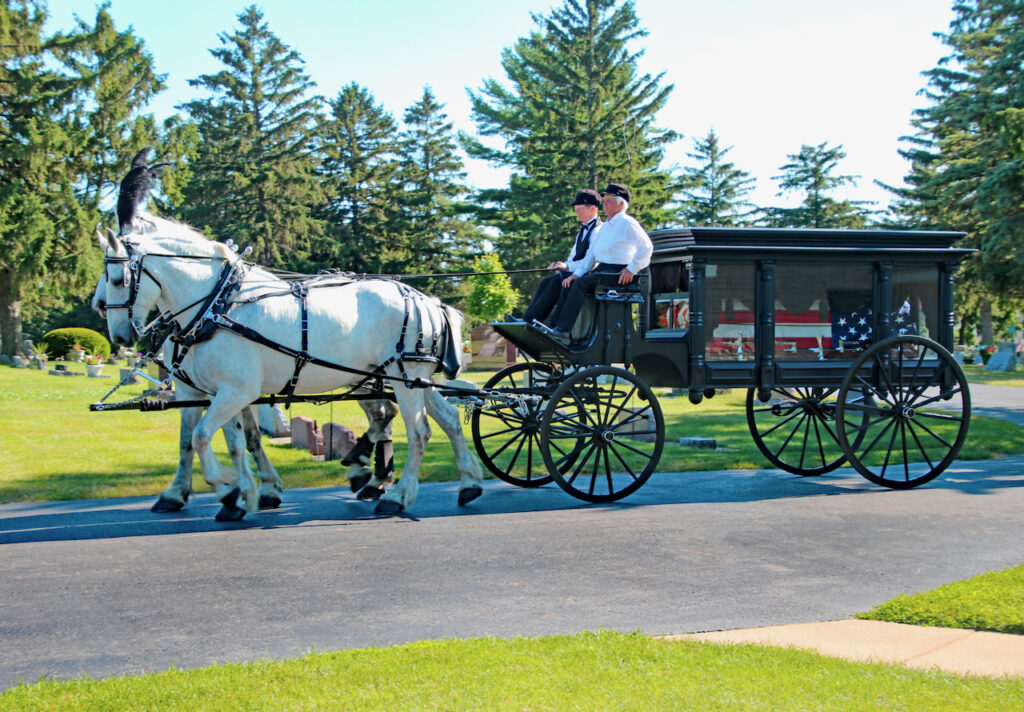

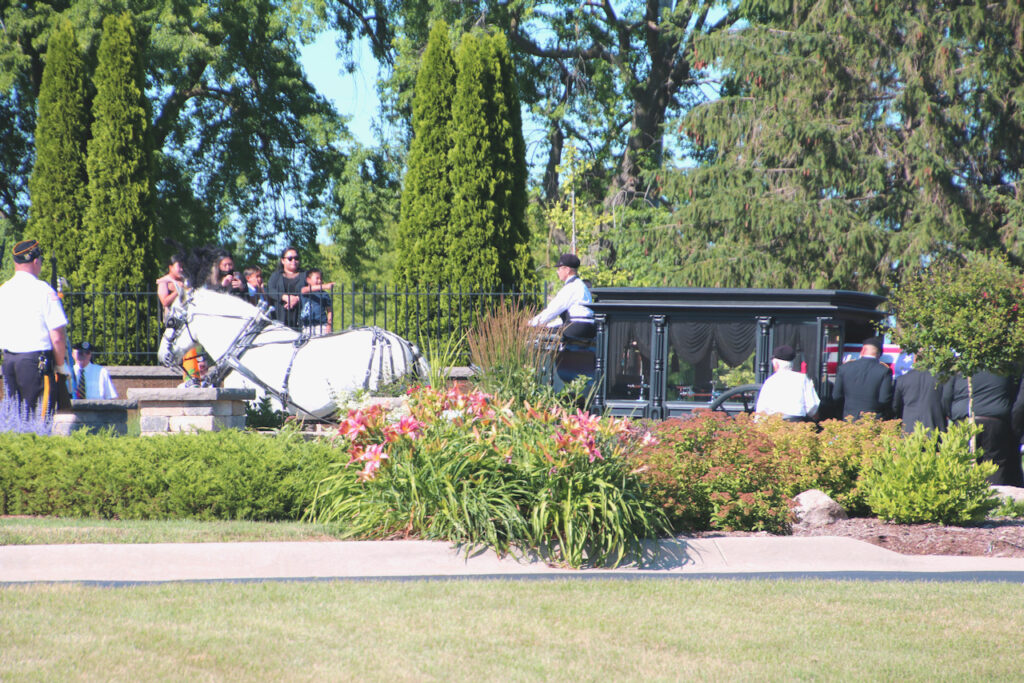
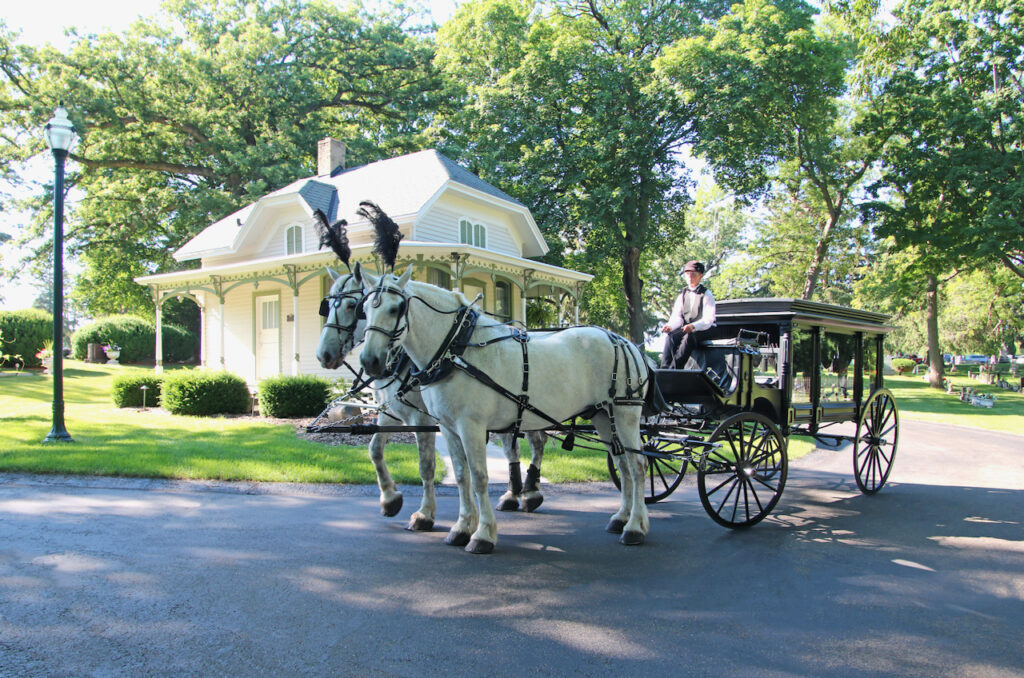
Four photos above: a horse-drawn caisson contracted by the family of Wang Chou Yang brings the late soldier through Evergreen Cemetery and to his final resting place.

An honor guard, arranged and conducted by Fort Atkinson area veterans groups, pays tribute to Wang Chou Yang’s military service during his funeral held in June.
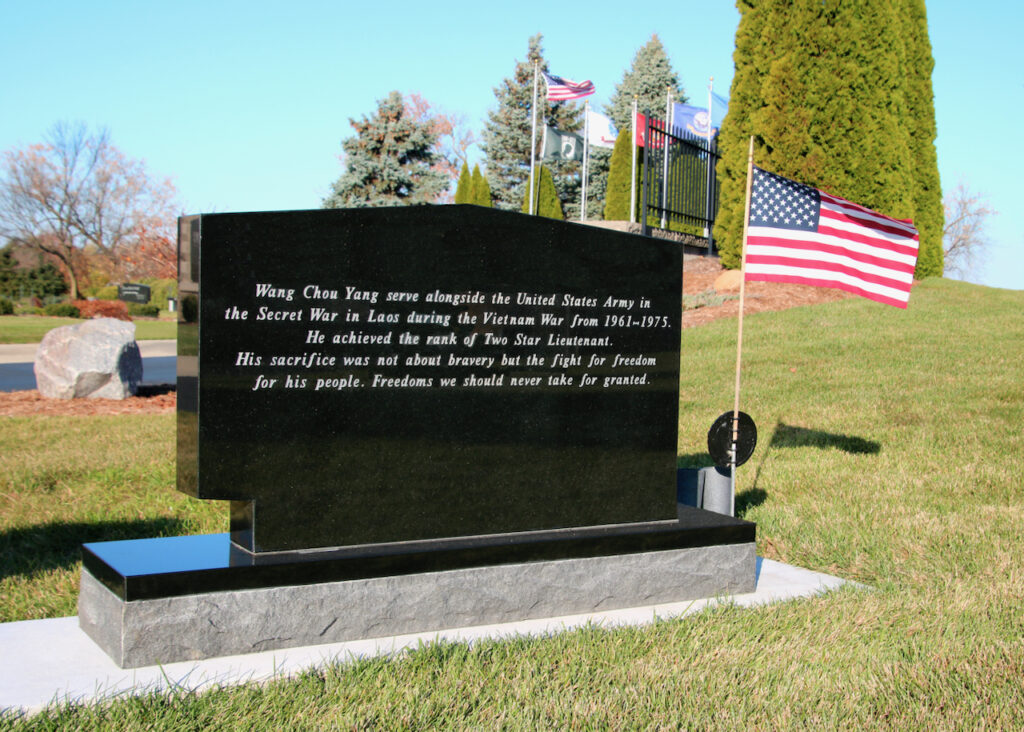
A monument, describing his service during the Vietnam War, identifies the final resting place in Evergreen Cemetery of Wang Chou Yang.
Photos, unless marked “contributed,” are courtesy of Brad Wilcox.
leo.
Becker named Watertown’s strategic initiatives and development coordinator
(Originally published Nov. 18, 2022.)
By Kim McDarison
According to information released by the city of Watertown, Mason Becker, a Fort Atkinson city council member, has been named strategic initiatives and development coordinator.
As published within meeting minutes on the city of Watertown’s website from a Finance Committee meeting held Monday, Nov. 7, Becker was approved for the position by unanimous vote.
He will begin in his new role Monday, Nov. 28.
Within the minutes, Watertown Mayor Emily McFarland was noted to have said that the city received 14 applicants for the position. The mayor “believed that only one was worthy of further consideration,” the meeting minutes reported.
The minutes continued: “Mr. Becker has served in municipal board roles for nine years where he has participated in economic initiatives. He currently has a working relationship with JCEDC (Jefferson County Economic Development Corporation), a plus in securing better interaction with that group for Watertown.”
According to information supplied to Fort Atkinson Online by Becker while running for Fort Atkinson City Council in April of 2021, Becker, who is in his 40s, is a restauranteur with his family’s Subway business. After winning his seat in April of 2021, he is serving his fourth term on the Fort Atkinson City Council.
A 37-year Fort Atkinson resident, he is active in the Fort Atkinson Lions Club, Bethany Lutheran Church and Fort Atkinson Area Chamber of Commerce.
Along with serving as a city council member, Becker ran for a seat on the State Assembly in 2020. He served on the Residence Hall Association Executive Board at the University of Wisconsin-Whitewater.
Becker is a 2002 graduate of UW-Whitewater where he earned his bachelor’s degree in speech communications.
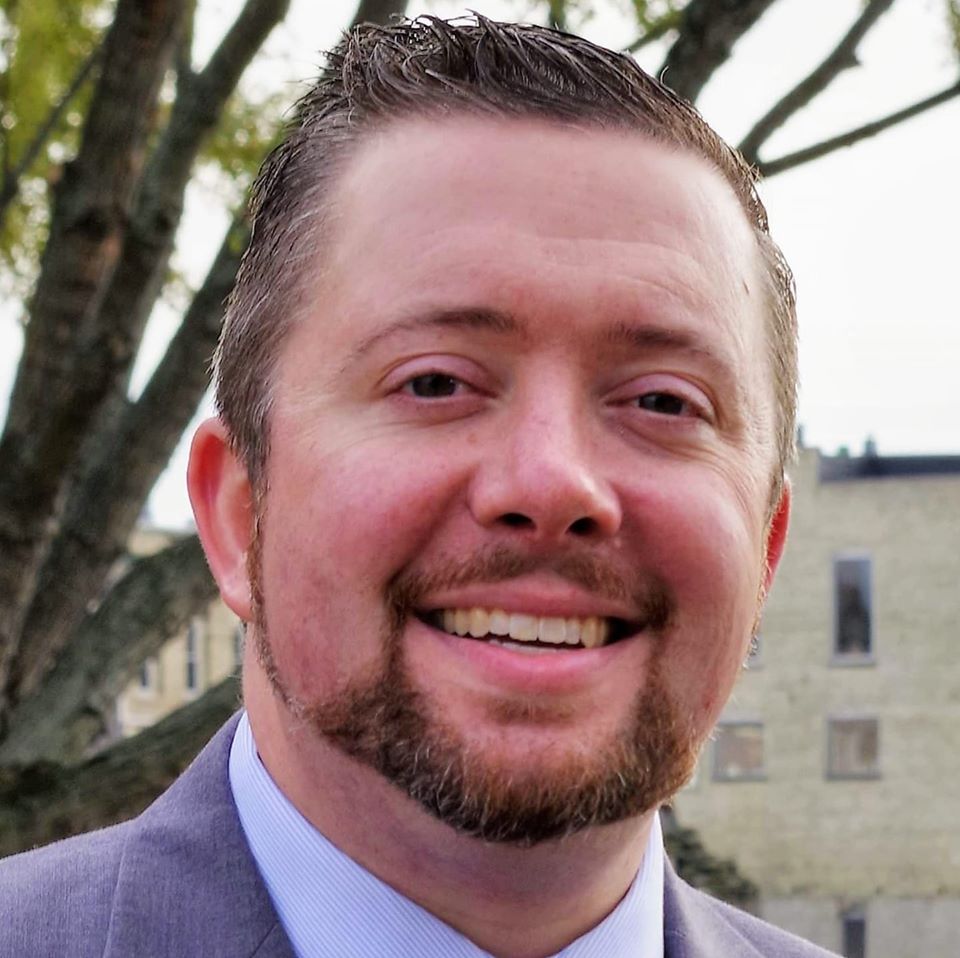
Mason Becker
DPI releases 2021-22 district, school report cards
(Originally published Nov. 19, 2022.)
By Kim McDarison
The Wisconsin Department of Public Instruction (DPI) Tuesday released its 2021-22 school year district report cards.
According to a DPI news release, “a majority of public school districts, schools, and choice schools met or exceeded expectations and have maintained the same ratings compared to the previous year.”
Among data reported for the School District of Fort Atkinson, three of the district’s elementary school buildings and its middle school received “overall accountability scores” of “exceeds expectations,” represented with four stars. The system rates districts and schools using scores, denoted by stars, of 1-5, with 5, signifying the most desirable score.
Barrie Elementary School received a top overall accountability score of “significantly exceeds expectations,” represented by five stars.
The Fort Atkinson High School received an overall accountability score of “meets few expectations,” represented with two stars.
Among data reported for the Whitewater Unified School District, three of the district’s school buildings, Lincoln and Lakeview elementary schools and the high school received overall accountability scores of “meets expectations,” represented with three stars.
Washington Elementary School received an overall accountability score of “exceeds expectations,” represented with four stars.
The Whitewater Middle School received an overall accountability score of “meets few expectations,” represented with two stars.
What are DPI report cards?
DPI report cards, published annually, include data on multiple indicators for multiple school years across four priority areas: achievement, growth, target group outcomes, and an area titled “on-track to graduation.”
Districts are given an “overall accountability score,” placing them, and their schools, into one of five overall accountability ratings: “Significantly Exceeds Expectations,” represented with five stars; “Exceeds Expectations,” represented with four stars; “Meets Expectations,” represented with three stars; “Meets Few Expectations,” represented with two stars, and “Fails to Meet Expectations,” represented with one star.
The cards use up to three years of data, the release noted, including achievement data from the following school years: 2018-19, 2020-21 and 2021-22.
The release stated: “Requirements were waived for the 2019-20 school year due to the COVID-19 pandemic, and report cards were not produced. The DPI urges caution when interpreting scores and ratings due to impacts resulting from the pandemic.”
Overall findings
According to the release, during the 2021-22 school year, 377 public school districts received DPI school report cards, of which 358 met, exceeded or significantly exceeded expectations, which the release noted, was 95% of the districts evaluated.
During the 2021-22 school years, some 2,104 report cards were produced for schools within Wisconsin’s districts. Of those schools, 184 or 9% were unable to be scored and were rated using alternate accountability. Of the remaining 1,920, 1,619 or 84% met, exceeded or significantly exceeded expectations.
Of 1,883 schools receiving report cards in both the 2020-21 and 2021-22 school years, 1,226 experienced no change, 231 increased their positioning by at least one rating category, and 426 decreased their positioning by at least one category.
Additionally, DPI produced 391 report cards for private schools participating in a Wisconsin School Choice Program during the 2021-22 school year. Of that number, 58% were unable to be scored due to the school’s choice student population being too small to meet the conditions required to produce scores. Of the remaining 163 schools, 142 or 87% met, exceeded or significantly exceeded exceptions.
Of the 132 choice schools receiving report card ratings in both the 2020-21 and 2021-22 school years, 72 experienced no change, 17 moved up at least one category, and 43 moved down at least one category.
Individualized 2021-22 data for area districts
School districts within and surrounding the Fort Atkinson Online readership area received the following overall accountability scores:
Fort Atkinson: 68.3, “meets expectations,” three stars. The full report card is here: http://fortatkinsononline.com/wp-content/uploads/2022/11/DRCDetail_Public_Fort_Atkinson_2021-22_006510.pdf.
Whitewater: 61.6, “meets expectations,” three stars. The full report card is here: http://fortatkinsononline.com/wp-content/uploads/2022/11/DRCDetail_Public_Whitewater_Unified_2021-22_004160.pdf.
Jefferson: 64.7, “meets expectations,” three stars. The full report card is here: http://fortatkinsononline.com/wp-content/uploads/2022/11/DRCDetail_Public_Jefferson_2021-22_006733.pdf.
Milton: 68.3, “meets expectations,” three stars. The full report card is here: http://fortatkinsononline.com/wp-content/uploads/2022/11/DRCDetail_Public_Milton_2021-22_006991.pdf.
Palmyra-Eagle: 68.0, “meets expectations,” three stars. The full report card is here: http://fortatkinsononline.com/wp-content/uploads/2022/11/DRCDetail_Public_Palmyra-Eagle_Area_2021-22_003578.pdf.
Watertown: 66.1, “meets expectations,” three stars. The full report card is here: http://fortatkinsononline.com/wp-content/uploads/2022/11/DRCDetail_Public_Watertown_Unified_2021-22_002410-1.pdf.
Janesville: 60.2, “meets expectations,” three stars. The full report card is here: http://fortatkinsononline.com/wp-content/uploads/2022/11/DRCDetail_Public_Janesville_2021-22_006597.pdf.
Delavan-Darien: 62.8, “meets expectations,” three stars. The full report card is here: http://fortatkinsononline.com/wp-content/uploads/2022/11/DRCDetail_Public_Delavan-Darien_2021-22_002730.pdf.
Lake Mills: 71.9, “exceeds expectations,” four stars. The full report card is here: http://fortatkinsononline.com/wp-content/uploads/2022/11/DRCDetail_Public_Lake_Mills_Area_2021-22_006785.pdf.
Elkhorn: 71.9, “exceeds expectations,” four stars. The full report card is here: http://fortatkinsononline.com/wp-content/uploads/2022/11/DRCDetail_Public_Elkhorn_Area_2021-22_002827.pdf.
2021-22 data for schools within the School District of Fort Atkinson
Overall accountability scores earned by each school within the School District of Fort Atkinson follow.
Barrie Elementary: 83.2, “significantly exceeds expectations,” five stars.
Luther Elementary: 78.8, “exceeds expectations,” four stars.
Purdy Elementary: 70.2, “exceeds expectations,” four stars.
Rockwell Elementary: 70.2, “exceeds expectations,” four stars.
Fort Atkinson Middle School, 76.6, “exceeds expectations,” four stars.
Fort Atkinson High School, 57.3, “meets few expectations,” two stars.
2021-22 data for schools within the Whitewater Unified School District
Overall accountability scores earned by each school within the Whitewater Unified School District follow.
Lakeview Elementary: 67.0, “meets expectations,” three stars.
Lincoln Elementary: 58.2, “meets expectations,” three stars.
Washington Elementary, 80.3, “exceeds expectations,” four stars.
Whitewater Middle School, 54.3, “meets few expectations,” two stars.
Whitewater High School, 64.8, “meets expectations,” three stars.
An earlier story about ACT scores is here: https://fortatkinsononline.com/wisconsin-dpi-releases-2021-22-act-act-aspire-forward-exam-scores/
The full DPI release about public and school choice district report cards is here: https://dpi.wi.gov/news/releases/2022/district-school-report-cards.
A portal provided on the DPI website through which individual report cards can be accessed is here: https://apps2.dpi.wi.gov/reportcards/home.
Lorem ipsum dolor sit amet, consectetur adipiscing elit. Ut elit tellus, luctus nec ullamcorper mattis, pulvinar dapibus leo.
Wisconsin Policy Forum report finds local government debt on the rise
(Originally published Nov. 30, 2022.)
By Kim McDarison
The Wisconsin Policy Forum, a nonpartisan, independent policy research organization, recently published a report titled: “Local Debt on the Rise,” which states, among its findings, that statewide, local government debt “hit record levels in 2020,” and is projected to continue to rise.
The report identifies debt, over the last two decades, as being “driven upward by low interest rates, infrastructure needs, and a little-known incentive in state law.
“Even after adjusting for inflation and population growth, debt levels are the highest on record for cities and other municipalities in the state,” the report continued, but, it stated, “while the growth in property values has made it easier for local governments to repay their debts, currently rising interest rates could create new challenges by increasing the costs of new debt and slowing the growth of property values.”
Among its conclusions, the report recommends that policymakers consider options to “slow the growth of local debt, from incentivizing local governments to team up on capital projects and purchases such as a new road or fire engine to giving local governments more flexibility in raising revenues.”
According to the report, total debt owed by local governments within the state rose by 5.4% in 2020, earning it the distinction of being the “highest level on record.”
By year’s end in 2020, local governments, such as cities and counties, owed $11.4 billion, which, the report stated, represented an increase of $566 million over the previous year.
In recent years, the report noted, several factors have driven municipalities to borrow money, counting a need to replace aging infrastructures and update IT systems among them, facilitated by previously low interest rates.
The report further points to the use of “incentivized borrowing,” created through state law, for governments to pay for projects and capital purchases rather than using cash.
“The picture is not all alarming. Counties, for example, have not borrowed so heavily over the past decade and all local governments have benefitted greatly from rising property values that make it easier to pay off their debt,” the report stated.
Additionally, the report noted, that while most debt is owed by cities, “the fastest growth in debt since 2015 has been in Wisconsin towns.”
The report poses the following question: “Given the recent increase in borrowing and the fact that interest rates are now on the rise, … could debt payments begin to crowd out spending on local services such as police, fire protection, parks and libraries?”
According to the report, findings were developed using data from the Wisconsin Department of Revenue (DOR), looking back as far as the year 2000 and included all cities, villages, towns and counties within the state, totaling some 1,920 governments.
The data is derived from financial statements filed by the governments with the DOR.
“The figures deal exclusively with general obligation debt, or debt that municipalities and counties have pledged through property tax levy and other local taxes to repay,” the report stated.
Offering a comparison, the report noted that in December of 2000, cities, villages, towns and counties statewide collectively owed $5.23 billion in general obligation debt. By the end of 2020, the total general obligation debt had more than doubled, and had risen 40.5% after adjusting for inflation.
The report noted: “Most of that increase was due to an increase in debt owed by the state’s 602 cities and villages, which rose from $3.5 billion at the end of 2000 ($5.26 billion in 2020 dollars) to $7.88 billion in 2020, an inflation-adjusted increase of 49.9%. The state’s 72 counties, however, have borrowed less heavily over the past decade and their $2.69 billion in total debt at the close of 2020 was down somewhat from its inflation-adjusted peak of $2.9 billion at the end of 2010.”
Looking at debt as it related to population, the policy forum reported: “When looking at municipalities by their size, debt rose the most from 2000 to 2020 in cities with more than 30,000 residents (144.9%) and barely outpaced inflation in municipalities with 2,500 to 5,000 residents (58.1%). However, the very smallest communities with less than 1,000 residents have also seen somewhat greater growth in debt than mid-sized communities.”
Offering suggestions to explain the trends, the report theorized that while most local governments saw spikes during the Great Recession, debt decreased in the following years. Debt has risen since 2014. The report cited low interest rates, rising needs and costs of infrastructure and other capital projects, and efforts to attract economic development, as causes for increasing debt.
The report further cited state-imposed limits on property tax levies as an impetus for borrowing.
The report stated: “State law limits the amount that local governments can raise property taxes annually for their operations to the rate of new construction in a community. The law, however, also provides an exception equal to the added amount needed to make (general obligation) debt payments, giving towns and other local governments an incentive to borrow for expenses they previously might have paid for in cash.”
In conclusion, the report finds that while debt is “ an essential tool for local governments … for several years, the Wisconsin Policy Forum has been warning that rising debt levels could start to crowd out other spending on key local services such as public safety.”
Further, the report concluded: “rising interest rates, slowing growth in property values and ongoing infrastructure and IT needs will add to the challenges moving forward.”
Included within the report is an interactive tool through which changes within each municipality and county’s debt level over the past 20 years can be viewed.
A link to the interactive tool is here: https://wispolicyforum.org/explore-local-government-debt-levels-in-wisconsin/.
The full report is here: https://wispolicyforum.org/wp-content/uploads/2022/11/Focus_22_21_LocalDebt.pdf.
About the Wisconsin Policy Forum
According to its website, the Wisconsin Policy Forum is a statewide nonpartisan, independent policy research organization with offices in Milwaukee and Madison. It provides informed analysis of critical policy issues affecting local governments, school districts, and the state of Wisconsin. Forum research and facilitation activities encourage elected officials and community leaders to find effective, data-driven solutions to pressing policy challenges, and promote productive discussion among the public and private sectors. To learn more about the forum, visit its website: https://wispolicyforum.org.
Following are depictions of changes in debt level over the last 20 years for several communities within the Fort Atkinson Online readership area.

City of Fort Atkinson
A graph, as developed by the Wisconsin Policy Forum and shown above, depicts both a 20-year trend, between 2000 and 2020, in general obligation debt and general obligation debt as a share of equalized property values in the city of Fort Atkinson. A more detailed view is here: http://fortatkinsononline.com/wp-content/uploads/2022/11/city-of-fort-forum-debt-.pdf.

City of Whitewater
A graph, as developed by the Wisconsin Policy Forum and shown above, depicts both a 20-year trend, between 2000 and 2020, in general obligation debt and general obligation debt as a share of equalized property values in the city of Whitewater. A more detailed view is here: http://fortatkinsononline.com/wp-content/uploads/2022/11/city-of-whitewater-forum-debt-.pdf.

City of Jefferson
A graph, as developed by the Wisconsin Policy Forum and shown above, depicts both a 20-year trend, between 2000 and 2020, in general obligation debt and general obligation debt as a share of equalized property values in the city of jefferson. A more detailed view is here: http://fortatkinsononline.com/wp-content/uploads/2022/11/city-of-jefferson-forum-debt-.pdf.

Town of Koshkonong
A graph, as developed by the Wisconsin Policy Forum and shown above, depicts both a 20-year trend, between 2000 and 2020, in general obligation debt and general obligation debt as a share of equalized property values in the town of Koshkonong. A more detailed view is here: http://fortatkinsononline.com/wp-content/uploads/2022/11/Koshkonong-policy-forum-debt-.pdf.

Jefferson County
A graph, as developed by the Wisconsin Policy Forum and shown above, depicts both a 20-year trend, between 2000 and 2020, in general obligation debt and general obligation debt as a share of equalized property values in Jefferson County. A more detailed view is here: http://fortatkinsononline.com/wp-content/uploads/2022/11/jefferson-county-forum-debt-.pdf.

Walworth County
A graph, as developed by the Wisconsin Policy Forum and shown above, depicts both a 20-year trend, between 2000 and 2020, in general obligation debt and general obligation debt as a share of equalized property values in Walworth County. A more detailed view is here: http://fortatkinsononline.com/wp-content/uploads/2022/11/walworth-county-forum-debt-.pdf.
Becker to seek fifth term on Fort City Council
(Originally published Dec. 11, 2022.)
Editor’s note: information below has been provided by a political candidate announcing his intention to run for office. Other candidates wishing to run for political office will have equal opportunity to announce their intensions.
Fort Atkinson City Councilman Mason Becker announced Sunday that he will be seeking reelection in April, 2023.
Within his announcement, Becker noted that he has served four terms on the Fort Atkinson City Council, and has previously served for a total of three years as council president.
According to the announcement, during his first term, Becker helped spearhead the creation of the Economic Development Commission, which, he said, has helped recently attract new small businesses to Fort Atkinson. He also was involved with the successful passage of the public safety referendum in April 2022, which, he noted, allowed the city to add full-time firefighters and additional police officers, as well as bring public EMS service to the community.
“I am very proud to have been able to work with such a great group of people on our city council, as well as our tremendously talented city manager and staff. It has meant a lot to me to be able to serve my hometown in this capacity. I’m running to ensure the groundwork we’ve laid in so many different areas continues to move forward. This coming year, we plan to break ground on new housing development on Banker Road. We also need to continue planning for a replacement of our current public works facility, as well as make sure our city streets are repaired and updated. We have made tremendous progress these past few years, and I want to help ensure that progress continues,” Becker stated within the announcement.
Becker is part owner of several Subway restaurants in the area, along with his family. Recently, he started a new position as an economic development coordinator for the city of Watertown. He is also the current president of the Fort Atkinson Lions Club. Becker received his undergraduate degree in speech communications from the University of Wisconsin-Whitewater, and is currently pursuing a Master of Public Administration degree through UW-Oshkosh’s online program. He and his wife Laura have two young sons at home, the announcement stated.

Mason Becker
Fort man found guilty of causing mental harm to a child
(Originally published Dec. 16, 2022.)
By Kim McDarison
A 37-year-old Fort Atkinson man has been found guilty of two felony F counts of causing mental harm to a child, according to information released Friday through the Wisconsin Circuit Court Access website.
Appearing Friday before Jefferson County Circuit Court Judge Robert Dehring, Donald Reynolds was sentenced to 10 years for each count, to be served concurrently, with an initial term of confinement in prison of five years and a maximum time served of five years under extended supervision.
Additionally, court records state that any other “sentence in being” will be served by the defendant consecutively.
The two sentences to be served concurrently commenced “forthwith,” with the court granting eight days credit for time already served.
Court records further state that the defendant is not eligible for the Challenge Incarceration Program, also known as “boot camp,” and is not eligible for the Earner Release/Substance Abuse Program.
As part of its condition for extended supervision, the court ordered that the defendant have no contact with individuals identified as “Victim 1” and “Witness 1,” and that he undergo assessment, treatment or counseling, and comply with the sex offender reporting requirements as set forth by the state of Wisconsin.
The court stipulated that “as the underlying conduct in this matter was sexually motivated as defined by state statute … and it would be in the interest of public protection to have the defendant report (as cited by state statute) the defendant shall comply with said reporting requirement for 15 years after discharge from extended supervision.”
Reynolds also was ordered to comply with DNA sample provision upon demand and pay costs, fees and surcharges, including a DNA surcharge, which, the record noted, is $518 for each count.
Reynolds was charged with causing mental harm to a child on June 25, 2021, according to the circuit court website.
Reynolds entered a guilty plea on both counts with the court on Oct. 13, 2022.
On March 8, 2022, Reynolds was charged in Jefferson county with 12 felony D counts of possession of child pornography.
Information released on the circuit court access site states that all 12 counts were dismissed on Oct. 13, 2022, but read into the record as a matter of consideration.
Additionally, court records show that Reynolds was charged on Dec. 14, 2021 with one felony B count of 1st Degree child sex assault/sexual contact with a person under the age of 13.
The charges were filed in Juneau County with Judge Paul S. Curran presiding.
The record states that charges in Juneau County were dismissed and “consolidated into a different county,” on Nov. 10, 2022.
In June of this year, during a preliminary hearing, Reynolds entered a plea of not guilty and the court scheduled a status hearing for Aug. 30, 2022. Reynolds and his attorney, Nathan Tierney Otis, appeared by phone, the court documents state. A return date was scheduled for Nov. 23.
On Nov. 10, 2022, a motion to dismiss was filed and accepted by the court, court records show.
An earlier story reporting not guilty pleas entered by Reynolds regarding the 12 possession of child pornography counts is here: https://fortatkinsononline.com/elementor-68150/.

File photo, public domain.
Fort Council approves resolution urging state lawmakers to review financial system
(Originally published Dec. 22, 2022.)
By Ryan Whisner
The Fort Atkinson City Council Tuesday unanimous approved a resolution, urging the Wisconsin Legislature and Gov. Tony Evers to review the state’s system of funding critical local services.
During Tuesday’s meeting, council members described the current system as “broken,” calling for its repair.
Offering his thoughts on the issue, councilman Eric Schultz said: “It’s been my experience on the city council that some of the issues that face our city sit above the level of our local government, and that the shared revenue model is broken. Even the state representatives locally that I’ve met with basically laughed at the idea of revisiting the shared revenue model.”
Despite those actions, Schultz shared his belief that people continue to vote for those lawmakers whom, he said, don’t share the state tax revenue with local jurisdictions.
“We’ve just seen earlier today that the federal government will help provide money to make improvements in our airport, but I haven’t seen any of that done to improve EMS services or other services within the city,” Schultz said.
He pointed to comments made by a resident who spoke during the public comment portion of the meeting. The resident cited tax increases as being of major concern. Schultz stated that it is the failure of the larger government representation that forces the city to bring items to a referendum.
Advocating on behalf of communities around the state, the League of Municipalities’ priority for the 2023-2024 legislative session is critical local services funding. The intent is to urge state leaders to make a change to a system of funding that, from the municipal point of view, is no longer working.
“These budgeting issues, these property tax changes, this is not a Fort Atkinson-exclusive community problem,” council member Megan Hartwick said. “This is a problem for communities, cities and municipalities across our state because to everyone’s point already, the system is not working. This is Fort Atkinson joining in the League of Municipalities putting this out there.”
Illustrating that support, she cited a letter that the League of Municipalities included with the resolution. It was written by the mayors of Brookfield and Madison. Hartwick noted that, within the first two lines, they reference that the support is coming from one very red community and one very blue community.
“This is not Republicans think it isn’t a problem, that Democrats do, or vice versa,” she said. “This is all city municipality leaders, council people, aldermen, and city managers coming together and saying we are tired of having to go to our community for more money. We are tired of having to ask for public safety referendums (for) services that are critical and necessary. There must be a different way to fund that than to continue to go to the people.”
Hartwick said she believed it was never the first choice of likely anyone sitting at the council table to go to a referendum.
“When you are in a position where that is your only choice, that is the route that we have had to go, and that’s what this is focusing on,” she said. “The city does not just have one full bucket of money that we get to decide exactly how to dispense. There are a lot of restrictions and requirements that the city is legally bound to when it comes to budgeting and setting tax limits and other limits. I think it’s important for people to understand that this is a much bigger, broader issue.”
She said residents are always welcome to question the council members and city staff.
“We welcome that discussion, but we also hope you are having that discussion and asking those questions with the people who are representing our community in Madison, who have a lot more power over changing that structure then we do at this table,” Hartwick said.
As an example of the perceived flaws in the system, Fort Atkinson City Manager Rebecca Houseman LeMire noted that in November, Wisconsin voters faced more than 104 referendum questions asking voters to allow a school district, town, city, village, or county to exceed state limits on local property taxes for public safety, school operations or building projects.
Similarly, in April, Fort Atkinson voters approved a public safety referendum to cover the cost of adding 12 full-time firefighters/EMTs and two additional police officers.
“We are grateful the voters in the city of Fort Atkinson stepped up to support our emergency services, but that’s not the way local government services should be funded,” LeMire said. “Over the last 20 years, state aid for police, fire, and other critical services has steadily declined in real dollars, while inflation has caused average prices to increase by 51%.”
Currently, local governments are primarily funded through property tax revenue and intergovernmental revenue or state-shared revenue. LeMire said Wisconsin is the only state in the country that funds critical first responder services largely from property taxes.
She said within the city’s 2023 budget, 65% of the city’s budgeted revenue comes from property taxes and 19% comes from intergovernmental revenue, for a total of 84%.
LeMire noted that property tax revenue is limited by “levy limits” imposed by state law. This law limits a local government’s ability to increase property tax revenue to the percentage of net new construction for the prior year.
Fort Atkinson’s net new construction in 2022 was .34%, which equated to a levy increase of $22,068. The city manager pointed out that several of the city’s contracted services, such as garbage and recycling collection, are tied to the increase in the Consumer Price Index (CPI) and increased more than the city’s allowable levy increase.
Other funding mechanisms for local government entities are borrowing funds outside the levy limit or seeking voters’ approval to exceed the limit via a referendum process. Fort Atkinson has taken both measures in 2022, leading to a nearly 14% increase in property tax bills that were recently mailed out.
“Borrowing is not an appropriate way to fund annual operations, and the approved public safety referendum amount of $769,335, will never increase,” LeMire said. “These are not growing or sustainable funding sources.”
She said the other major source of revenue for local governments is state-shared revenue, which has decreased substantially over the last 20 years statewide. Fort Atkinson’s has been stagnant for about 10 years with the maximum differentiation being just $4,000 from 2013 to 2022.
The funding for county and municipal aid in 2003 was $938,529,507 and today it is 753,032,613. County and municipal aid payments to Fort Atkinson have dropped from $956,453 in 2013 to $954,318 in 2022, while inflation continues to increase.
LeMire also noted that the state is projecting a $6.6 billion budget surplus as of Nov. 2022.
“Over reliance on property taxes to pay for critical local services must end,” she said. “Local governments need reliable, growing, sustainable, and diverse sources of revenue to continue to deliver top-notch police, fire protection, ambulance services, and safe streets now and into the future.”
The council unanimously supported the referendum in hopes that area state leaders would take note and city residents would reach out to those state representatives for answers.
“There are reasons we have had to ask certain things out of our constituents,” council president Chris Scherer said, citing the public safety referendum. “You have every right to ask us questions and want to know why we are doing stuff, but I think it is also extremely important to remember who you vote for in Madison can affect your quality of life right here in Fort Atkinson.”
As an example of the challenges facing cities across the state, Scherer cited the League of Municipalities information which indicates that fire and EMS costs across the state have increased by 16.7% since 2011.
Council member Mason Becker, who has faced challenges while serving on the city council for four terms, pointed to a particular issue that, he said, is seldom raised: “There is no state department that argues in favor of funding for the local services that municipalities provide,” adding that there is no department of local law enforcement or department of state fire and EMS.
Comparatively, in other states, funding is provided by the state government for some of those services. Wisconsin is currently dead last in funding for local law enforcement.
“It’s a broken system that we have,” Becker said.
He said he didn’t like the property tax system and considers it a failed method.
“I understand it is hurting a lot of people,” he said. “I too don’t like the increase that my property tax bill reflects.” He would like to see the state of Wisconsin go to a model where instead of relying on that one big bucket of funding, that there were multiple little buckets to dip into.
“Right now, that’s all we have and at the end of the day we still have services to provide,” Becker said. “I’m not interested in seeing Fort Atkinson become a city where, if you’re having a heart attack, you don’t know when the ambulance is going to show up or if there’s a fire, it takes a half hour for the fire truck to get there. I don’t think that that would be a way to attract young talent and young families to our community either.”
No matter the funding mechanism, Becker said Fort Atkinson will continue to be a city that provides great services, and hopefully, the state leaders will recognize the failure of the overall funding system.
“They’re (the state Legislature) sitting on a $6.5 billion budget surplus,” he said. “That’s tax money that belongs to all of us, that is not coming back to us. They’re just sitting on it and playing political games fighting back and forth, but they’re not talking about addressing local needs.”
With complete support of the resolution, Becker said he is hopeful, though pessimistic about leaders at the state level taking any notice. “I’m frankly not going to hold my breath,” he said. “We all have to keep doing what we can do at the local level to keep the city going because that’s where we’re at.”
Before the presentation about the resolution, Fort Atkinson resident Ron Martin, speaking during public comments, expressed concern about the increasingly growing tax bills.
He cited some comments he had read about the 14% increase, which he said, he thought summed up the situation. He noted: “It is hard for seniors on fixed incomes trying to afford these property taxes. How long can we keep having these increases and stay in our houses?”
Martin referenced the passage of the public safety referendum, which, he said, allowed the city to run a “gold-plated ambulance service.” Also, he mentioned how all part- and full-time city employees received a 4% raise in the 2023 budget.
“I can understand why there’s an increase, but this crushing tax burden that we have living in the city of Fort Atkinson, I know for a fact is causing people to move or to sell houses or to look for relocating because they can no longer afford to live in Fort Atkinson,” he said.
For those on fixed incomes, seniors, or others who can’t afford taxes and the ongoing inflation, Martin questioned if they must decide between eating, buying their medication, or paying their taxes.
“People are making that decision whether you want to admit it or not,” he said. “People are having to come to grips with making those types of decisions.”
No one spoke at the city’s 2023 budget public hearing, except one resident who praised the city’s transparency in its budget process.
“There are people out here who live in the city that are going to be financially ruined by the tax increases that are continuing to eat away at any savings they might have and we’re in a dire situation here,” Martin said.
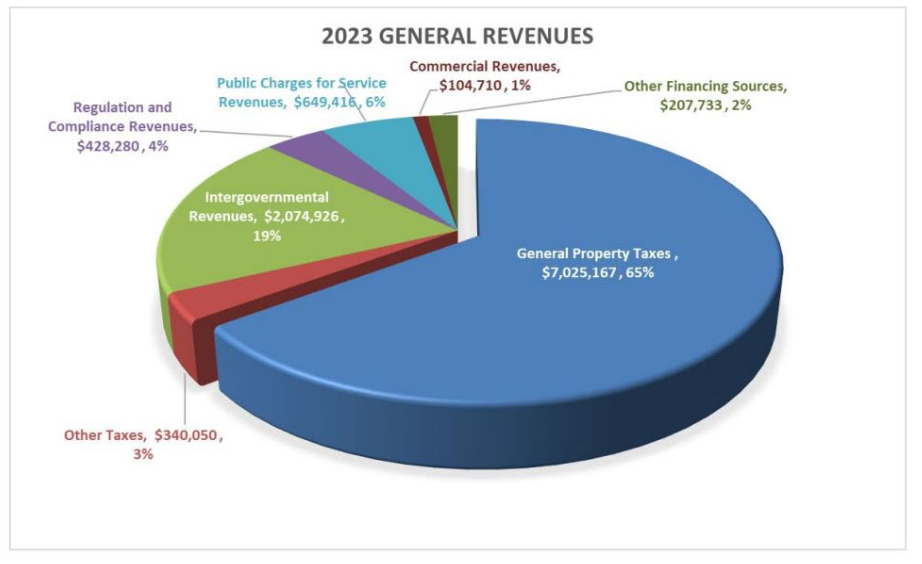
A pie graph indicates from where resources to fund the city come in 2023. General property taxes are indicated by the largest dark blue portion of the graph.
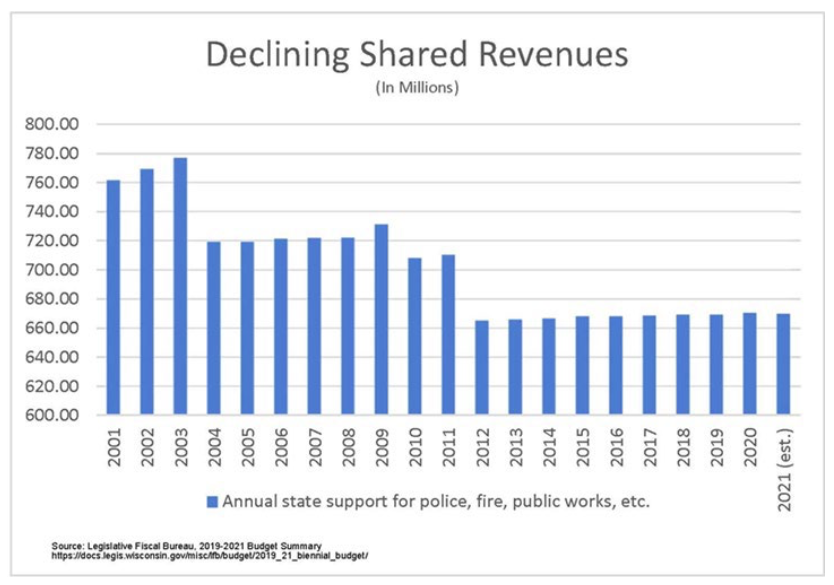
A bar graph shows funding received by the city through shared revenues provided by the state between 2001 and 2020. An amount is estimated for 2021.
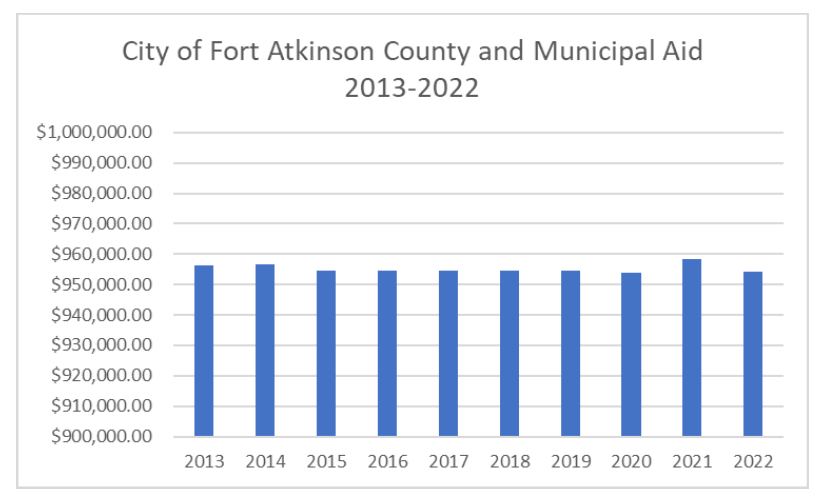
A bar chart shows revenues received by the city through county and municipal aid between 2013 and 2022.
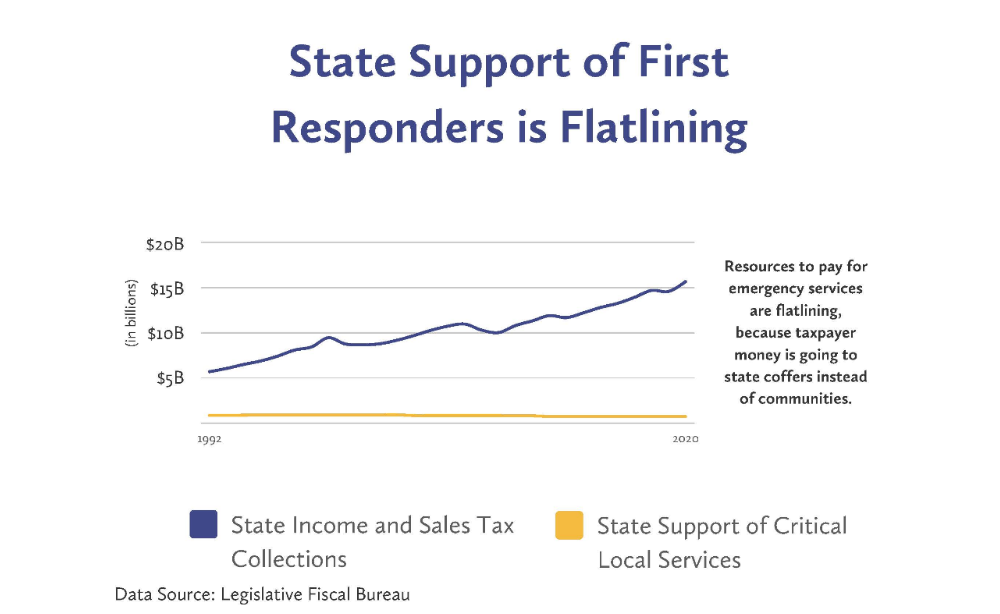
A graphic demonstrates the trajectory for resources used to support emergency services. The graphic shows state support for such services as indicated by the yellow line. The blue line indicates support for emergency services developed through state income and sales tax.
The graphics above are supplied by the city of Fort Atkinson.
Whitewater: Interim leadership team installed at Bethel House
(Originally published Dec. 22, 2022.)
Bethel House, Whitewater, has announced the installation of an interim management team, according to information released by the organization.
The new team includes Megan Hartwick, who formerly served as the executive director of the United Way of Jefferson and North Walworth Counties, and Nicolle Muskevitsch, who is a licensed social worker.
In their interim capacities, Hartwick will serve as executive director and Muskevitsch will handle client case management responsibilities, the release stated.
“Maintaining the stability of our organization and services is of utmost importance to our board of directors. Our entire board has full confidence in the skills and abilities of Megan and Nicolle to assist and support the great work of our existing Bethel House team,” Bethel House Board of Directors Chairperson Jessie Dugan was quoted as saying in the release.
According to the release, Bethel House staff, including Nonprofit Support Coordinator Becca Cohen and Bilingual Case Manager John Roherty will be working with the interim team to ensure continuity of services and operations.
During the interim period, efforts to fill the permanent full-time executive director’s position will be underway, the release noted.
Within the release, Hartwick said: “I am honored to have been asked to join the Bethel House team and support the incredibly life-changing work they provide for families facing homelessness in the Whitewater area. Becca and John have done such a tremendous job leading the organization during this transitional time, and I look forward to providing them the support and relief they need to ensure Bethel House can continue to serve those in need as effectively as possible.”
According to the release, in September, Kristy Weinberg, then-Bethel House executive director, stepped down from her position to pursue new opportunities with The Salvation Army.
Dugan described Weinberg as “an invaluable leader,” who supported the organization for more than 13 years.
Weinberg will continue to support Bethel House, serving in an ex-officio capacity with the board of directors, the release noted.
Hartwick said she has previously worked with Weinberg “in another capacity for the past eight years.”
She described her predecessor as leaving her big shoes to fill, adding that “having her as a resource on the board will only further ensure the success of Bethel House, should provide comfort to the organization’s donors and supporters, and will aid in the process of filling the full-time role in 2023.”
About Bethel House
According to the release, Bethel House is an ecumenical project helping families facing homelessness in the Whitewater area. Bethel House provides transitional housing, emergency financial assistance, and case management to families in need. Bethel House utilizes seven private housing units where families can live for up to one year while working on the issues that led to their homelessness. Case management services include budgeting, debt repayment, job searching, resume creation and building, life skills and decision-making, and accessing other community resources and services.
To learn more about Bethel House and its programming, visit: www.bethelhouseinc.org.

Megan Hartwick
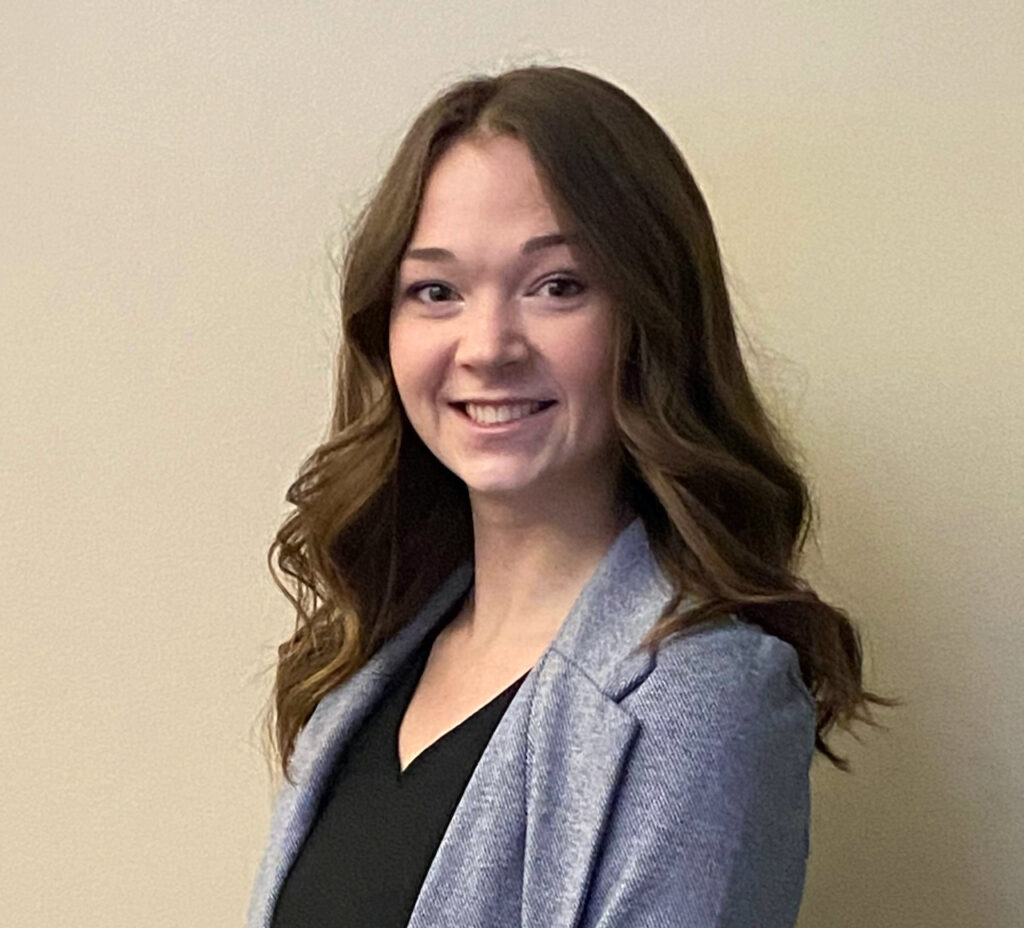
Nicolle Muskevitsch
The year in review: Top 10 headlines from 2022
(Originally published Dec. 28, 2022.)
Fort Atkinson Online has nearly completed its second year in publication. We began in February of 2021. We will celebrate the anniversary of our second full year in publication on Feb. 1, 2023.
To determine our list of the most read stories in 2022, we, once again, consulted the counters placed on our stories, looking specifically at the number of “reads” between Jan. 1 and Dec. 28.
A list of our top 10 most read stories in 2021 is here: https://fortatkinsononline.com/the-year-in-review-top-10-stories-from-2021/.
In 2022, here, in descending order, are our most read top 10 headlines:

1. “Fort resident charged with attempted sex assault of a child, possession of child pornography,” read 24,091 times.
Reported on March 10, the story was developed around a criminal complaint filed by the Fort Atkinson Police Department with the Jefferson County District Attorney’s office bringing 12 counts of alleged possession of child pornography against Donald Reynolds, a resident of Fort Atkinson. Evidence offered within the complaint was collected in June of 2021. At the time, Reynolds also was facing charges of attempted first-degree child sexual assault.
In December, Fort Atkinson Online ran the following headline: “Fort man found guilty of causing mental harm to a child.” The followup story reported that Reynolds had been found guilty of two counts of the charge of causing metal harm to a child and received a sentence of 10 years in prison for each count to be served concurrently. All charges reported in the March 10 story were dismissed by the court.
The full story developed from the criminal complaint filed in March is here: https://fortatkinsononline.com/fort-resident-charged-with-attempted-assault-of-a-child-possession-of-child-pornography/.
The story in which the two counts of causing metal harm to a child were reported, along with the defendant’s sentencing, is here: https://fortatkinsononline.com/fort-man-found-guilty-of-causing-mental-harm-to-a-child/.

2. “Woman dead after being struck by vehicle near Whitewater,” read 22,135 times.
In October, a woman was struck by a vehicle in Jefferson County just north of the city of Whitewater on County Trunk N. Maricela Del Camen Rivas Rivas, 30, of Nicaragua and living in Whitewater, was pronounced dead at an area hospital after succumbing to injuries sustained in the crash. She was married and the mother of a 5-year-old son. A GoFundMe account was opened to raise money to send her body back to Nicaragua.
The full story about the crash is here: https://fortatkinsononline.com/woman-dead-after-being-struck-by-vehicle-near-whitewater/.

3. “Linda Godfrey, who launched ‘Beast of Bray Road’ legend, has died at age 71,” read 16,752 times.
Reported on Nov. 29, the story, sharing news of the death of Linda Godfrey, who lived in Delavan and Janesville, was republished with permission from the online news site Walworth County Community News. The story was written by Dan Plutchak, a former editor of “The Week,” which featured news about Walworth County communities. Godfrey served as a reporter with the publication. She began writing stories about the legend of the Beast of Bray Road in the weekly newspaper in 1991. Bray Road is in Elkhorn. After she began writing about the legend, TV crews began arriving in Walworth County to interview Godfrey, which helped her launch a new career as an investigative researcher. In her new role, she authored more than 20 books, including novels, crime stories and cryptozoology, Plutchak wrote.
The full story is here: https://fortatkinsononline.com/linda-godfrey-who-launched-beast-of-bray-road-legend-has-died-at-age-71/.

4. “One dead, one injured in crash on Twinkling Star Road,” read 14,886 times.
A crash reported in May on Twinkling Star Road in the town of Koshkonong left one person dead and another critically injured. The two occupants were traveling in a vehicle headed northbound when it left the roadway and struck a tree. According to the Jefferson County Sheriff’s Office, both occupants of the vehicle were initially transported to an area hospital with critical injuries. The passenger in the vehicle was pronounced dead at the hospital.
The full story about the single-vehicle crash is here: https://fortatkinsononline.com/one-dead-one-injured-in-crash-on-twinkling-star-road/.

5. “Delavan woman, 92, drives into Madison Avenue building,” read 13,963 times.
Earlier this month, Fort Atkinson Police Chief Adrian Bump confirmed that a 92-year-old Delavan woman had mistaken the gas pedal in her car for the brake while trying to park in front of X-TremeSmoke. As a result, her vehicle accelerated, crashing into the smoke shop, which is located within a strip mall on the city’s north side. Bump reported that no one was injured during the incident, but, he said, there was structural damage to the smoke shop and “moderate” damage to the vehicle.
The full story about the incident is here: https://fortatkinsononline.com/delavan-woman-92-drives-into-madison-avenue-building/.

6. “February Primary Voter’s Guide: Fort school board candidates share experience, views,” read 13,087 times.
A spring primary election in 2022 was held Feb. 15. In advance of the primary, on Jan. 18, Fort Atkinson Online published responses made to questionnaires from six candidates running for two seats on the School District of Fort Atkinson Board of Education. Candidates headed into the primary included Samantha LaMuro, Matt Loup, Dale Prisk, Christopher Rogers, Robynn Selle, and Rebecca Van Ess. Those candidates advancing from the primary to the general election included LaMuro, Loup, Rogers and Selle. After a spring general election held April 5, Christopher Rogers and Robynn Selle emerged as the board’s new members.
The full story including the candidates’ questionnaire responses is here: https://fortatkinsononline.com/february-primary-voters-guide-fort-school-board-candidates-share-experience-views/.

7. Obituary for Luke Joseph Veenhuis, read 10,889 times.
The obituary of Luke Joseph Veenhuis, 30, formerly of Fort Atkinson, reported that he passed away unexpectedly from natural causes at his home on Monday, September 26, 2022. He graduated from Fort Atkinson High School in 2010, was an Eagle Scout, and attended the University of Wisconsin-Whitewater, where he earned both a bachelor’s and master’s degree in computer science. He was employed by Dartmouth College of Hanover, New Hampshire, as a computer research engineer, specializing in artificial intelligence.
His full obituary is here: https://fortatkinsononline.com/luke-joseph-veenhuis/.

8. “Fort Fire Department responds to house fire,” read 9,139 times.
On Sept. 28, the Fort Atkinson Fire Department responded to a fire in the 400 block of Edward St. Upon arrival, firefighters found flames coming from the porch and the first and second floors of the home. Three residents were reportedly living in the house, but, according to Division Chief Dion Brown, only one was at home at the time of the fire. The individual was transported to Fort Atkinson Memorial Hospital to receive treatment for smoke inhalation. A cat was found deceased in the building, which Brown described as a total loss.
The full story about the fire is here: https://fortatkinsononline.com/fort-fire-department-responds-to-house-fire/.

9. “Crowd of 400 welcomes drag queen to Fort market stage,” read 8,924 times.
In June, some 400 people gathered at the Fort Atkinson Farmers Market to watch a performance given by Victorya Atwood, a drag queen. The performance came under some scrutiny and was briefly canceled, with organizers citing “some negative Facebook posts,” as reasons for concern. The farmers market organizers later said after talking with representatives from the Fort Atkinson Area Chamber of Commerce and the police, they opted to continue with the show. On the day of the performance, a Fort Atkinson Online reporter noted that the audience was “appreciative and supportive, with no problems observed.”
In the weeks that followed, some area organizations reported continued negative comments on their social media sites and, as reported by Fort Atkinson Online in June, 14 residents arrived at city hall during a Fort Atkinson Common Council meeting seeking a public apology from council for allowing the performance to occur.
The full story about the performance held at the Fort Atkinson Farmers Market is here: https://fortatkinsononline.com/crowd-of-400-welcomes-drag-queen-to-fort-market-stage/.
A story about the residents who arrived at city hall is here: https://fortatkinsononline.com/residents-bring-comments-to-council-regarding-recent-drag-queen-performance/.

10. “Jefferson County residents included in suit filed to disqualify Johnson, Fitzgerald, Tiffany from running in November,” read 8,469 times.
As reported in May by Fort Atkinson Online, 10 Wisconsin plaintiffs, including two from Jefferson County, filed a civil rights lawsuit in the United States District Court Eastern District of Wisconsin seeking a declaratory judgement to disqualify U.S. Sen. Ron Johnson, and U.S. Reps. Tom Tiffany and Scott Fitzgerald as candidates running for public office. All three are Republican seat holders whose terms end Jan. 3, 2023. In November, all three were reelected to another term.
Jefferson County residents Dan Russler and Leslie DeMuth were among the 10 plaintiffs naming Johnson, Fitzgerald and Tiffany as defendants in a complaint filed with the federal court on March 10.
The complaint alleged: “This action seeks a declaratory judgement … establishing that Senator Ron Johnson and Representatives Tom Tiffany and Scott Fitzgerald, having previously taken oaths as members of Congress and/or the Wisconsin Legislature, engaged in insurrection or rebellion against the United States of America during the period between November 8, 2020 and January 6, 2021 …”
The complaint further alleged: “Ten fraudulent electors from Wisconsin met at the State Capitol on December 14, 2020, the date designated by law, in a room procured for them by Fitzgerald, and committed multiple crimes by preparing and signing documents that falsely asserted that they were duly and lawfully chosen electors from Wisconsin whose votes were entitled to be tallied in the Joint Session on January 6, 2021. The fraudulent electors then compounded their illegal conduct by sending their forged electoral votes to (then-vice president Mike) Pence in his capacity as President of the Senate, without any reservation or condition stating the truth: that the fraudulent electors were not in fact duly and lawfully chosen pursuant to Wisconsin law.”
Additionally, the complaint alleged that “The falsehoods of Johnson, Fitzgerald, and Tiffany about the integrity of Wisconsin’s election procedures began even before citizens were allowed to cast their ballots in the 2020 Presidential Election and continued long after their lies were disproven.”
In June, Fort Atkinson Online ran a story with the following headline: “Judge finds suit against Johnson, Fitzgerald, Tiffany ‘procedurally improper.’” The story reports that the United States District Court Eastern District of Wisconsin granted a motion to dismiss the suit on procedural grounds.
The full story about the filing of the complaint is here: https://fortatkinsononline.com/jefferson-county-residents-included-in-suit-filed-to-disqualify-johnson-fitzgerald-tiffany-from-running-in-november/.
The story about the court’s decision to dismiss the suit is here: https://fortatkinsononline.com/judge-finds-suit-against-johnson-fitzgerald-tiffany-procedurally-improper/.
Jonas, Hall inducted into Fort Wall of Fame
(Originally published Jan. 8, 2023.)
By Chris Spangler
Two honorees — a retired six-sport coach and 1990s basketball standout — have been inducted into the Fort Atkinson High School Athletic Wall of Fame.
Mike Hall, Stillwater, Minn., and Paul Jonas, Wauwatosa, were each honored Friday during a ceremony in the high school auditorium.
“The Wall of Fame recognizes and honors outstanding achievements of individuals, coaches and friends of Fort Atkinson High School who have contributed to the integrity, promotion and growth of athletics …,” Athletic Director Steve Mahoney said in his welcome. “Members of the Wall of Fame have performed at an exceptionally high athletic level and represented the Fort Atkinson High School with high standards of citizenship and character.”
He said the award recognizes people who have been instrumental in creating an excellent athletic tradition with the ideals of Blackhawk pride in the 1Team theme.
Mahoney expanded on that in brief concluding remarks, as well.
“This is a really special year for this Wall of Fame: Two legends coming together. But more importantly is that you guys here are coming in together with them,” Mahoney told the audience of family, friends and former coaches and players. “This is an outstanding group. So many lives in Fort Atkinson have been touched and Paul and Mike have a lot to do with that, but everybody in the audience has to do, as well.”
Mahoney, who is in his seventh year as athletic director, said it was “super special” to be honoring a former classmate and teammate in Jonas and a best friend in Hall.
“This is what Fort Atkinson athletics embody. This is the culture that we share. If every student athlete can come through our programs and have this type of experience and these types of relationships, we’ve done something super successful,” he added.
Serving as master of ceremonies was John Kammer Jr., a member of the Wall of Fame Nominating Committee. He outlined Jonas and Hall’s achievements before each was presented with an engraved glass trophy and invited to say a few words.
Paul Jonas
Jonas, a 1994 Fort Atkinson High School graduate, is an attorney with Michael Best & Friedrich in Milwaukee. He and his wife, Andrea, have a 12-year-old daughter, Josephine, and 10-year-old son, Dominic.
“Paul earned six varsity letters, participating in basketball and baseball,” Kammer said in introducing Jonas. “In basketball, Paul earned four letters playing for Coach Gary Hamm. Paul debuted in a regional tournament game in 1991 with 20 points as a freshman.”
As a sophomore, Kammer said, Jonas earned Second Team All-Badger Conference and was named captain and team MVP (most-valuable player).
“In his junior season, the Blackhawk basketball team was crowned Badger Conference champions. Paul was named 1st Team All-Conference, captain, team MVP, as well as earning Honorable Mention All-State honors by the Associated Press,” Kammer said.
“As a senior, Paul led the Blackhawks to a Sectional final appearance in 1994,” he added. “Fort Atkinson had an 18-game winning streak and finished third in the final Associated Press rankings.”
Also that year, Jonas earned his third team MVP while serving as captain for the third consecutive year.
“The honors continued as Paul was named 1st Team All-Badger Conference and was also named a 3rd Team All-State Selection by the Associated Press,” Kammer said. “Paul was selected to the Wisconsin Basketball Coaches Association (WBCA) All-Star basketball game for his accomplishments on the hardwood, where he led the Class B South team with 24 points in a win over the North team.”
The four-year basketball letter winner finished his high school career having scored 1,511 points on the court while holding the single-game scoring record of 46 points during a game his senior year.
Kammer said Jonas also earned two letters in baseball, and academically, he was a member of the National Honor Society and a 1993 representative to Badger Boys’ State.
“Paul earned Academic All-State WBCA honors his senior year for his dedication in the classroom,” Kammer continued. “To finish his athletic career, Paul was named Athlete of the Year his junior and senior years.”
Jonas received a basketball scholarship to the University of Utah, Kammer said. He redshirted his first season before playing minutes the second. He transferred to Snow College, a junior college located in Ephraim, Utah, where he could contribute in a greater way. Jonas completed his basketball career at the University of Wisconsin-Oshkosh.
“I am so honored to be inducted into this group of individuals, many of whom I’ve known personally and nearly all of whom I know of and all of whom I respect greatly,” Jonas said upon being presented the honor.
He thanked his many friends, former teammates and mentors, including Mahoney — who was a senior on the basketball team when Jonas was a freshman — as well as Brian Kammer.
“Coach (Gary) Hamm, thank you for everything. Thank for specifically for nominating me in this particular instance,” he added.
He also thanked Hall, who arrived in Fort Atkinson during Jonas’ sophomore year, saying it was “really cool that you and I get to go into this club together. … Great memories and congratulations!”
Jonas recalled some memories of his childhood.
“When we were growing up, Fort basketball was just — Fort sports in general, but basketball in particular — was just such a big deal,” he said. “You had these icons — Coach (Don) Gruber, Coach Hamm, Brian Grant, Keith Neubert, Luke Bienfang, John Offerdahl, Mick Smrekar — so growing up, those were the guys we aspired to be like. Going to Coach Gruber’s basketball camp, Coach Gruber would walk in and it’s like, ‘it’s on.’ Sometimes Dave VanderMeulen would be there and it would really be ‘on.’ It was intense. That was the world we grew up in.”
He also recalled, as a fourth-grader at St. Joseph Catholic School, playing basketball in the municipal building gymnasium.
“I remember Coach Gruber and Coach Hamm walking in and it was literally like if Bobby Knight had walked in … for me anyway, it was, like, ‘well all right. That’s about as good as it gets.’ That is kind of how it was,” Jonas said.
He also shared some memories of various games during his stellar career at Fort Atkinson High School.
“My junior year, we had a great team. We ended up 16-5 … There’s no way we should’ve been 16 and 5,” Jonas reminisced. “So we lose at DeForest at the buzzer … the Oregon loss was a missed free-throw.”
The team also lost to Whitewater and then Janesville Craig in the tournament.
“The other loss was double-overtime in Middleton, when allegedly I took an ill-advised three-point shot where maybe if we had just held on for the win, but you know you miss all the shots you don’t take, so I would take that shot again,” Jonas said.
His senior year, the Blackhawks started out 3-3, but that soon changed.
“We had a good comeback at DeForest. Won that game. Went on to win 18 straight,” Jonas said, also remembering the buzzer-beater against Oregon to go to the Sectional final.
“We lost to Baraboo, and that will stick with lots of people in this room for along time, I know, but it happens,” he said.
Jonas also recalled when Coach Hamm once asked the team, “Why do you want to win this game?” Someone said they wanted to “to win this one for all the small schools that never got here,” quoting the film “Hoosiers.”
“Then I was being a punk and said I wanted to win for my dad,” Jonas said. “I was kind of joking around. Years later, I felt bad about that. Coach had a point here: Why do you want to win this game and I made a joke of it. But actually, over time, I did feel bad because I meant it. I didn’t think I did at the time, but I did,” he said, with a catch in his throat.
Jonas shared a few lessons he took from his sports career that have served him well in life.
“I played every role from big star to last man on the bench, sixth man and everything in between, and I think that is such great preparation for life because, depending on the context and circumstances, sometimes you’ve got to lead and sometimes you’ve got to follow and sometimes you’ve just got to be that soldier,” he said. “Sports does such a good job of preparing people for that life test.”
He concluded with a final lesson that he tells his son whenever he doesn’t want to go to basketball practice.
“Dude, you don’t understand. You are going to look back at this in just a few years and think. ‘aw man, I would give anything to just have one more chance to go to practice with (teammates and friends),’” he concluded.
Mike Hall
Mike Hall was an English teacher and coach in Fort Atkinson from 1991-2021, coaching 61 different seasons in six different sports.
“Mike served as the head boys’ basketball coach for nine seasons (1997-2005). During his tenure, Mike led the Blackhawks to two Southern Lakes Conference championships and a trip to the Division I WIAA state tournament in 2002,” Kammer said.
He noted that Hall was named Southern Lakes Coach of the Year in 2001 and 2002, and selected as an assistant coach in the 2004 WBCA All-Star Game.
“As an assistant boys’ basketball coach, Mike was a part of three sectional finals appearances, including a trip to the 1995 WIAA Division 2 State Tournament,” Kammer said. “Mike also served as an assistant girls’ basketball coach for the Blackhawks qualifying for Sectionals in 2012.”
Hall also was a longtime assistant football coach, being a part of 11 WIAA playoff appearances.
“In 2003, the Blackhawks won the Southern Lakes Conference Championship and qualified for the WIAA quarterfinals,” Kammer noted.
In the spring, Hall coached baseball and track. As the pole vault coach, he had two student athletes who went to State, in 2015 and 2016.
“Mike was one of the greatest teachers to teach in Fort Atkinson,” Kammer continued. “In 2011, he received the Kohl Fellowship award for teaching excellence. He won the Wildermuth Award for Excellence in Education in 2019 and was tabbed as ‘Teacher of the Year’ in 2021.”
He also was chosen as national Advanced Placement College Board reader, and led the school’s literary magazine, “The Mark” for many years.
Hall has two children who graduated from Fort Atkinson: Alex in 2018 and Samantha in 2021.
“Coach Hall is one of the most respected educators and coaches to come through Fort Atkinson,” Kammer said.
In Stillwater, Minn., Hall serves as boys’ basketball varsity assistant coach at Baldwin-Woodville High School.
“I am humbled by your nomination and induction,” Hall said before congratulating Jonas on his induction.
He said that after he arrived in Fort Atkinson in 1991, he would find Jonas hard at work in the gym.
“In the mornings, I would come in and work out and shoot baskets, and Paul was already in the gym working on his game,” Hall recalled. “As a sophomore, he and I played one-on-one and I knew even then what kind of a special player he was. Fast-forward two years later, I was an assistant coach whose job it was to guard Paul in practice. Paul and his four horsemen … delighted in dragging me through the defense and giving me my daily bruises.”
Turning to himself, Hall said he was “humbled by this induction and I consider myself extremely fortunate to be included with such an honorable group. Those names on the wall have always meant a great deal to me and to be up there with everyone else is sincerely surreal.”
He shared thank-yous to mentors and others who have influenced him throughout the years. Among them were Don Gruber, whom he called his “adviser, my mentor and my friend”; Jeff Brown, who made sure I was part of his family during my first year in Fort”; and (retired Fort Atkinson Parks and Recreation Department Director) Scott Lastusky, who reminded him that “players’ lives outside of basketball come first.”
Hall also cited Dennis Schwedrsky and Mark Sykes, who “demonstrated how getting athletes to work beyond their expectations can also be fun.”
He noted that he and Sykes also are throat cancer survivors, adding, “I am convinced that had I not watched firsthand Mark’s will and courage throughout all of his cancer experiences, I would never have survived mine.”
He also credited Brian Bosch for reminding him “that it is OK to be human and a coach,” and Lance Riddell, with whom Hall played softball for 25 years, and who also coached football, basketball and baseball for many of those.
”Lance was our Jayvee (junior varsity) coach when I coached the boys and when I coached the girls,” Hall said. “Good jayvee basketball coaches do two things: Get kids better from November through February and prepare them for the next life. Lance was always the master of that.”
He continued: “He also made it his mission to care about his athletes long after the last minute of practice or the final buzzer sounded. I’ve learned so much about how to properly treat others from Lance, and he’s the older brother I never had.”
Hall then turned to Gary Hamm.
“My father was never a sports guy. He was more into music, as was my mother. That actually served me well when I was younger because I was never the one with the overbearing parent who thought he or she knew everything,” Hall recalled. “For as long as I’ve known Gary, he has been a genuine father figure. I have learned so much about basketball when coaching, but so much more about the importance of relationships and about life.”
He pointed out that Hamm served as Gruber’s jayvee coach for 21 years.
“That’s honestly al you need to know about Gary. He’s dedicated, loyal and patient. Never mind that he is the best jayvee basketball coach in Fort’s history, he has become a mentor and good friend to so many of us who have followed in his footsteps,” Hall said.
Hall also said that he has known Matt Noll for more than 20 years, having taught English and coached football, basketball and baseball together.
“Despite our commonality in English and sports, Matt and I, more importantly, shared a genuine concern for each other,” Hall told attendees. “We’re each other’s biggest cheerleader, and the first one to pick the other up when he stumbles. Never have I been in more awe than when I’ve watched Matt meet adversity head-on.
“Though he is 15 years my junior, I look up to Matt and I only hope that I can be half the man that he is,” he added.
Hall then thanked Steve Mahoney.
“I was a cocky college kid who had a passion for coaching when I first met him,” he said. “Like Mark Sykes, Steve and I played basketball together and constantly challenged each other in one-on-one … Eventually, we became each other’s assistant in football and basketball and grew to be best friends. Life is full of givers and takers. We know the takers all too well, because we see so many who only ask for favors but rarely give them themselves.
“Mo is in the other group,” he continued. “He’s the first to give of himself to any and all and never ask for anything in return. Mo and I have served many trials and celebrated many successes. We have endured the death of his father and the challenges of my heart surgery. Mo would never admit it, but he and a select few were responsible for saving my life when I went through cancer and heart surgery. Both Mo and I have brothers; they don’t come close to what Mo and I have.”
Lastly, Hall thanked his children, Samantha and Alex.
“The dirty little secret about coaching is that family takes the hit. They sacrifice more than anyone outside coaching can imagine,” he shared.
Hall said that his daughter spent many afternoons and evenings in my classroom waiting for him to finish practice, and his son cried uncontrollably upon learning that Hall was resigning from boys’ basketball and he never would be able to be coached by his dad.
“That seems like a Hallmark Channel moment, but only because he knew of nothing else,” Hall said of Alex. “Both Alex and Sami have been dragged around Southern Wisconsin scouting trips and coaches’ meetings. Both can film a basketball game without blinking an eye. Without a rudder in hand, children and coaches often ride the waves of adversity and celebrations with their coaching parents. I am truly blessed to have had such supportive children throughout my coaching career. They have served as a constant reminder that family has earned the right to be at the head of the line.”
Hall concluded his remarks saying that, while he is glad to be back in Stillwater, he will never forget Fort Atkinson.
“I’m glad to be near my family and in my old neighborhood, but I will always consider Fort my home,” he said. “The friendships of players, coaches, colleagues and community members that I cherish make this my home. It can be argued that from the early ’90s until now has been the golden era of athletics here in Fort. I know boys’ basketball was very successful during the ’70s and ’80s, but the overall successes in the entire athletic program from 1990 to now cannot be matched. To be a small part of that has been a humbling and rewarding experience.”
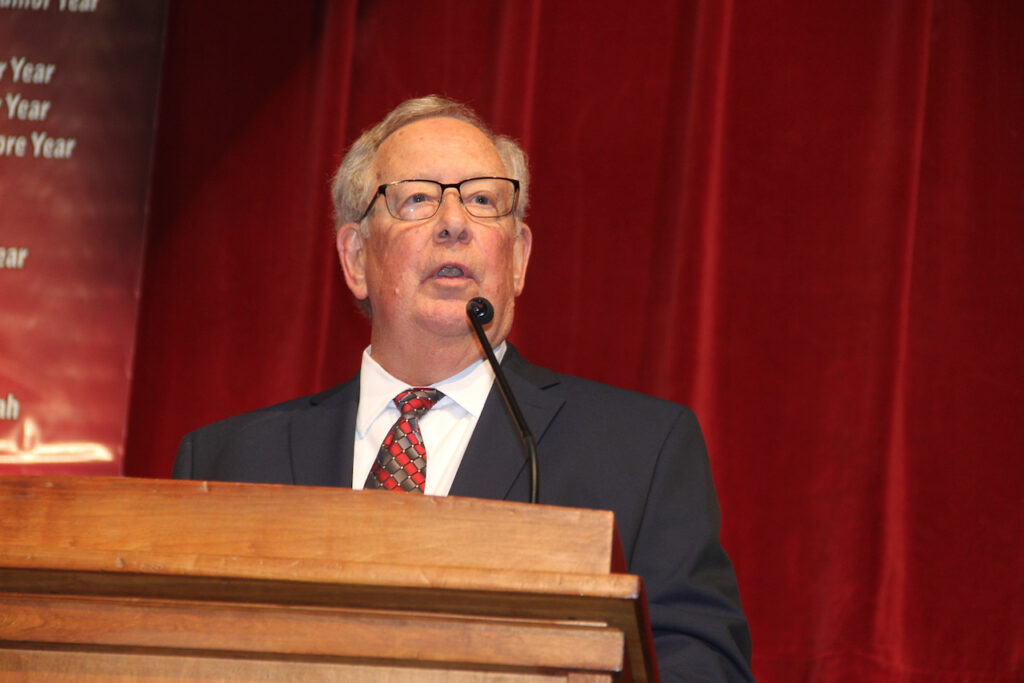
John Kammer Jr., a member of the Fort Atkinson High School Athletic Wall of Fame Nominating Committee, introduces 2023 inductees Friday night.

Paul Jonas, a 1994 graduate and basketball standout, offers remarks and fond memories of his high school years following his induction to the Athletic Wall of Fame.

Mike Hall, at left, a former longtime six-sport coach in Fort Atkinson, is presented the Athletic Wall of Fame trophy.

Former Fort Atkinson coach and honoree Mike Hall addresses induction ceremony attendees.

Athletic Director Steve Mahoney welcomes attendees to the Wall of Fame induction ceremony.
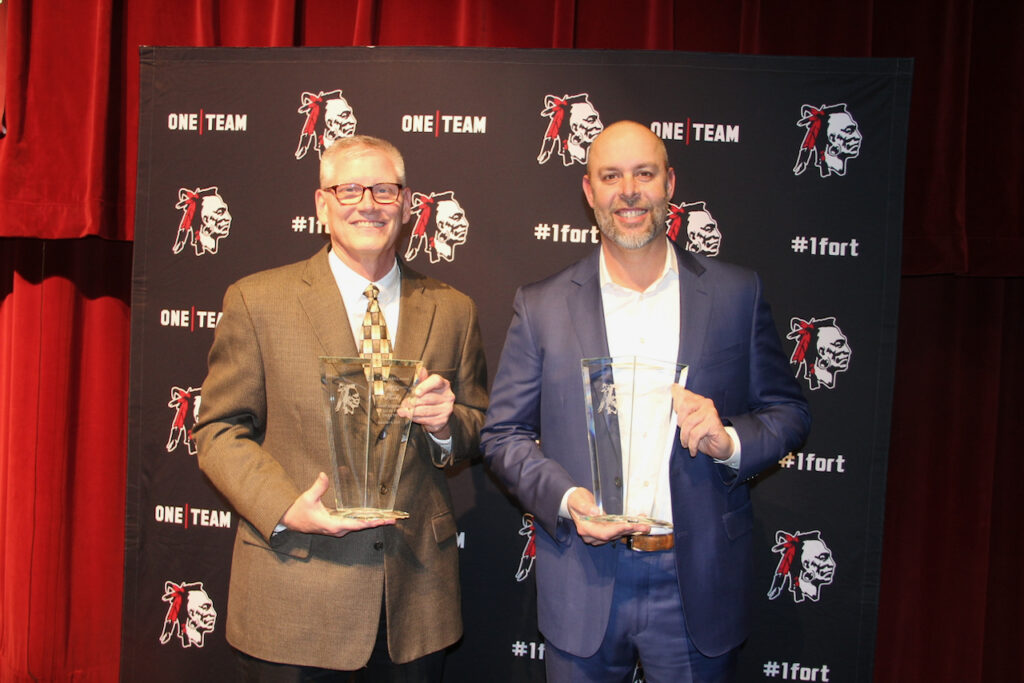
Mike Hall, at left, and Paul Jonas each display trophies received Friday during the 2023 induction ceremony into the Fort Atkinson High School Athletic Wall of Fame.
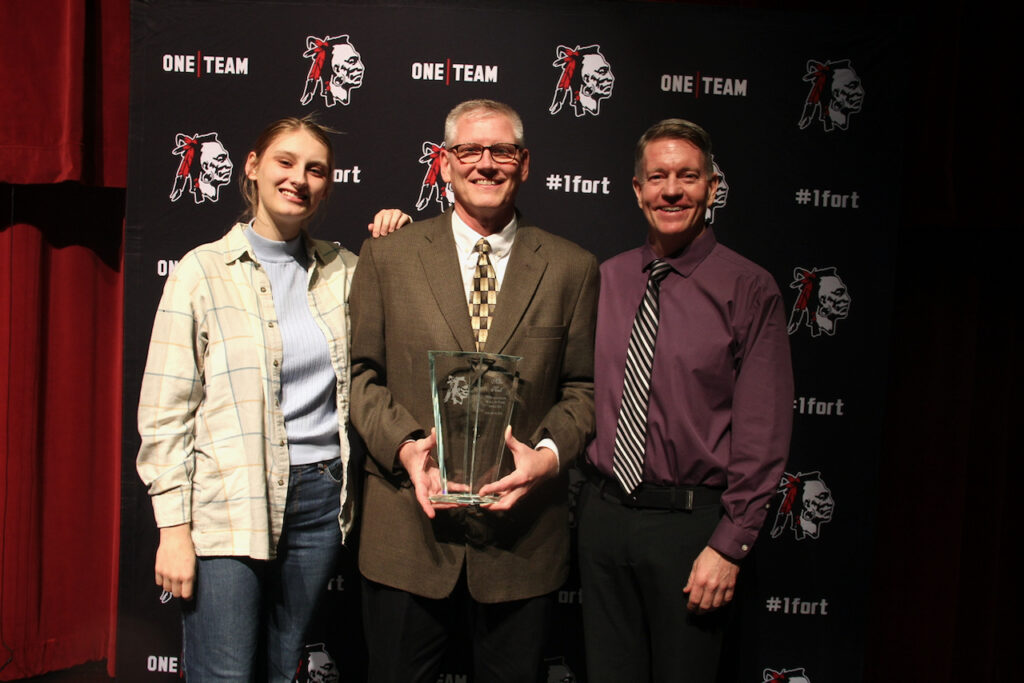
Mike Hall is flanked by his daughter, Samantha, at left, and Athletic Director Steve Mahoney following Hall’s induction into the Athletic Wall of Fame.

Paul Jonas’ children and two family friends, including Elsa Mueller, from left, Dominic Jonas, Will Mueller and Josie Jonas wave “masks” of the Athletic Wall of Fame inductee, depicting his appearance during the early 1990s.

Paul Jonas’ extended family joins him on stage Friday following his induction into the Fort Atkinson High School Athletic Hall of Fame.
Chris Spangler photos.
Fort resident, UW-Whitewater associate professor named Wisconsin Poet Laureate
(Originally published Jan. 15, 2023.)
The Wisconsin Poet Laureate Commission (WPLC) announced earlier this week that Nicholas Gulig, a resident of Fort Atkinson and associate professor at the University of Wisconsin-Whitewater, has been selected as the state’s poet laureate.
According to the release, Gulig began his two-year term Saturday, and will serve until the end of 2024.
In the release, Gulig is described as a Thai-American poet and a “Wisconsinite dedicated to his craft and passionately committed to further cultivating his state’s literary community, his poems and literary history.”
He stood out to the WPLC as exceptional, the release stated.
About Gulig
According to the release, Gulig studied literature at the University of Montana, the University of Iowa Writer’s Workshop, and the University of Denver.
In 2011 he received a Fulbright Fellowship to Bangkok, Thailand during which he completed his first book “North of Order.” Cutbank Books published his second collection, “Book of Lake.” In 2018, his third collection, “Orient,” was a finalist or semi-finalist in 6 national book contests, eventually winning the coveted CSU Open Book Poetry Prize.
As stated within the release, Gulig has been invited to give numerous readings, talks, and lectures across the country by such institutions as Naropa University, Cleveland State University, and the Association of Asian American Studies, among others
Locally, he has twice won the “Wisconsin People and Ideas” poetry award: once in 2017 for a poem titled “The New American Nostalgia,” and this year for a poem titled “Of Genesis.” Gulig has given talks and readings across the state, including for the Chippewa Valley Writer’s Guild where he spoke alongside former Wisconsin Poet Laurette Max Garland.
At the University of Wisconsin-Whitewater he works with young Midwestern writers daily in the classroom.
“With the essayist Barrett Swanson, (Gulig) runs ‘The Muse,’ the campus literary journal, which recently collaborated with the Black Student Union to publish a portfolio of Black student responses to our nation’s persistent racial turmoil,” the release stated.
In addition, Gulig guides the “UWW Creative Writing Festival,” an event that brings more than 600 students annually to the UW-Whitewater campus to take workshops with other students from around the state, and the “Growing Writers Summer Camp,” which focuses on providing middle and high school students access to college-level writing instruction and community, the release noted.
He also founded and curates a variety of reading series, including “The Warhawk Reading and Lecture Series,” “The Lamplight Reading Series,” and the “Faculty Spotlight Reading Series.”
Gulig received a FIRE grant to study the poetry of Lorine Niedecker, conducting research on and recreating Niedecker’s 1966 trip circumnavigating Lake Superior, the release read.
As state poet laureate, Gulig plans to curate a monthly online column devoted to Wisconsin poetry, and curate a “Letters to a Young Poet” program in the spirit of Rainer Maria Rilke. A “welcoming” poetry reading will be open to the public; date and time has yet to be announced, according to the release.

Nicholas Gulig
Multifamily apartments eyed for Fort’s northwest side
(Originally published Jan. 26, 2023.)
By Chris Spangler
The Fort Atkinson Plan Commission on Tuesday got its first look at two multifamily apartment buildings proposed for the city’s northwest side.
Ryan Quam submitted a concept plan of a Planned Unit Development (PUD) for housing at 1310-1320 Campus Drive, on land owned by Tip of The Spear LLC.
According to a memo by city engineer Andy Selle, a “PUD overlay zoning district enables possible relaxation of certain development standards, such as use or setbacks. In exchange for such flexibility, it is expected that the development will reflect the city’s planning policies as set forth in the Comprehensive Plan and offer additional advantages such as positively contributing to the appearance and function of land uses and site design, promoting a greater level of architectural quality, providing substantial buffers and transitions between different land uses or other advantages outlined in the zoning ordinance.”
Tip of the Spear proposes to construct two four-story, 36-unit apartment buildings on the site, which was annexed to the city last year and is in the new Tax Incremental Financing District No. 9. The units would be a mix of one-bedroom, two-bedroom and two-bedroom plus loft apartments, with both underground (below the building) and surface parking.
“Each floor has nine units, three one-bedroom units and six two-bedroom units,” Quam told the commission. “The upper level has loft units. There will be a mix of materials on the sides; We’ve got fiber cement siding, stone veneer, fiber cement panels. Each unit would have its own patio or deck.”
Refuse collection would be located in the underground garage.
Construction of the first building would begin this summer.
“I typically like to break ground and have it open in May, so the goal would be to break ground as early as July 2023 for the phase-one building so it would be available for rent in May 1, 2024,” Quam said. “That hopefully would also provide an indication of how high demand is such that I could break ground on the phase-two building in July or August 2024 so that building could be ready to be open and rented in May of 2025.”
Quam said that the primary access road would be off Campus Drive with a secondary access hopefully onto the high school driveway.
Selle stated in his memo that city staff would continue discussions on the efficacy of the future secondary road with School District of Fort Atkinson, although phase two of the proposed development is not dependent on the outcome of these talks.
Quam told the commission that there will be a wet pond in the southeast corner for stormwater runoff. The design would have to be submitted to the city and state Department of Natural Resources for approval.
He noted that there are some wetlands on the north side of the property and he has done some permitting with the DNR to fill in some “fingers” to accommodate the development.
“It’s kind of a low-lying area. There’s an existing septic field that’s kind of at the end of its life. It’s been stubbed, water and storm to the site; My guess is to accommodate possibly a future road they maybe we’re thinking about putting through here at one point. But it’s kind of asking to be redeveloped, in my opinion.”
Commissioner Jill Kessenich asked about Quam’s plans to save existing trees.
“There are some trees along the high school drive that are going to be saved. The phase-two plan includes a dog park, so the idea would be to maintain the trees in the dog park and also plant that with many more trees. But, for instance, there is a nice big pine tree right on the north edge that I think will have to go, though I really would like to save it. If there is a tree that is on the fringe of being saved, I will bend over backward to save it,” Quam said.
Commissioner Loren Gray asked whether a traffic study had been completed.
Selle said that the city will be undertaking a regional traffic study in the area of the high school, potential middle school and development along Banker Road.
Quam, a civil engineer, said he has developed some similar apartment buildings in McFarland. He served as architect.
“It’s been well-received in McFarland, so the idea is to mimic what we did in McFarland and put the same similar buildings here,” he said.
Quam said he has worked with a Madison builder for all his past projects, but anticipates that local contractors will be considered for work on the project.
A yet-to-be-chosen professional management company will oversee the complex.
The developer said that the rent range will be $1,150 per month for a one-bedroom apartment and up to $1,550 for a two-bedroom and loft apartment.
Kessenich said that, off the top of her head, that sounded high to her.
“I took McFarland rates and dropped them $150,” Quam said. “I will say that the rents have been increasing in McFarland. I don’t know how it is in Fort Atkinson. Where the rates are now and where they’re going to be in a year might be different as well. I’ve got to dial in on that.”
He continued: “The goal is to have, I don’t want to say high-end apartments, but we do have granite countertops, stainless steel appliances and some nice lighting that is attractive.”
City Manager Rebecca Houseman LeMire pointed out that all types of housing are needed in the city.
“Fort Atkinson has not seen an apartment complex like this for many years, probably decades, and this is proposed to be a market-rate rental project. Any additional housing is a good thing in Fort Atkinson right now and even if those rental rates seem high …. it would move people around a bit to open up additional housing that is older or more cheaper and more affordable for other folks wanting to live here in Fort Atkinson.”
LeMire said a market study was done last fall, although she could not recall the rental figures right now.
Responding to a question by Commissioner Davin Lescohier, Quam said the the McFarland apartments are rented by move-in day, and he expects to see a similar occupancy schedule.
“Several years ago, I moved to Fort Atkinson and the first place I tried looking for housing were apartments, and they were very few and far between, especially for what I was looking for,” Commissioner Eric Schultz said.
He said he moved from Sun Prairie, where a studio apartment was going for more than $1,000 a month.
“First, thank you for your interest and investment in our city. … A lot of communities are competing to grow. … Fort Atkinson is an attractive community. We have people who live in town who work in Madison, work in Stoughton, Janesville is close by,” Schultz said.
He pointed out that a house equivalent to his in Fort Atkinson would be sold for more than $100,000 in Sun Prairie.
“You’re looking at Fort Atkinson where possibly other cities are more attractive financially to go,” Schultz told Quam. “I think, based on how much recent apartment additions we’ve had in the city in the past couple decades, this is something I’ve heard many people say that they’ve wanted.”
He said that housing studies, including one from the University of Wisconsin-Whitewater, have shown that Jefferson County will be several-hundred units short over the next 10 years.
“I believe this would be a very welcome addition to the city and hopefully this will be a mutually beneficial venture,” Schultz said.
Tuesday’s presentation was for discussion of the concept plan only. The Plan Commission will review a preliminary certified survey map and hold a public hearing on the proposal on March 14, with a potential recommendation advancing to the city council on April 6.

A artists rendition depicts the south elevation of a proposed apartment building on the city of Fort Atkinson’s northwest side. Contributed.
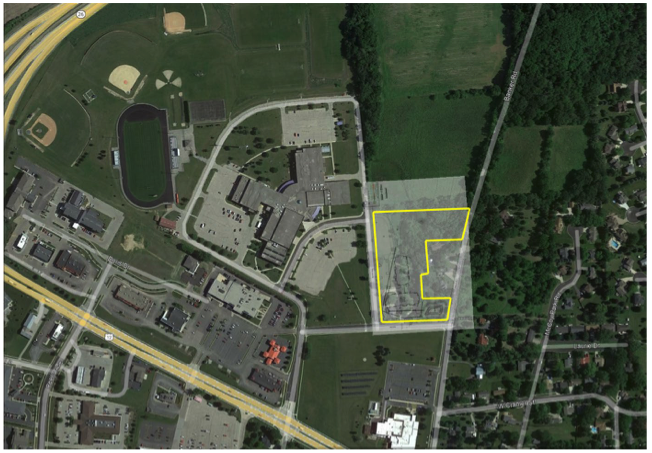
A map shows the proposed location of a complex containing two multifamily apartment buildings on the city of Fort Atkinson’s northwest side. The land is owned by Tip of The Spear LLC. Contributed.
Happy Valentine’s Day: Fort couple recounts adventures spanning a 57-year marriage
(Originally published Feb. 11, 2023.)
By Kim McDarison
While Clarice and Peter “Pete” Fernelius were moving through life as teenagers and in early adulthood on similar paths, the would-be sweethearts did not meet until they were both assigned in the mid-1960s to an Army post in Japan.
After a six-month courtship, they embarked upon what is today a 57-year marriage, and a life journey that ultimately brought them to Fort Atkinson.
Seated together in the living room in their home on Short Street, they reminisced about the years they have spent together. Though they sometimes remembered events differently, and both recalled times that were financial tough, they smiled, as they told their lives’ tale, with a shared sense of humor.
Clarice also shared what she said was an important ingredient to having a long and successful marriage; she summed it up in one word: “care.”
Arriving in California
Clarice said she and Pete are nearly 16 months apart in age, and Pete is the younger of the two.
When Pete was 14, he moved with his family from Utah to California, settling in the San Diego area. He graduated from high school in 1958.
After graduation, he took a civilian job working at a Naval base.
When Clarice was 16, she moved from her childhood home in Illinois, opting to live with an aunt and uncle who lived in California near Oakland. The decision was made, in part, following a set a circumstances that caused some student displacement at Franklin Grove High School. Also, Clarice said, her aunt was a “sweetheart” and she wanted to go. She convinced her parents to let her make the change, she said.
While both teenagers moved to California, they were still nearly 500 miles apart. Clarice attended high school while living with her aunt and uncle, but did not graduate. She instead earned her GED and went to work as a switchboard operator, she said.
In the summer of 1963, Pete was drafted. He was sent to Fort Ord in Monterey where he completed nine weeks of basic training.
Pete was picked for special training in communication intelligence and sent to Fort Gordon in Augusta, Ga. The training lasted for 16 weeks, Clarice said.
In those years, the Army used teletype equipment and he learned about cryptography, Pete said.
Teletype was used to send and receive text-based messages, and cryptography was a process used to encrypt and decrypt messages. It was a means of securing communications, Pete said.
Once his training was completed, Pete was sent to Washington D.C., which was the headquarters for communication specialists. He served at the Pentagon for one week before he was reassigned in March of 1964 to Japan, he said.
In 1963, Clarice said she was operating a PBX, which she described as a type of switchboard, at a children’s hospital in California.
That year, she enlisted in the Army.
She chose training to work with teletype equipment because she thought it would be interesting, she said.
Clarice completed nine weeks of basic training at Fort McClellan in Anniston, Ala., and was next sent to Fort Gordon where she completed the same 16-week course which Pete had earlier taken.
While they arrived at the same installation, she said, they did not meet since Pete had already completed his training. By the time she arrived, Clarice said, it was the spring of 1964.
She next arrived at Fort Knox in Kentucky, and was assigned to a unit that would operate in fields from tanks.
“It was a mistake. The Army did not allow women in tanks. They really wanted a man, so they put me up for reassignment,” she said, adding: “While I was there, I processed deserters and AWALs.”
After a brief stay at Fort Knox, she was reassigned to “the Far East,” she said.
Arriving in Japan
In Japan, Pete said his job was to provide intelligence for his company’s leaders, including the commander, and generals visiting the area.
At the time, he said, the U.S. was engaged in the Vietnam War, but at his base in Japan, his day consisted mainly of receiving information through the teletype equipment and making it easy to read. The information would go into a folder for presentation to the leaders.
He was stationed at Camp Zama, an Army post located in the cities of Zama and Sagamihara, about 40 kilometers, or 25 miles, southwest of Tokyo, he said.
The base is home to Army Military Intelligence and Signal Battalion personnel.
Pete served on the base in Japan for two years, between 1964 and 1966.
Clarice said that while she was awaiting her orders to leave for the Far East, she was returned to an Army base in California near Oakland. She was able to enjoy Thanksgiving and Christmas in 1964 with her aunt and uncle.
After Christmas, she said, she boarded a commercial flight with another woman in the Army and they flew to Tachikawa, a city located in the western portion of the Tokyo Metropolis. There was a U.S. Air Force base there which was used as a staging area. Troops arrived there and were next sent to their various assignments, Clarice said.
Pete said he, too, had arrived at the staging area before arriving at Camp Zama.
Clarice was transported across local roads, which she described as a somewhat harrowing experience, to Camp Zama, arriving in 1964. She, too, stayed until 1966.
A meeting in Japan
While Clarice and Pete worked together in the same communication center, they each worked on different floors, Clarice said.
She recalled that she became a secretary for a warrant officer and she worked in a large office space on the building’s second floor.
Pete worked upstairs, in a vault, she said.
As luck would have it, Clarice said, she did not like her roommate, and as it turned out, another woman who was friends with her roommate was offering to make a switch.
Paired with a new roommate named “Rosie,” Clarice said Rosie invited her to accompany her to a church she attended, and it was there that Rosie introduced Clarice to Pete.
The story brought some pause to Pete. He remembered they met at church, but he didn’t believe he knew a Rosie.
Clarice was confident that Rosie was the one who made the introductions, and said that she often thought it was possible that Rosie might have had a crush on Pete.
Clarice admitted that she took a liking to him right away.
In the weeks that followed, Clarice and Rosie would find reasons to visit Pete. Clarice recalled a visit where they brought him some candy that she had received from her aunt in California.
The three friends attended a church, which was located off base, and often received a ride together from another church-goer.
Eventually, Clarice recalled, Pete called and invited her on a date.
A proposal, a bucket and a mop
Pete and Clarice agreed that they quickly learned they shared similar interests, and they both enjoyed time spent “bumming around,” as Clarice described it, noting that they enjoyed sightseeing in Japan and spending time together.
Six months later, they were married on June 14, 1965.
Describing Pete as a practical man, Clarice said he proposed by handing her “stacks of paper,” which were a request to the base commander for permission to get married.
He’d waited six months, Pete said, which, he noted, “was long enough.”
Clarice said Pete had often said that he didn’t want to get married while the couple was still overseas, but he must have reconsidered.
One of the deciding factors was a potential reassignment for Clarice, they said.
She had earlier been asked to consider attending officer candidate school, which would have required that she return to the U.S. She would also have needed to reenlist.
When she initially told Pete about the offer, Clarice said he suggested that she should look him up if she were ever in San Diego.
Instead, the couple decided to fill out their paperwork, and Clarice did not reenlist. The new plan would allow them to return to the states together, she said.
After receiving permission from the commander, the couple traveled to Tokyo to the Annex of the American Embassy where they were married.
Pete recalled that it cost 80 yen, the equivalent of 24 cents, to have the ceremony performed. The couple received a Japanese marriage license which cost 400 yen, the equivalent of about one dollar, he said.
The document is placed prominently on the living room wall of the couple’s Fort Atkinson home.
They also had a ceremony at their church about a week later attended by friends and church members.
At the time, Pete said, the Army did not pay either of them very much and they lived in poverty.
After they were married, they were allowed to draw a housing allowance.
Pete was “Spec. 4,” which he said was the same pay grade as a corporal, and Clarice was a PFC, private first class, soldier.
“Pete was one rank above me,” Clarice said, “and he made sergeant before we got out.” Before he made the new rank, the couple lived off base.
“We were scraping it,” Pete said.
“When he made sergeant, we got to move on base,” Clarice said.
Clarice remembered that the church friends organized a wedding shower for her and she received as a gift a bucket and a mop.
“Before the shower, we didn’t have a pot to pee in or the window to throw it out of,” Clarice recalled.
“At the shower, I got all kinds of things, and there was cake and flowers. About 30 people attended. They were people affiliated with the military or civilians working for the military,” she said.
Pete extended his tour for six months so they could come home together.
They returned to the states in March of 1966.
California, again
Pete and Clarice returned to California as a married couple traveling on a military flight.
Once they were back in California, Pete had to visit a base in Oakland for one day to get discharged.
The couple moved in with Pete’s family for a short time and Pete found a job with Rohr Aircraft, which, he said, was the same facility he had worked with before being drafted.
In time, Pete’s family moved and gave the house to Pete and Clarice. They lived in California from 1966 to 1973.
During that time, they began a family.
In 1968, they adopted their first child, Kathy, and a few months later, they became pregnant with a second, Lisa, and a few years later, a third child, Mark, was born.
Clarice spent much of the children’s formative years as a stay-at-home mom, she said.
Pete said that, in those years, workers were often laid off from manufacturing jobs. He found himself on the receiving end of those economically-driven decisions several times.
He found work as a civilian, working on the North Island Naval Base.
He worked in teletype like he did while he was in the Army. He was there for about a year. He also returned to school studying math part-time for about three and a half years, taking classes at Grossmont Junior College and then San Diego State University, Clarice said.
Pete said he worked at an egg-packing plant for five years starting in 1968, and then they headed to Illinois.
“Pete was getting laid off because the egg-packing plant closed down,” Clarice said.
A move to the midwest
In 1973, the family decided to move to Illinois.
The move to Illinois was made after a visit to the area to see Clarice’s family.
“I liked the midwest,” Pete said.
So, the young family packed up and made the cross-country move. At the time, the kids ranged in age from that of a toddler to kindergartener.
After a brief stay with family, they moved to a home of their own in Morrison, where they stayed until making a move to Fort Atkinson in 1988.
While they lived in Morrison Pete found work in various factories. He often worked in plants were he could run machines. He worked with a computer-aided lathe system, he said, calling the system “numerically controlled.” He worked with such systems for 15 years, learning how to operate, program, and write programs for the machine.
Between 1973 and 1988, the children grew up and two of the three graduated from high school and began adventures of their own.
When the family moved to Fort Atkinson, members included Pete, Clarice and Mark, who was in his last year of high school.
Mark graduated from Fort Atkinson High School and attended the University of Wisconsin-Whitewater where he studied social studies and psychology, Clarice said.
Today, the couple has six grandchildren, ranging from adult age to 11.
Upon their arrival to Fort Atkinson, the couple leased a home on the city’s south side for a year and moved into the home on Short Street in the fall of 1989.
Life on Short Street
This summer, Pete said, they will have been married for 58 years.
Over the course of that time, Clarice said: “We’ve done everything together.”
A secret to a happy marriage, she said, is learning to “give and take. When you have an argument, you get it settled.”
“I just say, ‘ok, you’re right. Yes, dear,’” Pete said in jest.
“Of course we do fight,” Clarice said, adding: “When I meet people who say they’ve been married for 60 years and never had a fight, I can’t imagine it. They must never spend any time together. We are together 24/7,” she said.
Pete considered the statement. “I do play dartball on Tuesdays,” he said.
Clarice agreed, they do sometimes do things separately.
She noted that Pete retired from work in 2005.
Pete’s last job was at Saelens Manufacturing in Johnson Creek, he said, where they celebrated his retirement with cake.
While in Fort Atkinson, Clarice said she worked at W.D. Hoards and Sons in the office where she entered orders and renewals on a computer.
She also worked at Pick ’n Save in Watertown for 14 years in the cash office and as a front end supervisor. She worked at Sentry in Fort Atkinson and then Festival Foods after the store changed ownership.
Pete worked at Sentry, too, she said. He spent some time there bagging groceries, she said.
As a family, she said, they traveled around together “quite a bit,” and “we took the kids places.”
Pete recalled trips to Niagara Falls and Disney, Washington D.C. and the Hershey Chocolate plant in Pennsylvania.
Today, the couple enjoys spending time at the Fort Atkinson Senior Center. Clarice also volunteers there a few hours each week.
At home, together, the couple tackles jigsaw puzzles.
“It’s good for your brain although we can’t prove it,” Clarice quipped.
They also both enjoy movies on TCM, the Turner Classic Movies network, and they both agreed they like movies with Cary Grant, and most especially “Arsenic and Old Lace,” and “Bringing Up Baby.”
After being married for so long, Pete said he doesn’t really ever get angry with his wife any more.
Clarice said he says what he thinks, and she does, too.
Having a happy marriage, Clarice said: “It isn’t about having a whole lot of money — we’ve never been wealthy — but we’ve always taken care of each other.”
She cited numerous occasions when she was recovering from surgery or illness and Pete was at her side, offering care and comfort.
“He’s always been there and helped take care of me when I needed it. He’s my best friend, definitely,” she said.
Pete, who described himself as a man of few words, listened as his wife described their marriage.
Casting a glance of admiration in her direction, he smiled.

Pete and Clarice Fernelius each hold documents received after they were married. Pete holds a Japanese marriage license which, he said, cost 400 yen, or about one dollar, as part of a wedding ceremony held in 1965 at the Annex of the American Embassy. Clarice holds a Certificate of Witness of Marriage issued by the American Embassy.

Clarice and Pete Fernelius sit at a table in their home where they work together on their most recent jigsaw puzzle. The couple has been married for 57 years.
Kim McDarison photos.
Fort author shares inspiration; releases fourth, final ‘Meena’ book
(Originally published Feb. 15, 2023.)
By Kim McDarison
Parents and educators of children, ages 8-12, are likely familiar with a host of fictional characters.
There’s “Clementine,” “Junie B. Jones,” “Judy Moody,” and “Ramona,” Fort Atkinson-based author of children’s books, Karla Manternach said, and thanks to Manternach, beginning in 2019, when the first in a four-book series was published by Simon and Schuster, there’s “Meena.”
Manternach said the final book in the series, “Team Meena,” was influenced by a host of experiences, including softball teams organized by the Fort Atkinson Parks and Recreation Department, where both of her daughters played in their youth, and where she attended, while writing Team Meena, an “evaluation day” held in the Fort Atkinson Municipal Building gym to gather inspiration and research.
Team Meena was released in hardcover late last month, Manternach said, and while the book closes the chapter on the exploits of 9-year-old Meena, Manternach said it’s not her last book.
She has already completed a book for middle school-aged readers which has been sent to her agent and she is working on a second manuscript.
So who is Meena? And how, and why, did she spring from the imagination of Manternach?
Seated Friday in her Fort Atkinson home, Manternach recounted a multifaceted journey that ultimately led to Meena and her continuing career as a writer.
Life in Anamosa, Iowa
Manternach grew up in the small community of Anamosa, Iowa, with a population of about 5,000 people. While she described the community as surrounded by farmland, she didn’t think of herself as living a rural lifestyle.
“I wasn’t a farm kid,” she said.
Idle time in those youthful years was spent with her three siblings, and especially a younger brother, with whom she engaged in “imaginative play,” she said.
“As a kid, I liked to play outside. We had a big yard and when ‘Star Wars’ came out, we played Star Wars most of the time. We would play the parts of the characters and with action figures when we could get our hands on them,” she added.
At the time, she recalled, lots of television shows seemed to carry a theme of independence: “There were a lot of shows about runaways and people who were out on the road, like the ‘Incredible Hulk,’ so we pretended we were out on the road, and on our own, and our evil family was always after us.
“I had lovely parents, by the way.”
While Manternach’s nuclear family lived in Anamosa, her parents were both from a neighboring town, about 10 miles away, which teemed with members of the extended family.
“My mom was one of 16 kids and my dad was one of six kids. I was one of about 40 cousins,” she said.
The extended family had learned to share: “Everything we had was second-hand. Furniture, clothing, we would get boxes of clothing that went from house to house,” Manternach remembered.
Offering an assessment of herself in those years from her now adult perspective, she said: “I think of myself as a grubby kid. I didn’t like to be clean until middle school. I didn’t want to brush my hair and I remember having battles with my mother about it.”
Also in middle school, she developed an interest in theater, which, she said, “was like the imaginative play taking on an adult form.”
Living some six hours from Chicago, she said, even as a child, “I was in love with musicals, but ‘Phantom of the Opera’ was never going to come where I can see it,” and while she said writing might have been her favorite subject in school, she also poured her time into band and choir.
She played piano, clarinet and sang, she noted, and participated in plays in sixth grade.
In high school, she had to make a choice between continuing in band or choir. She chose band, which meant she could not participate as an actor in musicals. Instead, she performed from the pit with other members of the band.
Still, she said, her love of musicals continued.
“I was listening to musicals all the time and my siblings were in the musicals, which was a sore point. I’ve since healed from the experience,” she quipped.
In the early 1990s, standing tall with 100 of her classmates, Manternach graduated from high school and began a new adventure.
Service and lobbying
After high school graduation Manternach said ancient civilizations had captivated her attention, and she entered Dubuque Loras College, a private Catholic institution, where her time was spent immersed in classical studies and theology. She graduated with a bachelor’s degree in classical studies and a minor in religious studies, and considered attending grad school, but instead, landed on a plan to take a year off and pursue “something different,” she said.
She found the next new experience working for a service-oriented organization, which she described as similar to AmeriCorps in its structure and mission.
She arrived in Baltimore, working in the inner city as a full-time volunteer at an emergency outreach center, she said.
“We worked with clients in crisis; they needed help with food, rent, gas, electric,” she said.
While in Baltimore, she was reunited with a friend, Brian Zanin, whom she had met while attending Loras, and the two began to date.
She also entered grad school in pursuit of her masters degree in theology. She graduated from Washington Theological Union, Washington D.C., in 1998.
While earning her master’s degree, Manternach said she began working as an intern at a Washington D.C.-based lobbying organization called: “Bread for the World,” which focused on issues associated with food and poverty.
After Manternach and Zanin each completed grad school, they made plans to return to the Midwest and marry.
As they considered their return, they had determined that they might like Madison, Wis., but, at the time, neither had a job. An aunt offered an opportunity to the couple to live in her summer home outside of Edgerton, and the couple agreed.
Isolation and freelancing
Manternach described the move to Edgerton from Washington D.C. as “a big move culturally.”
She described her new home as “pretty,” but “isolating.”
After the move, Zanin began working for Campus Ministries at the University of Wisconsin-Whitewater, and Manternach began freelancing.
She turned to her contacts in Washington D.C., looking for projects she could undertake from home. She wrote and edited newsletters and devotional publications, and articles about grants received by organizations and how those resources would be applied, she said.
She also started experimenting with fiction writing, she added.
Her first attempt was a novel for adults, which told the fictionalized story of a group of young people who arrived in Baltimore as volunteers after college, she said.
After a year of working on the manuscript, she said: “I was feeling stuck with it, so when I had kids, I stuck it in a drawer.”
She finished the manuscript after her youngest daughter began kindergarten, she added.
Finding children’s literature, and Meena
Manternach said she and her husband have two daughters, ages 20 and 16. The older daughter is in college and the younger is attending Fort Atkinson High School.
In December of 2001, the couple was expecting their first child and moved to a home in Fort Atkinson.
In this home, they would raise their children, and Manternach said, as a family, they read children’s literature.
“I had no interest in writing children’s books until I had children and started reading children’s literature,” Manternach said.
As she read to her children, and watched them explore the world, and was around other children, she began to see writing children’s books as a fun project, she noted.
“My own children were so entertaining. Children are hilarious. It is just fun to be around kids, and hear their voices, and be inspired by the things they care about, and the way they see the world. The books we enjoyed the most together and inspired me the most were about grade school girls who were funny and quirky, and not well-behaved,” she said.
Nurtured from within this growing new lifestyle, Meena was born, Manternach said, adding that her daughters were entering grades 1 and 4 when she wrote the first Meena book.
Who is Meena?
Musing over the question: Who is Meena? Manternach said her character is modeled primarily after her eldest daughter.
“In the first book, the first thing that happens to Meena is she is diagnosed with epilepsy, and that happened to my daughter. While the story is fictionalized, there is some real world stuff in the first one. I knew what it was like to have a kid having seizures because that happened to us,” she said.
Still, she said, she sees Meena as her own, entirely separate person.
Meena’s adventures are “made up,” Manternach said, “and yet all of the seeds throughout the stories and characters were definitely reflections of real life.”
With the most recently published book completing the series, Manternach said she would not miss her character, because, she said: “I don’t feel like she’s gone.
“I was inspired by my oldest daughter, but I got used to seeing things as Meena would; I don’t think that will stop.”
As an example of how she and Meena might approach the world differently, Manternach said: “Meena finds everything beautiful and interesting. She is likely to pick up trash because she knows she can make it into something cool. I don’t do that at all, but because of having written her, I look at things now.
“She is just always going to keep me company.”
Publishing
Along with writing, Mantenach said, she also needed to learn how to become published.
When she began thinking about writing a children’s book she visited a Barnes and Noble store to see what was on the shelves.
Shelf space was limited, she said, and the titles on display included such choices as “The Boxcar Children” and “The Magic Treehouse.”
She needed a way to compete.
The answer came in finding an agent, Mantenach said. After finishing her first Meena manuscript she offered it for critique. Her understanding of her market and book-writing concept developed over time, she said.
“I had to write a book first and then get the attention of somebody who would be willing to represent it so they can sell your book,” she said.
It took two years before the first Meena book was published, she noted.
“I had only written one when the agent sent it to Simon and Schuster, and they said they had interest, but also wanted a second, so I wrote that, and then pitched a third, and they bought it, and a fourth, and they bought it. And I didn’t pitch any more after that,” she said, noting that after the first book, the next three in the series were each published about a year apart, in 2020, 2021, and last month, respectively.
Looking ahead
Mantenach said her next book has been written for an audience, ages 12-14.
Currently submitted for publishing through her agent, she described it as a “coming-of-age and friendship story.”
She described a second book, now in the manuscript stage as “a reimagining of a classic tale.”
Once that story is completed, she said, “I don’t know if I’ll continue in fiction, and I’m kind of excited not to know.”
She is considering shifting her focus to begin writing for adults.
All four books within the Meena series are available at the Dwight Foster Public Library and on Amazon.com.
A link to the newest story about Meena offered through Amazon is here: https://www.amazon.com/Team-Meena-Zee-Books/dp/1665903929.

Fort Atkinson resident and children’s author Karla Manternach sits in a sunlit writing nook in her home. She is the creator of a series of books about a 9-year-old girl named “Meena.” The series, which is published by Simon and Schuster, has been heralded within the world of children’s literature, with the first book, “Meena Meets her Match,” winning accolades from the New York Public Library, the second in the series, “Never Fear, Meena’s Here!” was selected as an Amazon Editor’s Pick, and the third, “Meena Lost and Found,” was named Outstanding Book of the Year by the Wisconsin Library Association. The fourth and final book in the series, “Team Meena,” was released in hardcover last month. The full series can be found at the Dwight Foster Public Library. Kim McDarison photo.
Highway 12 reconstruction between Fort and Whitewater slated to begin March 6
(Originally published Feb. 15, 2023.)
The Wisconsin Department of Transportation (DOT) recently announced that it will begin reconstruction work on U.S. Highway 12, between County Trunk M, just south of the Fort Atkinson city limits, and Buckingham Road, located to the north of the city of Whitewater.
The project resides in Jefferson County. Work is slated to begin March 6.
The project is anticipated to complete by the end of 2023, information found on the projects.511wi.gov website states.
The construction area will be closed to through traffic while the work is underway. Through traffic will be detouring using State Highway 59 to State Highway 26 to U.S. 12, the website noted.
An overview of the project, found on the DOT’s wisconsindot.gov website, notes that work will begin just north of the Whitewater Bypass and extend approximately 4 miles north to approximately County Trunk M.
Work planned for the segment of roadway includes removing and replacing the existing pavement, base course layer, sub-base course layer, pavement markings, and permanent signing. Improvements will include widening the shoulders and safety zone, modifying three substandard horizontal curves to meet design standards and replacing drainage structures, according to the website.
For traffic reports and additional project updates, visit the DOT’s projects.511wi.gov website.

On orange line on the map above and as provided on the DOT’s website shows the Highway 12 reconstruction area that will undergo work slated to begin March 6. The work is anticipated to complete by the end of 2023. A blue line indicates a detour as determined by the DOT to be used by through traffic while the project is underway.
Fort, Whitewater, Jefferson County officials meet to discuss ‘broken’ funding system
(Originally published Feb. 21, 2023.)
City of Fort Atkinson officials Monday hosted a meeting with state, county and other local level officials to discuss efforts through which they might collaborate to provide services.
An additional focus of the meeting was to “urge the Wisconsin Legislature to fix the broken system of funding critical local services,” information about the meeting released Tuesday by Fort Atkinson officials stated.
The meeting was held at the Dwight Foster Public Library and was aimed at “starting conversations with elected officials in the Wisconsin Legislature,” the news release noted.
Deb Reinbold, executive director of Jefferson County Economic Development Consortium (JCEDC) and president of Thrive ED, offered a presentation during which she discussed what she termed “the shift in economic development strategy and recent local success stories,” the release stated.
Reinbold highlighted the organization’s public/private partnership and explained the overall benefits to Jefferson County, according to the release.
“We are a connector and an ambassador. I’m not going out and building new houses, but I am connecting with developers and going out and meeting with workforce development boards,” Reinbold was quoted as saying in the release.
Additionally, the release noted that the organization’s “strategic plan is working,” citing as an example the city of Fort Atkinson’s Capital Catalyst Revolving Loan Fund, along with the Jefferson County Revolving Loan Fund and additional tools in use to entice businesses to locate in Jefferson County, including, the release stated, partnerships with the Greater Watertown Community Health Foundation, private business and others.
“We are trying to deploy as many incentives as we can to make development happen here in Jefferson County. We need a workforce for businesses to grow. From 2010 to 2020 we only added 1,006 residents. We need to try to engage people to come here,” Reinbold stated within the release.
According to Reinbold, the release stated, the unemployment rate in Jefferson County in December was 2%, and, the release noted, she said the consortium is working with the area’s under-represented populations to help fill some of the jobs in the county that are open.
The county held the first Latino Academy in Watertown to help connect people with jobs and childcare, among other programs, the release continued, adding: “The consortium also is working to keep students in the county after high school to help fill jobs in the area instead of moving away.”
As indicted in the release, Reinbold discussed a video series which she is proposing to the Jefferson County Economic Development and Thrive ED boards geared towards addressing workforce-related topics for high school students.
JCEDC also is partnering with area municipalities to address the lack of housing in Jefferson County, the release stated.
“Affordable housing is an issue, but it’s really housing of all types,” Reinbold said.
Reinbold explained that the vacancy rate in Jefferson County is 2%. The consortium is working with consultants to help municipalities solve some of their housing issues, she was noted as saying in the release.
According to Reinbold, the release noted, there are developers who are interested in building in the county in the next several years, but, she said, an issue facing developers is connected to the amount of rent they can charge in Jefferson County, which, she said, is less than that charged in Dane, Waukesha or Milwaukee counties. The consortium has been meeting with the Greater Watertown Community Health Foundation and a hired consultant to learn how to bridge the gap for developers allowing them to invest in Jefferson County.
A revolving loan fund is among ideas that are being discussed, Reinbold said.
“They all see that Jefferson County is that gateway between Madison and Milwaukee,” she added.
According to the release, officials in attendance also heard comments made by leaders in Watertown, Whitewater, Fort Atkinson and Lake Mills, focusing on the struggle to provide critical services under the current shared revenue funding formula and levy limits.
Within the release, Watertown Mayor Emily McFarland said: “I feel like I’ve been talking about shared revenue and expenditure restraint and local finance reform for as long as I’ve been in local government,” adding that she has worked at multiple levels of government for 10 years.
As noted in the release, “the expenditure restraint program provides targeted, general aid to towns, villages, and cities. The aid is targeted in that municipalities must qualify for a payment by meeting certain eligibility criteria.”
The release stated that in 2017, McFarland said she considered “turning off every other street light” to stay within the expenditure restraint program confines while giving the city’s staff a “small cost of living increase.”
The release stated: “Currently, local governments are primarily funded through property tax revenue and intergovernmental revenue — state shared revenue. Property tax revenue is limited by ‘levy limits’ imposed by state law. The law limits the local government’s ability to increase property tax revenue to the percentage of net new construction from the prior year. The statutes allow for local governments to borrow funds outside of the levy limit and to seek voter approval for an increase in property taxes through the referendum process.”
The release referenced a $1.1 million referendum question which was brought before Whitewater’s voters last November to support expenses associated with fire and EMS services, and a Fire and EMS referendum brought before Fort Atkinson’s voters in 2022.
As quoted in the release, Whitewater City Manager John Weidl said: “These challenges are not unique. Levy limits were designed to force communities into referendums and make it so the threshold is really high. Communities are hitting that threshold and are successful with referendums, but for those that aren’t, they are experiencing the real repercussions of not having the revenues.”
Fort Atkinson City Manager Rebecca Houseman LeMire said: “We saw an increase in our fire calls that required more than a volunteer response. The impact of the referendum was seen on all of our taxpayers.”
In Fort Atkinson, as indicated in the release, LeMire said that the referendum does not have an escalator and will not increase over time, even though the costs of running a fire and EMS service will continue to go up.
She added: “We will blow by expenditure restraint because of the referendum. For our 2024 budget, we will lose over $200,000 from the state because we increased our general fund expenditures past what was permitted for the expenditure restraint program.”
According to the release, Drake Daily, Lake Mills city manager, noted that Lake Mills is in an “unusual spot when it comes to net new construction, which allows a municipality to increase its budget by that percentage, because they had 2.24% net new construction.”
He added: “That allows us to increase our levy by about $65,000. We’re about two police officers behind where we should be and that would cost us about $200,000.”
As stated in the release, Lake Mills also is facing fire and EMS struggles. The Lake Mills City Council decided against placing a referendum question on the ballot in 2023, but is looking at contracted service providers that might cost between $30 and $60 more per capita compared to the $17 per capita the city currently pays for EMS.
“We are actively pursuing economic development. We’ve had success and we have grown and we are still not able to meet the needs of our residents and businesses because of the restrictions from state mandates,” Daily was quoted as saying in the release.
He called for the review of local government funding, the release stated, and added: “Core services are suffering because of it and we need to find a solution. We don’t have the resources to continue doing everything we’ve always done and continue to meet the needs of the future.”
According to the release, Rep. Scott Johnson, (R-Jefferson), attended the meeting and said he understood the needs of local government.
“Half of the state surplus is one-time money. We’re working on it. I have one vote and it’s a learning curve,” he said.
State Reps. William Penterman (R-Columbus) and Ellen Schutt (R- Clinton), were also in attendance, the release noted. Both expressed a willingness to continue an open dialog on the topic and an interest in hearing from their constituents, the release continued.
According to the release, Government Affairs Director for the League of Wisconsin Municipalities Toni Herkert encouraged those in attendance to continue the discussion and to get to know their legislators.
“If we get this across the finish line, we need to thank the legislators who took the vote. This is a huge lift,” she said in the release.
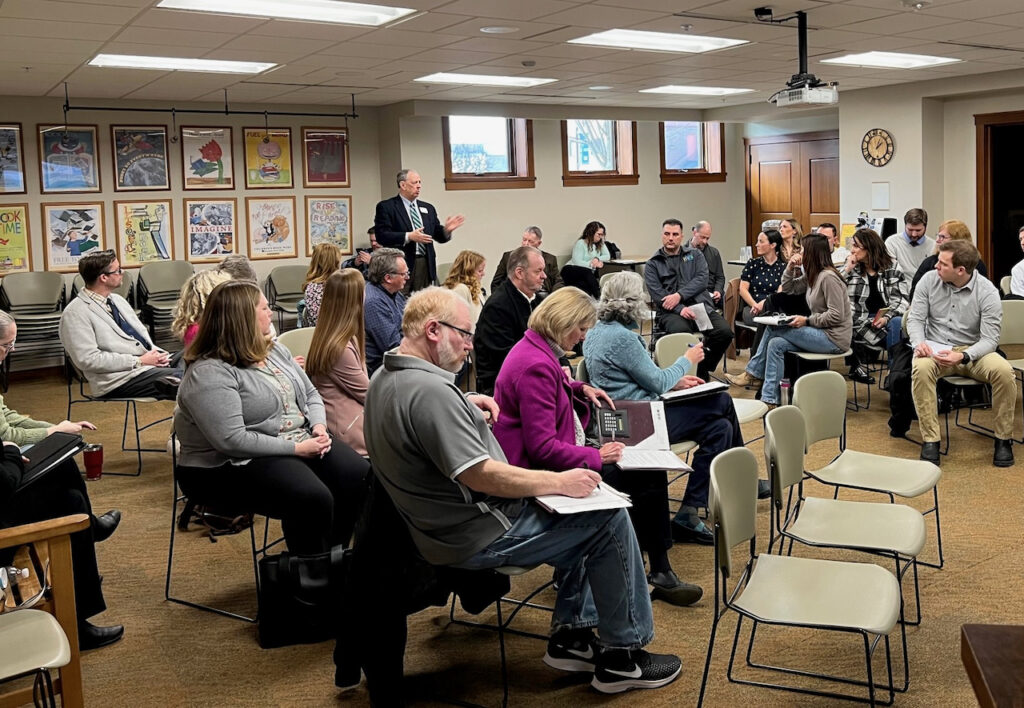
Approximately 30 state, county and local government officials gather to discuss opportunities for collaboration to fund local services. The officials met Monday at the Dwight Foster Pubic Library in Fort Atkinson.
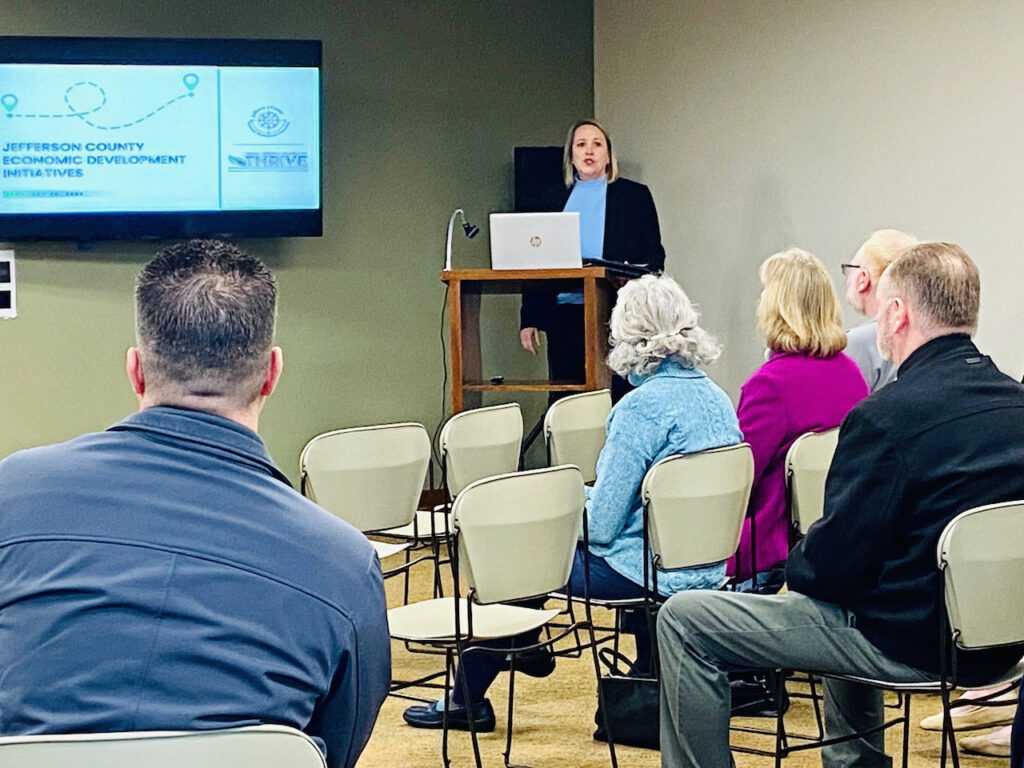
Jefferson County Economic Development Consortium Executive Director Deb Reinbold addresses an audience gathered Monday at the Dwight Foster Public Library.

State Rep. Scott Johnson addresses state, county and local officials in attendance Monday at the Dwight Foster Public Library as they discuss funding for local services and seek to urge the State Legislature to revisit the state’s funding formulas.
Contributed photos.
Fort City Council Voters Guide: Becker, Donohue, Jaeckel run unopposed; share views
(Originally published Feb. 28, 2023.)
Compiled by Kim McDarison
A spring general election will be held Tuesday, April 4. City of Fort Atkinson voters will find three candidates vying for three Fort Atkinson City Council seats on the general election ballot. They are incumbent Mason Becker and newcomers John Donohue and Kyle Jaeckel.
Those elected to council seats serve at large and for two-year terms.
With three candidates running for three seats on the council, each candidate is running unopposed with the exception of a possible challenge from a write-in candidate.
Voters headed to the polls also will find the name of incumbent Megan Hartwick on the April ballot. While Hartwick initially announced her intention to run, she later withdrew from the race. She has requested that voters not cast their ballots for her.
Fort Atkinson Online recently asked each of the remaining candidates to provide some biographical information and fill out a short questionnaire. Candidates were asked to respond to four questions using a combined total of between 700 and 1,000 words.
Candidates were asked to submit a photo for publication.
The electorate also will have an opportunity to see these candidates respond to questions in a videotaped Candidates Forum which will be presented online on this news site and on other online platforms.
A release date for the video will be announced soon.
Election polls on April 4 will be open from 7 a.m. to 8 p.m. at the Fort Atkinson Municipal Building, 101 N. Main St.
Candidates’ responses to questionnaires, presented in alphabetical order, follow.

Mason Becker
Age: 42
Address: 1511 Stacy Ln.
Occupation: Development Coordinator
Number of years resided in city: 39
Education: BA – Speech Communications, UW-Whitewater, graduated 2002.
Currently pursuing Master of Public Administration, UW-Oshkosh.
Civic and other organizational memberships: Fort Atkinson Lions Club (current club president), Bethany Lutheran Church (served on church council for six years). Family business is a member of the Fort Atkinson Area Chamber of Commerce.
Political experience: Serving in fourth term on the Fort Atkinson City Council. Ran for State Assembly in 2020. Served on Residence Hall Association executive board at UW-Whitewater.
What are your reasons for seeking this position?
It has been an honor and a privilege to serve the city of Fort Atkinson for four terms. We still have much important work to continue in our community. When I came onto the council in 2015, our city was struggling in some areas. While there is still progress to be made, our streets are in objectively better shape than they were back then. We are taking a proactive approach to fixing our infrastructure, and this past year saw the successful replacement of the Robert Street bridge. I can also confidently say that we no longer have a reputation for being “anti-business.” Our downtown storefronts are mostly full again, and we even have some retail shopping again on Main Street. In terms of public safety, we recently modernized our emergency services, and other communities are now following our lead. There’s still more we can do to make Fort Atkinson a great place to live and work. I’m particularly concerned with attracting and retaining young talent and young families. If we can keep developing the types of businesses and amenities those individuals enjoy, it’s going to pay off for all of us in the long run.
What are the most pressing issues facing the position you seek?
We have an identified need to continue fostering new construction in our city, primarily two types: residential and commercial. As far as residential housing, we need to continue encouraging both rental and owner-occupied housing. I know it’s been a long time coming, but our investment in 75 acres along Banker Road will soon be paying off. We are already seeing some new apartment buildings that will be coming soon, and more good news will be coming as the year goes on. As far as commercial and industrial developments, we lack something that other communities have: large vacant buildings. That’s not a bad thing: many of the commercial strip malls in town have been filling back up, and our major employers continue to be successful. However, in order to bring new industry and jobs to Fort Atkinson, it’s going to require new construction. With higher construction costs and interest rates lately, the city is going to need to continue taking an active role in encouraging business development. The fact is that developers need assistance right now if they’re going to build in a city our size. Fortunately, our recently created TIF districts will help us foster that type of growth.
What unique perspective do you bring?
I’m the longest tenured member of the city council currently, and I’m also the only incumbent running for reelection this year. I’ve been fortunate to have worked with many great people on our council, who have brought many different perspectives these past few years. Now, I would like to help serve as a bridge to the next set of leaders in our city. It’s great that we have two newcomers who have been willing to sacrifice their personal time to run for local office. We will need more people who are willing to step up and do so in the future. I was also the council president when we hired our current city manager, Rebecca Houseman-LeMire. She has been a tremendous asset to our city, and I look forward to continuing to work with her and the rest of our very talented city staff.
Any additional comments?
Let’s continue with our positive momentum. We have so many tremendous attributes that we can build on in our community: great people, great employers, great schools, and great parks and other outdoor amenities. Sometimes I think in Fort Atkinson, we tend to fall into the habit of thinking “the grass is greener on the other side.” The fact is that many Wisconsin municipalities are looking to Fort Atkinson, and trying to emulate things that we’ve already done. We should be proud of the city that we have, and look to build upon the successes that we’ve accomplished by working together. Even though this election isn’t a contested one, I hope the voters will give me their “seal of approval” to serve for two more years. Let’s all keep making Fort Atkinson a great place to live, work, and play.

John Donohue
Age: 69
Address: 1550 Raveen St., 9
Occupation: Commissioned Officer, United States Army, Retired
Number of years resided in city: 23
Education: Master of Arts, Development Banking, American University, Washington, D.C.; Master of Social Work, University of Wisconsin-Whitewater; Bachelor of Science, Accounting, Strayer University; Bachelor of Science, Management, University of Maryland; Graduate of Fort Atkinson Senior High School, Class of 1971.
Civic and other organizational memberships: Volunteer at Hoard Historical Museum, and the Homeless Coalition of Fort Atkinson.
Political experience: None.
What are your reasons for seeking this position?
I begin by saying what a tremendous privilege it is to be a candidate for Fort Atkinson City Council on the upcoming April 4th ballot. I am grateful to everyone who signed my nomination papers. I have three reasons for deciding to run for council. First, I seek election out of love for this community. My family located here in Fort Atkinson in 1963. In a spirit of reciprocity, it’s time for me to make my fullest possible contribution of public service back to our city. Second, I am completely confident that I will give you, our citizens, every possible personal and professional quality necessary to make our city an even greater place to live, work, and raise our families. I am amply qualified to deal with our community’s challenges. And third, I want every citizen and every section of our community to know they are being fully represented in government. I am at a place in life where all of my energies can be focused entirely in representing our citizens.
I am optimistic that we will continue improving and growing as a successful community. It’s what we do here – we do things successfully. As a member of city council, and in helping to continue our success, I give you broad professional experiences including all that my military service and leadership exemplify, experience working in Washington, D.C., and being a former university educator and administrator. I seek this position because I want to serve you, the citizens.
Public service is a learning process, as well as a process of continuous improvement. I count collaboration and cooperation as among my greatest strengths. Accordingly, a group of us began an organization known as Citizens for a Better Fort Atkinson, which is a venue for sharing ideas and questions about city progress, as well as concerns about how we meet challenges. These questions and concerns are then taken back to city government for responses. This initiative represents “civic education,” as well as civic action. In meeting with citizens and groups thus far, what impresses me so deeply is that Fort Atkinson is truly a place where we take care of each other. We need to uphold this community culture to the utmost. As a member of city council, I am in a position of trust and responsibility to make sure our community caring is maximized.
What are the most pressing issues facing the position you seek?
Our “most pressing issues” represent community priorities – and these community priorities are my priorities as a member of the city council. These priorities are spelled out in the city’s 2023 Operating Budget document. The operational framework was well stated by our city manager in that document: “The 2023 budget meets the goals . . . and reflects the City’s continued commitment to provide a high level of service at the lowest possible cost.”
Our government leadership identified twelve major goals for 2023 in the city budget. This includes, among other things, an already approved and implemented referendum to improve public safety – to add much needed fire and police staffing, and 911 EMS services. In looking beyond 2023, however, there is consensus that we need to grow our tax base to meet increasing costs. The budget needed to properly maintain public services must be kept in check, but the tax burden cannot be carried on the shoulders of limited revenue sources. Expanding the tax base means to encourage and facilitate growth of everything that provides our community with economic benefit, specifically property ownership and the development of commerce. Of the six revenue sources identified in the 2023 budget, nearly 70 percent of total revenues derive from general property and “other” taxes. This is the key portion of tax base where growth is to be encouraged – not the tax itself, but residential and commercial growth and development itself. Both the city of Fort Atkinson and Jefferson County maintain Capital Catalyst Revolving Loan Funds for economic development.
We need to encourage new housing construction of all types as well as downtown retail trade. We also must continue dialog with adjacent communities, state legislators, and the League of Wisconsin Municipalities with respect to state shared revenues, which is referred to as a “broken system.”
What unique perspective do you bring?
Before addressing “unique perspectives,” let’s first understand the city council’s job description as stated on the council’s web page: The city council is the community’s legislative and policymaking body. Power is centralized in the elected council, which, for example, approves the budget and determines the tax rate. The council also focuses on the community’s goals, major projects, and such long-term considerations as community growth, land use development, and capital improvement and financing.
Accordingly, I see the job of councilperson as needing to have a broad view and understanding of issues and challenges, and a foresight to identify and evaluate opportunities.
I enter public service as a member of Fort Atkinson city council having a family history here, as I earlier mentioned. But I return to the community my military service and leadership experience – a strong ability to collaborate with others, organize, administer, and build cooperation. My military career was in the United States Army’s Judge Advocate General’s Corps – the legal branch of the military. I retired as a Chief Warrant Officer Legal Administrator after 27 years of service. As I was winding down my time in the military, I spent twelve years working in the Washington, D.C. law profession, and was also a university instructor. I enter the position of city councilperson with dual master’s degrees, my first being in economic development banking, and my second in social work. I have undergraduate degrees in accounting and management. All of this life experience furnishes me with more of a “unique perspective” than I would have ever hoped for. All of this experience now accrues to public service in and for Fort Atkinson.
Any additional comments?
I look forward to serving you with enthusiasm and accomplishment. Thank you.
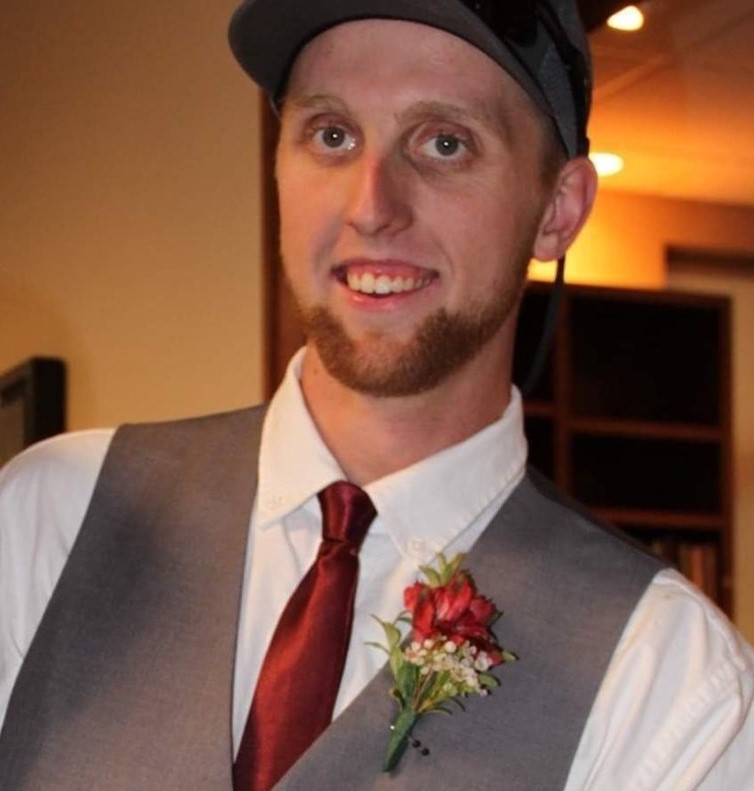
Kyle J. Jaeckel
Age: 25
Address: 715 Messmer St.
Occupation: Construction Operator, Agriculturalist, Fabricator
Number of years resided in city: 3.5
Education: Blackhawk Technical College – 2017; Diesel and Heavy Equipment Technical Diploma; Worldwide College of Auctioneering – 2015, Fort Atkinson High School – 2015 High School Diploma
Civic and other organizational memberships: Bethany Lutheran Church
Political Experience: Candidate for Town of Koshkonong Board – 2018
What are your reasons for running for this position?
The function of local government has always intrigued me. While Fort Atkinson is a great community in which to live and work, I see surrounding communities bringing more opportunities to not only their residents but businesses as well. I want to see Fort Atkinson thrive and grow in areas from family recreation to business development. It is time to aggressively market our community rather than hoping that the city will progress without stimulation. The city council also needs more members that will be fully transparent, stand up for the residents and businesses, and be sure that the city is truly working for its constituents and not its own benefit.
What are the most pressing issues facing the position you seek?
The city is lagging in many areas such as road maintenance, economic development, and housing. Progress has been made in some areas over the last few years, but more needs to be done.
Fort Atkinson has made strides in road maintenance and repair. Funding for these projects through the wheel tax, property taxes, and water bills was necessary to continue these services for the benefit of all. It is also my understanding that the city has several big projects scheduled for the next 5 years that have long needed attention.
Economic development has been stagnant in our community while neighboring cities seem to be growing. Fort Atkinson has a large industrial park that has been nearly vacant for more than two decades. Over the years several businesses have inquired about building their facilities there but have withdrawn because of excessive rules and restrictions. The longer this area sits empty the more economic hurt it puts on our community as a whole. It is time the city revisits those ordinances and looks at what neighboring communities, such as Jefferson and Milton, are doing to fill their unoccupied industrial parks.
Nearly hand-in-hand with business development, I would like to see Fort Atkinson pursue more family recreational activities. UTV/ATV trails, for instance, could not only provide leisure activity but also potential stimulus for local business growth.
The city’s initiative to buy and develop land for residential housing concerns many Fort Atkinson residents. During the time the land is in the city’s ownership, it draws no property tax revenue. It becomes a liability until developers get involved to develop and sell parcels.
What unique perspective do you bring?
I come from a three-generation family business located just outside of Fort Atkinson. We serve many individuals, businesses, and municipalities around the Jefferson County area. Working in communities on all different types of job sites has given me a view of governments that are willing to work with residents and businesses toward the greater end.
Just as in managing a business, I know it’s essential to dive into numbers to ascertain where money can be cut and where it needs to be spent. I am also not afraid to make phone calls, ask questions, and do extensive research to make sure I have a full understanding on a subject before making a decision.
Any additional comments?
I hope to bring my experience from working with my family and for the Town of Koshkonong Department of Public Works to help navigate the city of Fort Atkinson to being a stronger and more economically friendly city. While circulating nomination papers, I enjoyed going door-to-door and hearing residents’ concerns and ideas. As a young father, I want to make sure what we are doing as a council and community will benefit future generations. I would greatly appreciate your support on April 4th to help shape the future of Fort Atkinson.
Fort Board of Education Voters Guide: Two incumbents, one challenger share views
(Originally published March 1, 2023.)
Compiled by Kim McDarison
A spring general election will be held Tuesday, April 4. School District of Fort Atkinson voters will find on their ballots the names of three candidates vying for two seats on the district’s board of education. They are incumbents Kory Knickrehm and Amy Reynolds, and challenger Matt Loup.
Those elected to school board seats serve at large and for three-year terms.
Fort Atkinson Online recently asked each candidate to provide some biographical information and fill out a short questionnaire. Candidates were asked to respond to four questions using a combined total of between 700 and 1,000 words.
Candidates were asked to submit a photo for publication.
The electorate also will have an opportunity to see these candidates respond to questions in a videotaped Candidates Forum which will be presented online on this news site and on other online platforms.
A release date for the video will be announced soon.
Election polls on April 4 will be open from 7 a.m. to 8 p.m.
Candidates’ responses to questionnaires, presented in alphabetical order, follow.

Kory Knickrehm
Age: 39
Address: 1000 Pawnee Court, Fort Atkinson
Occupation: VP Sales, MK Cellular
Number of years resided in the district: 16 years
Education: Bachelor of Business Administration in Marketing (UW-Whitewater), Master of Business Administration (Upper Iowa University)
Civic and other organizational memberships: President of Fort Atkinson Lady Blackhawks, Junior Blackhawk Baseball Coach, Rock River Stix Coach, Fort Boys’ Basketball Association Coach, Current President of District of Fort Atkinson School Board
Political experience: School District of Fort Atkinson School Board 2020-Current
What are your reasons for seeking this position?
My reasons for seeking another term for school board are simple, I’m passionate about quality education and children within our district. Our children deserve the best resources and opportunities that we can provide them and I’m excited about the opportunity to continue doing so. I feel it’s important to have an individual who understands the community and who is open to listening. Throughout my last three years on the school board, I have done a great deal of listening to better understand where we can continue to improve. Secondly, I have become a better board member to understand school spending. As I have discovered, school finance is a complex system. As we continue to move through a period of change I believe that a board member who is always willing to listen while being better educated on school spending is vital.
What are the most pressing issues facing the position you seek?
Undoubtedly, the most pressing issue in front of SDFA is the upcoming operational referendum. The referendum is substantial in the public education landscape in Fort Atkinson. The 6.8 million dollar deficit is 16% of the district operational budget or equivalent to 70 full-time positions. From my perspective, the outcome of the referendum will affect each student in Fort Atkinson. A successful passage of this referendum can be done by maintaining our (public schools tax rate) current tax rate.
Another pressing issue in front of our district is how we continue to provide such a high-level quality education the taxpayers are supporting and expecting. The dynamics of public education have dramatically shifted even since I have been on the school board. What hasn’t changed is the endless effort given by our staff. I am amazed by the dedication and forward thinking that is being done each day in our classrooms. I knew the level of forward-thinking that was happening before I was elected but now that I’ve gotten to witness more of it, we are doing so many amazing things. We have an aggressive, but attainable 5-year strategic plan that launched in the summer of 2021. I am optimistic that we will see an even better school district over the coming years but it doesn’t come without a tremendous amount of work from each member of our district. As you can tell, I’m proud of the work that is being done.
What unique perspective do you bring?
I consider my approach from four different angles. The first is that I have served a term on the school board. There is a significant learning curve to understanding how the school district is operated. My previous experience will help in ensuring that the district is continuing to provide quality education. The second approach has been my involvement in the Fort Atkinson business community. I have worked closely with many of the area businesses and have a close ear on the pulse of the business community. It certainly brings a different perspective to hear what the companies that are hiring our graduates need from our district. The third approach is that I have two children in our district. I have an opinionated 7th grader at the middle school who is always willing to share her ideas and thoughts, along with a 3rd grader at Barrie Elementary who is passionate about his education and recess (not always in that order). Lastly, I’m around the students that directly impact the decisions I make. A good amount of my free time is coaching these students in several sports. From just the kids talking to each other or something a student says to me at practice, I’m around it all.
Any additional comments?
First off, I hope that you get out and vote on April 4th. It’s important to the community that every voice is heard. I’m hopeful that it’s clear that I’m passionate about ensuring the students at SDFA are provided with the best education possible while being prudent on the hard-earned tax dollars. I look forward to the opportunity to serve the School District of Fort Atkinson and the community for another 3 years.

Matt Loup
Age: 52
Address: 61 Shirley Street, Fort Atkinson
Occupation: stay-at-home parent
Number of years resided in school district: 20
Education: University of South Dakota, UW-Rock County, UW-Whitewater
Civic and other organizational memberships: Rock River Coalition, Ice Age Trail Alliance, past president of Heart of the City, FAYSA youth soccer association
Political experience: none
What are your reasons for seeking this position?
I am running for a position on the school board with deep gratitude to the School District of Fort Atkinson (SDFA) and to the larger community.
I believe the most important duty of a school board member is to advocate for students.
I hope to engage with community members to develop sustainable and reliable support for our public schools.
I would like to work with teachers and school administrators to craft policies that benefit students of all backgrounds, interests, and abilities.
What are the most pressing issues facing the position you seek?
Academic Improvement:
SDFA’s strategic plan places academic performance at the center of its goals, and there is always room for improvement. The district’s guiding principles include a commitment to ensure every learner has access to the educational resources and rigor they need and that graduates are career, college, and life-ready. Standardized tests provide a snapshot of a district’s academic performance, but an effective curriculum is the basis for real, lasting success. The school board should regularly consult with educators on the best path for SDFA’s students.
Technology:
Technology is a significant part of the necessary educational resources mentioned above. Comprehensive staff training and support allows for effective student instruction. Technology can also help parents stay involved in their children’s education, giving greater insight into their school career.
Finances:
Unpredictable levels of state funding, as well as increasing diversion of taxpayer money to unaccountable private schools, makes the district’s financial planning more difficult. We know that our most valuable investment is our children’s education. The district must continue its dialog with taxpayers to craft a prudent budget that meets our students’ needs. SDFA’s business services department is dedicated and knowledgeable, and there are opportunities for growth within reasonable spending limits.
What unique perspective do you bring?
Fort Atkinson has an incredible volunteer culture. I’ve been fortunate to participate in many projects that prove the vital relationship between the district and the larger community. From energy (and cost) saving projects, to elementary school learning fairs, to after-school programs and youth sports, SDFA’s staff, parents, and citizens work together to make the place we live and learn more vibrant. I hope to bring to the board a sense of the camaraderie and curiosity I see every day in our district.
Any additional comments?
I believe that healthy public schools are essential to our democracy. They are places where students of all backgrounds come together to develop the skills necessary for self-improvement and civic engagement. When we support our public schools, we are supporting our children; when we support our children, we are supporting the future strength of our community and nation.

Amy Reynolds
Age: 42
Address: W8407 W Grove Rd. Fort Atkinson, WI
Occupation: Patient Access Trainer/ Fort HealthCare
Number of years resided in the district: 10 years
Education: Associate of Applied Science in Insurance Billing and Coding; Associate of Human Services Management; Technical Diploma Nursing Assistant
Civic and other organizational memberships: Girl Scouts Co-Leader and Cookie Coordinator
Political experience: An answer was not supplied.
What are your reasons for seeking this position?
I have been serving on the School Board for the past 3 years and have enjoyed learning and understanding the different roles. For me I love being on the School Board seeing things from a different perspective. Helping to see this wonderful district continue to grow. Even though there have been some ups and downs I would do this again in a heartbeat.
What are the most pressing issues facing the position you seek?
The Operational Referendum. The state is not allocating more funds to any school district to help educate our next generations but there are increases in demand for more services and high quality staff. We need to be able to continue on our growth path.
What unique perspective do you bring?
I’m a mom! I think about things from a different perspective and listen to all sides before I make my decision. I have 4 kids in all three levels of our district so when I make a decision I think about all the kids and staff in each building and how it will affect them.
Any additional comments?
I have really enjoyed serving and would like to do so for another 3 years if the community would allow me. I am always willing to listen to anyone. I might not be able to answer your questions or concerns but I do know who can.
Polling places for voters within the School District of Fort Atkinson
A map of the School District of Fort Atkinson can be viewed here: https://www.fortschools.org/cms/lib/WI02211243/Centricity/Shared/District/boundary.pdf.
The polling place for all city of Fort Atkinson residents is the Municipal Building, 101 N. Main St.
Polling places for rural residents living within the School District of Fort Atkinson include the towns of:
Koshkonong, W5609 Star School Rd.
Oakland, N4450 County Road A
Jefferson, 434 County Road Y
Cold Spring, N1409 Fremont Rd., Whitewater
Lima, 11053 Willow Dr., Whitewater (Rock County)
Hebron, N2313 County Road D.
Palmyra, 100 W. Taft St.
Sumner, N1525 Church St., Edgerton
Fort School District Business Services Director Demerath resigns
(Originally published March 26, 2023.)
By Kim McDarison
The School District of Fort Atkinson Board of Education accepted earlier this month the resignation of the district’s Business Services Director Jason Demerath.
Addressing the board during its meeting held Thursday, March 16, Demerath said he had accepted a position as executive director of financial services with Wisconsin’s CESA-2. His last official day of working in the school district will be June 30.
A CESA, according to the organization’s website, is a Cooperative Educational Service Agency network, developed to make possible the sharing of resources, such as staff and equipment, along with helping member districts save money while extending educational opportunities. Each CESA serves member districts bounded within its region. In Wisconsin, there are 12 CESAs, all of which work, in conjunction with the Department of Public Instruction, to serve needs of schools and children in their respective regions.
Additionally, a CESA website, noted: “CESAs provide these services without mandates, without levying taxes, and with no state aid.”
Addressing the board earlier this month, Demerath, reading from a prepared statement, said: “After nearly 15 years of serving the Fort Atkinson community, it’s with mixed emotions that I come before you this evening asking for your approval of my resignation as director of business services for the school district, as I’ve accepted a position as the executive director of financial services with CESA 2.
“This new professional opportunity will allow me to blend my passion for the financial management of an organization with my passion for serving the school business official profession by working with the 74 member districts within the CESA 2 region.”
Demerath told board members that he valued his time serving the School District of Fort Atkinson, and appreciated the opportunity to work within the district and serve the students and community.
“I did want to ensure that there’s an understanding that my resignation is unrelated to the upcoming operational referendum,” Demerath said, noting that he would remain in his position as director of finance in Fort Atkinson for three months after the April election, which, he said, would help “ensure a smooth transition.
“With Fort Atkinson being a member district of CESA 2, I’ll still have relationships and connections with the district to serve you and assist my successor in the transition. It’s also my hope that the district and this position is set up well for the future. Through a successful capital referendum last November, our buildings will be in a place to meet community needs for the next several years. Should the April referendum be successful, the operational needs of the community will be met for the next four years, leaving the Fort Atkinson team and community in a place to look forward with a solid financial foundation to continue building upon,” he said.
Demerath asked the board to approve his resignation contingent upon CESA-2 board approval, noting that the board was set to meet March 21.
Demerath said he would plan to work closely with School District of Fort Atkinson Superintendent Rob Abbott to create a transition plan, and, he said, that he “may be around to assist with the audit and other fiscal-year-end tasks after June 30th. And obviously, being a CESA-2 member district, I’ll work with my successor in that capacity as well. With the audit in August and year-end being June 30th, I’ll probably work with CESA some days before and come back some days after June 30th to work through those details as well.”
Demerath closed his statement by thanking the board for offering him the opportunity to serve the district’s students.
Board member Chris Rogers asked Demerath from where he would work.
Demerath said that the offices of CESA-2 are in the Innovation Center in Whitewater.
“The CESA-2 operates on a hybrid model, so there are certain days that I’ll be able to work from home, but also be there in the office, and, given CESA-2 serves districts from the west side of Madison all the way over to Lake Michigan lakeshore, a lot of the staff travel within the region as well,” he said.
School board member Robynn Selle congratulated Demerath on his new position. She said she appreciated the long transition period outlined by Demerath, saying: “you’ve been here so long, I think that that’s really important you’re given that kind of good faith to the district to say ‘I’m going to make sure that I put someone in the best position,’ and you are going to be working with us.”
For general information about CESAs visit: https://www.cesa10.k12.wi.us/Portals/0/Documents/Interior/cesa-faq.pdf.
Information provided by CESA 2 is here: https://cesa2.com/index.html#/.
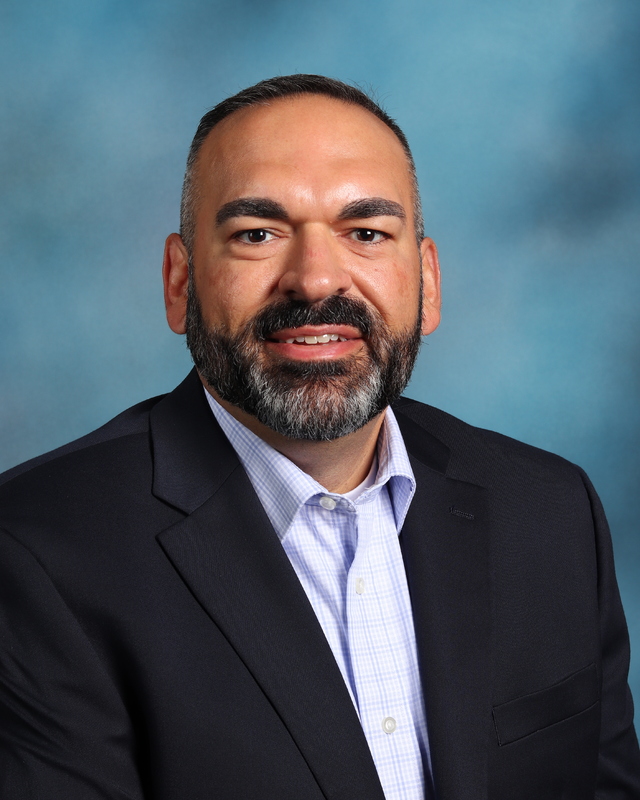
Jason Demerath
Hartwick resigns; council approves appointment process to fill first year of two-year term
(Originally published April 19, 2023.)
By Ryan Whisner
The Fort Atkinson City Council Tuesday voted unanimously to approve an appointment process to fill the first year of a newly elected council seat, which, also on Tuesday, was vacated by then-newly reelected councilwoman Megan Hartwick.
Hartwick, then an incumbent running for her second term, offering a public statement in February, withdrew her name from the April, 2023 race, noting: “After much careful thought and consideration, analysis of my schedule and responsibilities, and many sleepless nights, I have decided to ‘officially’ withdraw myself from consideration for a seat on the Fort Atkinson City Council, and am respectfully asking residents to not vote for me on April 4th.”
Her statement was followed by another from Fort Atkinson city officials who stated that the candidate could not withdraw her name from the ballot, citing state statutes that would allow a candidate who had filed nomination papers and had qualified for ballot approval, to withdraw from the ballot only under circumstances of death.
City official wrote in February: “a candidate cannot remove his or her name from the ballot per Wisconsin state statutes. Any person who files nomination papers and qualifies to appear on the ballot may not decline nomination. The name of that person shall appear upon the ballot except in case of death of the person.”
Also in February, city official outlined a process which the city would follow would Hartwick garner enough votes to win one of three seats that were due for reelection in April.
According to the February statement, a process would begin with Hartwick’s resignation, followed by one of three outcomes that could be initiated by council. They included: the appointment of a successor to serve for the remainder of the term, holding a special election, or allowing the seat to remain vacant until the April, 2024 spring election, when a one-year city council term would be placed on the ballot.
In April, unofficial tallies placed Hartwick among the top three vote-getters, winning 1,758 or 14.97% of the vote. Also placing among the top three were incumbent Mason Becker, who earned 2,163 or 18.41% of the vote, and newcomer Kyle Jaeckel, who earned 1,979 or 16.85% of the vote.
A fourth contender, John Donohue, earned 1,561 or 13.29% of the vote.
During Tuesday’s meeting, Hartwick, Becker and Jaeckel each took the oath of office and were seated as council members, after which time, Hartwick resigned.
On Tuesday’s meeting agenda, in a memo to council, City Manager Rebecca Houseman LeMire outlined four possible remedies to fill the seat following the resignation of Hartwick. They included: appointing a successor for the remainder of the term; appointing a successor for one-year, with that appointment ending April 16, 2024, and adding a one-year term for a city council member for the April 2, 2024 election; ordering a special election, or leaving the seat vacant for one year and adding a one-year term for a city council member to be decided during the April 2, 2024 election.
In the memo, LeMire wrote that staff was recommending that council adopt a resolution, authorizing the seat to be filled by appointment through use of an application process, followed by a special election to fill the remaining one year of the two-year term.
On Tuesday, council voted unanimously to engage in an appointment process via submitted applications for a one-year term and then hold a special election for a one-year term in April, 2024.
LeMire noted that with council approval of the application and special election option, the city would begin accepting applications from qualified residents to fill the one-year term, which would run from the time that the individual was appointed until April 16, 2024.
The remaining one year of the term would then appear separately on the ballot from the other two seats that would come due for reelection as a matter of regular rotation in April, 2024.
According to information shared Tuesday, those interested in consideration for appointment to the first year of the term must have applications returned to the city manager’s office by Friday, May 5, at 4 p.m.
The process, would council members request it, could include interviews of applicants, which would be conducted on Tuesday, May 9.
LeMire noted that the earliest any action could be taken to select a new council member would be during the council’s May 16 meeting. Would the process need to be delayed for any reason, she said, the matter would be addressed on June 6.
Before the measure was approved and during discussion, Becker said: “I have not seen this in my time on the council where we’ve had a vacancy like this. From the research I was able to do online and talking to people from other communities in Wisconsin, it does seem like following an application process for the appointment does seem to be kind of accepted best practice.”
Jaeckel expressed both his support and frustration with the situation, saying: “It does give the people a chance to speak their mind again,” but, he added: “It does kind of suck how it did go through knowing that people did know the potential that Megan did not want to run or be reelected.”
He described state statutes as having “mess(ed) everything up.”
Those interested in council consideration for an appointment to fill the first year of the open seat will find an application form here: https://www.fortatkinsonwi.gov/_T3_R207.php.
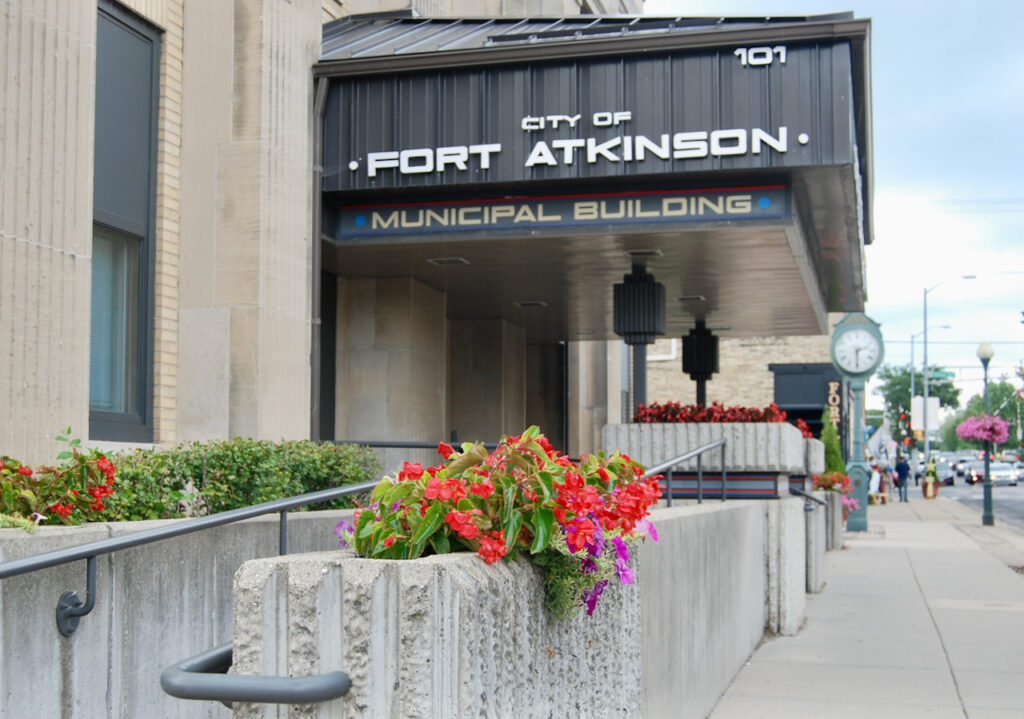
Fort Atkinson Municipal Building, file photo/Kim McDarison.
Sixteen Fort teachers receive preliminary notices of nonrenewal
(Originally published April 21, 2023.)
By Chris Spangler
The School District of Fort Atkinson Board of Education on Thursday gave the go-ahead for staffing reductions in the wake of the failed April 4 operational referendum.
Expressing regret, board members unanimously approved issuing preliminary notices of nonrenewal to 16 teachers; Heather Balsamo, Stacci Barganz, Penny Bright, Holly Dow, Peter Finnegan, Meghann Green, Sarah Horwath, Ronald Hribar, Tracey Koeppen, Dana Linde, Therese Okray, Lisa Perkins, Jennifer Rank, Nicholas Thom, Samantha Tres and Kim Westby.
The referendum had sought to exceed the state-allowed tax levy by $3 million annually beginning the next school year into perpetuity and by an additional $5 million on a non-recurring basis for four years ending in the 2026-27 school year.
However, the measure failed by 950 votes, with 3,463 “no” votes and 2,513 “yes” ballots. That left the district with a $6.8 million spending gap that district officials said must be closed over the next five years.
During a budget adjustment presentation at Thursday’s monthly meeting, School District of Fort Atkinson Superintendent Rob Abbott reviewed the strategies the district has used to meet priorities. They included providing a competitive compensation and benefit package for 2023-24 and in the financial forecasting, “right-sizing” staff to align to current and forecast enrollment and program needs, evaluating all vacancies for possible attrition or restructuring, and analyzing “current programming to prioritize return on investment and recognize opportunities for strategic abandonment.”
The first strategy, he said, “has been a challenge for the past two years as inflation has been rising. Our overarching strategy in our work since April 6 has been to preserve compensation and benefit packages for our employees to ensure that we are competitive in attracting and retaining high-quality team members to serve the families of Fort Atkinson.”
As the board learned at a special meeting April 6, the additional cuts will result in layoffs.
“It is the intention of this strategy not to freeze or reduce salaries or benefits to avoid layoffs,” Abbott said. “As you will see, we will be asking team members that will be continuing their employment with us to take on more responsibilities as we move forward in our strategic plan with fewer staff.”
He said compensating those employees will be necessary in retaining staff members next year and beyond.
District Director of Business Services Jason Demerath outlined budget cuts to date, stating that the work to “right-size” staffing starting a year ago when preparing the 2022-23 budget.
“Coming into this current fiscal year, we attritioned seven full-time positions across the district, totaling nearly $540,000 in savings,” he said.
Those $539,652 in cuts included cutting a full-time elementary classroom teacher, elementary math interventionist, high school math teacher, high school technology education teacher, middle school technology eduction teacher, middle school library media specialist and a library support position.
Demerath said that in light of the failed operational referendum, the district required additional reductions through attrition and restructuring for 2023-24.
“We are able to cut 16.5 positions across our district totaling an annual recurring savings of $1.2 million,” he said. “These positions are the ones that we brought forward to cut to fulfill our promise to the community to cut a cumulative $5 million over the next four years as it related to the operational referendum.”
Those cuts included eliminating: a full-time special education teacher, two full-time elementary teachers, a full-time high school Spanish teacher, a full-time middle school physical education/health teacher, a full-time middle school English/language arts teacher, a full-time elementary art teacher, a full-time district director of communications, a full-time elementary media specialist, a full-time high school technology education teacher, a full-time high school math teacher, a full-time high school counselor, a full-time middle school math teacher, a full-time middle school math interventionist/coach, a full-time middle school dean of students and 1.5 FTE paraprofessionals.
“Through the $1.2 million in cuts, as well as the negotiated health insurance renewal that was lower than what was projected, we decreased the projected deficit for next year by over $1.4 million,” Demerath said. “As a result, that new $5.4 million deficit was our starting point for our conversation about additional cuts going into next school year.”
He recalled, as reported April 6, the importance of maintaining a fund balance — a cash reserve of sorts — to avoid short-term borrowing for cash-flow needs at the low point in the year such as before taxes are received. The state Department of Public Instruction recommends a fund balance of around $10 million for a district the size of Fort Atkinson.
Demerath said that at the end of next year, the fund balance would be about $8.3 million, or $1.7 less than recommended.
“That $1.7 million is the option the board gravitated toward in advisement to the administrative team regarding how much more to cut from next year’s budget,” Demerath added.
Looking toward that end, Abbott said that the failure of the operational referendum “expedited our need for fiscal constraint. This evening’s budget cuts were crafted with the consensus of the full administrative team as our best effort to achieve the desired fiscal results while best positioning our district to move to the future.”
He said that in addition to the aforementioned strategies to meet priorities, the district also must remain a comprehensive school district and continue to grow; focus on recurring expenses, not one-time expenses, and balance student/school/staff impacts with community requirement for efficiencies.
“Although some programs and service models will operate differently in the future, we prioritized not cutting entire programs or entire service models,” Abbott said. “In our efforts, we focused on recurring expenses, those that will have the most significant impact on the need for the stability of our finances and future operational referendums, (those) that will offset insufficient funding from the state Legislature.”
He noted that supply budgets and other related non-recurring items have not been increased in years, including the past two years in which they alone had a combined inflation rate of 13%.
“Managing the inflationary increases in prices of goods and services we purchase without a budget increase has effectively been a cut through the need to continue to determine the best value and use of our limited funds,” Abbott stated.
He said the proposed staffing cuts are “an attempt to keep all opportunities, programs and services in place for students.
“Fort Atkinson’s kids are the sole reason for our schools’ existence,” the district administrator said. “In service to our kids, all the cuts and restructuring efforts … were developed with the strategic plan in mind. We need to continue seeing improvement in our students’ performance and growth. We also need to continue in our pursuit to be the preferred educational option in our area.”
With all that in mind, Abbott listed the proposed reduction of 21.16-plus full-time-equivalent (FTE) positions adding up to a $2.1 million budget reduction. They included cutting:
• A full-time elementary classroom teacher.
• A full-time elementary music teacher.
• A full-time elementary physical education teacher.
• Two full-time elementary library media specialists.
• A full-time elementary literacy interventionist.
• A full-time elementary math interventionist.
• A full-time middle school business education teacher.
• A full-time middle school social studies teacher.
• A full-time high school at-risk teacher.
• A full-time high school English teacher.
• A full-time high school science teacher.
• A full-time orchestra teacher.
• A full-time multilingual teacher.
• A half-time speech and language pathologist.
• A half-time 4-year-old kindergarten coordinator.
• A full-time gifted and talented coordinator.
• A half-time custodian.
• 2.66 FTE administrative assistants.
• Multiple elementary paraprofessionals.
• Stipends for the middle school athletic director and high school assistant athletic director.
• Reduction of some extra teacher contract days.
• Taking advantage of some athletic/activity program efficiencies.
“When totaled, past reductions, along with tonight’s package of cuts, will yield a recurring savings of over $3.8 million for the taxpayers of Fort Atkinson,” Abbott said.
He cited two reasons the cuts exceed the $1.7 million: “The potential for a smaller and successful operational referendum next year and to better engage in some restructuring within our district to better align with declining enrollment, better utilization of our staff and to build upon our programatic strengths as we work toward our strategic plan.”
Abbott said the restructuring approach expands the use of staff for instruction, maximizes transfers through licensing flexibility and changes program structures and delivery through the reassignment of duties.
“… All certified staff will be teaching more during the school day, resulting in a portion of preparation time and professional collaboration time moving outside of the school day,” he said, adding, “To say it simply, everyone across the school district will be doing more.”
He continued: “We have prioritized our learners in this package of cuts. No programs have been eliminated, and in doing so, these changes will have direct implications on our staff’s workloads and responsibilities moving forward. Learners were and will continue to be our focus. This restructuring is a strategic reset, given our fiscal constraints, for our district to serve learner needs well into the future.”
Abbott outlined a variety of ways the schools will look different. At the elementary level, maintaining the four schools with reduced sections will require some movement of students across schools and higher, yet reasonable class sizes. There will be an increased sharing of staff across the schools, and reduced frequency of music, art, library and physical education instruction. The fifth-grade band and orchestra will be maintained through sharing district music staff and one library media specialist will oversee the four schools’ libraries, Abbott said.
The middle school also will experience higher, yet reasonable class sizes, with English and math teachers providing some reading and math intervention. Abbott said the middle school athletic director’s duties will move to the high school athletic director and the dean of students’ duties will move to middle school administrators.
The most noticeable change at the high school, he said, is moving away from the block schedule.
“We know the high school’s current block schedule is significantly more expensive than other schedules and it is something that we can no longer afford,” Abbott said, adding that schedule changes for next year will be shared with staff, students and families in the near future.
Also anticipated at the high school are higher, yet reasonable, class sizes; a potential for fewer elective offerings for some students; a shared custodian between the high school and elementary schools; and the high school library media specialist overseeing the middle school library.
Districtwide, Abbott reported that the director of communication and community engagement’s responsibilities will be reallocated to district administrators, there will be reduction in administrative assistant positions at the district level, coordination of the 4K and gifted and talented programs will move to district administration and additional duties will be assigned to the special education/pupil services coordinator and academic advancement coordinator.
Demerath told the board that with additional $2.1 million in cuts, the district is projecting a deficit for 2023-24 of $3.1 million. Looking at that five years from now, the annual deficit will be reduced by more than $5 million.
“The bottom line is this: Even by cutting over 45 positions totaling more than $3.8 million over the past 12 months, we’re still looking at a $3.1 million deficit for next year and over $5 million the following year,” Demerath said. “We might be hard pressed to find a better illustration of how the public school funding system in Wisconsin at the state level is broken and how it is up to the people in this room and this community to decide through a local referendum whether or not their local public schools are funded.”
He said the state Legislature has provided no revenue increase more than two years, resulting in a record number of operating referendums statewide.
“And even with cuts of over $3.8 million, a referendum next year will be necessary, as that may very well be the permanent revenue model of Wisconsin public schools moving forward,” Demerath said.
As for the fund balance, it it estimated to be $10,584,388 in June 2024, a level that should allow the district to operate without short-term borrowing, he said.
Final notices of nonrenewal for certified staff and issuance of 2023-24 teaching contracts will be on the agenda at a special meeting Monday, May 8.
“We remain committed to our students, our families and our communities, as these changes preserve all student programming and will continue us on our path to achieve our strategic plan goals in the future. We continue to believe that the best is yet to come in our 1Fort schools,” Abbott concluded.
Board discussion
After the presentation, board member Chris Rogers asked about the criteria the board used in making the specific teacher cuts.
“We first reviewed and identified which positions needed to be reduced and from there, of course, we looked at those in the positions and looked at a variety of factors that included licensure, flexibility, flexibility in others areas to reassigned, performance evaluations and so on,” Director of Human Resources Mandy Turnbull explained. “There wasn’t one specific criteria we looked at for every single situation. In some cases, there was only one person tied to a specific position and then in that case, a decision was made. “
Responding to a related question by board President Kory Knickrehm, Abbott said the district first looked at criteria provided by the board.
“As we got into the process, knowing that the $1.7 million was the goal, it became evident that bigger things needed to happen to reset for us to be able to move forward in the future,” he said. “So there is nothing arbitrary about the positions that are before you tonight. They are inclusive of the full administrative team and it’s been a nonstop 13-day journey for us to be prepared to share initial findings with you at Tuesday’s special meeting and then again for you tonight.
“We really are trying to approach this as ‘how do we regroup and repackage knowing that our community needs this from us in order to potentially support us in the future?’” Abbott continued. “We certainly, as I’m sure you can imagine nor would I think anyone would disagree, don’t take any of these lightly. These are significant changes, but I do believe that if change is upon us, given the fiscal constraints, we need to take this opportunity in order to position ourselves to be the most successful as possible next spring.”
Board Clerk Robynn Selle asked Abbott to talk about block scheduling at the high school.
“In the existing block schedule, one-quarter of a teacher’s day was preparation time, and that made it difficult to use staff differently during the day as well. And given the way that schedule operates in filling it with students, it’s known nationally to necessitate additional teaching staff in order to work that schedule,” he explained.
Abbott said that prior to the failure of the operational referendum, there had been investigation into how to best schedule the high school for best results.
Knickrehm asked Abbott to expand on the potential for fewer electives at the high school level.
“That will factor depending on the schedule model they have moving forward,” the superintendent said. “We’re trying to be as clear with people as to what some of the ramifications may be. There may be some students who don’t have as many courses in their schedule as they would have in other options.
“I know one of the priorities there is to get as many kids in classes and not in study halls and other places where classes could be used. That’s more of a default that, yet, there might be some changes in electives. I don’t know that we see that being a prevalent situation necessarily, but that would be one of the next steps moving forward as the high school finalizes what they will be doing.”
Responding to a question regarding enrollment, Abbott said the cuts correct the expected drop in enrollment at the middle school. At the elementary school level, enrollment will be evaluated on a case-by-case basis depending on 4K and kindergarten numbers.
Selle asked about how administration has been affected. Abbott said the communications coordinator position has been cut, and administrative staff are sharing duties.
He noted that the administrators are under contract through January.
The board clerk also addressed the fact that even with the $3.8 million in savings, there still will be a need for an operational referendum next year.
“There’s no joy in this work. … This is incredible,” Abbott said, calling the fact that even $3.8 million in cuts are not enough “disheartening.”
Selle pointed blame at the state, which is sitting on a $7 billion surplus, yet the local level is feeling it.
“Coming here tonight, it felt like I was coming to a funeral … We are truly making life-changing decisions,” she said.
I really believe that for the long-term fiscal health of the district and to have competitive programming to bring in staff with a good pay and benefits package, we can’t just go slash 16% of everyone’s pay across the board, because that is what it essentially would be,” she said. “And I think that would make the district really, really suffer.”
She said the Legislature must start to fund public schools as they’re supposed to do.
Abbott pointed out that the state Legislature is working on its biennial budget and now is the time for electors to provide input to legislators.
“Voices truly do matter, and while we may not always agree, I think those that are elected to represent us in Madison need to hear the concerns and hear some of what’s being shared this evening, because that truly could have a profound impact on the next biennial budget,” he said.
Knickrehm asked Abbott where funding will be 12 months from now.
“There certainly will be a need for a referendum. A simple way to explain it would be, over the past decade, the state has given us more-than-$200 per student increase from one year to the next,” Abbott said. “A once $3 million deficit is $1,200 per kid. So, to expect the state will give us a $1,200-,per-kid increase next year and even then, with declining enrollment and not keeping up with inflation, that won’t even keep up with the future.”
Knickrehm said that personally, he has grappled with this funding tragedy since election night.
“The numbers we have to cut are never comfortable from where we’re sitting today. Our job up here is to be financially prudent to the taxpayers and Fort Atkinson while giving the highest level of education for the children in our district. It was shocking, like a funeral coming in here today, and I want to make clear that the staff is a certain and definite priority in this district and, like all of you, I can’t express the gratitude I have for you all.,” he said. “In a time and a week that has been very stressful for all, … I hope that you know that the board that we appreciate it you all.
“We have to make these difficult decisions of where and who and why of all these things, and at the end of the day, the funding simply has not kept up with it. This is not a Fort Atkinson issue. This is an issue that public education has been grappling with for a long time …,” Knickrehm said.
Rogers agreed, and pointed out that one thing not mentioned during the budget discussion was that fact that the district has very little long-term debt.
“Boards in the past have made sure that the long-term debt we did have has been paid off before it really is due, so when we’re looking at our financial problems, long-term debt is not one of those problems,” he said.
Selle added that in November, the capital referendum passed, so any projects people see underway are not related to the staff cuts.
Abbott pointed out that legally, the district can not use any of the capital funds for the operational costs.
Selle thanked the students for turning out and speaking during the public comment section, and Treasurer Rhona Buchta echoed that sentiment.
“To appreciate there is distinction between this understanding of fiscally being prudent in a business sense and then there’s this component of humanity that can not have any value to it because it is invaluable. … To see all of these students come up, doing what they’re supposed to do as citizens, doing their civic duty, I feel like that gives us hope in a very dark and heavy time,” she said.
“That goes to show that our teachers should be commended because they have instilled a value of their teaching here. It is commendable to see students come, speak very eloquently, very impressively, in such a way that says, ‘hey, this is what we want. We’re going to voice it.’ As nervous as some have been, they did it. No voice doesn’t make a mark. A voice does. None of this is easy.”
She concluded: “I can’t imagine what is going to happen in the next few days, but I agree we have to trust our administration, which I do; trust our teachers; trust our students; trust our community in understanding in that it’s not just one part. It’s all of us and we need to understand that the contribution of the whole can’t become a whole until we all do it together.”
Rogers made the motion for the teacher nonrewals. This was seconded by Selle and unanimously approved.
Public comment
At the start of the board meeting, several members of the public spoke regarding the staff cuts, including five students who specifically made a plea to retain high school science teacher Samantha Tres.
Students Rebecca Christ and Sylbie Beers together addressed the board.
“Tonight I am not here to blame anyone what this school district is going through. Instead, I and many other students are here to tell you the impact these decisions have already made on us,” they said.
They shared what the Wednesday was like as they saw teachers’ reactions to being told they would be losing their jobs.
“Coming into school today, the change in culture was readily apparent. Students are on edge not knowing what their education is going to look like in the near future, just as much as staff is on edge not knowing if they’ll have a job next year.
“In our community, you advertise being 1Fort, 1Team, 1District and 1Community, (but) the behaviors coming from the board and superintendent, only blaming the community for what has happened, and the (behaviors) coming from the community, only blaming the board and superintendent what has happened, is not demonstrating all that we preach when we say 1Fort.”
They asked that the board think about the people on the nonrenewable list, especially science teacher Samantha Tres.
“Miss Tres is more than just a teacher. She is someone any of her students can come to seeking help with her classes, other classes and anything else going on in their lives,” they said, calling her a mentor to all students, and someone who goes the extra mile to help them.
“Miss Tres is someone who teaches and comes to school because she gets to, not because she has to. Miss Tres is someone who loves her job and her students more than I thought anyone could love their job.
“We’ve seen the cuts you’ve made and how they’ve directly affected the students of Fort Atkinson and our education. I would like know what cuts were made at the top of this district that don’t have the same monumental impact on students daily. We’ve needed to do better, and clearly, we still need to do better,” they concluded.
Kenzie Paske, a junior, quoted the late newsman Tom Brokow, who once said that “it is easy to make a buck; it’s a lot tougher to make a difference.”
“And that’s exactly what Miss Tres does: make a difference,” she said.
“Once I started getting to know her throughout the three classes I’ve had with her this year, I began to love her not only as a teacher, but as a person. She continually inspired me and pushed me to do my best and achieve my goals. And unlike most teachers, she helps me to achieve those goals.
Paske said that Tres helped her get a job shadow and career path, and she generally cares about each student’s education.
“Miss Tres is hardworking, selfless, funny and humble. She has been teaching for five years and has continuously put in 110% effort to ensure that her students get the best learning experience possible,” Paske said.
The junior said that Tres puts her students before herself due to her passion for teaching.
“I think that not renewing Miss Tres’ contract would really be a disservice to all students that would miss the opportunity to work and learn from such a pure and amazing teacher. I know I cannot not simply make these budget cuts disappear, but I ask you to take the time again to think about the impact that continuing Miss Tres’ nonrenewal would put on the students of Fort Atkinson High School and their education.”
Also speaking was Maren Haagensen, who presented the board with a petition in support of Tres retaining her job.
She said she has Medical Occupations with Tres and learned that the teacher might lose her job this morning. At 8:15 a.m., she created the petition.
“As one of the few teachers who connects with her students and builds bonds with them, the students cannot see how she is not valuable to Fort Atkinson High School,” it reads. “We, the students of Fort Atkinson High School, urge our school board to change their decision about who they are letting go.”
Haagensen noted that at 8:30 a.m., she started getting signatures, which numbered 150 by noon. At 3:10 p.m., 353 students had signed the petition.
“I would say, give or take, that’s about 950 students who go to Fort Atkinson High School, so that’s about 37% of the students who signed,” she said.
She said that Tres is a teacher students will remember their entire life. She is the only teacher who teaches Medical Occupations and Bio-Technology, “so anyone who wants to go into the medical field will no longer have a sort of gateway.
“She makes a difference and she makes an impact and she makes a change. I think that she’s just too valuable to let go …,” the student concluded.
Also addressing the board was Rachel Snethen, a former school board member and parent of a fifth-grader at Luther Elementary School.
She started by encouraging everyone to contact their state representatives — Sen. Steve Nass and Rep. Scott Johnson — to voice concerns about state funding for public education.
“The Fort Atkinson school district will be the first among the many school districts in the coming years to make cuts just like you’re having to do tonight,” Snethen said. “We’re seeing this all over the state. At some point, communities across the state will be confronted with the same effects of rising interest rates, unstable wage gaps, construction costs, insurance premium hikes and continuing disinvesting in our public school education.
“At some point in time, other communities will say no too to paying extra taxes to supplement school funding the state took away over several decades. This has been a long time coming and it’s very unfortunate for the people that are in the school district,” she added.
Snethen noted that state lawmakers work for the people. Wisconsin state government is broken and has been so for a very long time.
“These children are the ones who will pay the price for our inaction now, which means we need to step up. We’re the adults. We need to act,” she advised.
Legislators must reach across the aisle to solve these issues, Snethen said.
“Our Fort Atkinson school district administration, our board, our staff, our teachers, they deserve better. But most of all, our children deserve better,” she concluded.
Ethan Toeller thanked all the students who signed the petition.
“Miss Tres was a teacher in our science department. She’s a teacher first and a friend second. Unlike a lot of teachers, she has a way of teaching that can make anybody interested in her class,” he said.
Toeller said that Tres doesn’t talk at students; she talks with them.
“She created a space for us to actually effectively learn. Her teaching style was engaging and thought-provoking. It made me look forward to her class every day,” he said, adding that losing a teacher such as Tres will negatively impact the quality of education.
“Teachers like Miss Tres are the ones who make a difference in students’ lives. They go above and beyond to create a learning environment that is engaging and challenging and supportive. They inspire their students to learn and grow and help them develop the skills they need to be successful in life.
“It’s a shame this district is being forced to fire any teacher, in this community, education should be a top priority. But as we’ve seen this week, it isn’t. We should be investing in our teachers and students. Miss Tres is the kind of teacher all teachers should aspire to be like.”
No teacher deserves this, he said, noting that when he turns 18, he will vote to support public education.
Matt Mascal, a middle school science teacher for 17 years, told that board that he has no doubt the people making the budget decisions have acted with integrity, compassion and the best interests of students and the community in mind. However, he said very little has been shared regarding the criteria used in staff reductions.
“This includes information on how areas were identified for reduction, as well as how individuals from these areas were selected for nonrenewal,” he said. “… I urge all of you to provide full transparency regarding the criteria and the decisionmaking process used in determining which positions to terminate and which individuals to issue nonrenewals. True teamwork requires honesty and trust.”
Ben Pfaff also addressed the board, asking members to stop raising his school taxes.
“I know you’re going to try to do another referendum; don’t do it. The bank’s broke. I’m making the same amount of money, even though I’m $10 higher, than I was making 10 years ago. My money goes the same distance. It’s tough. It sucks. It sucks losing jobs. I’ve always had to look for a job,” he said.
He said that, like teachers, he is lucky because he is a state employee who receives good benefits.
“The best thing you students can do is go for the major you believe in and get a teaching minor. That’s where I screwed up,” he said.
An earlier story, outlining the three options presented to the board on April 6, board discussion, and its decision to chose “Option 2,” is here: https://fortatkinsononline.com/fort-school-board-advises-staffing-reductions-in-response-to-failed-referendum/.
Other business
In other business, the board:
• Approved the retirement of Anthony Swantz, a full-time social studies teacher at Fort Atkinson High School. He has worked for the district 26 years.
• Approved two new courses for next school year: AP Seminar (replacing Accelerated English 10) and AP English Language and Composition (replacing Accelerated English 11).
• Approved disposal of the middle school grandstand bleachers.
• Approved the driver education service agreement addendum with Tri-City Driving School.
• Accepted a donation from the Whitewater Movie Theatre of 40 movie passes and six extra-large bags of popcorn with an approximate value of $300 to Luther Elementary School.

Members of the community come to the podium Thursday to voice their opinions regarding teacher nonrenewal notices. Sixteen teachers were identified for nonrenewal during Thursday’s School District of Fort Atkinson Board of Education meeting. The action was approved by board members and is a response, district administration has noted, to a failed operational referendum placed on the ballot in April. Screen shot photo.
Nine residents apply to fill vacated city council seat
(Originally published May 8, 2023.)
By Kim McDarison
Fort Atkinson city officials have received nine applications from residents looking to fill a city council seat vacated in April.
City council member Megan Hartwick resigned her seat after her reelection in April. Hartwick had earlier made public through a statement her intention not to run for reelection, and, although her name, as stipulated by state statutes, city officials have said, could not be removed from the ballot, Hartwick, in her statement, requested that voters not cast their ballots for her.
She emerged from the election as the third highest vote-getter among four names appearing on the April ballot.
In response to Hartwick’s statement, and in anticipation that Hartwick could potentially garner a winning number of votes, city officials outlined a process through which, following her resignation, a replacement would be named.
During a council meeting held in April, residents were invited to submit applications for the seat to the city manager’s office by a deadline of May 5.
An earlier story about the vacated seat and process to fill it is here: https://fortatkinsononline.com/hartwick-resigns-council-approves-appointment-process-to-fill-first-year-of-two-year-term/.
On Monday, city officials release the names of those city residents who applied by the May 5 deadline. They are: Paul Brady, John Donohue, Nathan Friedl, James Garthwait, Gary Held, Jordan Lamb, Davin Lescohier, Diana Shull, and Mary Kay Paulson Weston.
According to information supplied by Fort Atkinson City Manager Rebecca Houseman, applicants will next be invited to the city council’s regularly scheduled meeting, planned for Tuesday, May 16, at which time each applicant will be offered a five-minute interview, during which council members will pose questions.
Applicants will be interviewed in the order in which their application was received by the city manager.
After those applicants who are present at the meeting complete their interviews, council members will each select three finalists, Houseman stated.
Selection will be decided using a voting process, Houseman noted, adding that each of the four council members will identify three applicants for final consideration. Selections made by the four council members will be tallied, with the collective top three vote-getters continuing as finalists, Houseman said.
Council members will next “discuss and debate” the three finalists, after which a council member may make a motion to appoint an applicant. Council may next discuss and debate the proposed appointment, and vote. If the motion is approved, the applicant will be appointed. If the motion fails, a new motion to appoint another finalist will be entertained, Houseman explained. The process will continue until an appointment is made, she added.
The process will be held in open session to provide professionalism and transparency, Houseman said.

Fort Atkinson Municipal Building, file photo/Kim McDarison.
Hoard Museum plans events in celebration of Lorine Niedecker’s birthday
(Originally published May 10, 2023.)
Three separate activities in celebration of Fort Atkinson resident and nationally recognized poet Lorine Niedecker’s birthday will be hosted by the Hoard Historical Museum, the organization has announced.
Activities include a bike tour, featuring locations that are of significance to Neidecker’s life and work; a discussion led by Lauren Carlson, a Niedecker Fellowship winner, and a temporary exhibition featuring the written works of female authors who also are residents of Fort Atkinson.
A synopsis of each activity follows.
‘Pedaling and Poems’
The bike tour, which will be held Saturday, May 13, is titled: “Pedaling and Poems.”
The tour will be led by Hoard Historical Museum Director Merrilee Lee, with participants leaving “Market Square,” the location of the Fort Farmers Market, 19 E. Milwaukee Ave., at 9:30 a.m. The tour will conclude at the same location.
According to information released by the museum, the tour will highlight several locations of significance to Niedecker while participants discuss her poetry.
Within the release, Lee said she was excited to share Niedecker-related history and her poems.
“Every time I read her poetry, something different stands out to me and I feel like I have a different understanding of her works,” Lee was quoted as saying in the release.
The tour will remain within the city limits of Fort Atkinson, she said, adding that while the late poet’s former home is located on Black Hawk Island, the distance between the city’s downtown area and the home’s location was deemed too far to travel as part of the tour.
The tour is free, and participant as encouraged to bring a favorite Niedecker poem, according to the release.
Carlson presentation
Also on Saturday, at 2 p.m., the museum will be hosting Carlson, the inaugural Lorine Niedecker Fellowship winner.
The museum is located at 401 Whitewater Ave., Fort Atkinson.
According to the release, the Niedecker Fellowship is the combined efforts of the “Friends of Lorine Niedecker,” group and the “Write On, Door County,” program. Along with fellowship selection, Carlson was provided with a two-week residency, which divided her time between Door County and Fort Atkinson.
Carlson, a resident of Manistee, Mich., is a poet and spiritual director. She holds a master’s degree in poetry from the Warren Wilson MFA Program for Writers, and her poetry can be found in such publications as the “Crab Creek Review,” “Salamander Magazine,” “Terrain,” “The Windhover,” and “Waxwing.” Additionally, she serves as the editor of “Tinderbox Poetry Journal,” according to the release.
In the release, Lee described Carlson as a Niedecker “fan,” who is working to share Neidecker’s work with a new generation of poets and poetry fans.
On Saturday, Carlson will be speaking about her two-week fellowship, her time writing at Write On, Door County and her week on Black Hawk Island. She also will be sharing some of her poetry written during her time in Door County and Black Hawk Island, the release stated.
The program is free and open to the public.
Fort Atkinson’s ‘women authors’
Visitors to the Hoard Museum will be treated to a temporary exhibition featuring the works of Fort Atkinson’s “women authors,” according to the release.
Along with the exhibition, visitors to the museum will find a Niedecker-themed building-wide scavenger hunt.
The exhibition, and visiting the museum, is free and open to the public.
For more information about Niedecker or poetry events scheduled as part of the weekend’s birthday celebration, visit: www.explorefortatkinson.com/write-on-the-river.
The museum is open Tuesdays through Saturdays, from 9:30 a.m. to 4:30 p.m. Admission is free. For more information about the museum, call: 920-397-9914, email: info@hoardMuseum.org, or visit its website: www.hoardmuseum.org.
About Niedecker
Niedecker was born May 12, 1903, according to the release, which further describes her as an “Objectivist poet who published several books of poetry and lived on Black Hawk Island outside of Fort Atkinson.”
The poet died in 1970, the release stated, noting that the Fort Atkinson community is still engaged with honoring her legacy by celebrating her life and works.
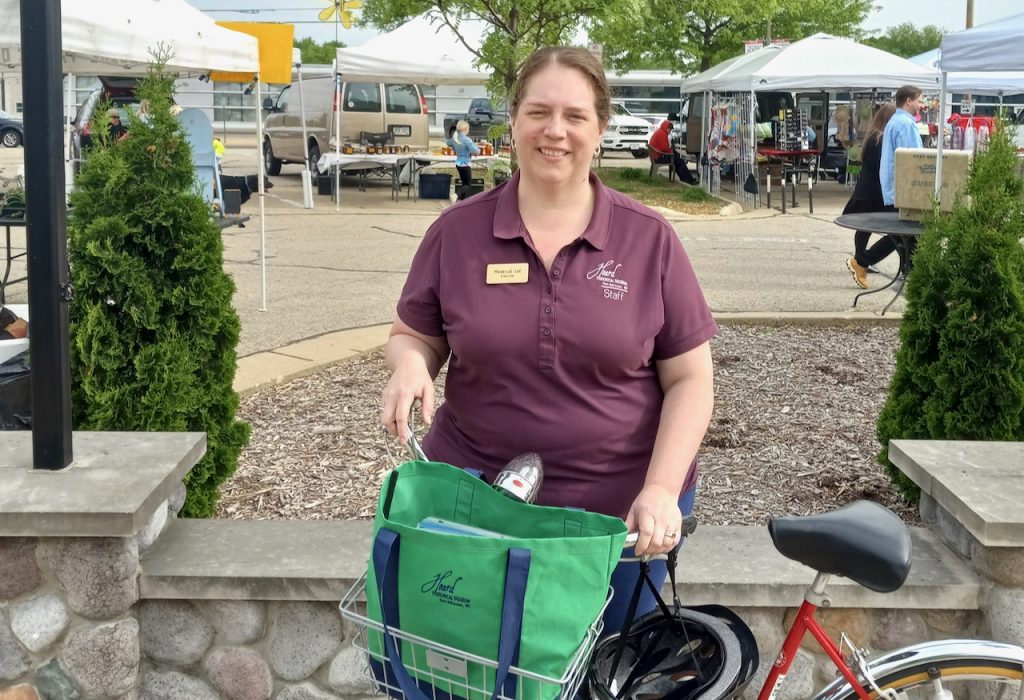
Hoard Historical Museum Director Merrilee Lee stands ready with her bike in Market Square, Fort Atkinson, to greet bike tour participants. A tour, featuring sites of significant related to poet Lorine Niedecker will be offered Saturday morning. Contributed photo.

Lauren Carlson, a Lorine Niedecker fellowship winner, will offer a presentation Saturday afternoon. Contributed photo.
Click on the arrow above to view Fort Atkinson Online’s edition of “What’s up? with Michael Clish.” This episode features an interview with Ann Engelman, the president of The Friends of Lorine Niedecker, group. The nonprofit organization works to maintain Niedecker’s poetry and legacy as a focal point in Fort Atkinson.
Correction: Amy Lutzke, Assistant Director at the Dwight Foster Public Library, notes that the mural painted at the Fort Atkinson Middle School and seen behind Michael Clish and Friends of Lorine Niedecker President Ann Engelman was painted by Erika Koivunen of ACME Ironworks and painter Amy Zaremba, who worked to create a mural and recycled metal sculpture in the main hallway of the middle school. A reference to middle school mural painters made during the interview within the video is incorrect. Fort Atkinson Online regrets the error.
Rep. Scott Johnson hears school funding concerns during listening session in Fort
(Originally published May 12, 2023.)
By Kim McDarison
Approximately 25 area residents arrived Friday, May 5, at the Fort Atkinson High School auditorium to share school funding concerns with State Rep. Scott Johnson.
Johnson organized the listening session, according to a recent news release, to talk about school funding “in the wake of school referendum failure.”
An $8 million operational referendum placed by the School District of Fort Atkinson Board of Eduction on the ballot in April did not meet with voter approval. Following the election, and in response to an operational funding shortfall, the board voted to send preliminary notices of nonrenewal to 16 of the district’s certified staff.
According to Lukas Baker, a spokesperson in Johnson’s Madison office, the majority of residents attended the listening session in Fort Atkinson staying to talk with the representative for more than an hour.
Responding to questions in a recent telephone interview, Baker said that those in attendance at last Friday’s listening session asked questions and offered concerns, noting that a common theme was “the fact that they don’t want to keep on voting for referendums in the future. They want to know that more money will come for education so they don’t have to keep having referendums that are passing or failing, and seeing their property taxes go up.”
Baker said a School District of Fort Atkinson teacher, who was among those receiving a preliminary notice of nonrenewal, shared “her story” with the representative. Baker described her comments as “very touching and very real.”
According to Baker, some attendees asked about a timeline, looking to learn when local school districts would learn from the state about additional funding, and, more specifically, how much additional funding would be received.
“We don’t have an answer to that right now,” Baker said, adding that the State Legislative Joint Committee on Finance was “going through the process.
“We are at the beginning stages of the (state) budget. We have 50 days to fully reconstruct and assemble a new budget package for the state,” Baker said, adding that Johnson is committed to eduction, and, he said, he will “push every day for more funds to be put into the education side of the budget.”
Baker said members of the Legislature hope to have the state budget wrapped up in July.
Of the recent listening session, he said: “I think it was a very productive and cordial event. People wanted to know what they can do to help Scott (Johnson) to be successful in his efforts to get more money for the (Assembly) district.”
Sharing the representative’s takeaways, Baker said: “I think he walked away with people believing that he is fully invested in fighting for children’s eduction and fighting for the (33rd Assembly) district.”
Johnson is known in the Fort Atkinson community, Baker said, noting his time served as a school bus driver and school board member.
“This is an important issue for him. He left knowing it’s a tough issue — education is not the only thing that needs to be funded, so tough decisions will have to be made, but, in the end, he will fight for more funding for the district. And by district, I mean within the 33rd Assembly District and school districts across the state,” Baker said.
The 33rd Assembly District, represented by Scott Johnson, R-Jefferson, includes the communities, in part or full, of Fort Atkinson, Jefferson, Milton, Helenville, Hebron, Sullivan, Oakland and Palmyra. A portion of the city of Whitewater, which resides in Jefferson County, also is included.
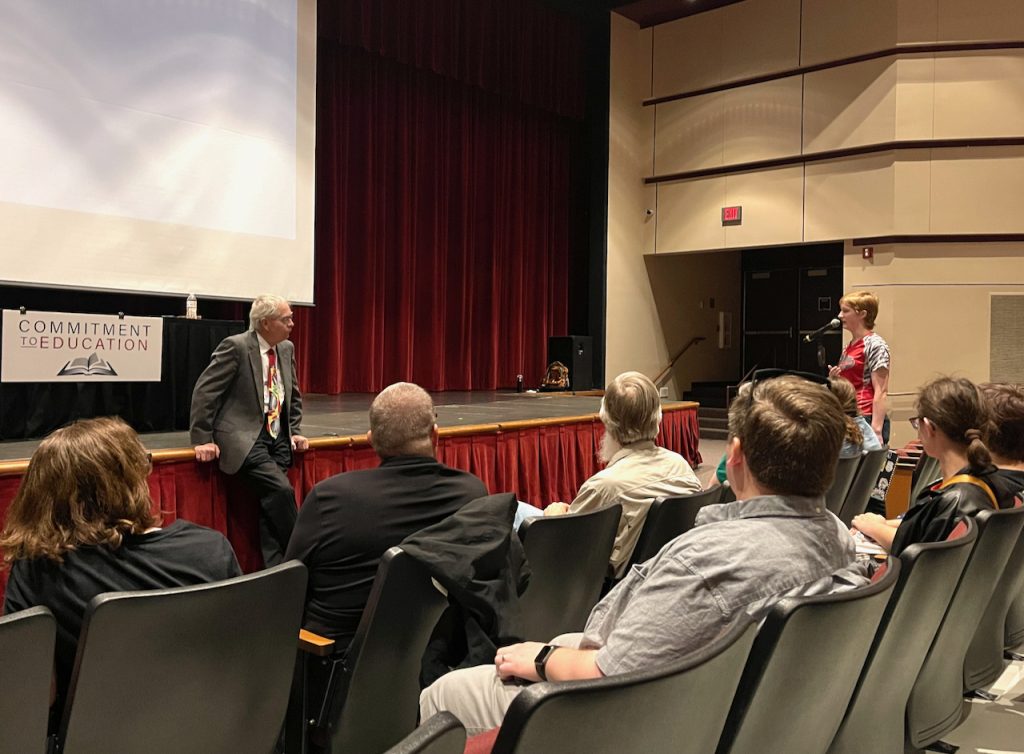
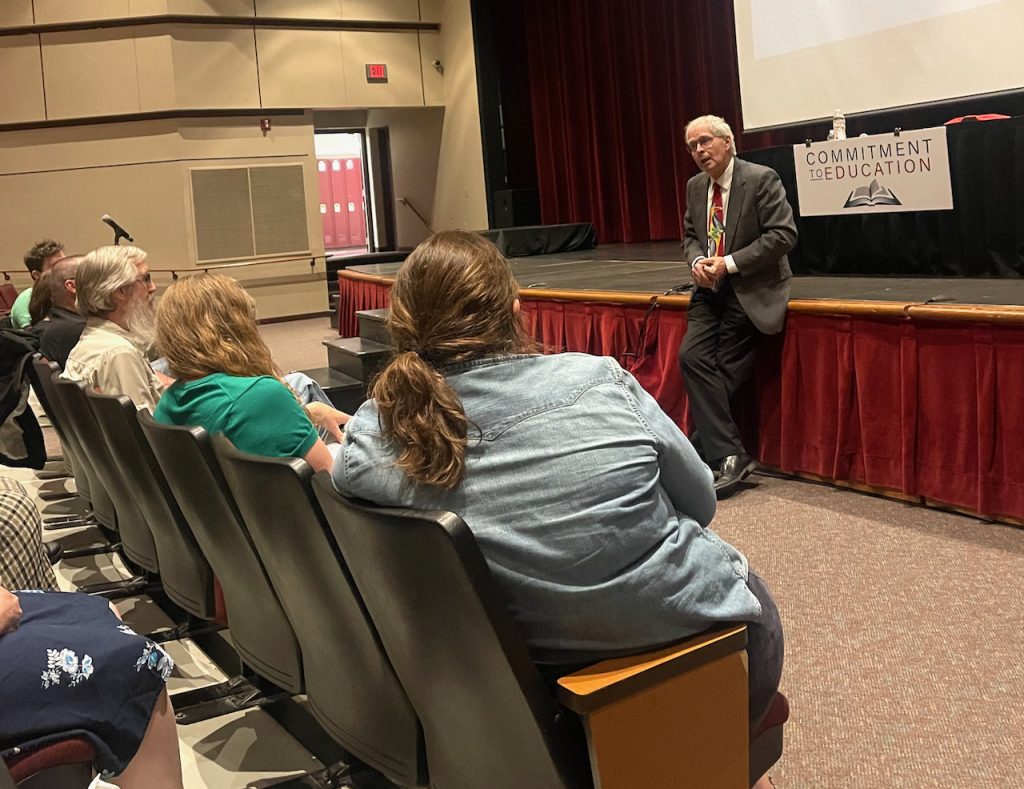
Two photos above: State Rep. Scott Johnson, standing near the stage, interacts with some 25 residents who gathered last Friday at the Fort Atkinson High School auditorium. Johnson represents Wisconsin’s 33rd Assembly district. He scheduled the listening session, according to a recent press release, to learn from constituents their thoughts about school financing. Contributed photos.
Wisconsin poet laureate celebrates Lorine Niedecker’s 120th birthday
(Originally published May 15, 2023.)
By Chris Spangler
Fort Atkinson celebrated the 120th anniversary of the birth of Lorine Niedecker on Saturday with several special activities.
The late Fort Atkinson poet, who grew up on Blackhawk Island, was saluted at events hosted by the Hoard Historical Museum and Friends of Lorine Niedecker.
Activities included a morning bicycle tour featuring locations significant to Niedecker’s life and work; a discussion led by Lauren Carlson, a Niedecker Fellowship winner; a temporary exhibition featuring the written works of female authors who also are residents of Fort Atkinson, and a presentation by 2023-24 Wisconsin Poet Laureate Nick Gulig.
A Fort Atkinson resident, Gulig addressed 42 guests during an 11 a.m. talk at the Dwight Foster Public Library.
An associate professor at the University of Wisconsin-Whitewater, the Thai-American poet will serve as poet laureate for the state through the end of 2024.
According to information released by the Wisconsin Poet Laureate Commission (WPLC) in January, Gulig studied literature at the University of Montana, the University of Iowa Writer’s Workshop, and the University of Denver.
In 2011, he received a Fulbright Fellowship to Bangkok, Thailand, during which he completed his first book “North of Order.” Cutbank Books published his second collection, “Book of Lake.” In 2018, his third collection, “Orient,” was a finalist or semi-finalist in six national book contests, eventually winning the coveted CSU (Colorado State University) Open Book Poetry Prize.
Locally, he has twice won the “Wisconsin People and Ideas” poetry award: once in 2017 for a poem titled: “The New American Nostalgia,” and this year for a poem titled: “Of Genesis.” Gulig has given talks and readings across the state, including for the Chippewa Valley Writer’s Guild where he spoke alongside former Wisconsin Poet Laurette Max Garland.
At the University of Wisconsin-Whitewater he works with young Midwestern writers daily in the classroom.
In addition, Gulig guides the “UWW Creative Writing Festival,” an event that brings more than 600 students annually to the UW-Whitewater campus to take workshops with other students from around the state, and the “Growing Writers Summer Camp,” which focuses on providing middle and high school students access to college-level writing instruction and community, according to the release.
He also founded and curates a variety of reading series, including “The Warhawk Reading and Lecture Series,” “The Lamplight Reading Series,” and the “Faculty Spotlight Reading Series.”
Gulig received a Faculty Initiative for Research Excellence (FIRE) grant to study the poetry of Lorine Niedecker, conducting research on and recreating Niedecker’s 1966 trip circumnavigating Lake Superior, the release read.
Niedecker’s background
According to information made available through the Hoard Historical Museum and the Friends of Lorine Niedecker group, the poet was born in Fort Atkinson on May 12, 1903, to Henry and Theresa “Daisy” Kunz Neidecker, Lorine Niedecker (she altered the spelling) wrote frequently about her father, a carp fisherman and tavernkeeper, and mother, an obsessive homemaker whose deafness turned her inward and pushed her husband to a neighbor who comforted him until his money ran out.
Niedecker graduated from Fort Atkinson High School in 1922 and attended Beloit College the following year. She began to publish her poetry in the mid-1930s, but never was far from routine occupations.
After two years as a library assistant at the Dwight Foster Public Library and scriptwriter at radio station WHA in Madison, she worked as a proofreader for Hoard’s Dairyman magazine from 1944-50 and then scrubbed floors at Fort Atkinson Memorial Hospital from 1957-63, just to “make a little money for the really important things,” she once said.
She lived alone in the Blackhawk Island cabin inherited from her father until her marriage in 1928 to farmer Frank Hartwig. They separated two years later, but didn’t divorce until 1942.
In 1962, Niedecker married Albert Millen, an outdoorsman-turned-building painter. She’d met the one-handed Milwaukeean when he bought a weekend cottage from her on Blackhawk Island. They lived in Milwaukee until he retired to Lake Koshkonong four years later. She quit her hospital job and became a housewife. She learned to sew and Millen taught her how to cook.
They traveled frequently — she with a notepad on her lap for her constant “scribbling” — visiting his children and enjoying the wilds of Lake Superior, Door County and the western United States.
It was during her marriage to Millen that Niedecker doubled her lifetime output of poetry. In fact, she believed that some of her later works were among her best.
She worked closely with her early mentor, Louis Zukofsky, founder of the Objectivist Movement, and was concerned with two issues: capturing the simple rhythms of American speech and the complexity implicit in life’s simplicity.
Her life also was filled with correspondence with literary greats such as Cid Corman and Jonathan Williams. She began writing not only about nature and home, but of people she admired in history, scientific discoveries and the mysteries of the universe.
On Dec. 1, 1970, Niedecker suffered a stroke and then died on New Year’s Eve. Millen passed away in 1981 and is buried alongside Lorine in Union Cemetery. His gravestone reads, “Al Millen, husband of Lorine Niedecker.”
Five volumes of her poetry were published before her death, but it has been during the five decades afterward that Niedecker’s works continue to become even a greater international sensation every day.
A Wisconsin State Historical Society historical plaque is located at the site of her former Blackhawk Island home, and the Dwight Foster Public Library has a permanent collection of the Niedecker’s works in its Friends of Lorine Niedecker Room. Niedecker also is the focus of artwork decorating local schools.
The Wisconsin Poetry Festival is named in her honor, and Fort Atkinson has become a mecca for pilgrims worldwide hoping to gain more insight into her works by communing with the Rock River she so loved.
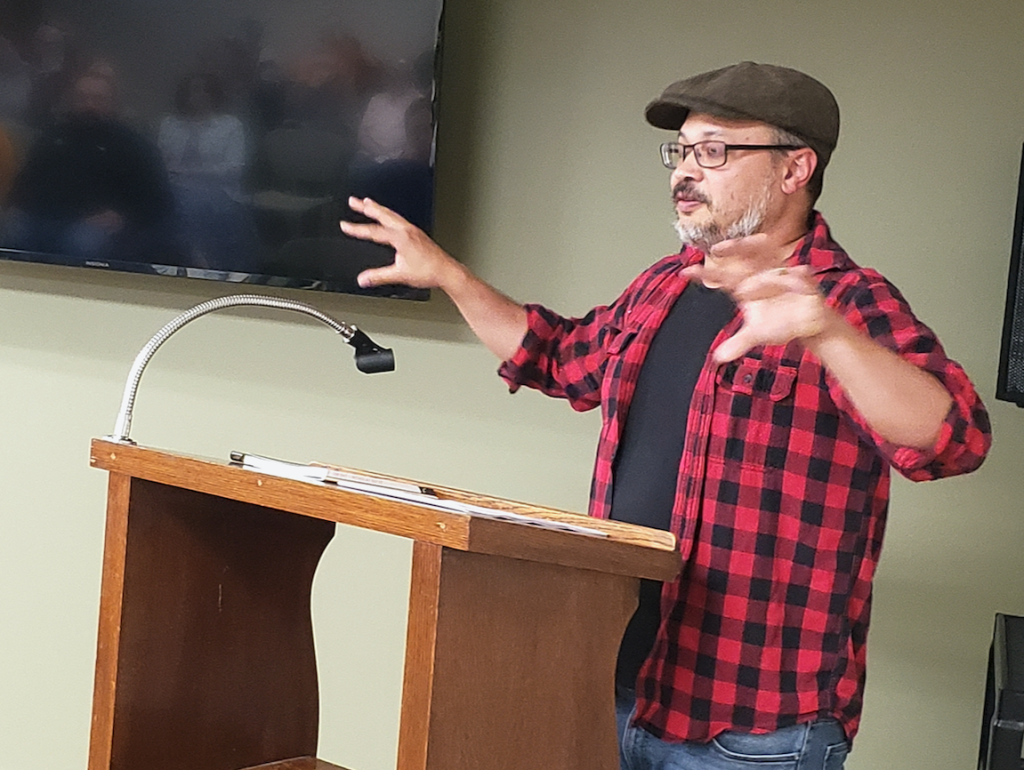
Wisconsin Poet Laureate Nick Gulig addresses an audience Saturday morning at the Dwight Foster Public Library.

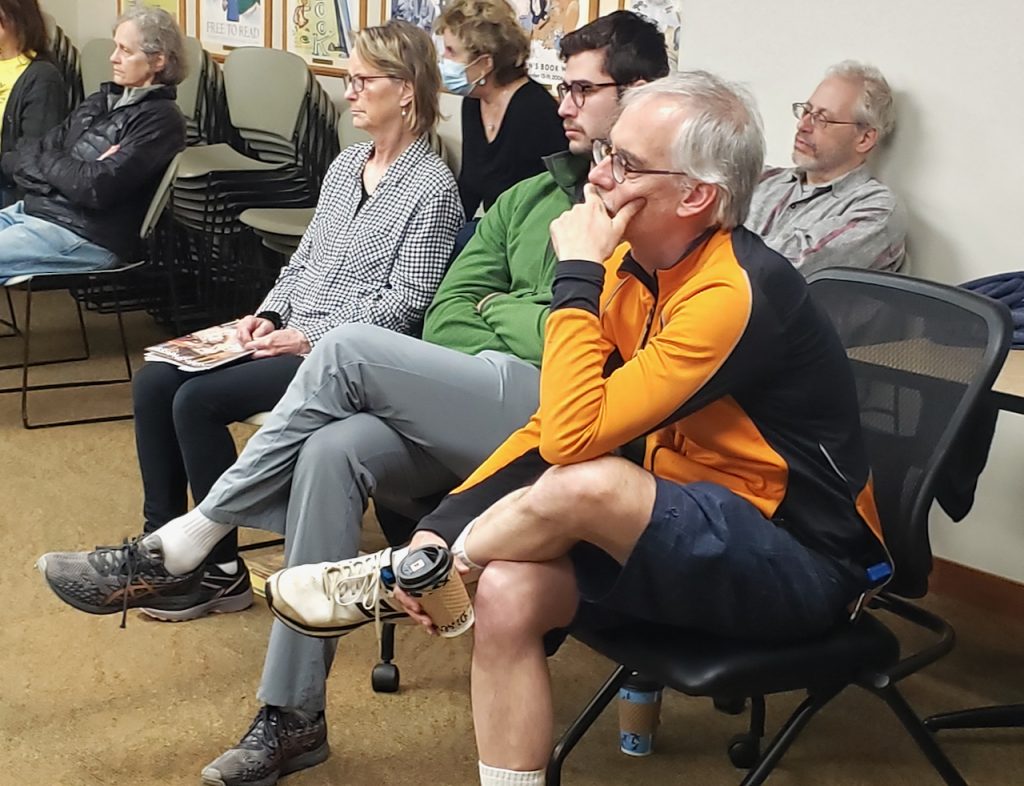
Two photos above: A full house of 42 guests listen intently to Wisconsin Poet Laureate Nick Gulig as he reads his own works. Chris Spangler photo.
Eight applicants to vie for open council seat
(Originally published May 16, 2023.)
By Kim McDarison
Eight applicants are anticipated to appear before four sitting members of the Fort Atkinson City Council Tuesday all of whom are hoping for placement by appointment to fill an open council seat. The full body is a five-member board.
A vacancy on the city council was created in April after then-newly elected city councilwoman Megan Hartwick resigned. Hartwick had announced her intention to withdraw from the race in February, but her name continued to appear on the April ballot. In February, she asked voters to refrain from voting for her and announced her plans to resign would she receive enough votes to retain the seat.
A story about her resignation is here: https://fortatkinsononline.com/becker-jaeckel-hartwick-win-city-council-seats-hartwick-stated-in-february-plans-to-resign/.
Earlier this month, the city manager’s office reported nine applicants who had submitted appropriate documents for consideration for appointment by the deadline of May 5.
On Tuesday, City Clerk Michelle Ebbert noted by phone that one applicant, Nathan Friedl, had removed his name from consideration for the open seat. According to information within the city’s meeting packet, the applicant withdrew his name from consideration by email on Thursday, May 11.
The remaining applicants, listed in alphabetical order, include: Paul Brady, John Donohue, James Garthwait, Gary Held, Jordan Lamb, Davin Lescohier, Diana Shull, and Mary Kay Paulson Weston.
According to information included in Tuesday’s council meeting packet, the successful applicant will be appointed to serve a term beginning Wednesday, May 17, until April 16, 2024.
A full city council term is two years.
Information shared in April by Fort Atkinson City Manager Rebecca Houseman noted that the council person receiving appointment Tuesday will serve for one of the term’s two years, with the seat appearing on the April 2024 ballot as part of a special election to fill the remaining one year of the term.
An earlier story, including the council’s decision to fill the seat by appointment and special election, is here: https://fortatkinsononline.com/hartwick-resigns-council-approves-appointment-process-to-fill-first-year-of-two-year-term/.
A process through which the seat will be decided Tuesday is outlined in an earlier story found here: https://fortatkinsononline.com/nine-residents-apply-to-fill-vacated-city-council-seat/.
According to information provided within Tuesday’s meeting packet, the successful applicant will be required to take the oath of office within 10 days of an appointment.
Within the application form, each applicant was asked to respond to three questions.
Responses from the eight applicants to the three questions follow. Applicants are listed, as stated within the meeting packet, in the order in which their applications were received at city hall.
Jordan Lamb
Q: Why are you interested in being appointed to a one-year term on the city council?
A: I believe we need to stimulate growth in the city in terms of population and businesses.
Q: Please list any relevant experience and education that qualified you to serve on the city council.
A: I starting my business from nothing and have doubled in revenue year after year the past 4 years. I understand budgeting and planning.
Q: If appointee to the city council, please list any goals you would seek to accomplish.
A: Lower or regulate the tax burden on our citizens. Find ways to promote growth of population and business.
James Garthwait
Q: Why are you interested in being appointed to a one-year term on the city council?
A: I want to be part of a team to help grow Fort Atkinson and continue to make it a great place to live.
Q: Please list any relevant experience and education that qualified you to serve on the city council.
A: I worked at the United States Post Office fro 6 years and understand Government agencies. I have a Bachelor’s in Business Admin.
Q: If appointee to the city council, please list any goals you would seek to accomplish.
A: To help build a plan to draw more sustainable housing for new familys to help grow Fort Atkinson.
Gary Held
Q: Why are you interested in being appointed to a one-year term on the city council?
A: I would like to be more involved in what is happening in the city. I will be retiring after next year and feel it is time to give back.
Q: Please list any relevant experience and education that qualified you to serve on the city council.
A: I have served as chair of the Relay for Life for 4 years, and also founded Junior Blackhawk Travel baseball. I do things to help make the city a better place to live.
Q: If appointee to the city council, please list any goals you would seek to accomplish.
A: I would like to see the city expand in business, including downtown and in the business park.
John Donohue
Q: Why are you interested in being appointed to a one-year term on the city council?
A: In defining my rationale for and interest in being appointed to the council and describing my qualifications to serve on the council, it is useful to first review council’s role and statutory powers (emphasis added):
ROLE OF COUNCIL. “The city council is the community’s legislative and policymaking body. Power is centralized in the elected council, which, for example, approves the budget and determines the tax rate. The council also focuses on the community’s goals, major projects and such long-term considerations as community growth, land use development and capital improvement and financing. The council hires the city manager to implement the administrative responsibilities related to these goals” (retrieved from https://www.fortatkinsonwi.gov/govemment/city_council.php).
STATUTORY POWERS OF COUNCIL. “[T]he council shall have the management and control of the city property, finances, highways, navigable waters, and the public service, and shall have power to act for the government and good order of the city, for its commercial benefit, and for the health, safety, and welfare of the public, and may carry out its powers by license, regulation, suppression, borrowing of money, tax levy, appropriation, fine, imprisonment, confiscation, and other necessary or convenient means. The powers hereby conferred shall be in addition to all other grants, and shall be limited only by express language [(Wis. Stats. §§ 62.11(5) and 64.04 et seq. Retrieved from https://docs.legis.wisconsin.gov/document/statutes/62.11(5); 64.04].
MOTIVATED. Understanding the above role and statutory powers (scope of duty) for the office to which I am applying, I seek appointment to the Fort Atkinson City Council so as to dedicate my time, knowledge, skill, and experience to the continuous improvement of our quality of life for all citizens. I am fully motivated to give all.
QUALIFIED. I am highly confident in my skillset. I seek appointment because I am qualified and prepared to commit my full attention to performing the duties incumbent upon me as councilperson, thus serving the community which has been home to our family since 1963.
MAKING A DIFFERENCE. I seek appointment because I love my community, and I profoundly believe that I can make a positive difference in our progress.
RAPPORT. I seek appointment because I easily work with all community leaders, residents, taxpayers, and organizations. Consensus, collaboration, and nonpartisanship enrich my desire to serve on the city council.
LIFETIME EXPERIENCE. I seek appointment because public service is the natural consequence of the full arc of my professional life.
Q: Please list any relevant experience and education that qualified you to serve on the city council.
A: My personal and professional experiences, which eminently qualify me to serve on the Fort Atkinson City Council, are distinctly broad in scope. being both preparatory as w II as cumulative. My experience is preparatory in as much as I have substantially enlarged my direct involvement and knowledge base in the current affairs of local government. It is cumulative to the extent that I bring to the office of city councilperson a lifetime of professional career and leadership experience as will be described herein.
Having previously qualified as a candidate on the April 4, 2023 ballot for the office of city councilperson, Fo1i Atkinson, I have done my due diligence, taking preparatory steps by attending numerous meetings of city boards, commissions, committees, and community organizations. Specifically, Historic Preservation Commission, Historical Society Board, Library Board, Parks & Recreation Advisory Board, Plan Commission, and the School District of Fort Atkinson.
• In addition to regularly attending city council meetings, I have attended meetings of the Historic Preservation Commission, Historical Society Board, Library Board, Parks and Recreation Advisory Board, Plan Commission and the School District of Fort Atkinson.
Having a passion for preparedness, I have read and studied the Fort Atkinson Budget Comprehensive Plan, the Revised Code of Ordinances, and other relevant documents pertaining to city government.
• We are mutual stakeholders with Jefferson County. Accordingly, at the level of county government, I have attended meetings of the Aging and Disability Resource Center, Jefferson County Economic Development Commission and ThriveED, Law Enforcement and Emergency Management Committee, and the Traffic Safety Commission. Additionally, I completed an internship with the Jefferson County Drug Free Coalition in 2020 as part of my Master of Social Work degree, completed in 2022.
• I further preparing for public office, I have initiated my own personal informational meetings with the leadership of local nongovernmental groups to include the Chamber of Commerce, the Housing Coalition of Fort Atkinson, and the Heart of the City.
• In community involvement, I am currently the coordinator for Citizens for a Better Fort Atkinson (CBFA). CBFA is a non-partisan, nongovernmental group, operated as an open forum “town hall,” where participants come together informally to discuss community opportunities and problems, and to express concerns, ideas, opinions, or requests, regarding the community’s present issues and future direction.
• I have also met individually with other civic leaders to include Jason Demerath, Director of Business Services, School District of Fort Atkinson; Wisconsin State Representative Scott Johnson; Anne Grover, Heart of the City; and other incumbent members of Fort Atkinson city government.
It is thus evident that the City of Fort Atkinson is my full-time study and occupation. My aim is to be fully prepared to assume office – to begin my public responsibilities with as much knowledge of city government, civic organization functions, and key personnel as possible.
Additionally, the City of Fort Atkinson will benefit from my foundation of knowledge, skill, and experience in administration and leadership attained through a highly successful 27 year military career in the United States Army Judge Advocate General’s Corp(1986-2013). I retired as a commissioned officer, Legal Administrator, and was awarded the Meritorious Service Medal for service to our country.
Furthermore, the City of Fort Atkinson will benefit from my twelve years of professional experience in the Washington D.C. legal profession. I worked in a paralegal supervisory capacity with the United States Department of Justice (Civil Division, A-12 litigation, 1994- 2000) and as a Litigation analyst for the international law firm of White & Case LLP (Corporate Defense Practice Group, 2000-2005). The City of Fort Atkinson will further benefit from my experience with the World Bank, Washington, D.C., where as a consultant in 1994, my focus was on working with international nongovernmental organizations with respect to participatory economic development and the measurement of development project outcomes.
Additionally, I currently volunteer at the Hoard Historical Museum and the Homeless Coalition ofFortAtkinson. I am also a member of the Legislative and Social Policy Committee, National Association of Social Workers, Wisconsin Chapter.
Further underscoring my experience in public life, during my prior residency in Virginia, in the realm of county government, I was Chair for the Albemarle County Disability Services Board, and a member of the county’s Fiscal Impact Advisory Committee. In academia, I was an instructor at the American National University (ANU) for seven years, teaching all business, economics, and accounting-related subjects, and was ultimately named campus director. In private business, I owned and operated a small business accounting firm, and published a textbook entitled, Small Business Creation and Development, which I used in teaching my classes at ANU.
Q: If appointee to the city council, please list any goals you would seek to accomplish.
A: If appointed to the City Council, please list any goals you would seek to accomplish.
Whether by direct appointment by council or election by ballot, my goal-setting baseline as councilperson is unchanged – to make Fort Atkinson my full-time professional effort, and to be a value-added resource to our key stakeholders – our citizen constituencies, municipal government leadership, department heads, city boards, committees, and commissions.
With particular emphasis on our city ordinances and relevant state statutes, our budget and comprehensive plans, I will seek continuous improvements in our stewardship over revenues, expenditures, and resources. Such stewardship is to represent value-added to our citizens and taxpayers, representing continuously improving quality of life. With this in mind, my primary specific goals include, but are not limited to:
I. CITIZENS ALWAYS FIRST. I will determine and translate citizen goals and civic aspirations into city priorities and plans, identifying and addressing the issues that matter the most to our citizens and taxpayers. This may be accomplished in part through continual outreach to community stakeholder constituencies, and through continued town meetings and listening sessions (For example, Citizens for a Better Fort Atkinson, and others, already in place).
2. COMPREHENSIVE VIEWPOINT. I will ensure that my views on all aspects of city government are comprehensive, all-stakeholder encompassing. My public service philosophy extends far beyond a “one-issue” viewpoint.
3. TAX BASE EXPANSION. I will collaborate with stakeholders to find efficient approaches to expand the city’s tax base through carefully planned housing expansion and business development, mindful that in the absence of value-added and sound stewardship, growth alone will not equate to reduced taxes.
4. FISCAL RESPONSIBILITY. With respect to our city finances, I will fully understand every line item of revenue and expense. I will be questioning cost-benefit and value added on every expenditure and to what extent, every expenditure improves or supports revenues.
5. CONTRIBUTE TO THE REFORM OF THE STATE SHARED REVENUE PROGRAM. I will advocate for, and become a subject matter expert in reforming the state Shared Revenue Program so as to achieve the best terms for partial funding of essential services for the City of Fort Atkinson as governed by Wis. Stat. § 79 (2022) and other relevant law and policy.
o Note that as of Thursday, April 27, 2023, Wisconsin state officials announced “a historic investment into shared revenue for Wisconsin’s townships, villages, cities, and counties.” The legislation will be designed to provide unrestricted aid through various programs. It is proposed that $1.5 billion in state sales tax revenue will be directed to local government and a minimum of a ten percent increase in shared revenue for every municipality across Wisconsin, among other “investments”(news release from State Representative Alex A. Dallman, 41st Assembly District, April 27, 2023).
6. EXPLORE PARALLEL METHODS OF GOVERNMENT FUNDING. I would like to perform an analysis of how Fort Atkinson can maximize and further develop our use of tax incremental financing (TIF), grants, shared revenue, and other methods of funding, with a view toward tax relief for our citizens.
7. TAKE INITIATIVE IN INDUSTRIAL & BUSINESS DEVELOPMENT. I will evaluate constraints on sustainable industrial and business development with attention to the practical effects of planning, zoning, and land use, and will be a strong advocate for improved efficiencies and value-added where identified.
8. MAXIMIZE CITY-LEVEL ADMINISTRATIVE COLLABORATIONS. I will attend all meetings of City Council, as well as city boards, commissions, and committees. Collaborate with these stakeholder groups to achieve effective public policy, economic efficiencies, and shared community visions. My emphasis will extent to infrastructure issues, economic development, and public safety. I will assist city departments in identifying and implementing department-level goals as guided by citizen expectations.
9. MAXIMIZE COMMUNITY-LEVEL COLLABORATIONS. I will maximize alliances with our school district, technical/vocational college system, community health care, other community nongovernmental groups, and adjacent municipalities to identify and achieve our best shared public service visions. This goal incorporates county and state level government collaborations
10. CONTINUOUS PREPARATION FOR CITY OF FORT ATKINSON COMMITTEE ASSIGNMENTS. My aim will be to remain continuously knowledgeable of the work before all city boards, committees, and commissions. I will be prepared for any assignments thereto and ready to contribute to the superior work of these groups.
11. WISCONSIN CENTER FOR PERFORMANCE EXCELLENCE. I would like to investigate our possible use of the Wisconsin Center for Performance Excellence, which is Wisconsin’s partner to the national Baldrige Performance Excellence Program. (Wisconsin Forward POC: Elizabeth Clark Menzer, 608-663-5300; menzer@wisquality.org).
o The Center helps municipalities conduct their own in-depth, low-cost self assessments – the Baldrige Assessment – resulting in feedback on defining stakeholder expectations, aligning organizational priorities, identifying and leveraging core competencies, improving the engagement of government workforce, establishing specific metrics related to our comprehensive plan, and improving organizational results overall. We conduct the Baldrige assessment on our own, but we may submit its results to the Wisconsin Center for Performance Excellence for comment.
12. REMEDY CITY GOVERNMENT COMMUNICATIONS GAPS. Our city and its departments have a problem communicating with the community. I would like to take full charge of evaluating our communications difficulties, and recommending specific solutions.
13.PROMOTE OUR CITY. Collaborate with the Chamber of Commerce and government principals in developing city promotion. Our city does not have a promotional “road show,” which I believe is essential for attracting business and industry.
14.PRESERVE AND SHOW OUR BEST. Preserve hometown culture in areas of public safety, city beautification, recreation and sports, entertainment, and overall quality of life.
Mary Kay Paulson Weston
Q: Why are you interested in being appointed to a one-year term on the city council?
A: I am a strong supporter of Fort Atkinson Community and would like to see the community grow and thrive. I have a broad range of experience that I believe would be helpful in steering our community to be successful.
Q: Please list any relevant experience and education that qualified you to serve on the city council.
A: Graduate of UW-Whitewater – BA in Communications and Marketing. Over 30 years experience in the banking industry.
working with government & business leaders and clients. Past 5 years working in the insurance industry with understanding of risk and providing solutions to clients. Strong knowledge in financial statements and budgets.
Q: If appointee to the city council, please list any goals you would seek to accomplish.
A: Promote and support business growth. Look to increase housing availability. Learn more about City Government. Look for ways to stimulate/advocate assets within Fort Atkinson such as park system/trails, swimming pool.
Paul Brady
Q: Why are you interested in being appointed to a one-year term on the city council?
A: I am excited about the potential of stepping in for a short term position, as this is a unique opportunity to take a leadership role in my community.
Q: Please list any relevant experience and education that qualified you to serve on the city council.
A: As a government purchasing agent, I am very familiar with the annual budgeting cycle and cost control procedures to be fiscally responsible with tax payers’ money. I was the assistant manager for Walgreens when it opened in Fort Atkinson and was an active member on the Chamber of Commerce. I hold a bachelor’s degree in music education with a K-12 certification.
Q: If appointee to the city council, please list any goals you would seek to accomplish.
A: I would like to focus on bringing affordable housing in to the city and to help a wide variety of businesses thrive. I would like continue to see development of the River Walk and a focus on the arts.
Davin Lescohier
Q: Why are you interested in being appointed to a one-year term on the city council?
A: I’d like to use my municipal government experience to help bridge the gap until the next election cycle.
Q: Please list any relevant experience and education that qualified you to serve on the city council.
A: Elected to five terms on the Fort Atkinson City Council, beginning in 2009. Served two years as president. Past volunteer at the Dwight Foster Public Library help desk and piloted a ride-along initiative with the Fort Atkinson Fire Department and Rescue Squad.
Q: If appointee to the city council, please list any goals you would seek to accomplish.
A: Help facilitate development of the Banker Road Neighborhood Plan, work with the council and city manager to accomplish identified goals.
Diana Shull
Q: Why are you interested in being appointed to a one-year term on the city council?
A: Having lived in Fort Atkinson for 10 years and started a family here, I am excited at the opportunity to give something back to my adopted home and to learn more about how our city works. I have always been interested in public service and public governance, and have the utmost respect for those who choose to contribute their time and talents to the greater good. If chosen to serve on the Council, I will fight to keep Fort Atkinson as welcoming and vibrant a community as I have found it be during the time I have called it home.
Q: Please list any relevant experience and education that qualified you to serve on the city council.
A: As a university reference librarian {BA & MA in History and MS of Library Science), I am trained to search for and share information and resources that help people solve problems, gain knowledge, and accomplish their goals-just as Councilmembers seek to connect residents with city resources. And as an employee of a Wisconsin state institution working at a public service desk, I have first-hand experience with the kinds of challenges faced by public-facing employees on a day-to-day basis.
I am an expert in the organization and discoverability of information and have revised, maintained, and created content for the websites of the University Libraries and the Testing Center at UW-Whitewater. I have served on the Dwight Foster Library Board as well as the Jefferson County Library Board, where I have helped revise Library policies for clarity and consistency, organized successful community outreach events, advocated for greater accessibility of library resources, and strived to build bridges with a wide range of community stakeholders.
Q: If appointee to the city council, please list any goals you would seek to accomplish.
A: My goals, if appointed to this position, would be to support the current direction of the City government and advocate for both the current and future needs of Fort Atkinson’s residents and the City’s departments. Overall I believe our current City Council has governed well within the constraints of the budget and the City’s current resources, at a time when Wisconsin municipalities in general find themselves struggling to maintain services. I will work to ensure that the needs of our city departments and employees are well-communicated to the public, and will support policy that will ensure the City’s continued financial health into the next decade. I believe that through careful governance and attention to the needs of our citizens, and to those of the city departments that work towards meeting them, we can make Fort Atkinson the envy of its neighbors and an example for surrounding communities to emulate.

Fort Atkinson Municipal Building, file photo/Kim McDarison.
Switching focus: one man’s journey across Wisconsin
(Originally published June 5, 2023.)
By Kim McDarison
Wisconsin Railroad Commissioner and former State Rep. Don Vruwink has been keeping track of the safety of crossings.
Since his appointment to the position by Gov. Tony Evers, which became effective in March, two railroad-related fatalities, one in Burlington and one in Junction City, and a train derailment in De Soto, which left two cars in the Mississippi River, have occurred, he said.
Among his duties as railroad commissioner, he cited assessing the state’s 4,200 railroad crossing and keeping the public safe.
For Vruwink, journeying across the state of Wisconsin is not new. His travels have taken him from his farming roots in rural central Wisconsin, to careers in teaching and coaching, along with public service experiences as a councilman and school board member, in the Rock County community of Milton, to legislative service as a three-term representative of Assembly District 43. He lost his bid for reelection last November when he ran — after legislative redistricting in April of 2022 — against Rep. Scott Johnson for a seat in Assemble District 33.
With his recent appointment, Vruwink, who will turn 71 this month, said, he’s on board to continue in public service.
His six-year term ends in 2029.
As a younger man, Vruwink noted, his life’s path wasn’t immediately clear, and often, he found, it was guided by sports.
Farming, baseball and teaching
Vruwink is among Wisconsinites who share agrarian roots.
He recalled fondly his childhood in Auburndale, a community with a population of little more than 700 people, where, along with his parents, Don, Sr., and Helen, and his five siblings, he worked the family farm.
Among his family members, he described himself and his mother as “the cattle people,” noting that they most often milked the family’s 45 Holsteins and assisted, with the rest of the family, in the fields.
His father also worked a construction job, Vruwink said, and credited him with having a hand in building dormitories in the 1960s and 1970s at the University of Wisconsin-Stevens Point.
After graduating from Auburndale High School in 1970, Vruwink said his path forward was not apparent. He had made plans to work for a local well company, but his high school baseball coach encouraged him to consider continuing his pitching career by enrolling at UW-Stevens Point.
“I went there to play baseball and in the process I got interested in teaching and coaching,” Vruwink said.
He graduated from the university in 1975 with a major in broad field social studies and minors in political science and coaching.
While in college and after graduation, his connection with sports continued to lead him forward.
“My college baseball coach got me my first teaching job in Bowler,” Vruwink said. The community, located in northern Wisconsin’s Shawano County has a population of 302 people. It was located near a Native American community, Vruwink recalled.
Sports also played a role when Vruwink met his wife, Beth, he said, noting that he was pitching at a game in Bangor, in La Crosse County, one summer, and the game was rained out. Taking shelter in a nearby bowling alley, he met Beth and her sister, he said.
“I was the recreation director at Banger that summer,” Vruwink added, noting that he and Beth were married about a year before he was hired to work as a teacher at the Milton High School.
While in Banger, he also served as a high school teacher, he said.
Vruwink began teaching in Milton in 1979. His time was spent, while in the classroom, sharing his love of history, and through coaching, his passion for sports. Annually, he coached at least two sports over the course of his career, which, he said, added up to 90 high school teams. He retired from the district as a full-time teacher in 2011.
While in Milton, Vruwink attended the UW-Whitewater, earning his master’s degree in history in 1986.
His devotion to teaching and coaching did not go unnoticed: Vruwink was inducted into the Milton-Area Athletic Hall of Fame Class of 2011, recognized for his coaching prowess, and onto the Milton School District Wall of Honor, a distinction bestowed upon former alumni, students, and staff who have made artistic or athletic achievements or noteworthy contributions to their profession, in 2022, which also was the first year the wall was in place. He was inducted into the Wisconsin Fastpitch Coaches Hall of Fame in 2014. Also in 2011, Vruwink was a recipient of the Channel 3000 “Top Notch Teacher” award.
Following his full-time teacher career, he next served as the Milton parks and recreation director between 2011 and 2015.
Local and state level politics
Vruwink began political life at the local level, serving two terms, between 2011 and 2015, on the Milton City Council and one term, between 2016 and 2019, as a Milton School District Board of Education member.
“I just wanted to be involved,” he said, adding that he had already served on the city’s recreation and history committees.
Recalling his terms as a city council member, he said: “At the time, we needed a police station, a fire station and a city hall. And we needed a new library. I voted for the library because I was an educator.”
Following his tenure on the city council, he won a seat on the Milton School District Board of Education.
“I ran because I thought we needed a new high school,” he said, adding that the school district brought a referendum before its voters three times before the $59,9 million capital improvements referendum was approved in 2019. Referendums brought before voters to fund capital improvements in 2016, in the amount of $87 million, and in 2017, in the amount of $69.9 million were each voted down by the district’s constituents.
After three tries, he said, “we didn’t get a new high school, but we got add-ons to all of our school buildings.”
After serving his term, Vruwink decided against running for reelection.
Recounting his political decision-making steps, Vruwink said in 2012 and 2014, he was friends with another area resident, Andy Jorgensen, who was, in those years, campaigning and was elected to two terms, between 2013 and 2017, as the representative of Wisconsin Assembly District 43.
“I helped him knock on doors when he was running,” Vruwink said.
In 2016, Jorgensen announced that he would not seek another term in the Assembly, but instead planned to run for Rock County register of deeds.
“I ran when he didn’t run,” Vruwink said, adding that in 2016, he won the Assembly seat.
Several events helped foster his interest in running for a state-level office, Vruwink said.
Included among them was time spent helping Jorgensen run for office.
As he considered campaigning for the seat, he said, two of his former students, who were then working in the Capitol, suggested he should consider a run.
“You’d be so good,” Vruwink said they told him.
In addition, Vruwink said, a cousin, Amy Sue Vruwink, served in the Assembly representing District 70 between 2002 and 2015. She was defeated by Republican challenger Nancy VanderMeer in 2014, according to Ballotpedia,org.
Don Vruwink alleged that gerrymandering played a role in his cousin’s defeat.
As a teacher, Vruwink said, his thoughts also were impacted by the events surrounding the 2011 Wisconsin Act 10, also known as the “Wisconsin Budget Repair Bill” proposed by then-Gov. Scott Walker and approved by the Legislature to address the then-projected $3.6 billion state budget deficit.
The Act 10 legislation imposed changes for public sector employees’ compensation packages, including teachers, affecting such areas as collective bargaining, retirement, health insurance and sick leave.
Following Act 10, Vruwink said he was disappointed with the way teachers were treated.
“We were made scape goats,” he said, noting that prior to Act 10, compensation for teachers was governed largely by the “QEO” or Qualified Economic Offer, put in place in 1993 by the Legislature serving with then-Gov. Tommy Thompson, and repealed, in 2009, by the Legislature serving with then-Gov. Jim Doyle.
Among its provisions, the QEO allowed employers to raise teachers pay and benefits by a maximum annual increase of 3.8% without going to arbitration.
While teachers felt unfairly singled out as compared with other public employees by the QEO, the new mandates brought about by Act 10 allowed public employers to change benefits without collective bargaining and stipulated that any increase in wages above the rate of inflation would need voter approval through the process of referendum.
With Act 10 in place, Vruwink said, over the course of the last six years he taught, he received no raises and was happy just to keep his health insurance.
“Teachers were vilified,” he said, adding, “that motivated me somewhat.”
Vruwink served in the Assembly for three terms, between January of 2017 and January of 2023.
In pursuit of the open seat in Assembly District 43, Vruwink, in 2016, ran in a primary election, winning Democratic nomination ballot placement against Milton’s Mayor Anissa Welch. He defeated Republican candidate Allison Hertz in the general election.
Vruwink served as Assemblyman and a Milton school board member until his board term ended in 2019. He did not seek reelection.
In 2018, Vruwink defeated Republican challenger Gabriel Szerlong, retaining his Assembly seat for a second term and in 2020, he faced another Milton resident, Beth Drew in the general election, successfully winning a third term.
In 2022, after Legislative redistricting, Vruwink was faced with a new political landscape, he said.
After legislative redistricting, and with his Milton residence no longer included within Assembly District 43, Vruwink announced his candidacy and ran within the newly drawn Assembly District 33, which is where he now resides.
He ran against Republican candidate Scott Johnson, who won the seat last November by a margin of 246 votes.
According to Vruwink, when the new maps were drawn, 60,000 residents were bounded within the new 33rd. The district, with its old boundaries had contained 57,000 people. When the new boundaries were drawn, only 10,000 people within the old boundaries were retained. Of those residents, about 6,000 lived in Milton. The rest, he said, lived in the southernmost towns in Jefferson County, areas that have traditionally, according to Vruwink, voted for Republican candidates.
For Vruwink, he said, it meant he had to find a way to introduce himself to 50,000 new voters who didn’t know who he was.
“About one-third of them were in Rock County, and about two-thirds of them were in Jefferson County. People didn’t know me,” he said.
Vruwink said he was at Fredrick’s Supper Club in Milton when the results were tallied.
He expressed disappointed with the results, but, he said: “I was a realist. I knew I had about a 25% chance to win.”
Not eager to be idle, Vruwink made plans to go back to teaching, he said.
“I was ready to go back to teaching. Within a week, I was back in the classroom in Oregon,” he said, serving as a substitute teacher.
While serving in the Assembly, Vruwink was named a Wisconsin Property Taxpayers Champion and received the Wisconsin Educational Technology Leaders Education Technology Appreciation Award. Both accolades came in 2018.
A new track
Vruwink said that soon after returning to teaching as a substitute, he was contacted by the Milton School District and asked to consider a position as a longterm sub. He accepted the offer, he said, and decided to take a short vacation in Florida before beginning the new work.
While on vacation, he said, he received a call from Evers, asking if he’d be interested in an appointment as railroad commissioner.
At the time, Vruwink said, he didn’t know what the job entailed.
After offering the Milton School District some transition time to find a new longterm sub, Vruwink said he officially started work as the commissioner on March 20.
Describing the office as “the smallest state office,” Vruwink said he and his staff are located in the Hill Farms Building in Madison, along with the Wisconsin Department of Transportation (DOT) and the Public Service Commission, among others.
Along with Vruwink, the railroad commissioner’s office is staffed with a legislative public policy analyst, an attorney, a legal secretary and a railroad safety analyst, according to the agency’s website.
The agency focuses on issues of safety with its primary responsibility identified as “making determinations of the adequacy of warning devices at railroad crossings, along with other railroad-related regulations,” online information states.
While Vruwink said he is still learning about his role, he sees himself as “the face of the office,” and he would like to make the agency more visible.
With goals of safety and visibility in mind, he traveled recently to De Soto to better understand the derailment incident which occurred near the Lansing Bridge in April, and more recently he investigated two train-related fatalities, both of which occurred in late May. The first involved a 16-year-old boy who was killed in Burlington after he reportedly disregarding the flashing lights and arms at a railroad crossing, mrauvering his bike onto the tracks where he was hit by an oncoming train. Several days later, a 78-year-old man died in the hospital after sustaining injuries while riding his lawnmower near the railroad tracks in the Portage County community of Junction City.
Incidents like like these must be reported to his office, Vruwink said, because his job is to understand what happened and make sure the railroad crossing equipment works.
He has the authority to issue orders requiring changes made at crossings when merited, he said.
With two investigators working out of his office, he would like to see his employment budget increased and he would like to hire additional investigators, he said.
Vruwink said there are several ferry lines operating in Wisconsin, and his office also has some oversight there.
As the commissioner, he said, he interacts with different railroad groups throughout the state to understand their needs. He also meets monthly with the DOT to upgrade a mutually developed five-year plan.
According to the agency’s website, 13 railroad companies operate in Wisconsin, including Amtrak, BNSF Railroad Company, Canadian Pacific, Escanaba and Lake Superior Railroad, Fox Valley and Lake Superior Rail System, Metrarail, Mid-Continental Railway, Progressive Rail, Tomahawk Railway, Union Pacific, Wisconsin and Southern Railroad, Wisconsin Central Ltd., and Wisconsin Great Northern.
According to Vruwink, the office spends about $400,000 to cover the cost of its employees and has available another $4.5 million to pay for upgrades to railroad crossings.
He noted that each crossing upgrade costs approximately $375,000, so his budget, he estimated, can theoretically upgrade approximately 13 crossings each year.
He would like to see that budget increased, he said.
In addition, he noted, that federal money is becoming available in Wisconsin for passenger rail, which, he said, means crossings will need more upgrades. He citing a need for more lights.
He believed, he said, an improved understanding about the distribution of federal funds and planning for a passenger rail project would begin this year.
The passenger rail could potentially run between Milwaukee and Madison, and between Minnesota and through the Fox Valley, Vruwink said.
A story published by Wisconsin Public Radio earlier this year notes that Amtrak was “seeking $22 billion in federal funding for new passenger rail corridors,” further describing passenger rail as “experiencing an infusion of fresh, government funding,” with federal lawmakers, in 2021, “approving $66 billion over five years for passenger rail development as part of a broader infrastructure package. The full Wisconsin Public Radio story is here: https://www.wpr.org/amtrak-passenger-rail-corridors-federal-funding-arun-rao-trains#:~:text=Amtrak%20is%20seeking%20%2422%20billion%20in%20federal%20funding,in%20the%20company’s%20central%20region%20that%20includes%20Wisconsin.
As new trends and developments emerge, Vruwink said, he is talking with the railroads to better understand where they stand on increasing rail abilities from a perspective of both passenger and freight.
Learning about Wisconsin’s railroad system, and its challenges, and identifying solutions are on his to-do list, he said.
“I’m a people person,” he noted, adding, “I answer to the governor, and I’m not going to disappoint him. My goal as the railroad commissioner is to be visible, and make people feel that the government is working for them, and that public safety is our goal.”

As the recently appointed Wisconsin railroad commissioner, Don Vruwink, 70, often finds himself traveling across the state. Making a recent stop in Walworth County, he described his new work and the paths he’s taken across Wisconsin that led him to it. Kim McDarison photo.
Jefferson County tourism council president says in 2022 state had ‘record-breaking’ year
(Originally published June 10, 2023.)
Impacts from tourism in Wisconsin in 2022 were “record-breaking,” according to data recently released by the state’s tourism department as shared by Holly Tierney, president of the Jefferson County Area Tourism Council.
According to information released by the Jefferson County tourism council, the state enjoyed a “total economic impact” in 2022 of $23.7 billion.
Jefferson County, the release stated, contributed $195 million to the reported 2022 statewide impact.
The statewide impact was partially attributed to “the highest-ever overnight visitation,” according to the release.
The 2022 impact figures outperform data collected in 2019, which, according to the release, was the previously recorded high impact year, coming in statewide at $22.2 billion. Jefferson County, in 2019, was responsible for $185 million in tourism impact.
In addition, the release stated, in Jefferson County, tourism supported some 1,500 part- and full-time jobs, and generated some $11.1 million in local tax revenue, which, the released noted, represents a 2.6% increase from revenues generated in 2021.
“Without this revenue, each Wisconsin household would pay an additional $620 to maintain the current level of government services,” the release stated.
According to Tierney, as stated in the release, direct visitor spending in 2022 was up 8.8% in Jefferson County and, she noted, “this spending is shared across the county in all of our communities.”
Looking at the number of visits made to the state, according to the release, in 2022, 8.8 million additional visits over those made in 2021 were recorded. In 2022, some 111.1 visits were made to the state, representing an increase of 8.7% over the previous year. Of that total, 45.5 million, a record number, the release noted, were overnight. The number represents a 13.8% increase from the previous year.
The release noted that overnight visitors to the state spend “nearly three times as much” as their day-tripping counterparts.
Those interested in learning more about Wisconsin’s 2022 tourism data are encouraged to visit the following link where they will find a county-by-county breakdown: industry.travelwisconsin.com/research.
About the Jefferson County Area Tourism Council
According to the release, the Jefferson County Area Tourism Council is a grassroots organization with the sole purpose of increasing tourism throughout Jefferson County. The group consists of representatives from area chambers, municipal tourism departments, and businesses. Communities are located between Madison and Milwaukee along the I-94 and U.S. 26 corridors and include Cambridge, Fort Atkinson, Jefferson, Johnson Creek, Lake Mills, Oakland, Palmyra, Waterloo, Watertown, Whitewater, and the surrounding area. To learn more about the tourism council, visit its website: enjoyjeffersoncounty.com.
About the Wisconsin Department of Tourism
According to the release, the mission of the Wisconsin Department of Tourism is to inspire travelers to visit Wisconsin. By executing industry-leading marketing programs and establishing strategic partnerships, the department plays a significant role in generating greater economic impact for Wisconsin through tourism. To learn more about the department, visit its website: industry.travelwisconsin.com.
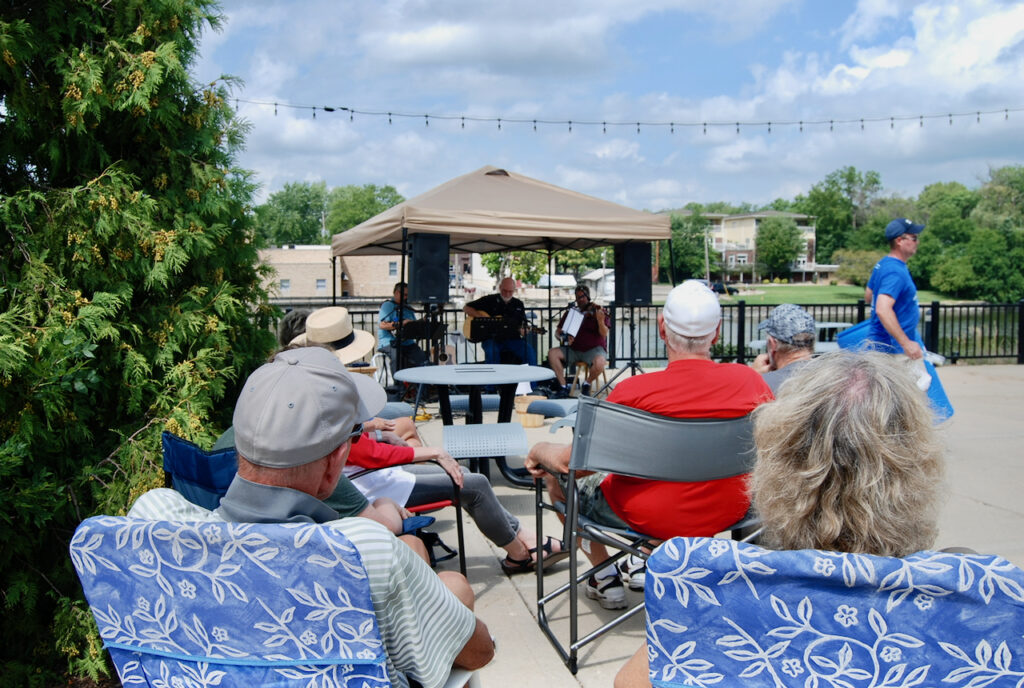
Event-goers enjoy music alongside the Rock River in Fort Atkinson. The event was one of many scheduled to entertain Jefferson County visitors and residents alike in 2021. File photo/Kim McDarison.
.
Legislature, Evers, announce new shared revenue plan, includes 20% increase for municipalities
(Originally published June 16, 2023.)
By Kim McDarison
A final step to turn two shared revenue bills into law remains after both chambers of the Wisconsin Legislature — the Assembly and the Senate — voted on Wednesday in favor of the measures, which will, among other changes, increase state aid to municipalities, known as “shared revenue,” by 20%.
According to Mike Mikalsen, chief of staff serving in the office of State Sen. Steve Nass, the two bills, Assembly Bill (AB) 245 and Senate Bill (SB) 330 have been directed to the governor’s office. The governor, upon their receipt, has six days to decide if he will sign the bills, Mikalsen said, adding that the governor has indicated that he is “likely” to sign them.
Nass, R-Whitewater, represents State Senate District 11, which includes the cities of Fort Atkinson and Whitewater.
What’s in the bills?
Information released by the governor’s office on Thursday, June 8, noted that the bills also included at least six new provisions which would impact K-12 funding.
Evers noted that the bill, which he called a “compromise with the GOP,” includes more than $1 billion for K-12 education, $30 million in school-based mental health services, and a 20% increase in support to local communities statewide.
Last Thursday, according to the release, Evers, Senate Majority Leader Devin LeMahieu, R-Oostburg, and Assembly Speaker Robin Vos, R-Rochester, reached a tentative compromise regarding shared revenue, which the release described as “one of the most significant sources of funding provided by the state to local governments.” The agreement, the release stated, was contingent upon several provisions, including “a historic investment in K-12 schools and education.”
The release noted that the 20% increase in shared revenue as outlined in the agreement would be used to support “communities of every size statewide.”
“For too long, our communities have been asked to do more with less, and this agreement is critical to ensure our local partners have the resources they need to meet basic and unique needs alike. After working through much of last night (Wednesday, June 7), I have reached a tentative agreement with both Majority Leader LeMahieu and Speaker Vos on major provisions of a compromise on shared revenue that will mean historic increases in support for our local communities across Wisconsin,” Evers was quoted as saying within the release.
“This compromise will be transformative for our communities and our state, and coming to an agreement in principle on major parts of this proposal is a significant milestone in my negotiations with Republican leaders over the past few months,” Evers continued.
According to the release, the agreement makes investments in K-12 education statewide by:
• Providing more than $1 billion in spendable revenue for K-12 education to maintain two-thirds funding, including a $325 per pupil increase in each fiscal year on revenue limits;
• Setting aside $50 million to improve reading and literacy outcomes for K-12 students (details for exact implementation of the funding have not yet been determined);
• Providing a per pupil aid increase for choice and independent charter schools;
• Investing $30 million over the biennium to continue the governor’s initiative to support school-based mental health services statewide;
• Reaching 33.3% reimbursement for special education, and
• Increasing the low revenue ceiling from $10,000 to $11,000 per student.
Within the release, Evers stated: “What’s best for our kids is what’s best for our state, and I will never stop trying to do the right thing for our kids. This compromise ensures we make a historic investment in this budget for K-12 schools and education, providing more than $1 billion that can be used for our kids in the classroom, while also working to improve literacy and reading outcomes and support school-based mental health services statewide.”
According to information provided through a legislative memo, proposed 2024-25 supplemental aid payments to municipalities are as follow: in the city of Fort Atkinson, the bill, once signed into law, is anticipated to bring a 32.5%, or a $309,933, increase to existing municipal aid of $954,375, producing total aid of $1.264 million.
In the city of Whitewater, the bill, once signed into law, is anticipated to bring a 14.6%, or a $414,560, increase to existing municipal aid of $2.83 million, producing total aid of $3.25 million.
Looking at proposed shared revenue increases for counties, in Jefferson, existing aid of $1.17 million is anticipated to increase by $817,790, for a 2024-25 total of $1.99 million.
In Walworth County, existing aid of $100,182 is anticipated to increase by $1.22 million, for a new fiscal 2024-25 total of $1.32 million.
Charts itemizing proposed increased for individual school districts are not yet available, Mikalsen said.
A document in which a breakdown by county and municipality can be found, is here: https://docs.legis.wisconsin.gov/misc/lfb/bill_summaries/2023_25/0245_ab_245_relating_to_local_government_programming_and_funding_personal_property_tax_repeal_and_city_and_county_of_milwaukee_sales_and_use_tax_authority_and_pension_systems_5_16_23.pdf.
How did local representatives vote?
According to the Wisconsin State Legislature’s website, AB245 was presented to the governor on June 14, by directive of the speaker, and passed in the Assembly by a vote of 68-26. State Rep. Scott Johnson, who represents Assembly District 33, which includes Fort Atkinson and the portion of Whitewater which resides in Jefferson County, voted in favor of the bill. State Rep. Ellen Schutt, R-Clinton, who represents Assembly District 31, including the portion of Whitewater residing in Walworth County, also voted in favor of the measure.
AB245 was passed in the Senate by a vote of 21-12, with Nass voting against the bill.
According to a “Wisconsin Legislative Council Amendment Memo,” the bill: (1) modifies the state’s approach to shared revenue for counties and municipalities; (2) repeals Wisconsin’s personal property tax; and (3) authorizes the city of Milwaukee and Milwaukee County to impose sales and use taxes, primarily to address the city’s and county’s unfunded pension system liabilities. The bill also makes other changes to state law, including some provisions specific to the city of Milwaukee and Milwaukee County and other provisions that apply throughout the state.
The full legislative memo is here: https://docs.legis.wisconsin.gov/2023/related/lcamendmemo/ab245.pdf.
The full bill, AB245, is here: https://docs.legis.wisconsin.gov/2023/proposals/ab245.
According to the Wisconsin State Legislature’s website, SB330 was presented to the governor on June 14, by directive of the majority leader. After undergoing three readings, the bill passed in the Senate by a vote of 24-9. Nass voted in favor of SB330.
The bill passed in the Assembly by a vote of 62-31. Johnson and Schutt each voted in favor of the bill.
The full Senate bill, SB330, is here: https://docs.legis.wisconsin.gov/2023/proposals/sb330.
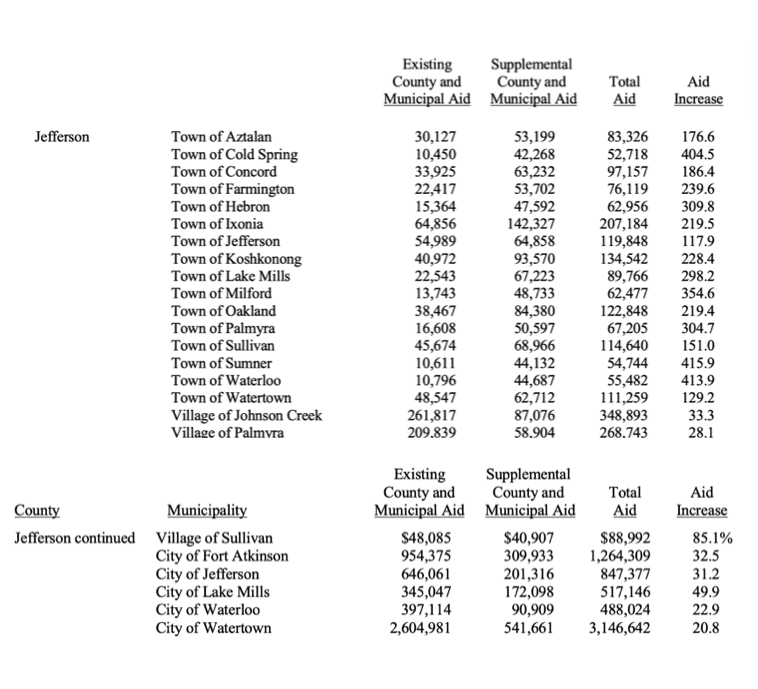

Two charts above: proposed 2024-25 supplemental aid as provided in a legislative memo is shown for municipalities within Jefferson County, at top, and Walworth County, above. The legislative document, showing the proposed supplemental aids for all municipalities and counties statewide, is here: https://docs.legis.wisconsin.gov/misc/lfb/bill_summaries/2023_25/0245_ab_245_relating_to_local_government_programming_and_funding_personal_property_tax_repeal_and_city_and_county_of_milwaukee_sales_and_use_tax_authority_and_pension_systems_5_16_23.pdf. Charts showing a breakdown of proposed supplemental aid by school districts are not yet available, according to a spokesperson in State Sen. Steve Nass’ office.
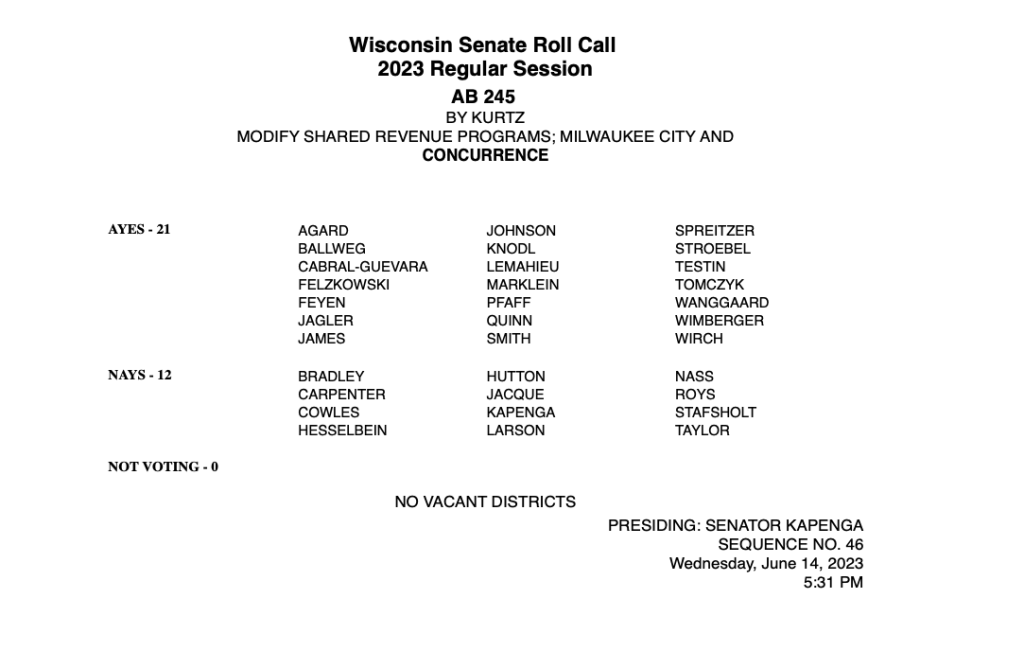

Two charts above: As shared on the Wisconsin legislative website, a chart, at top, shows which members of the Senate voted for and against AB245. The measure passed the Senate by a vote of 21-12, with Sen. Steve Nass among those voting against the measure. Above, a chart shows which members of the Assembly voted for and against AB245. The measure passed by a vote of 68-26, with Reps. Scott Johnson and Ellen Schutt each voting in favor of the measure.
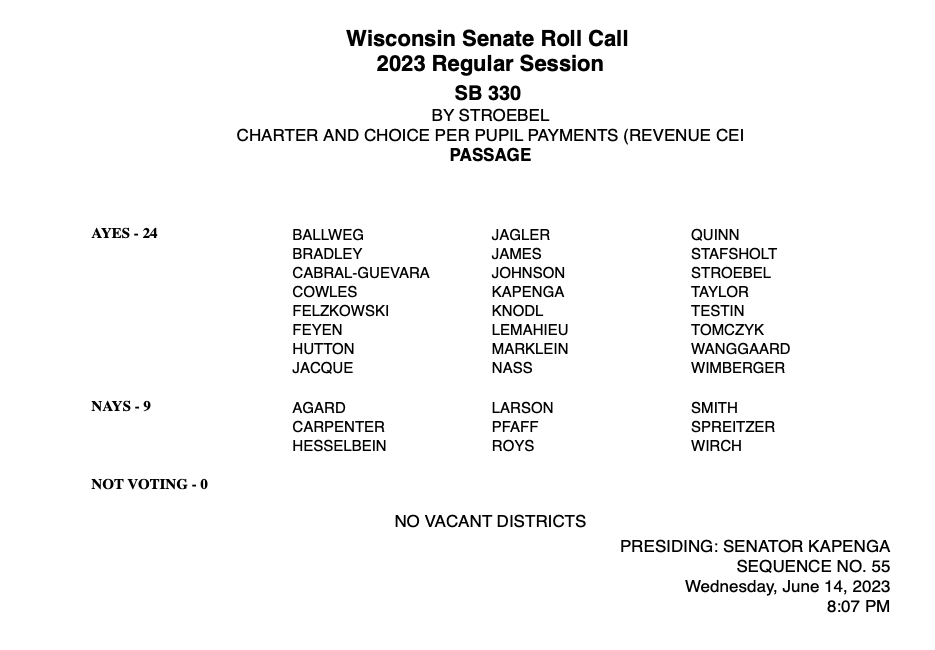

Two charts above: As shared on the Wisconsin legislative website, a chart, at top, shows which members of the Senate voted for and against SB330. The measure passed the Senate by a vote of 24-9, with Sen. Steve Nass among those voting in favor the measure. Above, a chart shows which members of the Assembly voted for and against SB330. The measure passed by a vote of 62-31, with Reps. Scott Johnson and Ellen Schutt each voting in favor of the measure.

The Wisconsin State Capitol, file photo/Kim McDarison.
Kids and cows find common ground Saturday at the ‘MOOseum’
(Originally published June 18, 2023.)
The grounds of the Hoard Historical Museum, Fort Atkinson, on Saturday were the site of myriad activities, the highlight of which was a tent filled with dairy cows made available for petting.
In it’s ninth year, the annual event, called “Dairy Day at the MOOseum,” offers an opportunity to meet each of the seven breeds of dairy cows, play old fashioned games, vote for “popular choice” recognition among an array of decorated plywood cow-shaped cutouts, and enjoy face-painting, food, and other activities.
This year, some 14 decorated cow cutouts adorned the grounds, each with a jar to receive pennies, as placed by event-goers, with each representing a vote.
Inside the museum, visitors were treated to a presentation made by Peggy Prilaman Marxen, the author of “The Farm on Badger Creek.”
Food opportunities, including ice cream floats and grilled cheese sandwiches, were provided for purchase by the Jefferson County Agribusiness Club.
The event concluded with a parade of cows along Foster Street.
Photos from the event follow.

A Jersey calf, born May 24, is among bovines visiting the Hoard Historical Museum Saturday as part of an annual event called “Dairy Day at the MOOseum.” The calf was made available for petting by the Fink family of Fort Atkinson.

A colorful array of painted plywood cow-shaped cutouts line the sidewalk behind the Hoard Historical Museum. The cutouts, each with its own jar, were made available as part of a “popular choice” contest. Event-goers were asked cast their votes by placing pennies in the jars.

Megan Lundy unloads a heifer on Foster Street. The animal was one of nine supplied by her family for petting at the Dairy Day at the MOOseum event.

Megan Lundy, at left, and Rachel Simonson, Jefferson, wash a cow’s legs and hooves before leading the animal to the petting tent.

Deb Lundy, a member of a dairy farming family from Jefferson, stands with several cows from her farm. The family milks some 60 cows daily, and keeps some 200 cows, including breeding animals and calves, she said. The family has farmed in Jefferson since 1987 and has been bringing cows for petting to the Dairy Day at the MOOseum event for nine years.

A Dairy Shorthorn cow munches Saturday on some hay in the petting tent at the Hoard Museum.

A Red and White Holstein cow awaits visitors to the petting tent during Dairy Day at the MOOseum.

Duane Marxen, Middleton, pets a cow. His wife, Peggy Prilaman Marxen, who is the author of “The Farm on Badger Creek,” was a featured speaker during the Dairy Day at the MOOseum event.
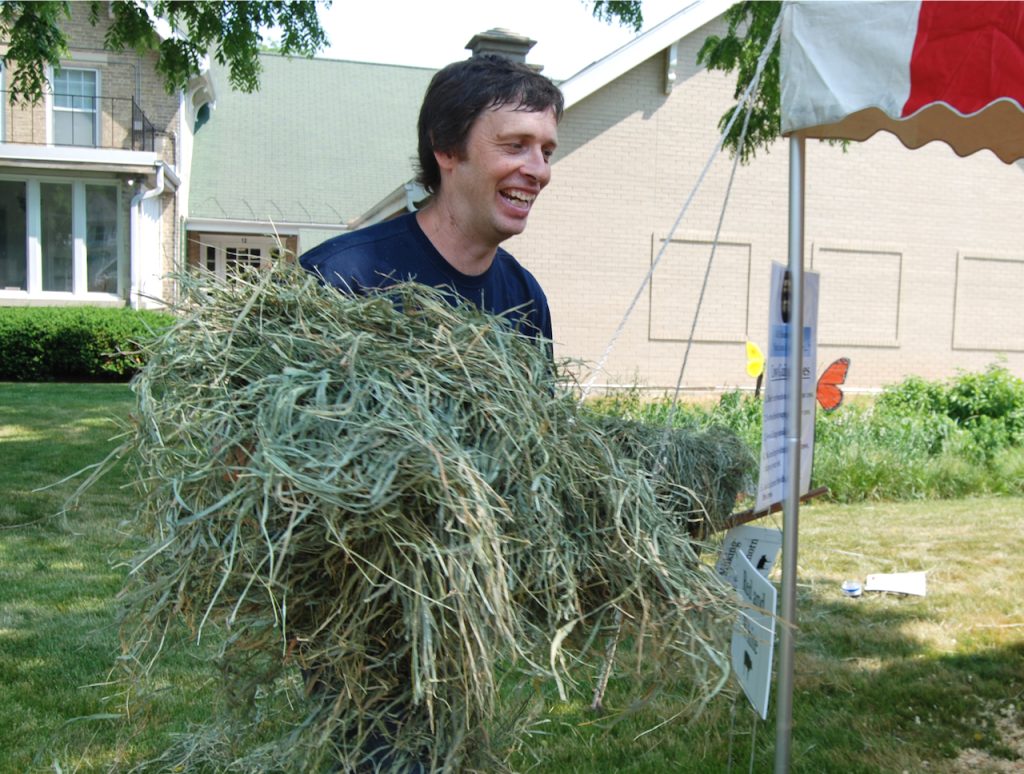
Mark Lundy brings hay to the bovines in the petting tent that are under his care.

Jefferson High School senior and FFA student Rachel Simonson leads a cow into the petting tent. She participates with members of the Lundy family by showing their cows at exhibitions, including those held at the Jefferson County Fair.

Nicole Luther holds 2-year-old William as they journey into the petting tent. The family lives in Edgerton.

Rachel Simonson takes a moment to acclimate a young calf to her new surroundings.

Two-year-old Antonio Garcia Jose, Fort Atkinson, expresses some concern about approaching and petting a young calf. His mother, Raquel Jose Alvarez, offers support as he considers the situation.

A representative of the Ehrke Farm in Fort Atkinson displays various foods fed to cows, at left, and provides a bag of treats for human consumption, at right. The family-owed farm keeps between 30 and 50 cows which, the representative said, are used primarily for showing by area 4-H and FFA students.

Nora Rohde, 5, Fort Atkinson, at right, is among children petting a young calf in a tent filled with cows of all dairy breeds.

Hans Wagenpfeil holds his son, Parker, 2, both of Oshkosh, as he pets a cow. The father and son arrived at the dairy day event while visiting Hans’ parents who live in Fort Atkinson.

Wilson Fink, 14, at left, and Hank Fink, 18, visit with a cow brought for petting by the Lundy family. The teenagers are members of the family responsible for providing the young calf for petting on Saturday. The teens said they live and work on the family farm in Fort Atkinson which is home to some 50 dairy cows. This is the second year the Fink family has brought animals for petting to the annual Hoard Museum event.
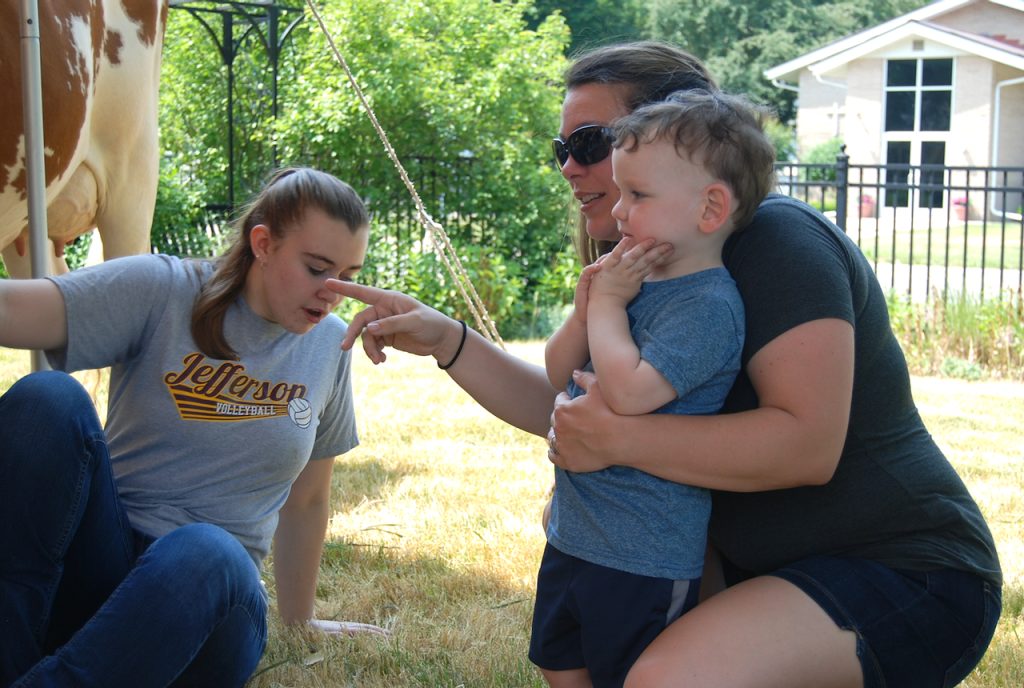
Megan Agnew, Fort Atkinson, supports her son, Owen, who is nearly 3, as he contemplates petting a cow.

Jefferson High School and FFA student Rachel Simonson visits with a cow as she awaits pets from event-goers.

After visiting the face-painting table, 9-year-old Rachel Lee displays her new look. Children visiting the face-painting table were painted with cow motifs.

Emerson Ganz, 7, Fort Atkinson, paints a design on one of several plywood cow cutouts made available for decorating on Saturday.

Emma Rohde, 8, along with her brother, Joe, 9, paints one of several plywood cow cutouts made available for decorating on Saturday.

Sophia Vallecillo, 7, Fort Atkinson, mixes her colors before heading to the plywood cow cutouts waiting to be decorated.

Maggie Tabor, a volunteer from Racine, doctorates the face of 5-year-old Ewan Bertelsen-Finch, Fort Atkinson.
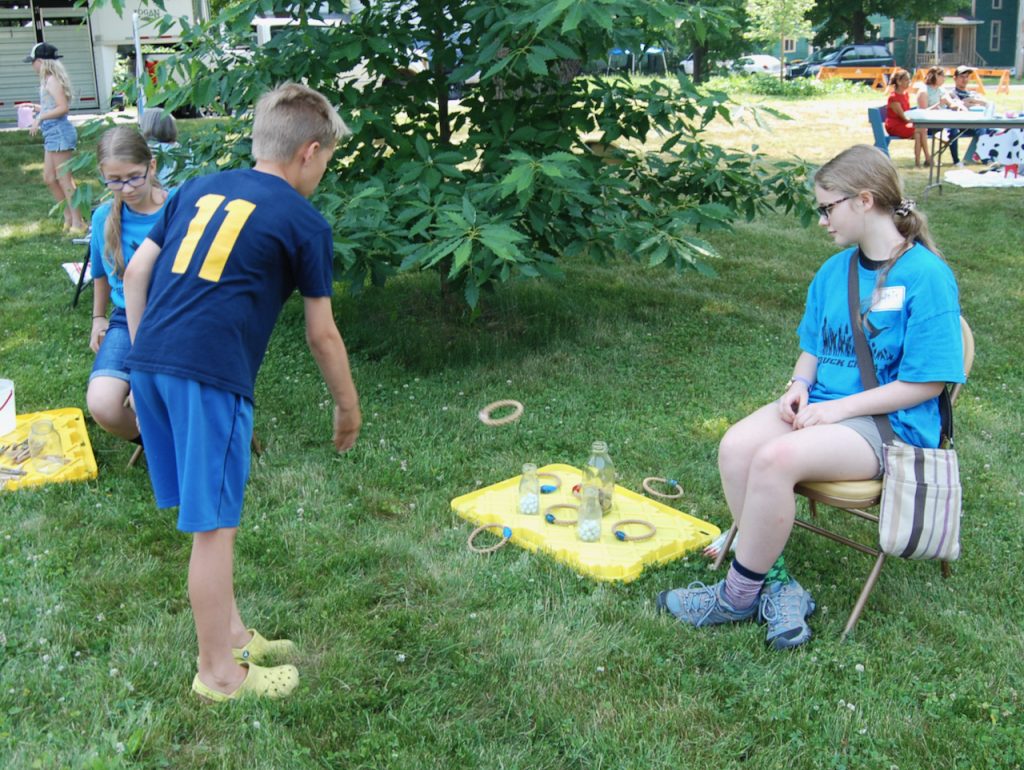
An event-goers tries his hand successfully at a ring toss game. The game was one of several, described by event volunteers as “old fashioned,” made available during Saturday’s Dairy Day at the MOOseum event.
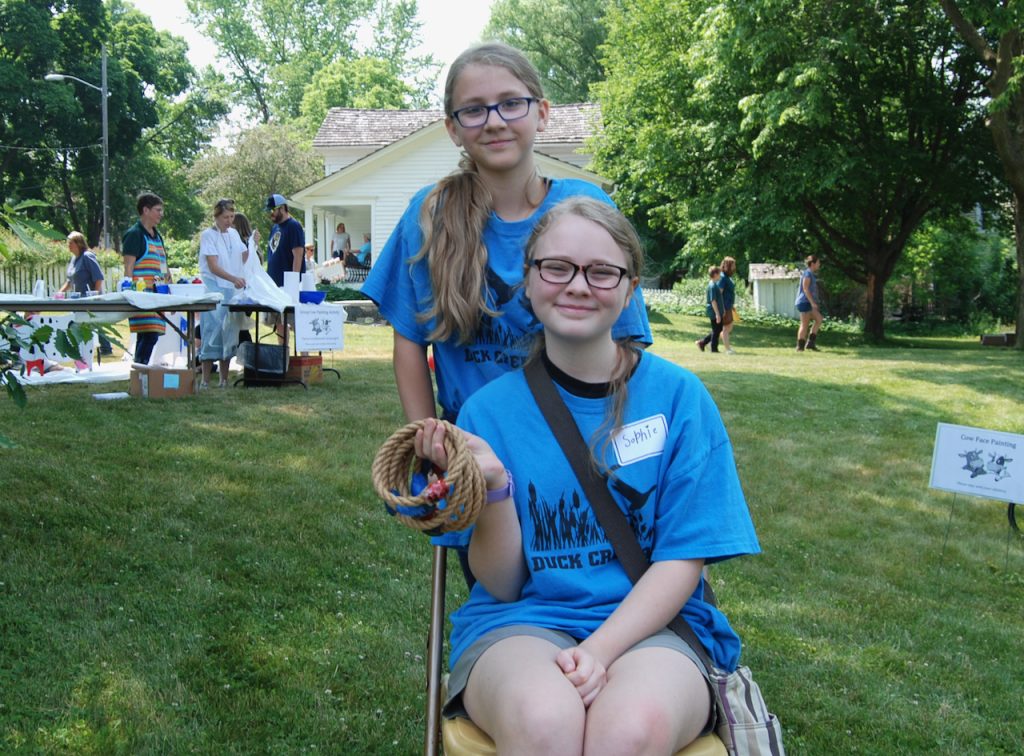
The LaVictor sisters, Grace, 11, standing, and Sophie, 13, are among volunteers manning games Saturday. The girls are both members of the Jefferson Duck Creek 4-H Club.
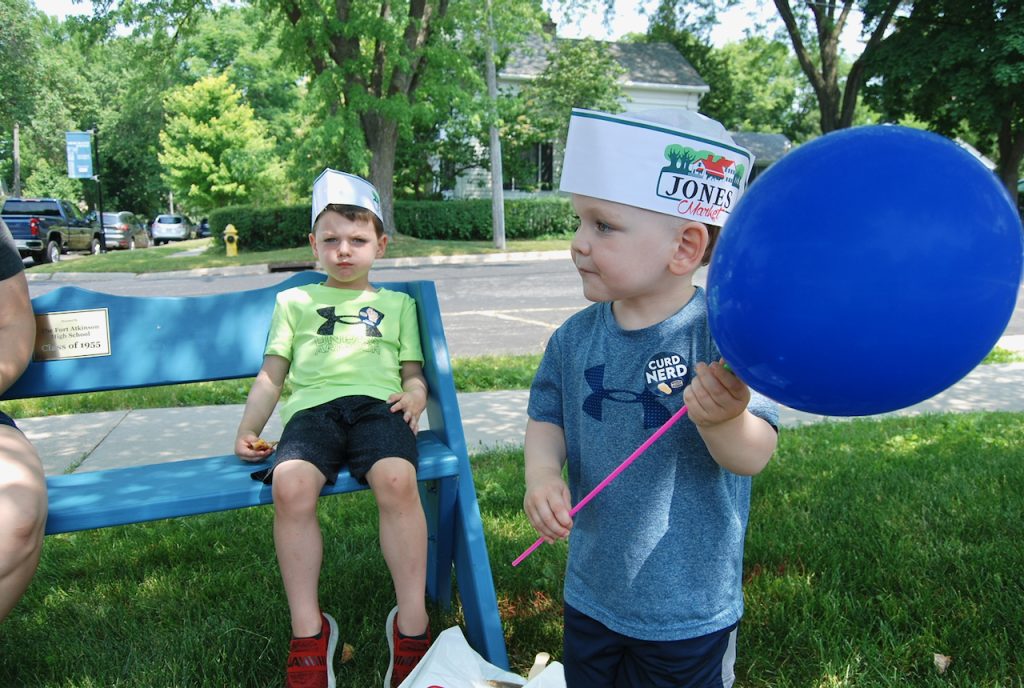
Along with his family, Owen Agnew, 3, Fort Atkinson, at right, sporting a balloon and Jones Market hat, takes a break in the shade between Dairy Day activities.
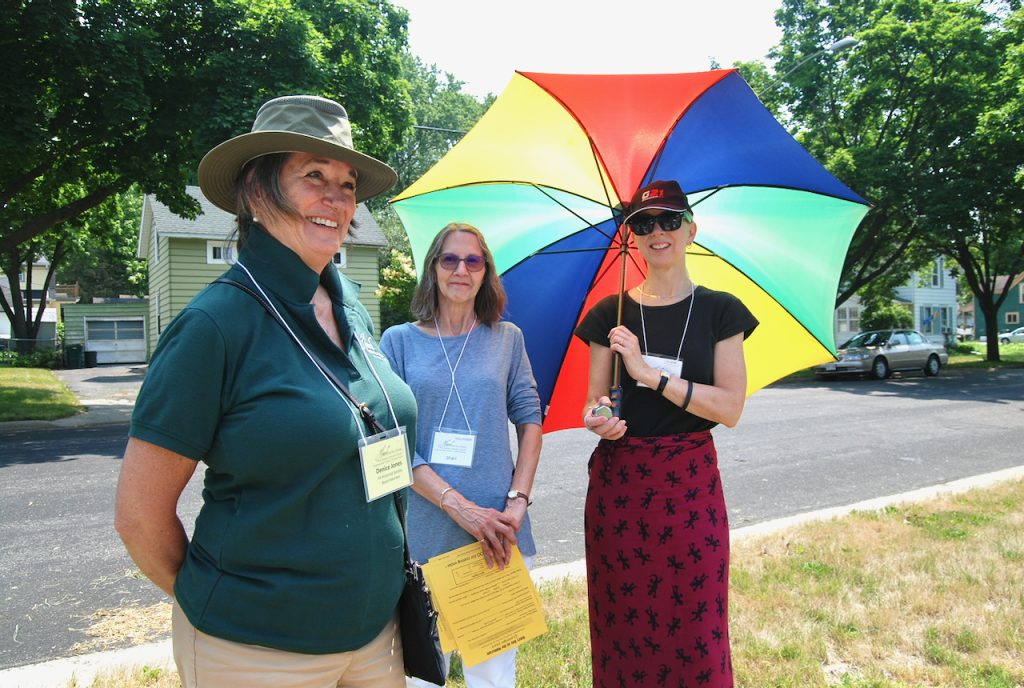
Denice Jones, Fort Atkinson, who also is a Fort Atkinson Historical Society board member, from left, and event volunteers, Shari Dunn and Lane Liebergen, both of Fort Atkinson, greet visitors to the Dairy Day at the MOOseum event entering the Hoard Museum property from the Foster Street side. The women said the event was well-attended, noting that just 45 minutes after it began, some 70 people had entered the event from Foster Street, and other volunteers were counting visitors as they entered from the Whitewater Avenue side. The women also were on hand to help event-goers cast votes for a “popular choice” award which would be given to a decorated cow cutout in one of two categories, during the event. Some 14 entries into the contest were available for viewing.
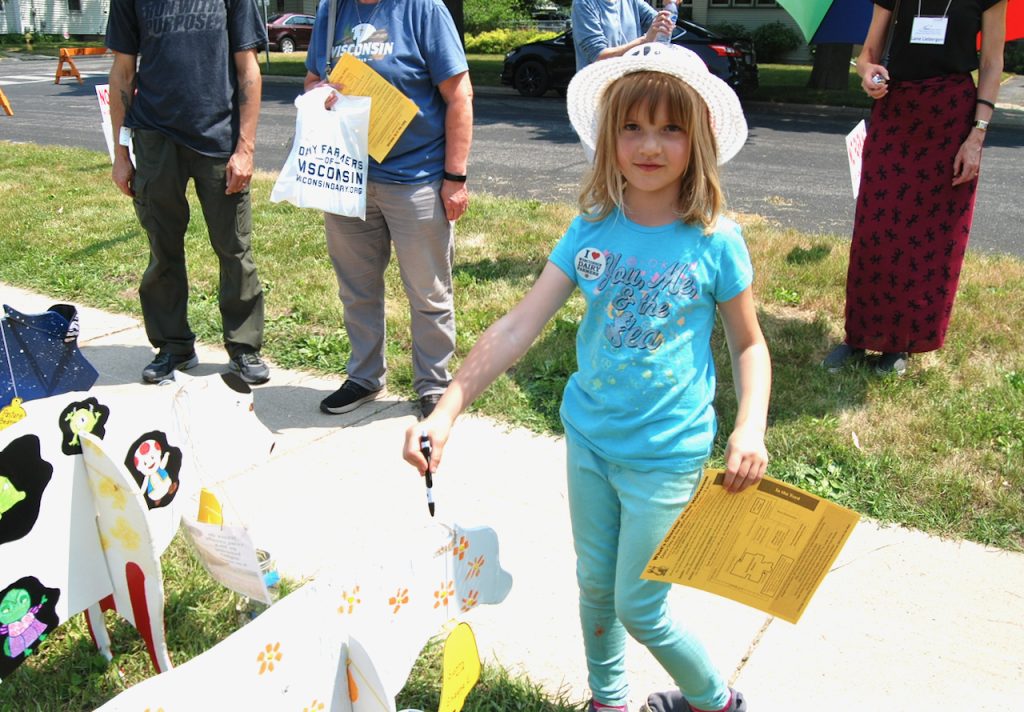
Kat Kalvaitis, 6, Fort Atkinson, casts her vote for a cutout called “Sunny,” decorated by “Shauna E.” Kalvaitis chose the piece because, she said, “It looks like spring.”
Kim McDarison photos.
‘This, That and the Other’ fills Fort’s Barrie Park
(Originally published June 22, 2023.)
“This, That and the Other” was the theme Monday as event-goers gathered in Fort Atkinson’s Barrie Park to listen to music performed by the Fort Atkinson Community Band.
The summer concert series is in its 63rd year.
Four more concerts remain in the series, each on a Monday night, throughout July and into the first week of August.
Event-goers are encouraged to bring chairs and blankets, although some seating is provided by the Fort Atkinson Parks and Recreation Department.
The concerts are free and open to the public, although donation boxes are available during performances for those who would like to help support the band.
As earlier reported by Fort Atkinson Online, Fort Atkinson Community Band Director Wayne Crook noted that some funding traditionally used to support the band will continue this year, and become discontinued in 2024. An earlier story about the band’s funding is here: https://fortatkinsononline.com/fort-community-band-seeks-funding-city-to-discontinue-contribution-in-2024/.
This year, ice cream socials will be held in conjunction with the concerts.
Monday’s ice cream social was sponsored by the First Congregational United Church of Christ, with proceeds benefiting the Unity Project of Fort Atkinson.
Crook noted in a recent news release that musical selections chosen for performances throughout the series are in “all styles of music” and “for all ages to enjoy.
“Every concert includes traditional marches, show tunes, swing music, polkas, soloists, novelty selections, and Latin and traditional symphonic band literature,” Crook said.
Concerts will move to the Trinity Lutheran Church, located across the street from Barrie Park at 314 Barrie St., Fort Atkinson, in cases of inclement weather.
An earlier story, including the band’s full summer season itinerary, is here: https://fortatkinsononline.com/summertime-music-forts-community-band-offers-full-itinerary-whitewater-continues-with-savory-sounds/.
Photos from Monday’s concert follow.

Members of the First Congregational United Church of Christ manning the ice cream social tables Monday, at left, aid event-goers as they make purchases. Along with ice cream, the members offered an array of pies and cookies. Proceeds benefited the Unity Project of Fort Atkinson.
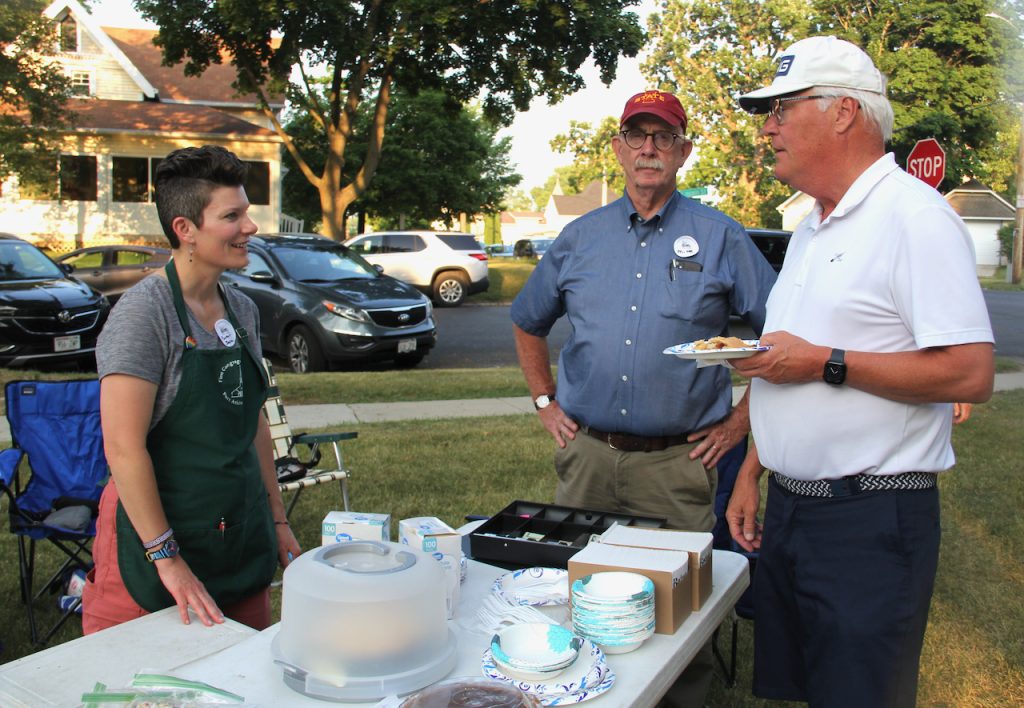
The Rev. Paul Johnsen, a former pastor of First United Methodist Church, Fort Atkinson, between 2017 and 2021, serving today at Monona United Methodist Church, at right, makes the acquaintance of the Rev. Dr. Sara Rabe, the minister serving Fort Atkinson’s First Congregational United Church of Christ, at left. The First Congregational United Church of Christ sponsored Monday’s ice cream social.
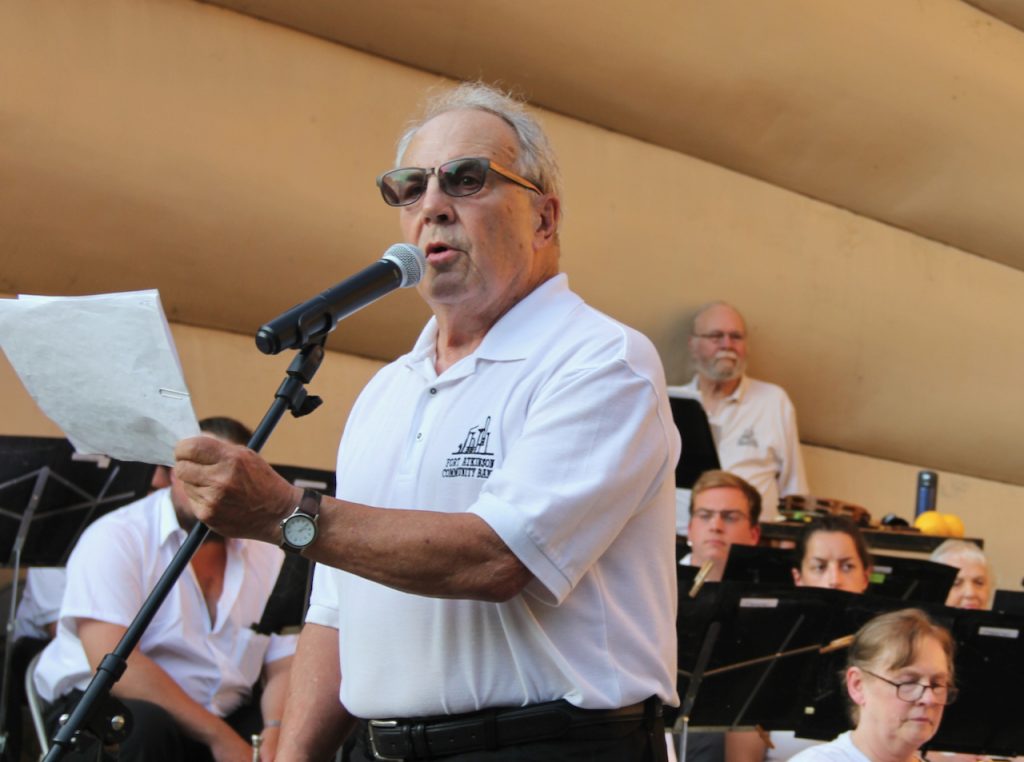
Fort Atkinson Community Band Director Wayne Crook on Monday welcomes spectators to Barrie Park.

Janesville residents Alician and Keith Pearce dogsit their son, Adrian’s dog “Margaret.” Adrian plays the trumpet in the Fort Atkinson Community Band.
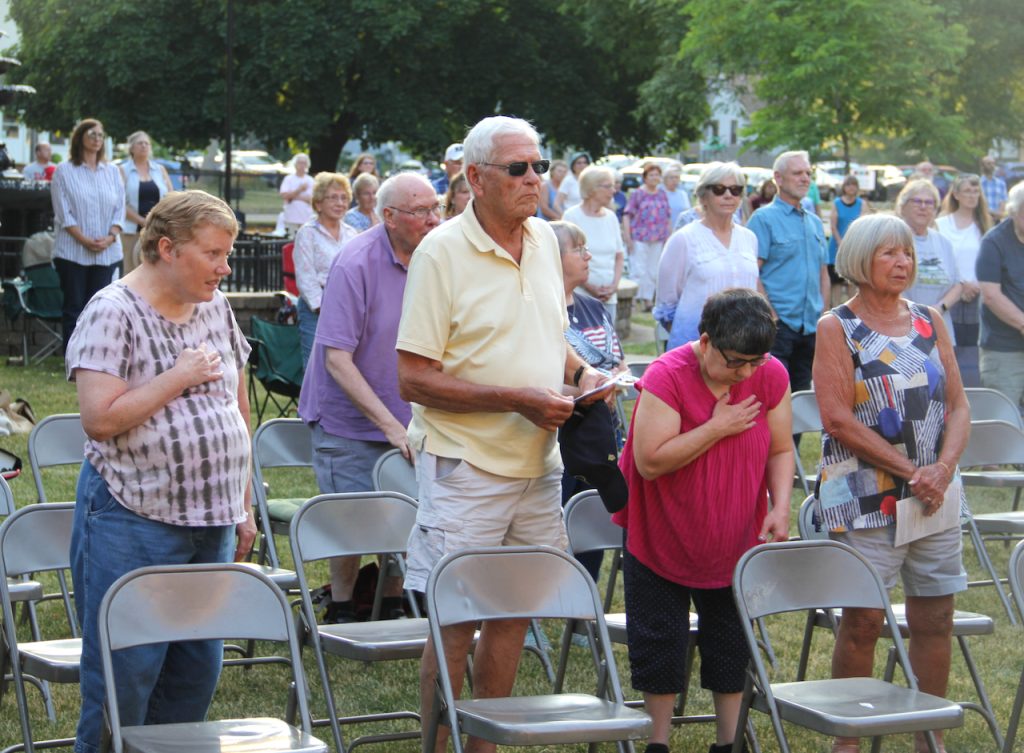
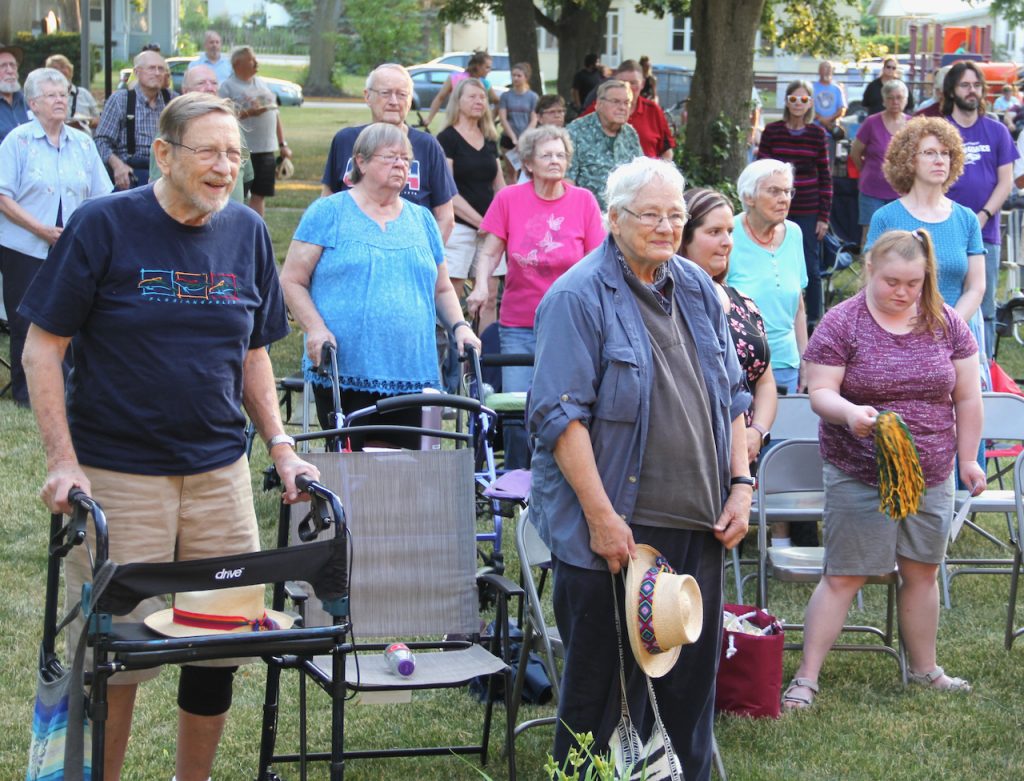
Two photos above: Band concert attendees stand for “Shche ne vmerla Ukrainas,” Ukraine’s national anthem. The selection is played at the opening of each concert, a tradition begun by the band last summer, following Russia’s invasion of Ukraine in February of 2022.

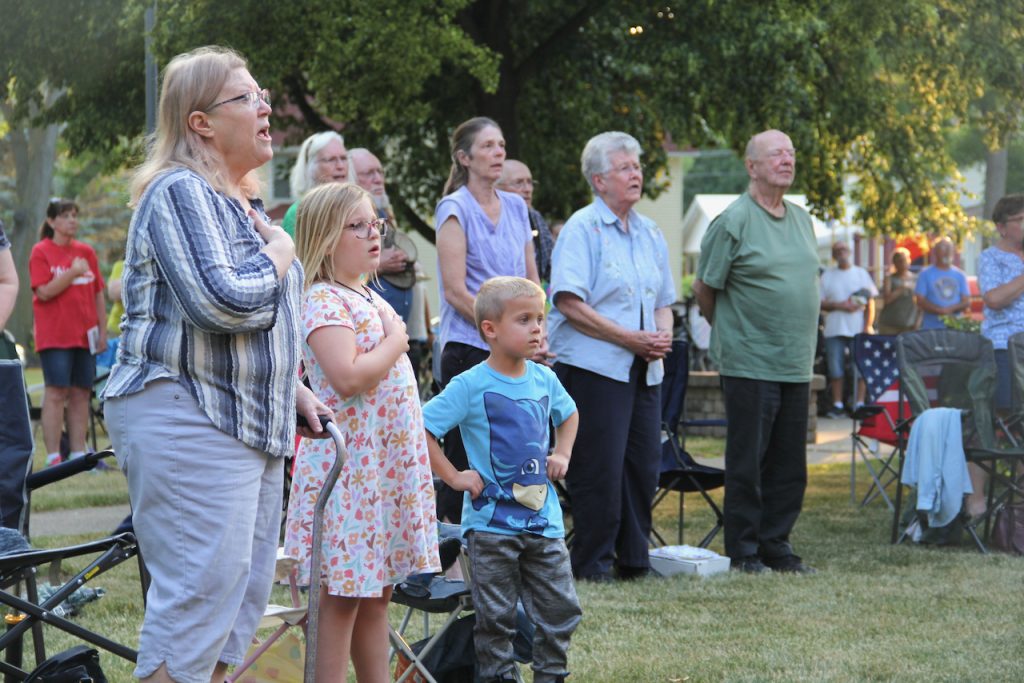
Two photos above: At top, a cymbals player contributes to the performance of the “Star-Spangled Banner,” while, above, spectators rise for the national anthem.
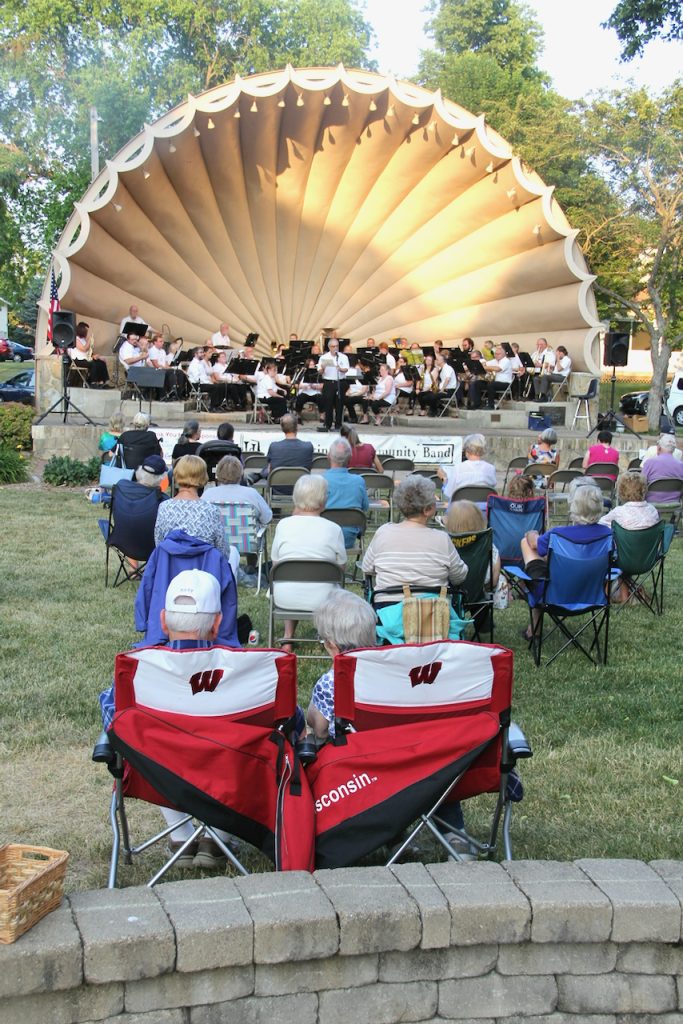

Two photos above: Members of the evening’s sizable crowd enjoy the band’s rendition of “March Grandioso.”
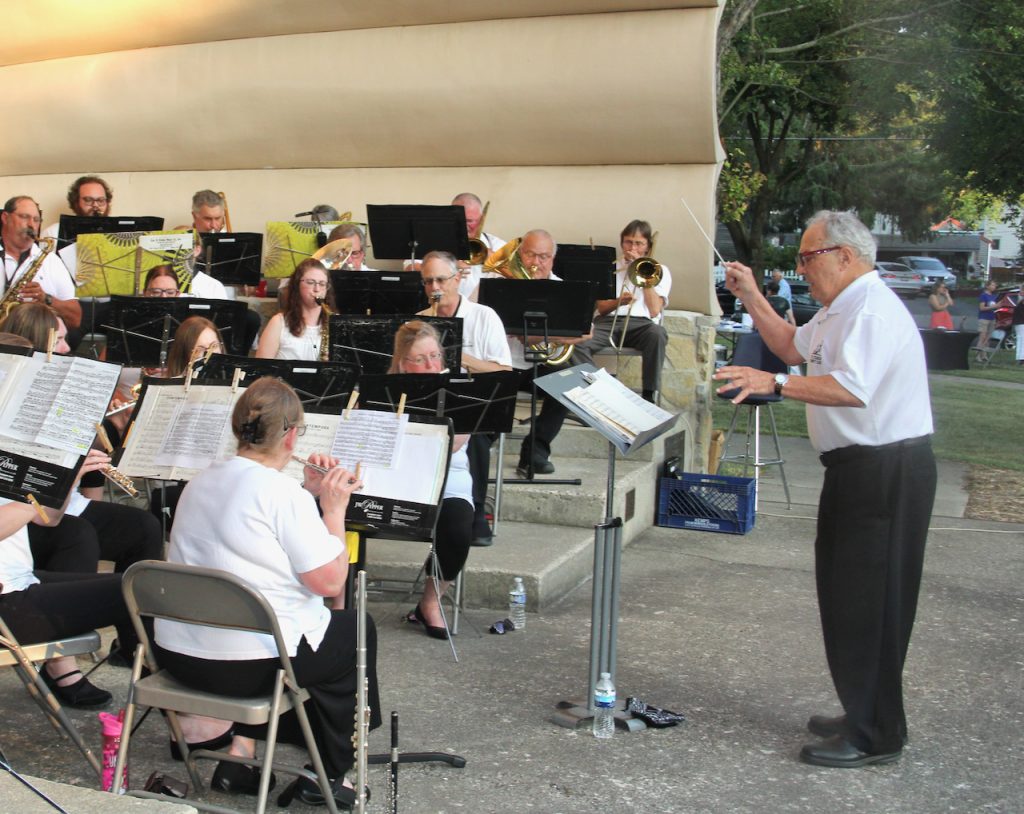
Wayne Crook directs the Fort Atkinson Community Band during its renditions of “Just a Closer Walk With Thee” and “Espirit De Corps.”
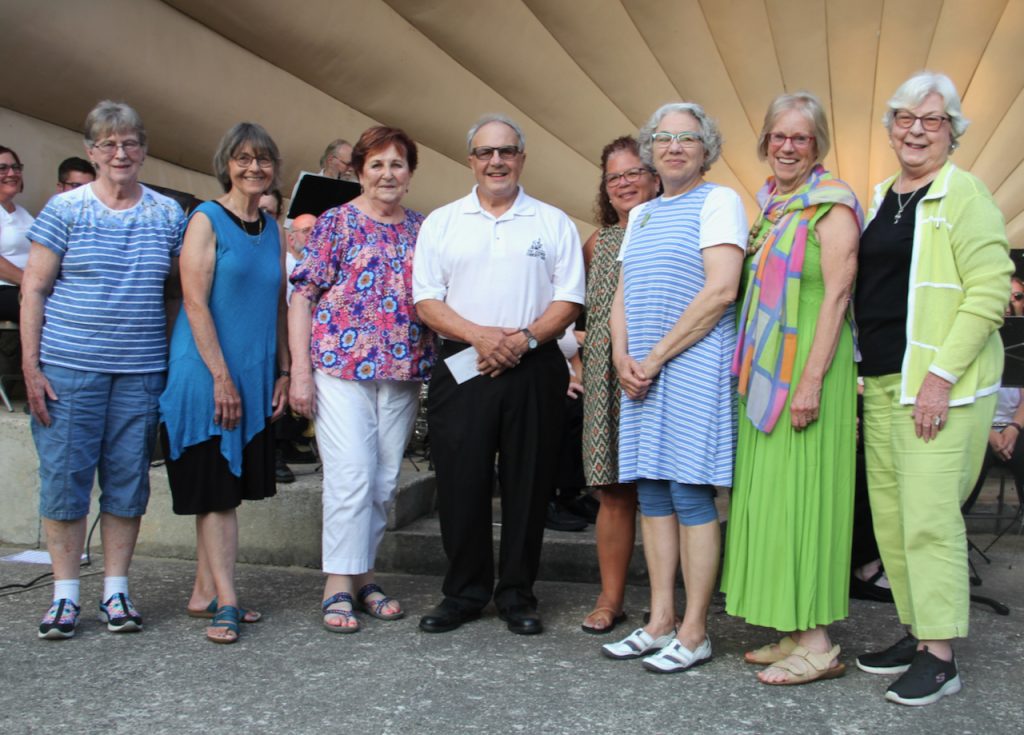
Flanked by members of the Fort Atkinson Woman’s Club, Fort Atkinson Community Band Director Wayne Crook is presented with a $500 donation made by the club in support of the band.
Chris Spangler photos.
Torgerson: ‘My journey in this physical world is almost complete’; donates flag to Evergreen
(Originally published July 20, 2023.)
By Chris Spangler
Life is what you make of it, and Judy Torgerson’s has been a joyride.
But now her days are numbered, so she is writing her own obituary, gifting jewelry to loved ones and donating a new flagpole to Evergreen Cemetery.
It was on July 10th that the 72-year-old Fort Atkinson woman shared the news on Facebook.
“My journey in this physical world is almost complete,” she wrote. “Started hospice last week. Thank you to all that helped make this physical world journey more enjoyable than one could ever expect.”
As a last request, Judy asked friends and relatives to read “The Dash Poem” by Linda Ellis. Posted on https://lindaellis.life/, it is a reminder that what people do between the birth and death dates on their tombstone is what truly counts.
“Everybody I talk to, I make them promise they will read the poem ‘The Dash,’ and then I tell them, ‘I want you to promise that you always will compliment people.
“I try to compliment people wherever I go. I am building my Amway structure with people of goodwill, and I will until I cannot breathe anymore.”
A lifelong Fort Atkinson resident, Judy was born Feb. 6, 1946, to William and Virginia (Bunny) Ponyicsanyi. She graduated from Fort Atkinson High School in 1964, attended the University of Wisconsin-Whitewater and married Robert Torgerson of Jefferson on May 4, 1968. He died of a heart attack in June of 1996.
Judy was employed part time through the years at Uncle Josh Bait Co., Valley Sanitation, the Fireside Dinner Theatre, Jefferson County, American Invotech, and Bruno Independent Living Aids in Oconomowoc. At age 60, she became Nasco’s assistant director of healthcare, retiring after five years.
“Wherever I worked, whatever I did, there was no job beneath me that I couldn’t do,” Judy reflected.
She has two children, Mandy (Brian) Wagie, of Fort Atkinson, and John (Jessie) Torgerson of Oregon, Wis., and five grandchildren. Her parents, husband and brother, Mike, are deceased.
Health problems
Judy was in good health until 2014, when she suffered a stroke while driving to the store. It took some time and rehab, but she bounced back.
Two years later, she called to schedule her annual mammogram, but was told that since she now was 65, she could wait another year.
“Big mistake,” Judy said. “By the following February, I am lying on the couch and I reach over and feel a lump.”
That afternoon, Judy was diagnosed with breast cancer.
“I said to the doctor, ‘look at me, look at me, are you looking at me real good? If you notice, I look like Dolly Parton right now, and I don’t want to get out of this looking like Twiggy,’” Judy recalled. “I’m always joking, always.”
Even when facing illness.
(No wonder why doing standup comedy is at the top of her bucket list.)
At St. Mary’s Hospital in Madison, Judy underwent a mastectomy on her left breast and a reduction of her right. Unfortunately, fluid and scar tissue problems lengthened the healing process, and the surgeon held off on starting chemotherapy until time was running out.
“I lost all my fingernails, all my toenails, all the hair on my head, all the hair on my legs,” Judy said. “Blisters showed up on my legs. I still have no feeling in my hands and feet. I had mouth thrush; I passed out and was taken to the hospital because I couldn’t eat or drink for 24 hours.”
She underwent chemotherapy for 12 weeks, with the exception of the final session “because I just couldn’t take it.”
Judy then was moved to Alden Estates of Jefferson Rehabilitation and Health Care Center. She had radiation treatment each weekday for eight weeks. Again, the exception was the last one because her back had burned.
“It looked like someone had put a not iron on me,” Judy noted.
It took a while, but Judy bounced back once again.
On the rebound?
“I was living life to the fullest,” she said. “I told the doctors, ‘for whatever reason, God wants me here.’”
An avid swimmer, Judy bought a senior pass for the aquatic center and would tread water for at least an hour each day. She watched her grandson play ball at Ralph Park and played cards at the senior center.
“So everything was cool until 2022, when all of a sudden one day I became ill. They took me up to the hospital by ambulance and it was diagnosed that I had diverticulitis very bad,” Judy explained.
She was prescribed a round of antibiotics for four hours on and four hours off for nearly a week.
“And then everything went to hell in a hand basket,” Judy said, “Since then, it has been one thing after another after another.”
She went in for her six-month cancer checkup, and her oncologist took numerous blood tests followed by a bone marrow biopsy.
“Of course, that didn’t go well either, and I ended up with a contusion,” Judy said. “I was in excruciating pain and went into hospital, this time in Janesville.
“The diagnosis was that I have multiple myeloma, for which there is no cure,” she added.
Multiple myeloma is a cancer of the plasma cell, a type of white blood cell found in bone marrow that produces antibodies to help the immune system fight infections. Cancerous plasma cells produce abnormal M proteins, a high level of which can damage the kidneys and weaken the immune system. They also replace normal cells with tumors, usually in the bone marrow.
The American Society of Clinical Oncology reports that multiple melanoma is “relatively uncommon in the United States,” affecting about one in every 132 people. Approximately 30,000 cases are diagnosed each year.
“The doctor said she noticed that everything was starting to fail … my liver, kidneys,” Judy said. “She did get my kidneys back in order, but I also have congestive heart failure and COPD (Chronic Obstructive Pulmonary Disease) mixed in with all that.”
A couple weeks ago, the oncologist informed Judy that there is a three-drug chemotherapy she could try.
“But I had to be on a special diet, I had to weigh myself, I had to do this and that and there were certain things I could never eat again. No alcohol whatsoever. No quality of life. None,” Judy said.
The alternative was Rainbow Hospice Care.
“After evaluating everything, I decided I didn’t want to go through this again,” she said of chemotherapy.
Understandably, her children disagreed with Judy’s decision.
“I told them ‘I can try it and end up sicker than I am now.’ Finally, I convinced everybody that I wanted to go with hospice,” Judy said.
“I want to stay home when I die. And I want to die as quickly and painless as possible. I’m ready. But It’s not dying, actually; I’m ready for what the new experience will be.”
Right now, Rainbow Hospice Care nurses stop in twice a week and aides, three times week. While Judy still is able to walk short distances without her walker and bathe herself, she said it is nice to have help trimming her toenails and doing other such tasks.
“I thought I’d have months (to live), but the nurse today said it’s weeks. I’m feeling the best I have in a long time, so I asked, ‘what do you base this on?” Judy said.
The response: Her last blood test and her health compared to that of other multiple melanoma patients her age.
Cemetery flag
So Judy is double-timing to complete everything she wants to accomplish.
That includes contributing $4,000 for a new flagpole, American flag and landscaping at the North Main Street entrance to Evergreen Cemetery.
While meeting recently with cemetery association President Brad Wilcox and grounds supervisor Raughn Ferrell to discuss perpetual care at her and Bob’s gravesite, Judy inquired as to what projects were on the cemetery’s wish list. Wilcox said many are awaiting contributions, and then mentioned a flagpole.
“Bingo, bango! I said ‘write it up, give me a quote, let me know what it is, give me a call. I’m doing it,’” Judy said, calling herself “a flag person.”
Family and friends had donated the flagpole at Ralph Park in memory of Bob, she said, and this would mirror that effort as a memorial to the Ponyicsanyi, Torgerson and Justman families, the latter being her maternal grandparents.
“My roots run deep,” Judy said. “My mother was born here; my dad came here when I was 2. I was born here. Mike was born here. My kids were born here. Mandy’s kids were born here, so we’re on our fifth generation.”
The flagpole was erected July 12. It will be landscaped with pavers and red, white and blue flowers, matching the flagpole at the cemetery’s rear entrance.
“I’m an American. I love red, white and blue. I love the flag,” Judy said. “I want something that is lasting, something that the community can enjoy.”
That patriotic spirit will carry over to her farewell, too. While she doesn’t plan to have a funeral — “I would rather talk with people now, not (have them come to) a funeral. I’ll be damned if I’m going to throw a big party when I can’t be there,” she said — there will be an invitation-only gathering for dispersing her cremains. And because she always has loved the Fourth of July, plans are in place for some of her ashes to be shot off in fireworks.
“There will be a big party at that time,” she promised.
She continued: “From the time we’re born, everyone has a treasure chest. When it comes to my family, I want each of them to take out some of the treasures remembering me and share them.”
In the meantime, Judy is busy getting her personal affairs in order. She has penned the first draft of her obituary and met with her financial adviser.
“I also am writing my own eulogy because I want to have the last say,” Judy laughed.
Feeling appreciated
Judy said that she initially didn’t tell anyone about her multiple myeloma diagnosis because she didn’t want people to feel sorry for her. At the same time, she felt it was important to share the news.
“All of a sudden, wow, bing, bang. I never realized what an impression I’ve made on so many people,” she said, referring to the reactions from her Facebook friends. “I told someone the other day that after reading so many of these comments, I hope they can get my head through that door.”
That optimism and sense of humor have been Judy’s trademark her entire life.
“I love people. I love making people happy. Thats how I was born,” she said.
“I have been extremely blessed. I don’t ask God for anything. He’s always known what I’ve needed. My road has had rocks, but I’ve been able to kick those by the wayside.”
Her positive attitude was inherited from her mother.
“She would say, ‘Life is like a rollercoaster ride. You have your ups and downs and the curves, but remember, Judy, when you hit bottom, you’ve only got one way to go. Just don’t get off the rollercoaster,” she said. “This is true in a marriage, job, everything, life in general.”
And now that her ride is nearly over, Judy wants to leave everyone one important piece of advice:
Reflect — and then act — on your own dash.
“I have lived life to the fullest,” she said. “I am ready for the next chapter.”
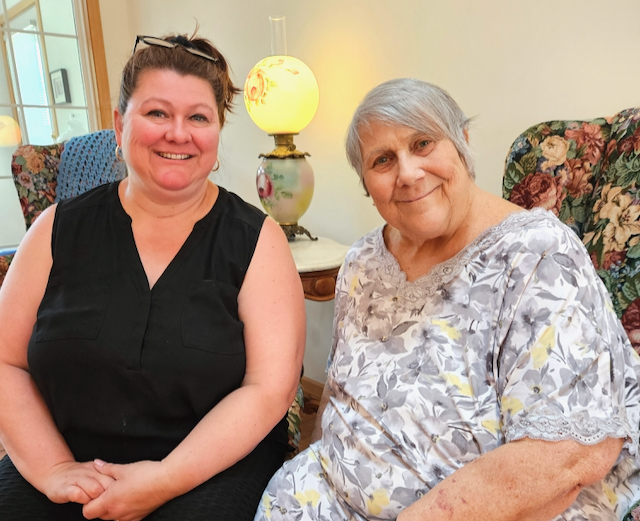
Fort Atkinson resident Judy Torgerson, at right, visits with her daughter, Mandy Wagie. Torgerson has contributed $4,000 for a new flagpole, American flag and landscaping at the North Main Street entrance of Evergreen Cemetery. Torgerson has been diagnosed with terminal cancer.
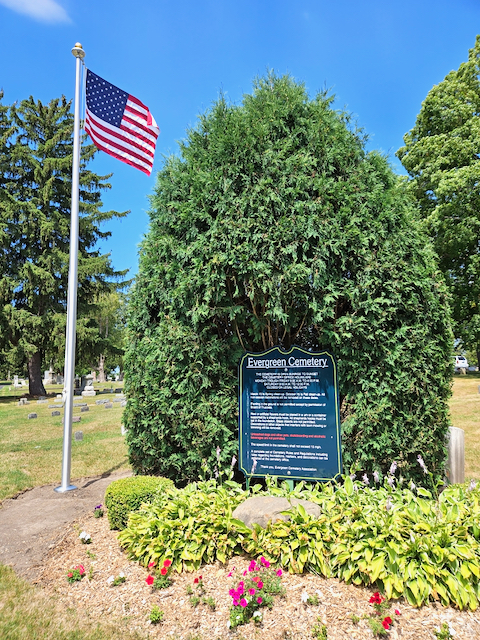
The North Main Street entrance of Evergreen Cemetery is adorned with a new flagpole and American flag. Landscaping is forthcoming. The improvements have been donated by Judy Torgerson, Fort Atkinson.

Evergreen Cemetery, Fort Atkinson, employee Josh Wasser, at left, and cemetery grounds supervisor Raughn Ferrel attach a rope to a recently donated flagpole.
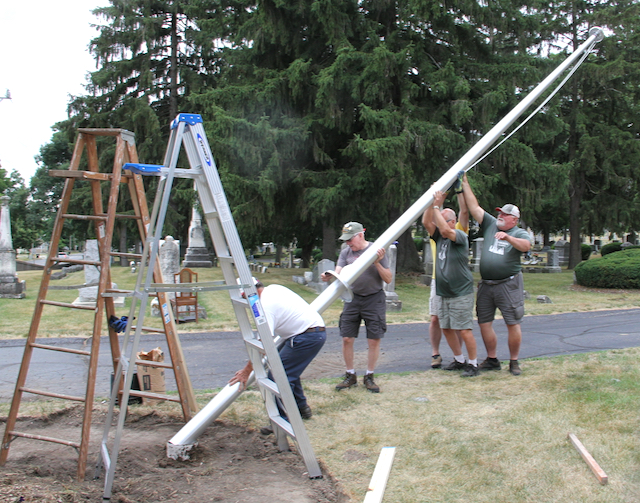
Members of a grounds crew, including Evergreen Cemetery Grounds Supervisor Raughn Ferrell, cemetery employees Neal Traeder and Josh Wasser, and volunteers Ardell Wiederhoeft, and Rollie Carothers, not in pictured order, work together to erect a flagpole. The pole, a flag and some landscaping in the cemetery have been donated by Fort Atkinson resident Judy Torgerson in memory of the Torgerson, Ponyicsanyi and Justman families.

Evergreen Cemetery Grounds Supervisor Raughn Ferrell, at left, and cemetery employee Josh Wasser attached a flag to a rope before leveling and the flagpole and setting in straight. The work was completed Wednesday, July 12. The pole, flag, and some landscaping on the cemetery grounds were donated by Fort Atkinson resident Judy Torgerson in memory of the Torgerson, Ponyicsanyi and Justman families.
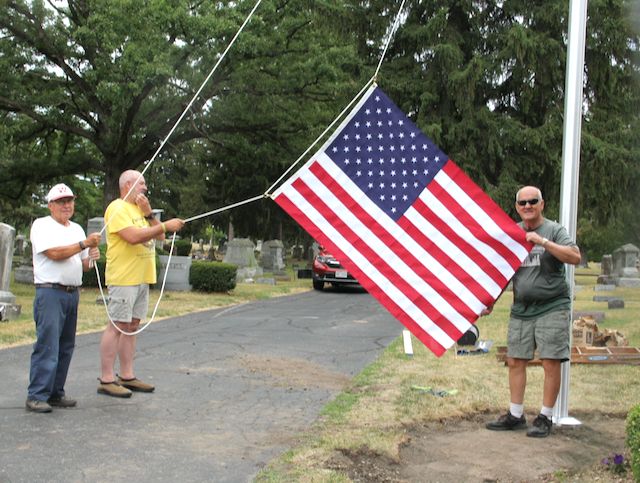
Volunteer Ardell Wiederhoeft, from left, Evergreen Cemetery employee Josh Wasser and grounds supervisor Raughn Ferrell raise a new flag at the front entrance of Evergreen Cemetery. The pole, flag and some landscaping were donated by Judy Torgerson, Fort Atkinson, in memory of the Torgerson, Ponyicsanyi and Justman families.
Chris Spangler photos.
Fort Foundation celebrates 50 years of giving
(Originally published July 27, 2023.)
By Chris Spangler
From scholarships to building projects and pretty much everything in between, the Fort Atkinson Community Foundation has been improving residents’ quality of life for a half-century.
The organization celebrated its 50th anniversary with a gathering Tuesday evening at Riverstone.
Sue Hartwick, executive director of the foundation, welcomed guests and thanked all who helped make it, as well as the foundation itself, happen.
Among them was PremierBank, which provides the foundation with back-office support, processing deposits, cutting checks and balancing its accounts.
“Their assistance seems only fitting as 50 years ago, it was the leadership at PremierBank that helped Mrs. Mary Hoard turn her idea of giving a gift to a future Fort Atkinson into the Fort Atkinson Community Foundation,” Hartwick said.
She also mentioned the late Jim Vance, who drew up the original legal documents for the foundation and then served on its board for the next 47 years as secretary and legal counsel.
Also speaking was Sue Johnson, who has served on the board for five years and is its 2023 chairperson.
She introduced her fellow board members — Sally Koehler, Jim Schulenburg and Bonnie Geyer. Director Lisa Caras was unable to attend.
In addition, she had past board members stand.
“Thank you for taking the time to serve our community, for your careful stewardship of the foundation and especially for your wise and always kind-hearted discussions around the boardroom table,” Johnson said. “We are grateful for your service.”
She saluted the dedication of Hartwick and Kaylee Kidd, foundation marketing and communications assistant, as well.
“I’d also like to acknowledge two other groups critical to the foundation’s success,” Johnson continued. “First, our donors, the lifeblood of our organization.
“To those who came before us and left lasting legacy gifts — to Mrs. Mary Hoard, who will be forever making Fort Atkinson better; to Walter and Louise Buell, with their generous estate gift that continues to churn out scholarships to our best and brightest; to mother-and-daughter team Bertha and Marilyn Kuhl, whose fund, among other projects, has helped build every single playground in our community, including the one that went up last week at Luther (Elementary) School — we again say thank you for investing in our future.”
She also applauded all current donors.
“Whether you’ve opened an endowed a fund with us or donated to a fund doing the good work you support, you provide the fuel for our operations. Thank you for your trust and for your support. Your gifts, your generosity, your vision for a better Fort Atkinson is what moves us forward,” Johnson said.
However, to continue to move forward, the foundation also needs a destination, she pointed out.
“We need project champions — people and organizations who are invested in our community and have a vision for how to make it better and, most importantly, are willing to put in the work to make their ideas happen,” Johnson said.
She cited Jude Hartwick, president of the Fort Atkinson Beautification Council, which just was awarded two grants for its upcoming cow parade and mural projects, as well as Steve Mode, the catalyst for the timberframe warming shelter at Haumerson’s Pond.
“And people who aren’t here tonight, like Joan Jones, whose sheer tenacity turned a decrepit building into the beautifully restored Fort Atkinson Club, and Laura Becker, who turned the very personal sorrow of losing a child into a playground for small children at Jones Park,” the foundation board chairperson added.
She described the community foundation as a structure to facilitate philanthropy in the community.
“However, without donors putting the money in and project champions giving us a reason to send it out, we are powerless,” Johnson said. “But when both sides of the equation get fired up, it’s amazing what we can do!”
Past projects
Hartwick reported that during the past 50 years, working close and in good-faith partnerships with the city of Fort Atkinson, School District of Fort Atkinson and the nonprofit community, the Fort Atkinson Community Foundation has invested more than $24 million back into the community and its residents.
“We’ve done that while growing our assets from an initial $25,000 gift to $35 million. It’s a remarkable feat and it speaks volumes about the unique generosity of this community,” she said.
She listed several project categories:
• City of Fort Atkinson.
“You can see the impact of this generosity by just driving around our city,” Hartwick said. “The quality of the Hoard (Historical) Museum and the Dwight Foster Public Library — recipients of our two largest grants at $1.8 million and $1.5 million, respectively — makes them unlike any amenities in other similar-sized cities. As is our habit, these were matching grants, meaning the museum and library staff and volunteers had to be really committed to the task, and they were.”
In addition, the foundation has awarded grants for many other city projects, including the riverwalk, Glacial River Recreation Trail, Fort Atkinson Aquatic Center, Wheels Park, Jones Park amenities and many playgrounds.
“We have worked closely with the city on so many projects over the years and have always been impressed with the commitment of city staff to make our community better,” Hartwick said.
• School District of Fort Atkinson.
Another critical partnership is that with the school district, she reported.
“Whether bigger projects like the high school auditorium or smaller
department-sized ones like lathes and mills for the tech-ed department or kitchen equipment for the ProStart Culinary Program, the foundation has been happy to partner with the school district to add value to our schools,” Hartwick noted.
She pointed out that thanks to the fund creators in attendance — Ed Karrels, Jim Fitzpatrick, Mabel Schumacher, the McHenrys and the Wallace family — and many others, the foundation was able to award a record $424,600 in scholarships to 80 local students pursuing post-high school education.
• Fort Atkinson Area Chamber of Commerce’s Project LEAD.
Hartwick said the chamber of commerce’s leadership program has spearheaded many community projects supported by the foundation.
“Whether the annual class went big for a veterans memorial or big and
practical for Barrie Park bathrooms or smaller and practical for energy-efficient LED streetlights, the chamber’s Project LEAD projects have always added value to our community,” she stated.
• The nonprofit community.
Hartwick added that many grants go out in response to requests from local nonprofit organizations such as the Fort Atkinson Food Pantry, Fort HealthCare, the BASE after-school program and Fort Atkinson Club community center, to name just a few.
“Recently, we funded two projects brought to us by the Rock River Community Clinic to help with developing electronic medical records and purchasing X-ray sensors for their dental clinic,” she said. “They do such critical work serving our uninsured and underinsured friends and neighbors …”
• People with an Idea.
“And then there are the fun little grants that get made because someone had a good idea and cared enough to make it happen,” Hartwick said.
Like Johnson, she mentioned Mode and Haumerson’s Pond and Becker and the Jones Park playground.
“To that, I would add Donna Fox, who a couple of years ago noticed the tennis courts needed an upgrade and called us to ask how she could make that happen, and a group of six disc golfers who donated to our Park and Recreation Fund so the Park and Recreation Department could improve the disc golf course with new concrete tee pads,” Hartwick said. “We love good ideas and are always willing to hear how we could be better.”
The executive director said that it is thanks to all of these groups that the foundation has been able to have such a positive impact on the community.
Looking ahead
Johnson returned to the microphone to look ahead at what the foundation’s next 50 years will bring.
She mentioned the foundation’s new website and creation of the Bur Oak Legacy Society.
“Members of the Bur Oak Legacy Society are those people who have made provisions in their estate plans to provide a gift to the community foundation in support of an organization or a cause they care about, ensuring that our work toward a better Fort Atkinson will be ongoing,” Johnson explained.
She said that planned giving helps people support charitable causes they care about while making the most advantageous financial decisions for them and their family.
Named for the deep community roots of the long-lived bur oak trees throughout Fort Atkinson, the legacy society’s first four members were the late Ted and Marilyn Batterman, Doug and Marianna Dexter, John G. Slater and Jim and Lee Vance.
Those interested in pledging their support more immediately may contact Hartwick at (920) 563-3210 or facf@fortfoundation.org.
In addition, the BASE Community Building Fund, Classroom Teacher Wish Fund, Dwight Foster Library Fund, Fort Atkinson Club Community Fund, Fort Atkinson Food Pantry Fund, Fort Atkinson Historical Society Fund, Friends of Haumerson’s Pond Fund, Friends of McCoy Park Fund, Hoard Curtis Scout Camp Fund and the Lorine Niedecker Fund, among others, remain available as avenues through which donors may support the community.
A full list of funds is available at fortfoundation.org/funds.
Guest speaker
Guest speaker for the foundation’s 50th anniversary celebration was Ed Karrels, a 1992 Fort Atkinson High School graduate who earned a computer science degree at the University of Wisconsin-Oshkosh and then went on to become the 56th employees at Google.
“Ed has been extremely generous to his hometown. Some years ago, he made a large gift to the computer science department at Fort High School so that teacher Dean Johnson and his students could create a wonderful computer lab,” Johnson said in her introduction. “ At the same time, Ed established a scholarship fund with us to provide scholarships encouraging students to give the field of computer science a try.
“That fund has been generating scholarships since 2011, including the nine Ed Karrels AP Computer Science Scholarships we awarded just last week after hearing from AP Computer Science teacher Tyler Sarbacker that all nine of his students who took the AP test passed the exam and earned the scholarship,” she added.
Johnson said that Karrels also has supported many other projects through the foundation, such as the Fort Wheels Park.
A story featuring Karrels’ address is here: https://fortatkinsononline.com/ed-karrels-from-google-to-philanthropist/.
Half-century of history
The foundation’s roots go back to the early 1970s, when Mary (Cunningham) Hoard wanted to make a monetary gift that would benefit the community well into the future. She worked with her nephew, Mark (Bud) Kerschensteiner, and officers at First National Bank, now PremierBank, to create the community foundation.
Hoard gave a then-anonymous $25,000 in seed money for the foundation, which was established on July 5, 1973, with the signing of the organization’s Declaration of Trust.
“Early concerns that we stay a public, and not a private foundation, led her to limit her initial gift, and the foundation board worked very hard early on to solicit lots of small gifts from the public to keep us on the right side of the IRS,” according to a Facebook post by the foundation. “Upon Mrs. Hoard’s death in 1998, she left a large gift to our Mary Hoard Fund – a fund that over the years has provided millions of dollars in grants to our museum, library, parks, schools and so much more.
“Mary was a gracious, thoughtful and generous lady and we think she would be very proud of what the foundation has been able to do for our community.”
Charter members of the board of directors were Allan Haukom, Milo Jones, Kerschensteiner, Milt Lorman and Robert Martin.
According to the foundation, one of its first grants was given to the Black Hawk Pageant Committee.
“In early 1975, Crawford Thayer asked the foundation for a contribution toward the purchase of bleachers to be put inside the fort replica for the hundreds of people who came to watch the Black Hawk Pageant every year. The foundation responded with a $100 grant to assist with the purchase,” the foundation reported. Titled “Black Hawk!,” the outdoor pageant at Rock River Park was written by William Starke and presented numerous years during Fort Fest. In 1971, Thayer was asked to direct the first pageant at the then-newly constructed replica of Fort Coshconong (later spelled Koshkonong).
“The historical drama was a huge undertaking and an even bigger success,” the foundation posted. “Already interested in history and surprised by the pageant’s enthusiastic audience, Thayer decided to compile his own history of the 1832 conflict.” A New England native, Thayer had earned a master’s degree in English literature from Yale University and came to Wisconsin in 1949 to take a position at the University of Wisconsin-Whitewater. Two years later, he joined the advertising department at James Manufacturing Co in Fort Atkinson, where he worked for 30 years before retiring in 1981 to devote his full attention to researching and writing a three-volume history of the Black Hawk War of 1832.
“In 1975, the Fort Atkinson Community Foundation awarded its first scholarship — a $150 Ormay Mason Freye Nursing Scholarship, created by Jerry and Tom Mason in memory of their mother, Ormay Freye, who was a registered nurse,” the foundation wrote. “The next year, the foundation added a generic Fort Atkinson Community Foundation Scholarship for graduating high school seniors and the foundation’s scholarship program was born.”
The initial committee reviewing applications consisted of high school principal Glenn Lepley, school counselor Orrin Bull and foundation director Milt Lorman.
In 1977, the foundation awarded a total of $850 in scholarships: a $550 Fort Atkinson Community Foundation Scholarship and a $300 Freye Nursing Scholarship. In 2022, that award total had risen to $415,450.
Since 1973, the foundation has distributed more than $23.5 million in grants and scholarships. Its volunteer five-member board manages assets worth more than $33 million.

Mabel Schumacher, a Fort Atkinson Foundation fund creator, at left, and Bonnie Geyer, a member of the institution’s board of directors, visit during the foundation’s 50th anniversary event held Tuesday.
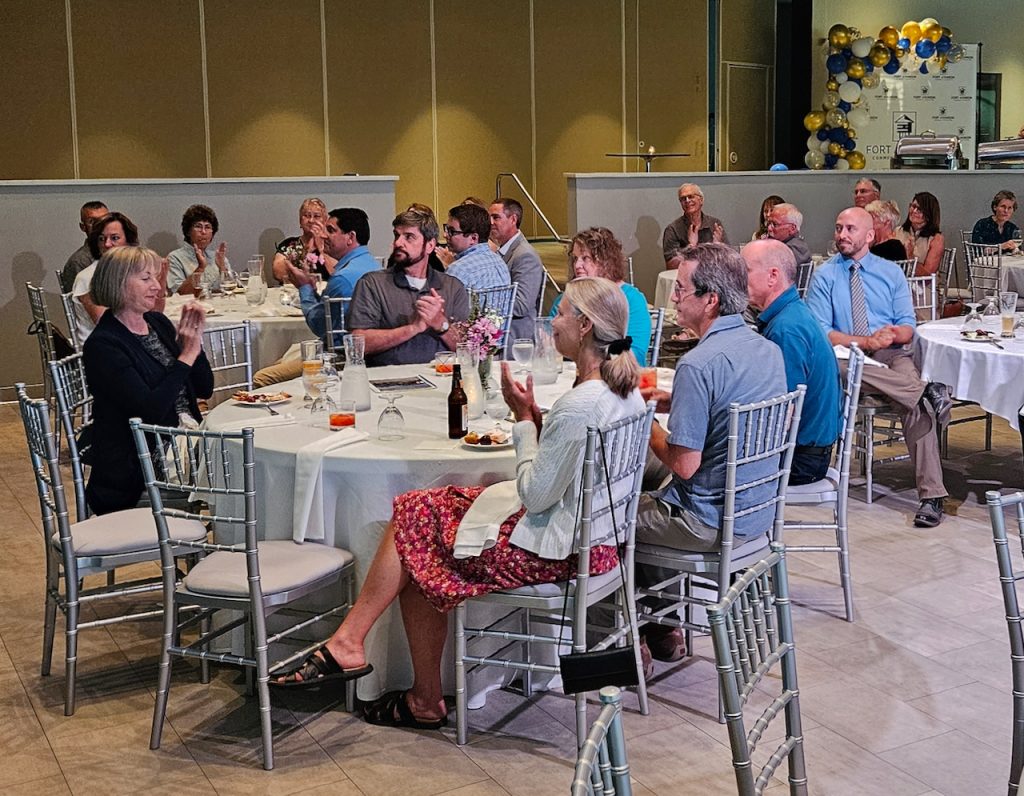
Attendees at the Fort Atkinson Community Foundation’s 50th anniversary gathering applaud remarks made by foundation board President Sue Johnson, not pictured.

School District of Fort Atkinson District Administrator Rob Abbott, from left; school district Director of Technology D.J. Scullin; Adam Nichols; Rock River Community Clinic Executive Director Olivia Nichols; Dr. Sara Podoll and Curt Polzin visit during the Fort Atkinson Community Foundation’s 50th anniversary event.

Guests visit the hors d’oeuvres table at the community foundation’s 50th anniversary gathering.

Following his address, guest speaker Ed Karrels, at left, engages with event-goer. Karrels was Google’s 59th employee, retiring at age 30 when the search engine went public. He since has contributed to numerous nonprofits and charities, including the community foundation.

Megan Hartwick, a social media and communications business owner and part-time interim director for the Bethel House in Whitewater, from left, Dashal Schopen, and Kaylee Kidd, the community foundation’s marketing and communications assistant, enjoy the evening.
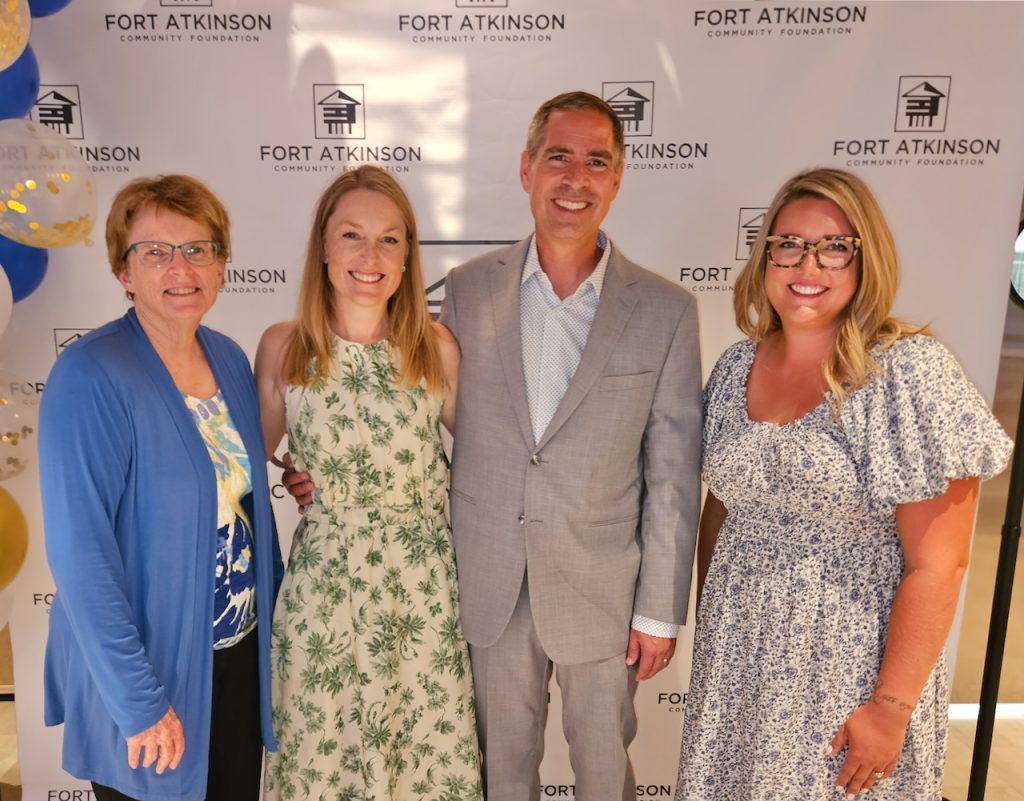
Fort Atkinson Community Foundation Executive Director Sue Hartwick, from left, special guests Nancy and Ed Karrels and foundation marketing and communications assistant Kaylee Kidd gather during the foundation’s 50th anniversary event.
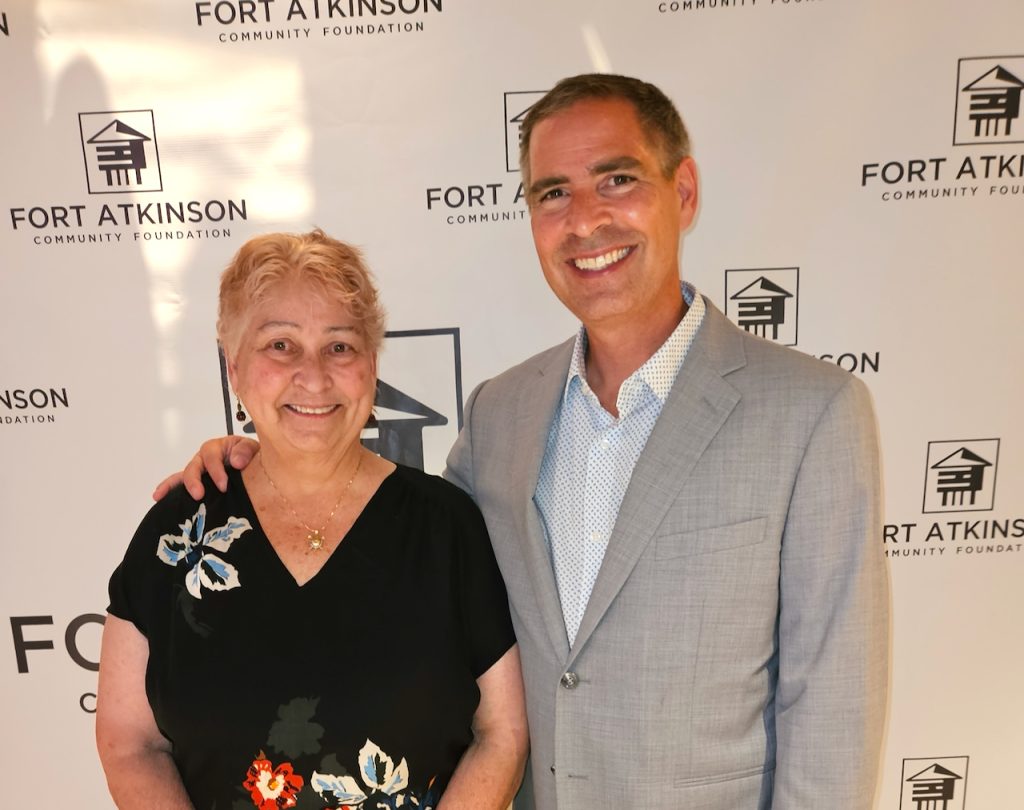
Fort Atkinson Community Foundation 50th anniversary celebration keynote speaker Ed Karrels shares a moment with his mother, Connie Thomas, Fort Atkinson.
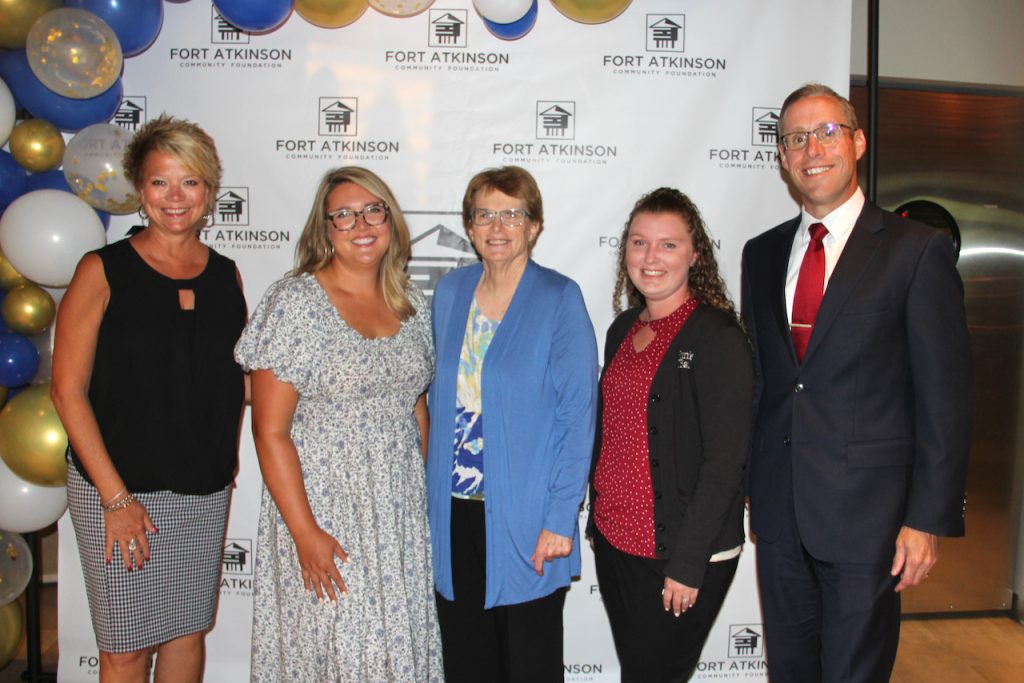
PremierBank representative Rochelle Mitchell, from left, Fort Atkinson Community Foundation Marketing and Communications Assistant Kaylee Kidd, foundation Executive Director Sue Hartwick, and PremierBank representatives Tiffany Reysack and Chris Martin gather during the foundation’s 50th anniversary celebration.

Speaking from the podium during the Fort Atkinson Community Foundation’s 50th anniversary celebration, Executive Director Sue Hartwick, flanked by Fort Atkinson Community Foundation Board of Directors President Sue Johnson, addresses event-goers.
Chris Spangler photos.
Jefferson, Walworth counties hit by storms; downed trees cause extensive power outages
(Originally published July 30, 2023.)
By Kim McDarison
Storms moving through Jefferson and Walworth counties Friday night caused damage to several trees throughout the region, bringing damage to the We Energies power grid, both the National Weather Service and We Energies have been reporting since late Friday night.
For approximately 70,000 customers within the extended Milwaukee region, including Jefferson and Walworth counties, trouble began around 10:30 p.m. on Friday.
On Saturday, the Nation Weather Service, operating from Milwaukee/Sullivan, reported that damage received to the area was not created by tornados, but instead was the result of widespread wind between 60 and 70 miles per hour, with some areas seeing wind speeds up to 80 miles per hour.
“One thing that was unique about last night is how long the winds lasted,” the service reported on its Facebook page, noting that in some cases the extreme winds were sustained for 10 minutes or longer.
“This likely accounts for the amount of widespread tree damage — especially in places like Fort Atkinson.” the service noted on Facebook.
“Trees are often able to handle short bursts of 60 or 70 mile-per-hour winds, but long duration winds like last night put enormous force on the trees, and over such a long period of time many will fall or otherwise be damaged,” the report continued.
The service reported that it was unaware of any injuries resulting from the storm.
Reports on Facebook from within the community also reported strong winds, damage to trees and power outages.
On his Facebook page, Fort Atkinson Online freelance reporter Ryan Whisner noted that his power was off, and his phone was likewise losing its power.
He reported that at his home, branches were down, but there was no damage to his house.
Numerous people took to the community’s Facebook group pages making similar reports.
We Energies, too, reported through its webpage, interactive outages map, and media outlets that by Saturday morning, the storm had caused outages for more than 58,000 Wisconsin customers, with more than 11,000 of them residing in Jefferson County.
By Saturday afternoon, the utility reported, power restorations were underway, with just over 37,000 customers in southeastern Wisconsin, with approximately 8,700 of those customers residing in Jefferson County, remaining without power. Walworth County was reported to have about 2,800 customers without power at that time.
As of Sunday, the company continues to report on its website that “Severe storms have caused widespread outages in southeastern Wisconsin. We are encountering extensive damage including downed trees and damaged power equipment. We expect 95% of customers who lost power will have their power restored by midnight tonight. The remaining customers will have their outage restored Monday. All available We Energies crews, including specialized forestry workers and extra contract crews, will continue to work around the clock to make repairs and restore power to customers affected by these severe storms. Customers can see their expected restoration time on the outage map. Customers can sign up for outage alerts to receive updates as crews restore specific outages.”
In Whitewater, on Saturday morning, power was out across the community’s downtown. Around 11:00 a.m., the traffic light at the intersection of Main and Janesville street was not operational, although the light was restored right around noon.
Also on Saturday, a We Energies crew was busy at work adjacent to the Irvin L. Young Memorial Library on Center street.
A foreman told Fort Atkinson Online that the crew had been dispatched to repair a power line that had been damaged by a tree. As the crew completed its work, the foreman said that the restored line would likely return power to at least 1,000 Whitewater customers.
Reporting on the city’s Facebook page, Whitewater city officials told residents that many municipal buildings were without power Saturday.
Whitewater Arts Alliance manager Ashe McDarison arrived at the Whitewater Cultural Arts Center, in the city’s downtown, around 11:30 a.m. to discover the building without power. She, like many establishments in Fort Atkinson and Whitewater, placed signage alerting patrons of the day’s temporary closure.
By Saturday afternoon, city officials reported on their Facebook page that the city’s municipal building’s power had been restored.
In Fort Atkinson, Fort Atkinson Online freelance reporter Chris Spangler noted that downed trees and branches littered Fort Atkinson after Friday’s severe thunderstorm.
Reports on a community Facebook page noted that residents heard the city’s warning sirens sound twice Friday night.
It appeared that no street was exempt from damage to trees, Spangler observed Saturday as she made her way through the city.
Additionally, she noted that the high winds wreaked havoc at Evergreen Cemetery on the city’s north side.
Numerous large trees, particular those toward the eastern end of the cemetery, sustained damage, closing off entrances. The tops of some appeared to have been sheared off by the straight-line winds, she reported.
Trees in several parks also were damaged, including several in Jones Park, a couple in Barrie Park and a few near the Wisconservation Club in Rock River Park. High winds blew over a pole holding a weather siren.
Trees along Riverside Drive/State Highway 106 sustained damage, as did those along Rankin and Van Buren streets. The 200 block of South High Street, Hillcrest Drive, Adams Street also were among those with branches and trees down. Felled trees brought down utility wires, including one in the alley between the 600 block of Monroe and Robert streets.
The power outage closed Festival Foods, which also was expected to be closed Sunday. On Saturday, employees were busy tossing dairy and refrigerated food, as well as some frozen items and produce, into dumpsters, Spangler reported.
The city’s compost site will be open Sunday, from 6 a.m. to dark, to accept brush from the storm.
Social media was helping keep residents informed about what was happening, with residents posting damage reports, power outages and sharing contact information for those looking for help with cleanup. Neighbors were helping neighbors pick up branches and good Samaritans were seen driving around town offering their help gratis.
Photos from both communities — Fort Atkinson and Whitewater — showing storm aftermath on Saturday, follow.
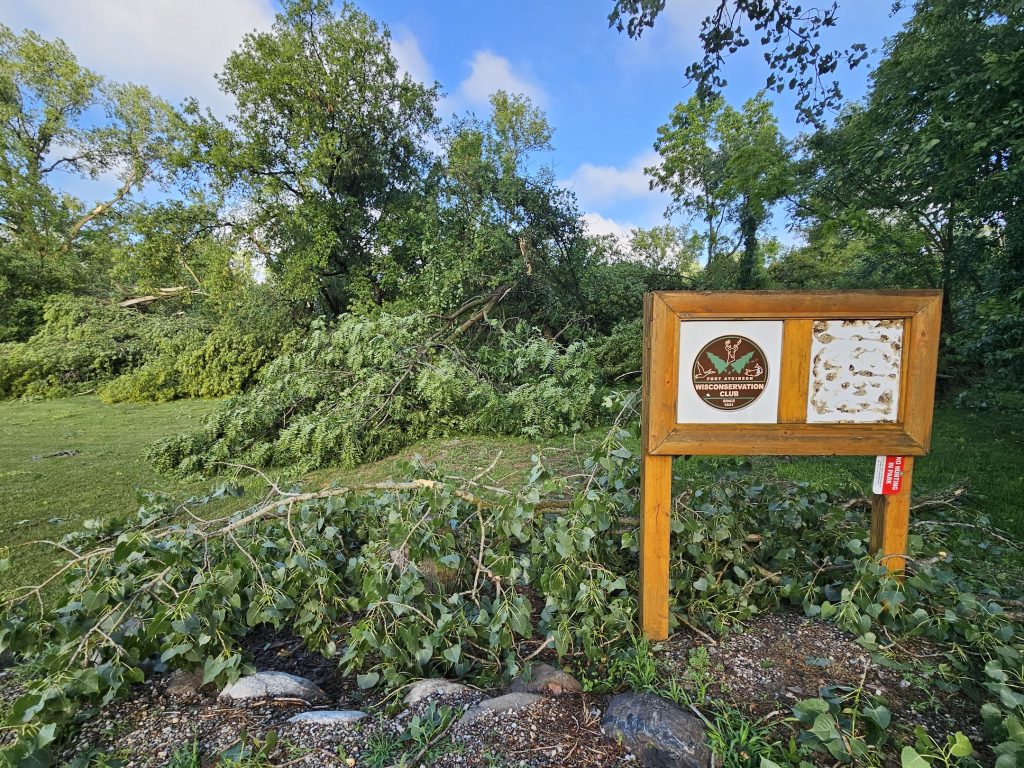
Trees are down near Wisconservation Club signage in Fort Atkinson’s Rock River Park. The damage resulted form Friday night’s severe thunderstorm.
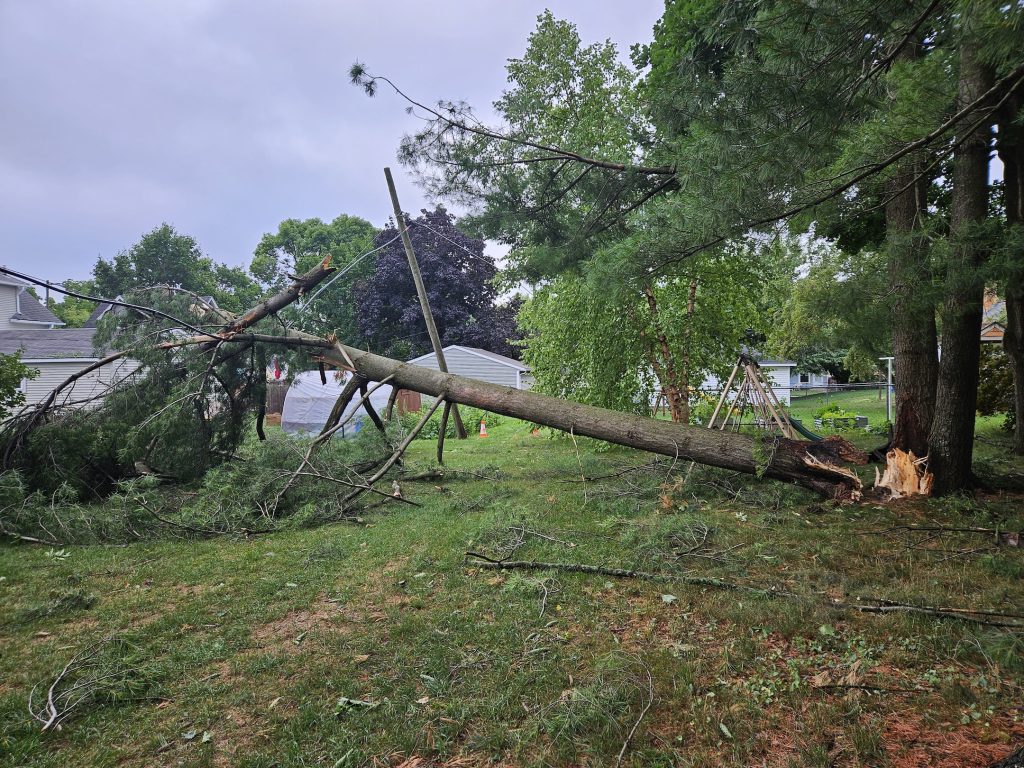
A large tree brings down a utility line in the alley between the 600 blocks of Monroe and Robert streets on the city’s north side.
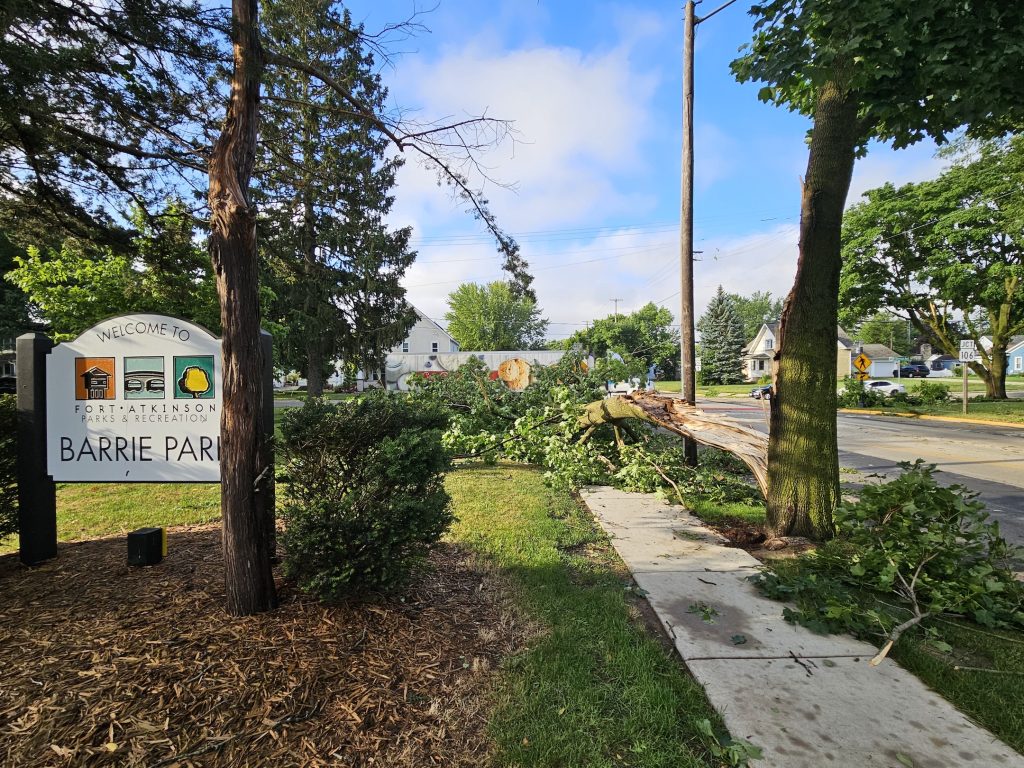
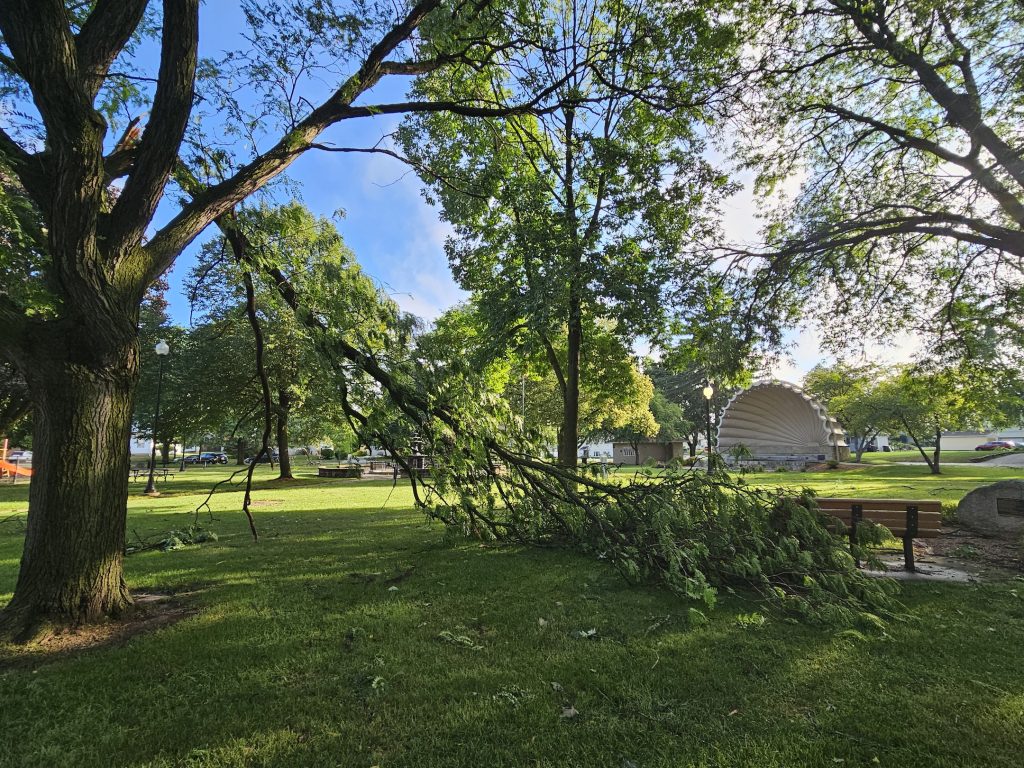
Two photos above: Produced by sustained high winds during Friday night’s storms, Fort Atkinson’s Barrie Park is littered with branches.
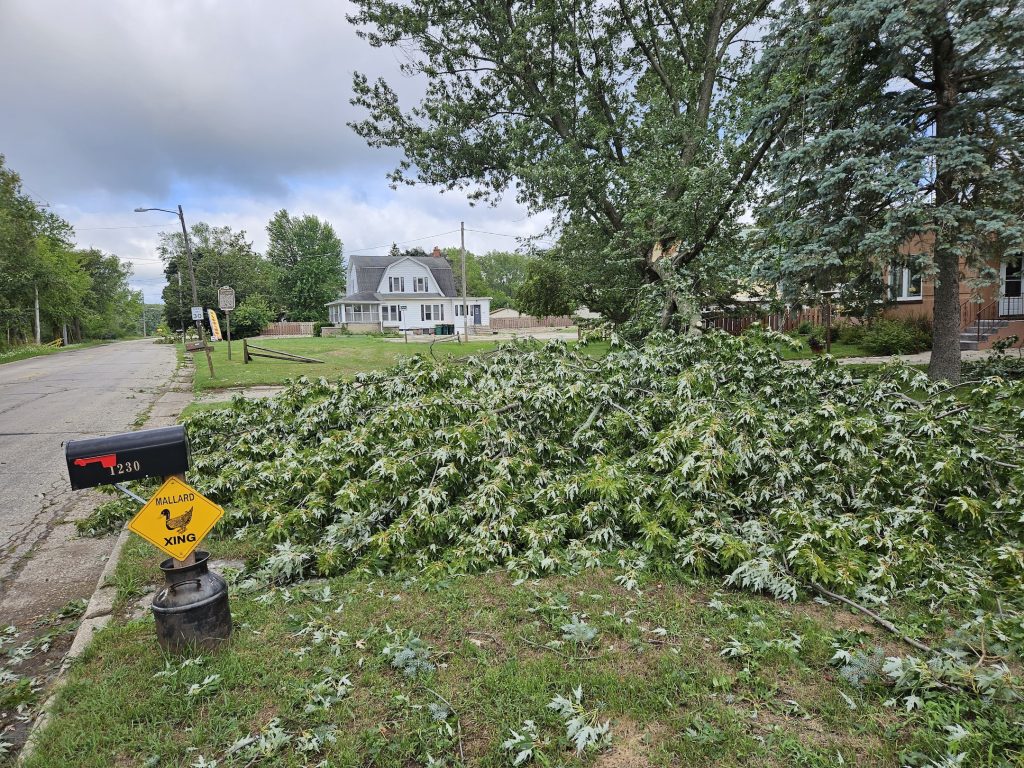
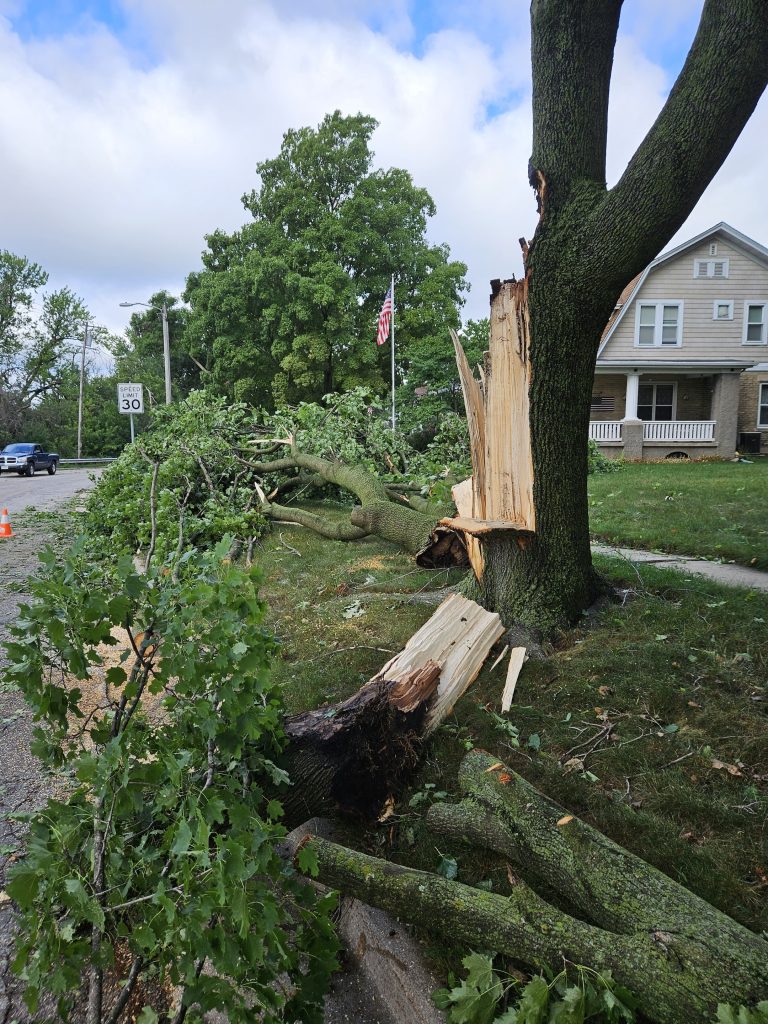
Two photos above: Tree damage is sustained on Riverside Drive/State Highway 106 in the aftermath of Friday’s storms.
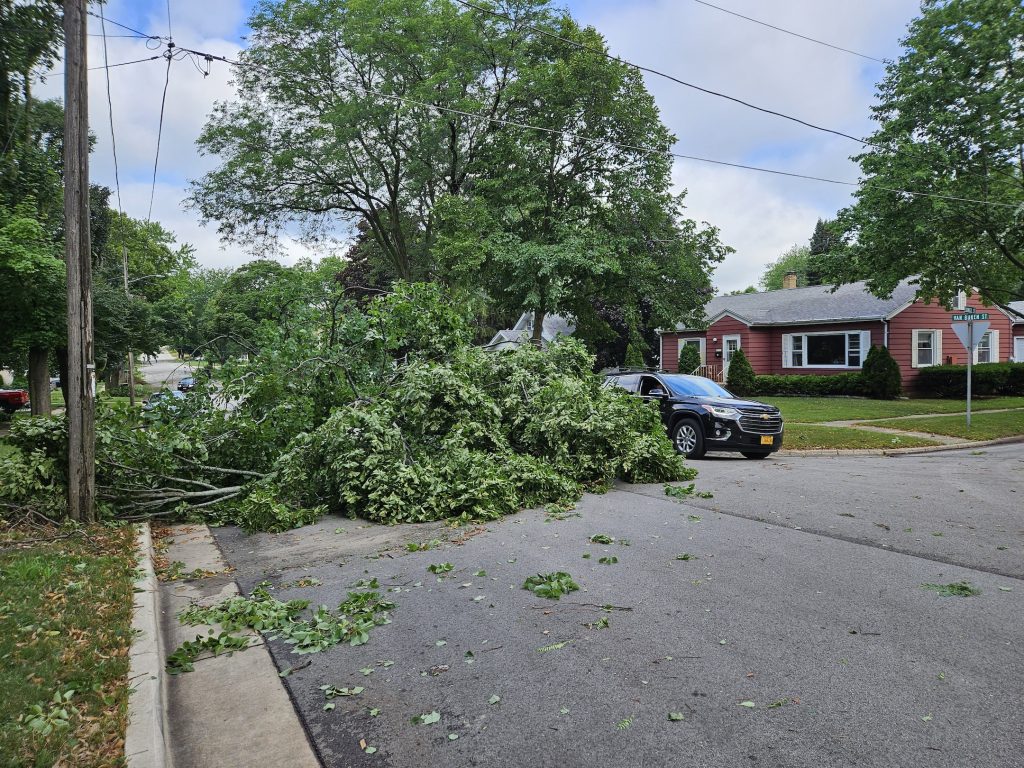
A portion of Van Buren Street at its intersection with Council Street is blocked after storms roll through Fort Atkinson Friday night.


Two photos above: The 200 block of South High Street near downtown Fort Atkinson shows damage from Friday’s storm. At 214 S. High St., a tree fell onto the enclosed front porch, damaging its roof. Saturday morning, a crew had been dispatched to remove the tree from across the driveway and off the roof. At 207 S. High St., a tree on the terrace split and fell along the front yard.

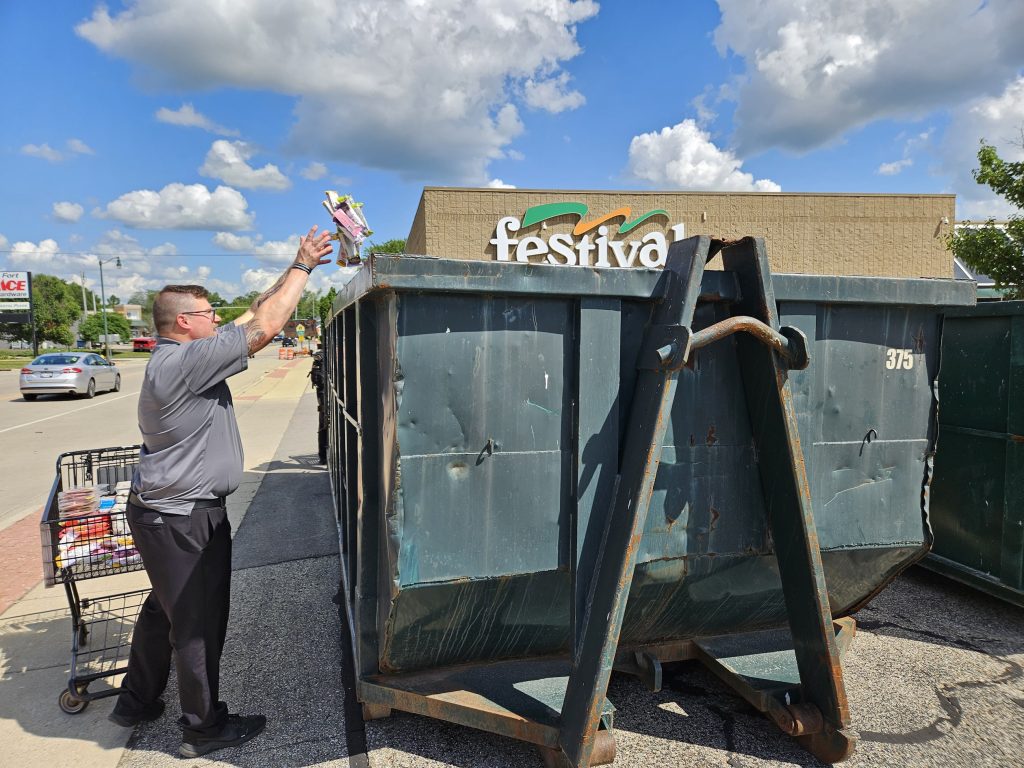
Two photos above: Festival Food employees discard some of the store’s inventory that require refrigeration and and freezer storage. The long power outage caused by Friday night’s severe thunderstorm and high winds closed Festival Foods on Saturday. An employee told FortAtkinsonOnline that all of the refrigerated and dairy products were being thrown away, as well as some frozen foods and produce.

A large branch takes down a utility wire on Adams Street on the city’s north side.
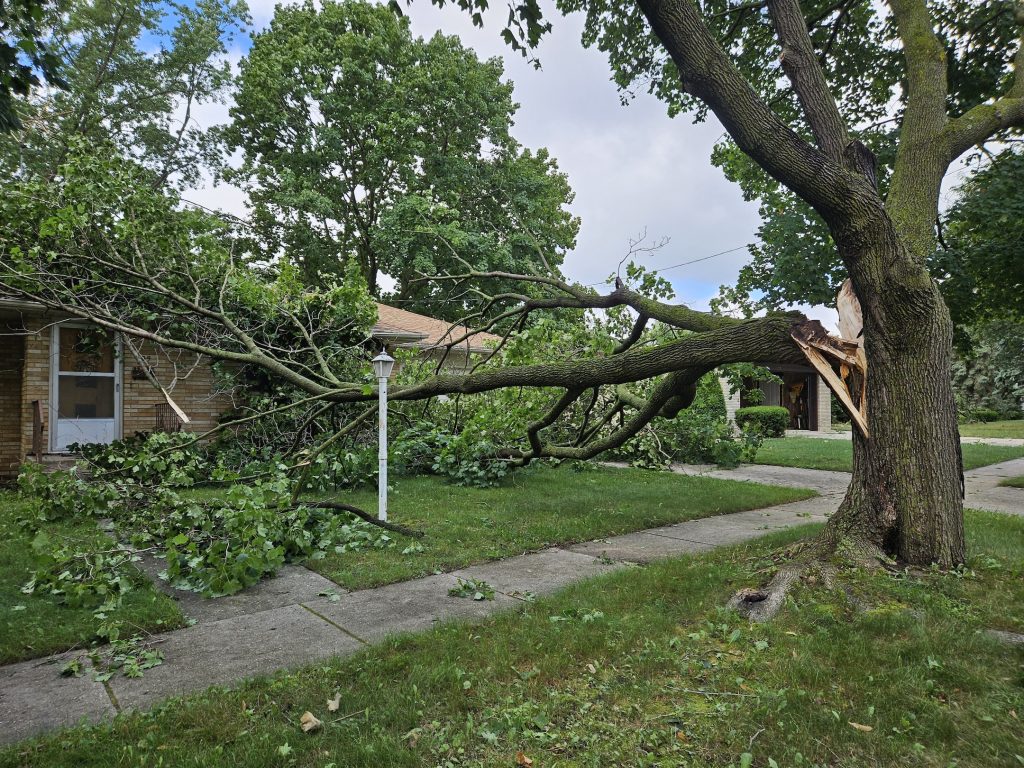
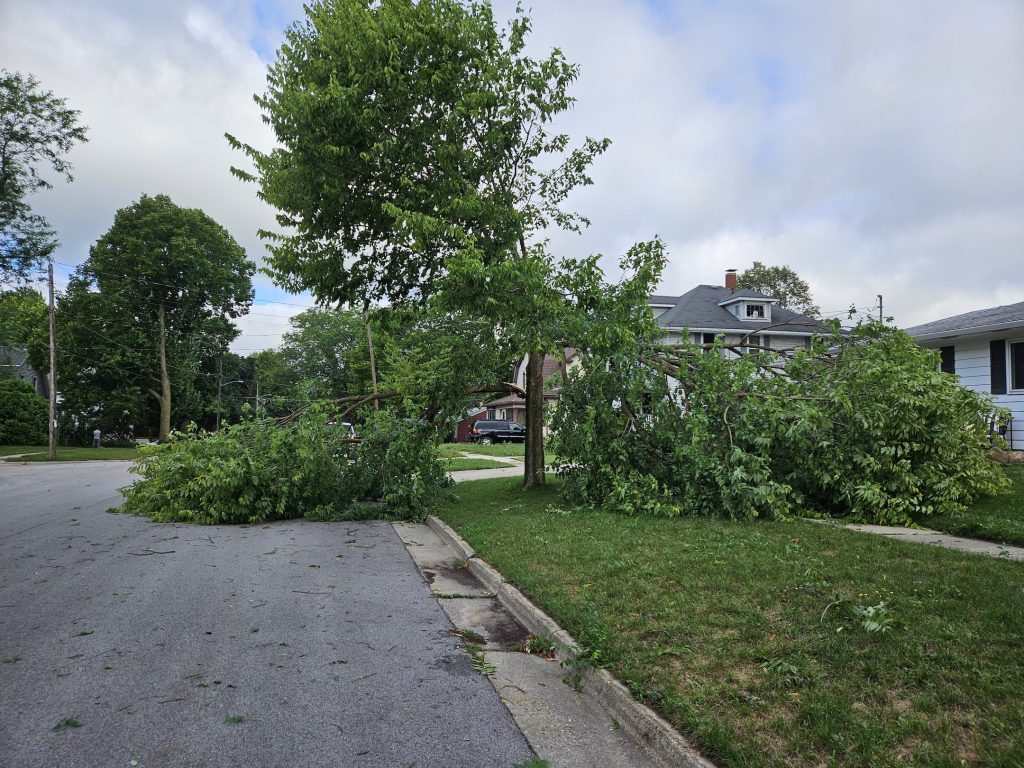
Two photos above: Tree branches are down in the 700 block of Rankin Street. The damage resulted from Friday night’s storms.
All photos above by Chris Spangler.
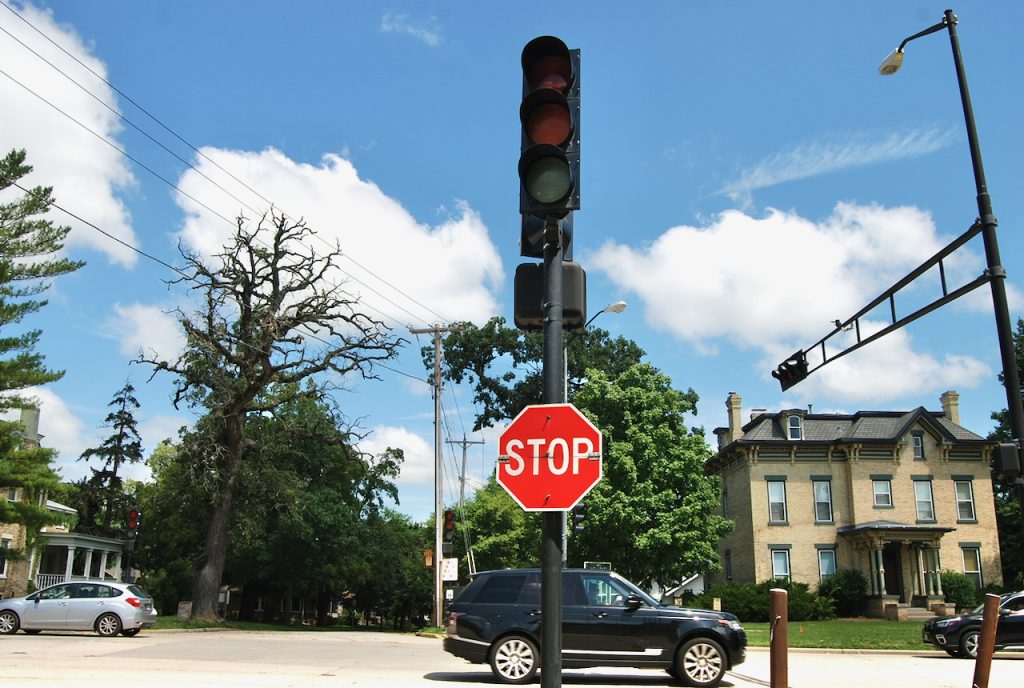
A traffic light at the intersection of Main and Janesville streets in downtown Whitewater is dark. Motorists were provided with stop signs to help direct traffic. The light was restored to working order right around noon on Saturday.
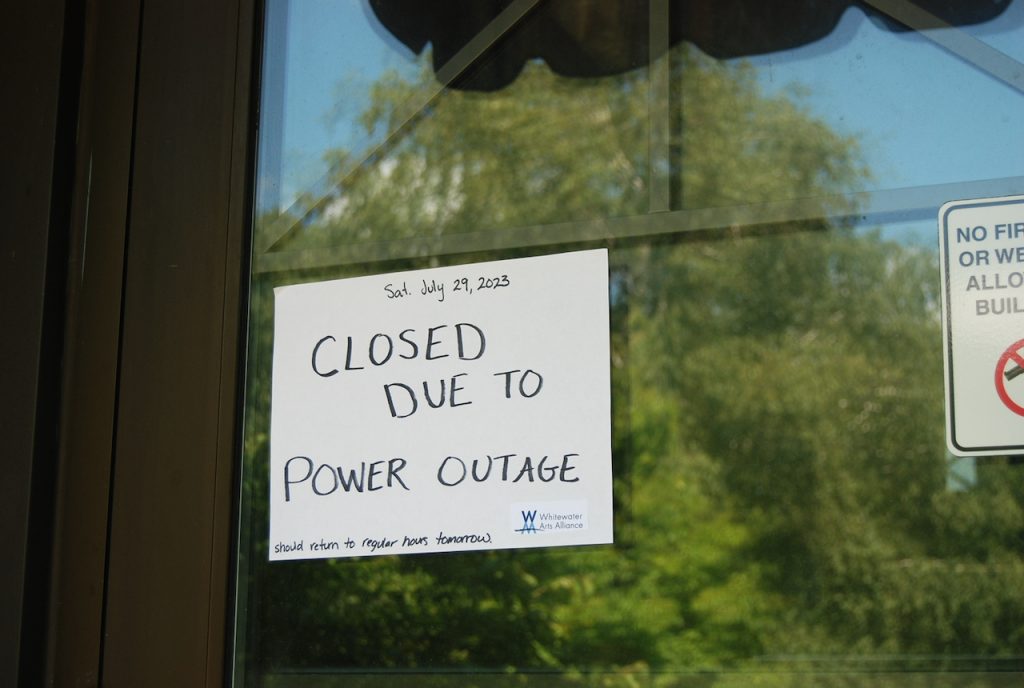
Signage placed at the Whitewater Cultural Arts Center in downtown Whitewater alerts would-be guests that the building is closed due to the ongoing power outage. The sign was placed Saturday morning. Power has since been restored to the building.
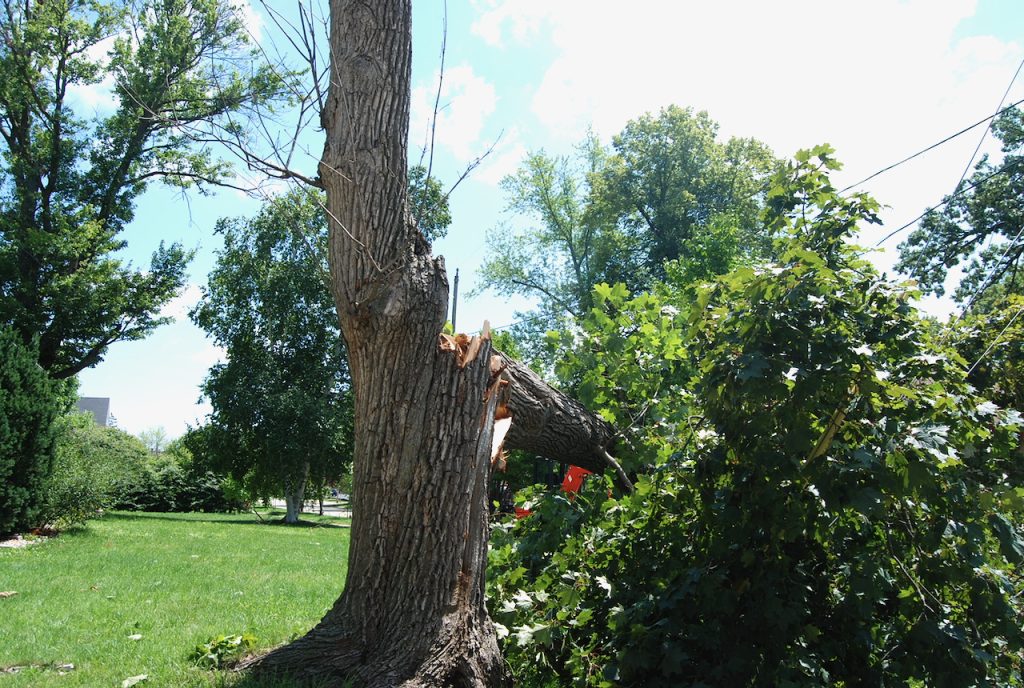
A large tree snaps at its trunk. The damage resulted from sustained gusts of wind, some of which reached speeds of 80 miles per hour and lasted for 10 minutes, according to information provided by the National Weather Service.
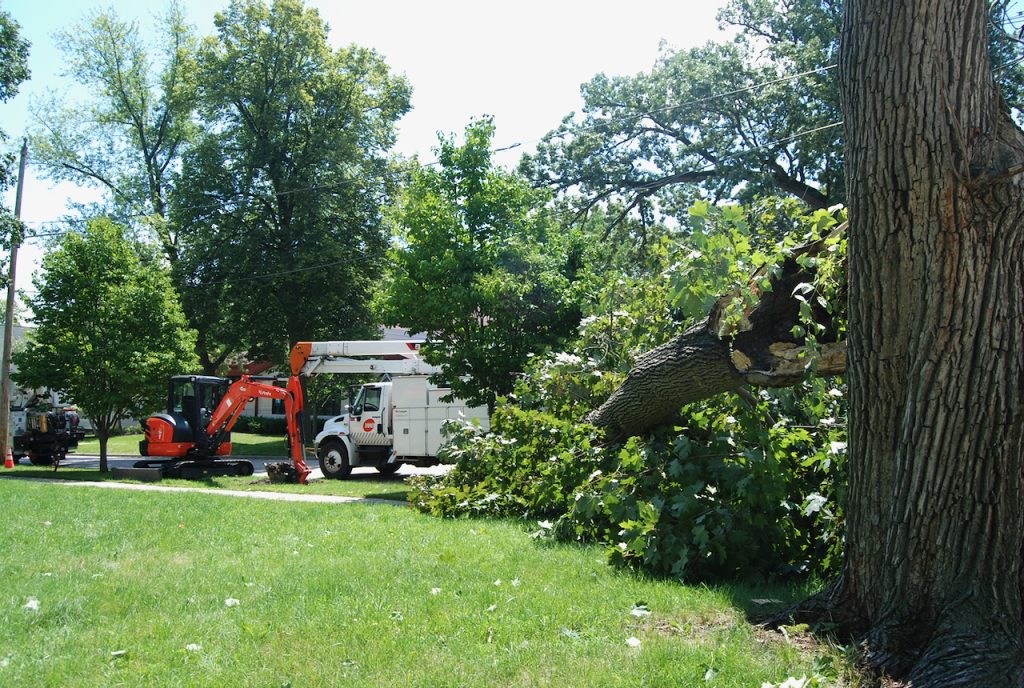
Various equipment is on hand near a fallen tree on Whitewater’s Center Street.

A Waukesha-based We Energies crew working in Whitewater completes its repair of a pole which had been damaged by a fallen tree resulting from Friday’s storms. A crew foreman said Saturday morning that the repaired pole likely would restore power to about 1,000 customers. The pole is located near the Irvin L. Young Memorial Library in Whitewater.
Kim McDarison photos.
Fort Historical Society purchases building adjacent to Hoard Museum
(Originally published Sept. 6, 2023.)
The Fort Atkinson Historical Society has announced that it has purchased a property adjacent to the Hoard Historical Museum and National Dairy Shrine Museum, 401 Whitewater Ave.
The Fort Atkinson Historical Society Board of Directors voted to use historical society funds to purchase the property and is exploring options for using the land, according to information released by the society.
According to Merrilee Lee, museum director, the former owners of the house at 423 Whitewater Ave. approached the museum to say they were going to put the property on the market.
“It was out of the blue. The phone rang one day and the family asked if we were interested in buying the property,” Lee was quoted as saying within the release.
Lee noted that the former owners had enjoyed attending events in the museum’s yard, especially the annual July Fourth Ice Cream Social, and were aware that the museum uses its outdoor space for activities.
The property, which is south of the museum, was the only lot adjacent to the museum. On the other three sides, the museum’s property lines are bounded by streets. Whitewater Avenue is to the east of the museum, South Fourth Street is to the north, and Foster Street is to the west, the release noted.
“The board thought it was too good of an opportunity to pass up. The property might not come on the market again and we can’t expand in any other direction,” Lee stated.
The Fort Atkinson Historical Society board has not yet decided how to use the new property, she said.
Within the release, Lee said the use of the property will align with the museum’s mission to “preserve, protect, and promote the history and culture of Fort Atkinson and the surrounding area from its earliest inhabitants to the present day.”
The property is .228 of an acre. The property lines of both buildings, the house and the museum, run the width of the block from Whitewater Avenue to Foster Street, the release stated.
Not counting its latest purchase, Lee noted within the release that the museum has two houses. The Frank and Luella Hoard House was the first museum building on the property and has been expanded several times. The 1841 Dwight and Almira Foster House is a stand-alone building and is used to represent the time period.
“Houses aren’t built to be museums. The Hoard House has been modified to be part of our museum and it still isn’t ideal. We’ve had to expand through additions onto the Hoard House to create the current space,” Lee continued.
Lee said it would be challenging and costly to renovate the newly purchased house to make it compliant with the Americans with Disabilities Act and use it for exhibit space, so it likely will be razed. Consequently, much of the brainstorming so far has focused on expanding event space, adding outdoor classroom space, expanding gardens and adding parking spaces.
According to the release, community members can suggest uses for the new property via a survey that will be available Sept. 15 on the museum’s website: www.hoardmuseum.org.
Additionally, the release noted, Fort Atkinson Historical Society members received a letter in August announcing the purchase.
Within the release, Lee said the purchase was made possible because of the longterm generosity of Fort Atkinson Historical Society members and other community stakeholders.
“The feedback has been very positive. Members and volunteers are very excited about the new opportunities this opens up for the museum,” Lee said.

A structure, at right, has become the property of the Fort Atkinson Historical Society. The Hoard Historical Museum, at left, which is operated by the society, is located at 401 Whitewater Ave. The recently purchased building is located at 423 Whitewater Ave. According to a recent news release, the property was offered for purchase to the society by its owners. The board purchased the building because it is the only lot adjacent to the museum which could be used for future expansion. While plans for the property have not yet been developed, there is a likelihood the building will be razed, Hoard Historical Museum Director Merrilee Lee noted within the release.
Contributed photo.
Fort awards Whitewater-based Sweet Spot $82,000 capital catalyst loan; company to expand in Fort
(Originally published Sept. 8, 2023.)
The city of Fort Atkinson has announced that it has awarded a capital catalyst revolving load to the Sweet Spot Coffee Shop, LLC.
The company plans to use the funds to purchase a property located at 225 and 227 S. Main St., according to the release.
The $82,000 load was awarded Thursday through the capital catalyst program by the city’s Economic Development Commission, the release noted.
As noted in the release, The Sweet Spot owners Jacob Gildemeister and Elena Schleusner purchased The Sweet Spot Café, 226 Whitewater St., and Bakehouse, 1185 W. Main St., both in Whitewater, in August of 2020. The operation includes a food truck.
As described in the release, the Bakehouse is a coffee shop, featuring a variety of pastries, a small breakfast menu and drive-through. The Bakehouse also offers custom bakery goods, including wedding and birthday cakes, croissants, and muffins, among other items. The Sweet Spot is a coffee shop featuring pastries, a breakfast and lunch menu and large seating area.
Gildemester and Schleusner also own Whitewater Cinemas.
The recently awarded loan will be applied to the couple’s plans to expand in Fort Atkinson.
As stated in the release, the owners plan to replicate the success of their Whitewater locations in Fort Atkinson and add a driver to their staff to transport fresh bakery items between the Bakehouse in Whitewater and Fort Atkinson.
The new location in Fort Atkinson may also feature a casual cocktail lounge. The business hopes to add 19 new jobs with the company over the next three years, the release stated.
While the official name of the business has not been announced, the owners plan to pay homage to original construction of the Fort Atkinson building, which served as the Langhoff Hotel in 1875.
About the Capital Catalyst Revolving Loan Fund
According to the release, the goal of the Capital Catalyst Revolving Loan Fund program is to encourage the startup of new businesses and the expansion of existing businesses in Fort Atkinson. Focus is placed on assisting companies in industry sectors including, but not limited to, advanced manufacturing, agriculture or food processing, information systems or software, medical devices, biosciences and energy. Those interested in learning more about the fund are encouraged to review the application and loan guidelines on the city’s website at www.fortatkinsonwi.gov. Those interested in applying for the Capital Catalyst Revolving Loan Fund are asked to contact Deb Reinbold, executive director of the Jefferson County Economic Development Consortium, by email: DReinbold@jeffersoncountywi.gov or phone: 920-674-8710.

Jacob Gildemeister and Elena Schleusner, owners of The Sweet Spot, a Whitewater-based company with plans to expand in Fort Atkinson, hold a ceremonial check representing a recent $82,000 capital catalyst loan awarded by the city of Fort Atkinson.

Sweet Spot owners Jacob Gildemeister and Elena Schleusner, each of whom are holding a ceremonial check, gather with members of the Fort Atkinson Economic Development Commission, city staff and other county-related officials after receiving a loan through the Capital Catalyst Revolving Loan Fund.
Contributed photos.
Coming to life: Cow replicas are receiving paint, second downtown mural to follow
(Originally published Sept. 20, 2023.)
By Kim McDarison
Accompanied by his energetic 15-month-old companion, “Kit,” an Australian Cattle Dog, area artist Larry Schultz arrived Wednesday morning at Rocky Lane Farm on Fort Atkinson’s south side.
The farm, which is owned by Fort Atkinson Beautification Council Vice President Alan Cook, and his wife, Gail, is serving as temporary home to seven nearly life-sized fiberglass cow replicas as they, each in turn, await a carefully placed covering of paint.
Each is sponsored by an area business and will be placed at one of several downtown Fort Atkinson locations. Each also is being painted to replicate one of seven dairy cow breeds, with each further made in the likeness of a specific cow. Depictions, which were selected and supplied to Schultz as references, each have significant meaning to the area and their sponsors.
The full project is dubbed “the parade of cows.”
Schultz may best be known locally for his work on a downtown Fort Atkinson mural, which was placed in 2019 on a city-owned water utility building and depicts historical scenes from Fort Atkinson.
Upon completing the parade of cows project, Schultz will begin a second mural, which is slated for placement on the city’s downtown water reservoir building. Both projects — the parade of cows and the city’s second downtown mural — are anticipated to complete by mid-October, Fort Atkinson Beautification Council President Jude Hartwick said on Wednesday.
Schultz said that each cow replica takes between 12 and 15 hours to paint.
As of Wednesday morning, he had nearly completed one replica, a Jersey cow, he said, with only a finishing coat of varnish left undone.
The Jersey stood beside five other replicas all of which remained unpainted, with each completely white fiberglass form awaiting transformation into a lifelike rendition of a dairy breed.
Reference photographs for five of the seven cows have been supplied to Schultz, Cook said. The beautification council is seeking models for two breeds, the Milking Shorthorn and the Ayrshire,” he said.
Pulled from the fiberglass herd Wednesday was a form which was in the midst of its transformation. The replica would soon resemble a Brown Swiss cow, Schultz said.
The parade
Cook said cows, along with their sponsors and placement within the city of Fort Atkinson, are as follows:
• Jersey: Described by Schultz as a “dark Jersey,” the replica, which was nearly completed on Wednesday, will soon be placed near the Fort Atkinson Area Chamber of Commerce building, 244 N. Main St. The location is near the replica’s sponsor: Pete’s Tire and Auto Shop, 2 Madison Ave.
• Brown Swiss: the replica which was undergoing transformation on Wednesday is that of a Brown Swiss cow which will soon be placed near Frostie Freeze, 208 Madison Ave. The replica is sponsored by Whitewater-based Sunshine Genetics.
• Black and White Holstein: A replica of a Holstein cow will be placed near Subway in Fort Atkinson, 1550 Madison Ave. The fiberglass replica is sponsored by Crescent Beauty Farm, which is owned by the Hetts Family.
• Guernsey: Brian Knox and W.D. Hoard and Sons Company are the sponsors of a Guernsey cow replica which will be placed near the company’s downtown printing office, 28 Milwaukee Ave.
• Red and White Holstein: Deb Lundy, who, along with her family, operates a dairy farm in Jefferson, is the sponsor of a Red and White Holstein replica which will be placed near Jones Market, Fort Atkinson, 601 Jones Ave.
• Ayrshire: The Fort Community Credit Union or FCCU will be sponsoring a replica which will be painted to resemble an Ayrshire cow. The replica will be placed near the credit union’s office at 800 Madison Ave.
• Milking Shorthorn: The Tourism Office of the Fort Atkinson Area Chamber of Commerce will be sponsoring a replica of a Milking Shorthorn cow, which will be placed near NASCO.
Hartwick said the full project, which was initially estimated at $35,000, has cost about $45,000.
Thanks to private donations and a grant made available to the beautification council by the Fort Atkinson Community Foundation, the project’s costs are covered, he said.
Sponsorships continue to be offered to allow businesses and residents who might like to participate an opportunity to be included on recognition plaques and websites as supporters of the project, Hartwick said.
As additional funds are achieved, Cook said, the beautification council would not necessarily need to use all the funds made available to it by the foundation, at which point it would return those dollars to the foundation for use in other community projects.
According to Cook, much of the money used for the project so far has come through private donations.
Hartwick and Cook said at least 15 “smaller donations” have been made by area residents. The names of all donors will be added to a plaque at the Hoard Historical Museum and Dairy Shrine building and listed on the museum’s website. The Fort Atkinson Beautification Council’s website also will list names of donors, Hartwick said.
A retired dairy farmer since 2017, Cook said he had an idea for something like the parade of cows in the back of his mind.
The idea grew legs one day about three years ago after his daughter, Kylene Anderson, said she thought entering the city of Fort Atkinson from the west side was “boring.”
According to Cook, she suggested that the beautification council consider erecting a life-sized cow in honor of the Hetts family farm, which operated in the area.
Cook said that after he proposed the idea to the members of the beautification council, they decided instead to make a project that represented all the dairy breeds.
After Cook pitched the project, the group spent time deliberating on where the cows should be placed, and there was some talk of having them erected in one spot, with cows of different breeds represented in different poses, perhaps one standing, while another was lying down, Cook recalled.
“We couldn’t find one manufacturer who would make that,” he said, adding that after the group did some research, members learned that they would have to go to a plethora of manufacturers to find replicas formed into different poses. Also, he said, they learned that FAST Fiberglas, LLC, in Sparta, the manufacturer of the replicas which the group is using, was the best in the business when it came to cow replicas, Cook said.
The replicas that Schultz was painting on Wednesday arrived on Cook’s farm nearly two weeks ago, Cook noted.
As he painted, Schultz talked about the differing aspects and challenges associated with painting large murals and replica cows.
Both types of projects provide “a workout,” involving standing and kneeling to reach different areas that need painting, he said.
With the cow project, a challenge is to give each replica dimension and not just paint “flat spots” on the forms, Schultz said.
“It’s still like painting on a canvas,” he said, adding that the challenge is to create “realism,” through “roundness and shape.”
He did not want markings on the replicas to look simply like “patches of color,” he said.
While painting each form, Schultz said, he has been provided with pictures of the actual cows that each is replicating.
Sharing reference photos of each cow, Cook said the Brown Swiss replica is painted in the likeness of “Top Acres Present ET.” A photograph of the animal was provided by Sunshine Genetics.
The Jersey cow is painted in the likeness of “Kunia Moon.” The cow’s picture was provided by Brandenburg Dairy Farm, Cook noted.
The Hoard’s Dairyman Farm provided the likeness of a Guernsey named “Rolling Prairie Bella Blue,” and the black and white Holstein replica will be painted in the likeness of “Gene Acres Felicia May Fury.” The animal’s likeness was provided by Crescent Beauty Farm, Cook added.
A red and White Holstein named “Silver-Rock TT Barbara,” serves as the model for the replica of her breed. The likeness was provided by Lundy Farms, he continued.
Mural project
Additionally, Hartwick said, the painting of a second mural will begin after Schultz completes the parade of cows project. The project is anticipated to complete in October, he said.
Fundraising continues to support efforts to create the city’s second downtown mural painted by Schultz. The first, found on the city’s Water Department Service Center Building, 37 N. Water St., W., was completed in 2019. The second, which will be placed on the city’s downtown water reservoir building, 31 N. Water St., will be painted this fall.
The full cost of the second mural is $20,000, Hartwick said.
Thus far, he said, the Fort Atkinson Community Foundation has given the beautification council a grant of $10,000.
Hartwick said the group had about $3,000 on hand when it began its fundraising efforts in support of the project.
Another $7,000 is required to support the full project.
Donors to the mural project will receive recognition by having their names placed on a plaque at the Hoard Historical Museum.
Hartwick said the beautification council is very supportive of the Hoard Historical Museum and works to “tie its projects” to the museum and the community’s history.
When completed, both of the mural projects and the parade of cows project will have signage placed which will offer some information about the projects and QR codes that will further tie the projects to the museums, Hartwick said.
Both the parade of cows and the second mural project are anticipated to be completed by mid-October, at which time, Cook said, tentative plans call for a dedication ceremony to be held at the cow replica placed near the W.D. Hoard and Sons building.
Wisconsin’s “Alice in Dairyland” is scheduled to attend, Cook noted.
In the planning process are several activities with Alice, including an early Saturday morning visit to the cow replica at the W.D Hoard and Sons building, followed by a visit to the Fort Farmers Market, and the Hoard’s Dairyman Farm.
To learn more about the Fort Atkinson Beautification Council’s parade of cows and mural projects, visit its website: https://www.fortbeauty.org.
An earlier story about the beautification council’s parade of cows project is here: https://fortatkinsononline.com/beautification-council-planning-cow-parade/.
An earlier story about the second mural proposed by the beautification council and its fundraising efforts is here: https://fortatkinsononline.com/beautification-council-fundraising-underway-for-second-fort-downtown-mural/.
Kim McDarison photos unless otherwise indicated.

Area artist Larry Schultz paints a fiberglass replica made to look like “Top Acres Present ET,” a Brown Swiss dairy cow whose likeness was shared by Whitewater-based Sunshine Genetics. The company is the sponsor of the nearly life-sized replica which will soon be placed near Frostie Freeze, 208 Madison Ave., Fort Atkinson. Fiberglass replicas, pictured behind the artist, which are part of the Fort Atkinson Beautification Council’s “parade of cows” project await paint.

Fort Atkinson Beautification Council President Jude Hartwick, from left; his grandson, Davis Hartwick, 3; Gail Cook, followed by her husband, Fort Atkinson Beautification Council Vice President and chairman of the parade of cows project Alan Cook, and area artist Larry Schultz gather around a Brown Swiss cow replica. Seven such replicas are housed on Rocky Lane Farm, which is owned by the Cooks, as they await paint. Once completed, the cows will be placed strategically within the downtown area of Fort Atkinson.

Larry Schultz applies his skill as an artist as he creates a rendition of a Brown Swiss cow named “Top Acres Present ET.” Schultz said painting replicas gives him exercise as he kneels and stands to reach his work. He said he hopes to create roundness, shape and dimension as he applies paint, and not “flat spots.”

Whitewater-based Sunshine Genetics Embryo Transfer Service representatives and veterinarians Aaron Prososki, from left, and Greg Schueller present a check to Alan Cook, Fort Atkinson Beautification Council vice president and chairman of the group’s parade of cows project. The donation was recently made in sponsorship of the Brown Swiss cow replica, which is one of seven dairy cows represented as part of the parade of cows project. The full set of replicas will soon be placed strategically throughout the downtown area of Fort Atkinson. Contributed photo.
Olsen recognized for 50 years of musical ministry by First Congregational UCC
(Originally published Sept. 28, 2023.)
|
Speaking on behalf of the choirs was Robert “Charlie” Knapp, a choir member since 1989.
“My musical training is mostly through church choirs since I was in fifth grade, and I noticed immediately a level of dedication and professionalism on your part that I have taken with me since 1989,” he told Olsen.
“My biggest memory, of course, was when you prepared the youth bell choir for a tour in 1995 that brought all the parents close together, and it was amazing the level of musicianship you inspired in those youth. And you keep doing it every Sunday over and over again,” Knapp added.
He pointed out that a line in the morning’s hymn, “Joyful, Joyful, We Adore Thee,” summarizes the congregation’s feelings.
“The very last line of the very last verse: ‘Joyful music leads us sunward in the triumph song of life.’ And that is what you have given us, Marv. Thank you for 50 years,” Knapp said.
According to Ruth Hammiller, Olsen has been a joy to perform for since she joined the senior and handbell choirs in 1984.
“He is very positive and offers constructive criticism in a noncritical, loving way so it never feels like criticism in any way,” she said. “It is more about doing something a different way than ‘you’re doing something the wrong way.’”
Hammiller noted that Olsen never has complained, despite undergoing physical illness and surgeries.
“He always has had a smile on his face, even when everyone knew he was in pain,” she said. “He has kept things positive and is very upbeat and kind.”
Hammiller noted that Olsen started the bell choir performing at Christmastime at Fairhaven Senior Services in Whitewater, as well as at several other venues with other bell choirs.
Calling his dedication to the church “exceptional,” she said Olsen was active in the congregation’s purchases of a new organ and grand piano.
“He is always bringing new music in, and is faithful in his service to the church,” Hammiller concluded.
The service, including the plaque presentation, may be viewed at https://www.youtube.com/@fortatkinsonunitedchurchof7730/streams.
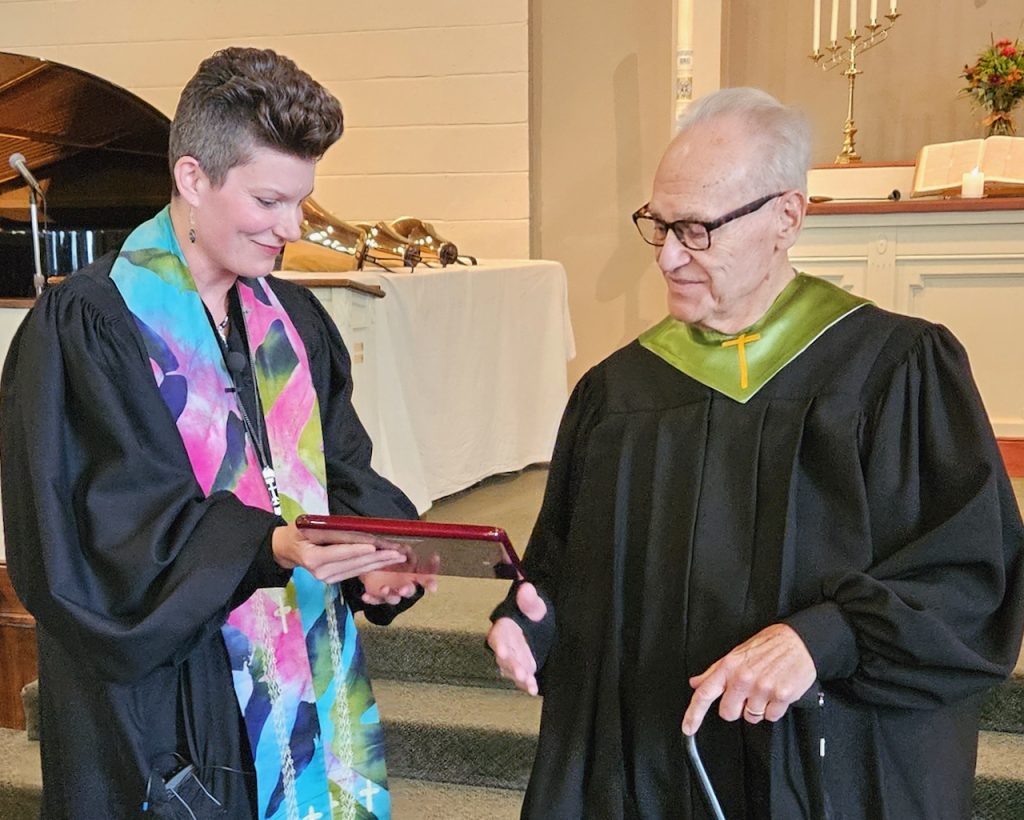
The Rev. Dr. Sara Rabe presents a plaque to Marvin Olsen commemorating his 50 years as director of music at First Congregational United Church of Christ, Fort Atkinson.
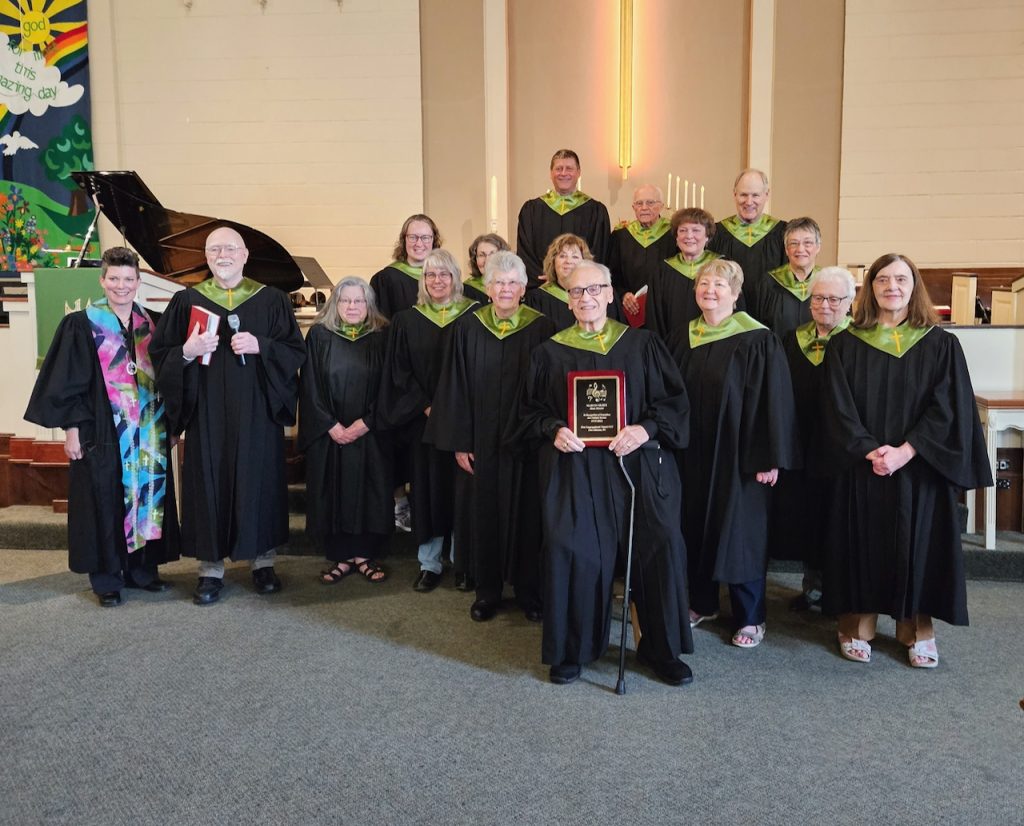
Marvin Olsen, seated and holding his plaque, gathers with members of the senior and handbell choirs and the Rev. Dr. Sara Rabe, at left, as First Congregational United Church of Christ celebrates Olsen’s half-century as director of music.

Speaking on behalf of the choirs, Robert “Charlie” Knapp, a member of the church choirs since 1989, at left, congratulates Marvin Olsen, seated, on his 50 years as the church’s director of music.

Marvin Olsen, Fort Atkinson, displays the plaque given to him in recognition of his 50 years as director of music at First Congregational United Church of Christ.

73-year-old social ‘Club 46’ keeps ‘date night’ tradition dancing; invites new members
(Originally published Oct. 3, 2023.)
By Kim McDarison
With dinner nearly finished, the lights within the Lake Ripley Country Club banquet room dimmed and “Marcy and the Highlights,” a Madison-based band, began to play.
That was the cue Saturday night for Club 46 members and their guests to move onto the dance floor.
With a kind of choreographic precision typically found in romance musicals, couples glided across the floor in concentric circles, with each pair independently adding to the intricacy of the motion by swirling and twirling on its own axis.
With 55 participants in attendance at the Cambridge-based golf course clubhouse, the dance space was filled anew with each tune performed by the four-piece band.
Couples — some of whom were instinctively synchronized as longterm partners while others appeared more recently paired — laughed, embraced and looked happily into one another’s eyes as they explored the dance floor and the enthusiasm of the evening.
Among attendees were Sondra and Scott Miskowiak. The Janesville couple was celebrating its third wedding anniversary.
People join the club to have fun, Janis Lindsey, a member of the social club and its organizing committee, said.
Saturday’s event was one of three traditionally held each year by the club, she said, adding that the club’s next dances will be held early next year, in February and May.
The club’s season runs from September of 2023 through May of 2024.
Lindsay said that while the club was begun in 1950 with 46 couples, today, the group has 40 active members, and is hoping to attract more.
According to a club history written by member Jim Wesner, the group was begun with 46 couples and, during its early years, capped its membership at that number, but, Lindsey said, that rule no longer applies. Anyone interested in fine dining, dancing and socializing, married or single, is welcome to join.
Wesner, Fort Atkinson, who has been a member of the group for four years, said he also is the group’s unofficial historian.
During dinner, Wesner took a moment to share some Fort Atkinson history. Pointing to a plaque mounted on the clubhouse wall, he said the late Wilson Beebe, of Fort Atkinson, who also was a founding member of Club 46, won the Fort Atkinson City Golf Tournament in 1937, and again in 1950 and 1951.
The club attracts members from a broad region, Lindsey said, noting that members come from such communities as Fort Atkinson, Jefferson, Whitewater, Madison, Middleton, Fitchburg, and Sun Prairie, among others.
Over the years, the dances have typically been held at the Lake Ripley and Koshkonong Mounds country clubs, she said, but Club 46 members have recently been considering branching out and exploring additional locations.
Club and organizing committee member Teresa Brawders, Jefferson, said the group has begun exploring locations in Fort Atkinson, Whitewater and Jefferson, and other surrounding communities.
Brawders said she joined the club some seven or eight years ago.
“It’s such a fun, social event. We talk, and laugh, and eat, and dance; it’s a fun evening out,” she said.
Lindsey said, she, too, joined for the purpose of socializing. A member for two years, she said, she joined after recently moving to the Fort Atkinson area.
“I moved from the Madison/Middleton area and I was doing ballroom dancing for a long time, and I was looking for an avenue to dance and meet more people,” she said.
On Saturday, following the event’s cocktail hour, a dance lesson was offered to those interested in learning ballroom dance steps or brushing up on their skills.
Offering the lesson during the dinner and dance event is new, Lindsey said. During Saturday’s lesson, couples practiced the waltz.
On the dance floor, Linda Kiesow, a club member for two years, helped seasoned dancers and beginners alike find their stride.
Following the cocktail hour, participants found their seats in the banquet room and enjoyed a three course meal, including salad, an entree and dessert.
As dinner arrived and club members took their seats, Wesner, serving as master of ceremonies, welcomed the group’s four new members who were in attendance Saturday, and the group’s guests.
Club 46 is a dues-driven club, Lindsey said, noting that the annual dues are used to pay for the bands hired each year to perform at the three dances.
According to information released by the club online, membership dues for the 2023-24 season are $100 per couple and $50 per individual, with those monies used to pay for bands, room fees and miscellaneous expenses.
Dinners for each dance range between $80 per couple and $50 per individual with tax and gratuity included. Dues do not cover the cost of the meals.
Dance fees for non-member guests are $40 per couple and $20 per individual.
Ken Heim, a bass guitar player and singer with Marcy and the Highlights, and also Marcy’s husband, said the band has played at Club 46 events before and is familiar with playing music that appeals to dance-related clubs.
Over the years, he said, the band, which was formed by Marcy Heim in the 1980s, has played at numerous ballroom dancing events across the area.
Ken Heim said about 12 dance clubs once operated in the extended Madison area, but after the COVID-19 pandemic, many did not resume their event schedules.
“There are only about three or four clubs left,” he said, adding that the band plays at many of their events.
According to the band’s website, Marcy, who received an honorable mention in the Nashville Music City Song Festival for her original song: “Maybe Together was Better,” and “got a strong dose of rhyme and blues as a singer with Clyde Stubblefield and the Motown Players,” noted that for her, a highlight was performing with the UW Varsity Band under the direction of Mike Leckrone in the Kohl Center.
Ken Heims said he and Marcy met in 1986, when he auditioned for the band, and they have been playing together ever since. The couple has been married for 33 years.
The band also includes Pat Green, who plays the drums. Ken Heim said Green has been with the band, on and off, for 25 years. A fourth member, Andy Yaun, plays the guitar and sings. Ken Heim recalled that Yaun began playing with the band before he could drive a car. He has been a member, on and off, for 10 years.
The band plays a variety of music, including classic rock and roll, country, swing, Latin, and, Heim said, “anything you can dance to.”
Looking ahead, the club has made plans to hold its next dinner and dance on Saturday, Feb. 10, 2024, at the Koshkonong Mounds Country Club, Fort Atkinson. Live music during the event will be performed by “Nine Thirty Standard.” To learn more about the band, visit its website: https://www.ninethirtystandard.com/.
On Saturday, May 18, 2024, the club will sponsor a dance at the Lake Ripley Country Club, Cambridge. Live music during the event will be performed by “All that Jazz Big Band.” To learn more about the band, visit: https://meowx.com/atj/.
For more information about Club 46, contact Lindsey by phone: 608-333-9619 or Brawders by phone: 920-650-1143.
Photos from Saturday’s dinner and dance follow.

Some 55 members of the Club 46 social group enjoy dinner followed by dancing Saturday at Lake Ripley Country Club, Cambridge. The group, which hosts three dinner and dancing social events annually, draws its membership from such communities as Fort Atkinson, Jefferson, Whitewater, Madison, and several Madison-area suburbs, among others.
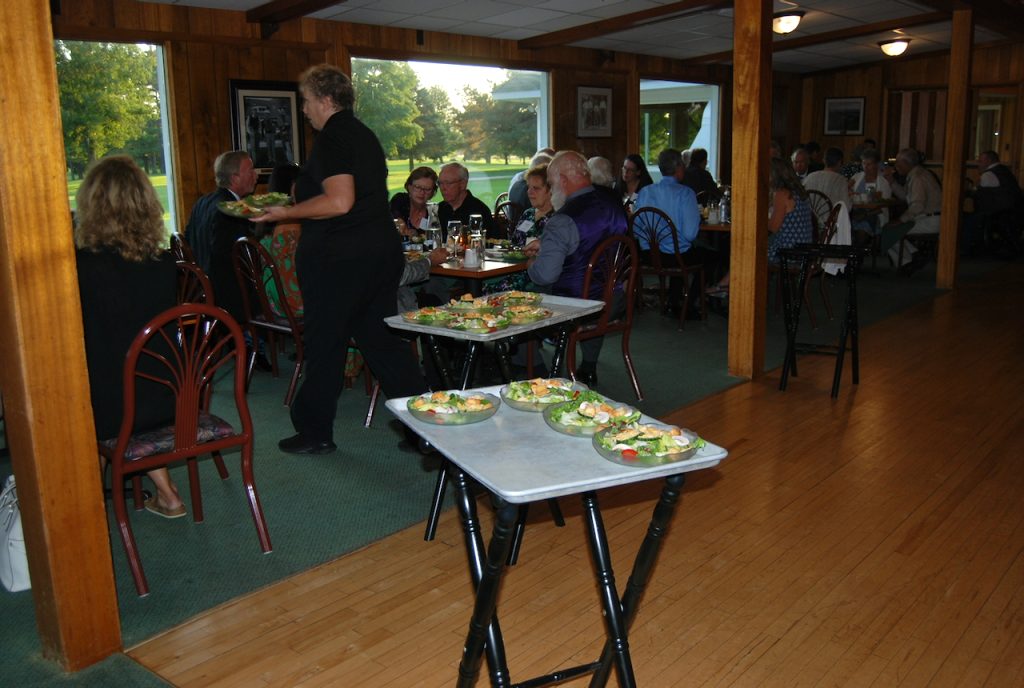
Members of the Club 46 social club prepare to enjoy the first course of a three-course meal.
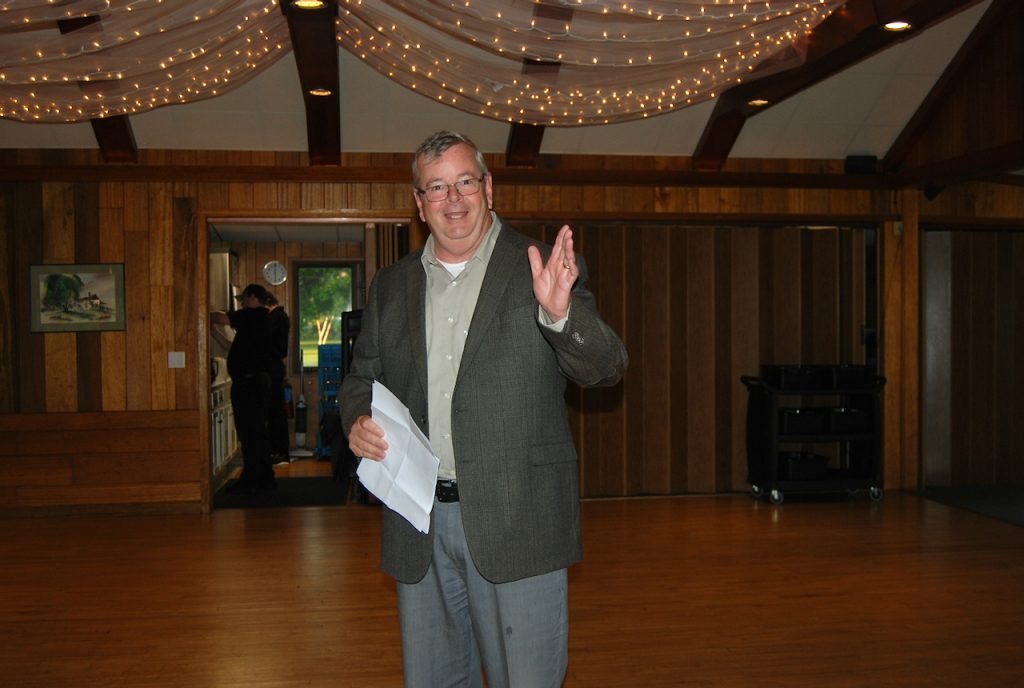
Serving as master of ceremonies, Jim Wesner, Fort Atkinson, welcomes club members and their guests to the first of three dinner and dancing social events held by the club during its 2023-24 season. The event was held at the Lake Ripley Country Club, Cambridge.
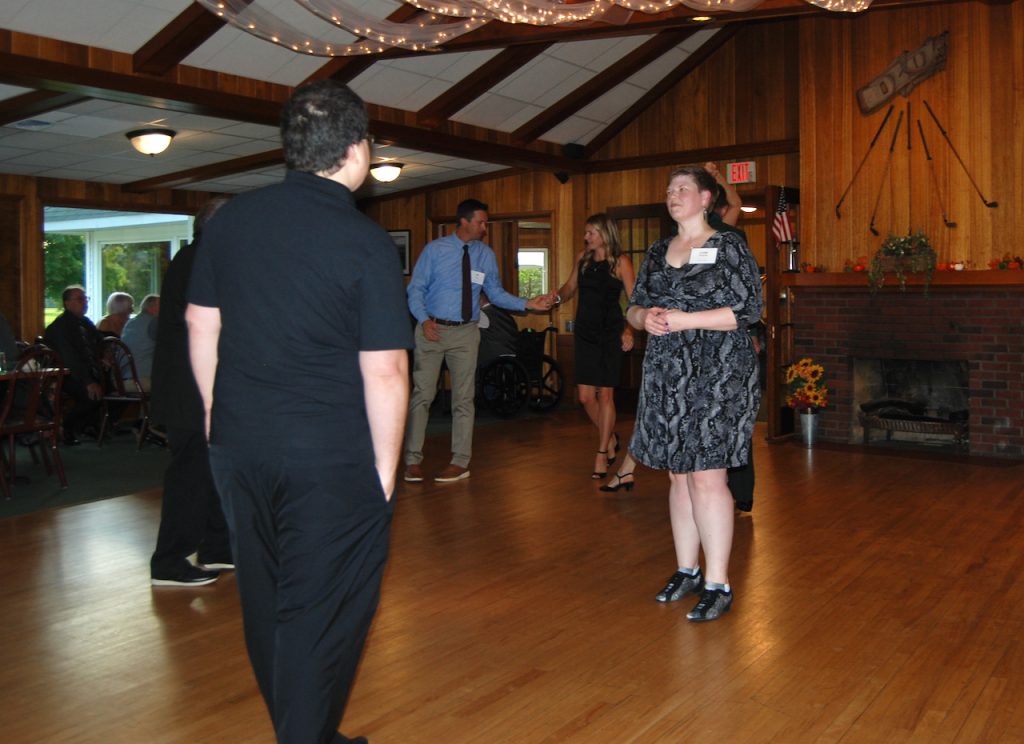
Club member and dance instructor for the evening Linda Kiesow, Madison, instructs dance participants. Saturday’s event was the first during which a dance lesson was included as part of the evening’s activities, Club 46 organizing committee member Janis Lindsey said.

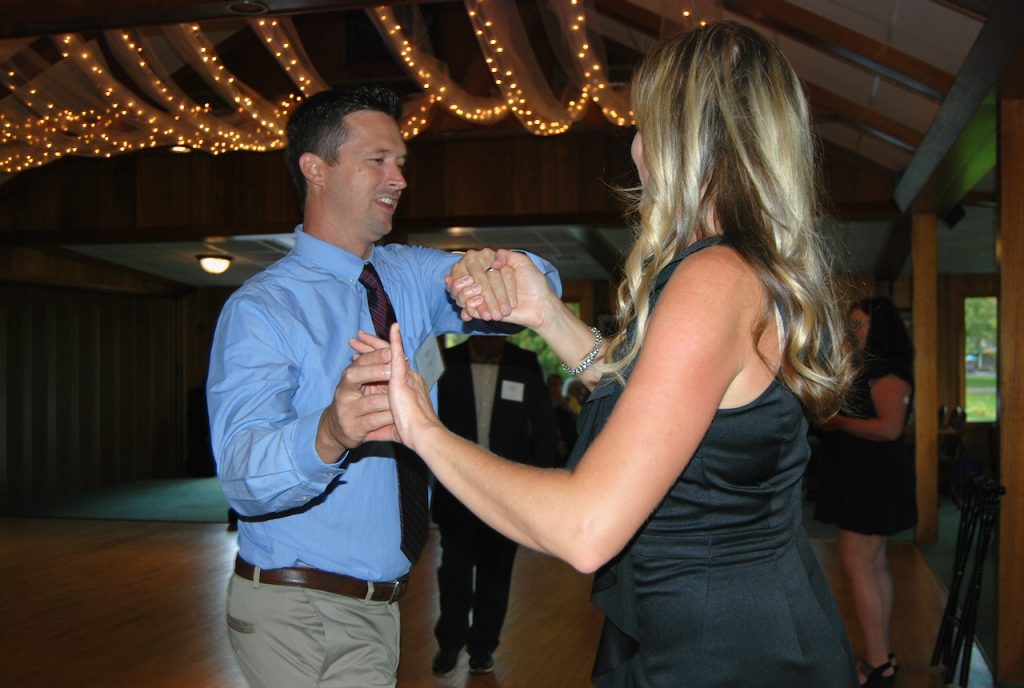
Two photos above: Club 46 dinner and dance event attendees, under the tutelage of club member and dance instructor for the evening, Linda Kiesow, learn and practice the waltz.
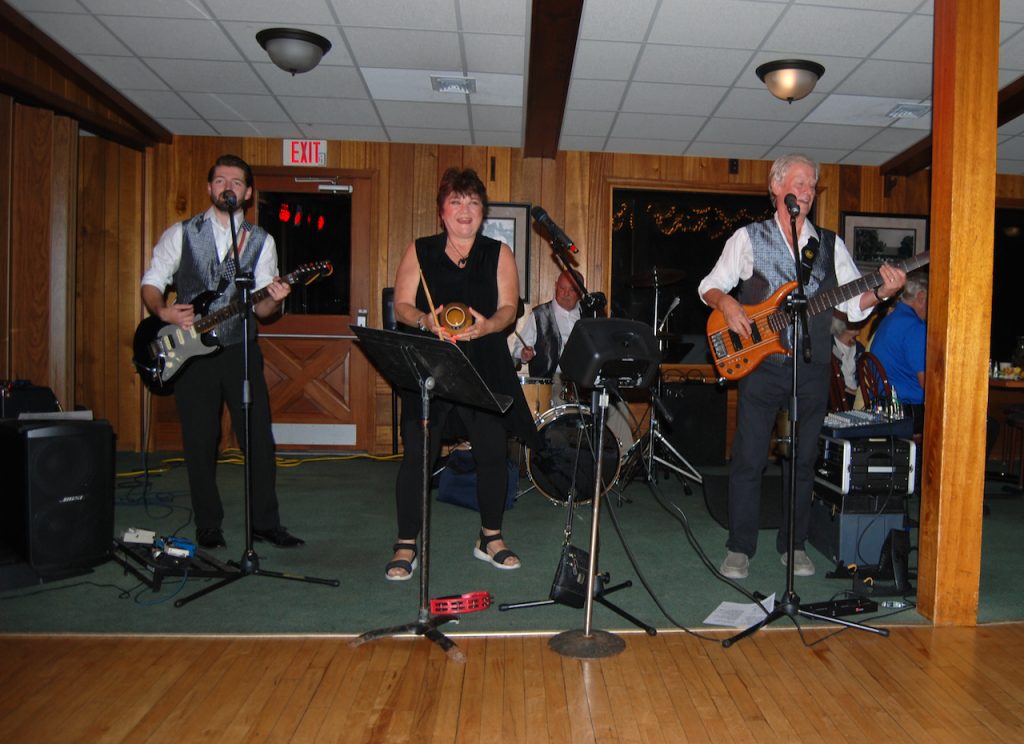
Members of the Madison-based band Marcy and the Highlights perform from a corner of the dance floor within the banquet room at the Lake Ripley Country Club.

With music in the air, couples fill the dance floor.

Cindy and John Whitney enjoy a dance.

Dan and Jo-Ellen Grob advance along the dance floor.
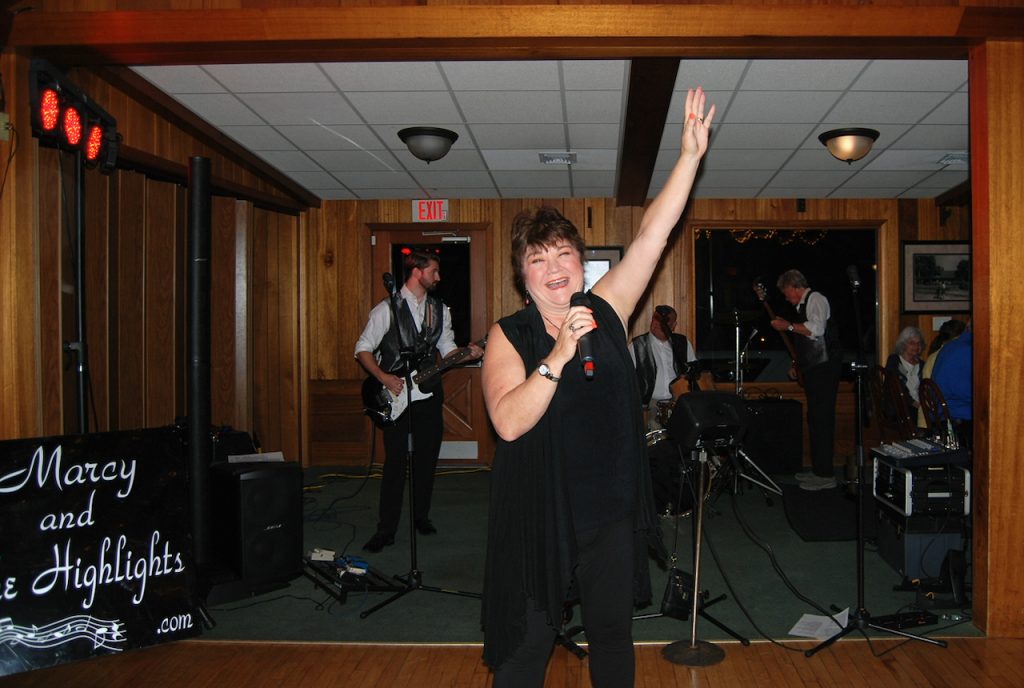
Marcy Heim, the named singer of the group Marcy and the Highlights, looks for dancers celebrating special occasions during Saturday’s event.
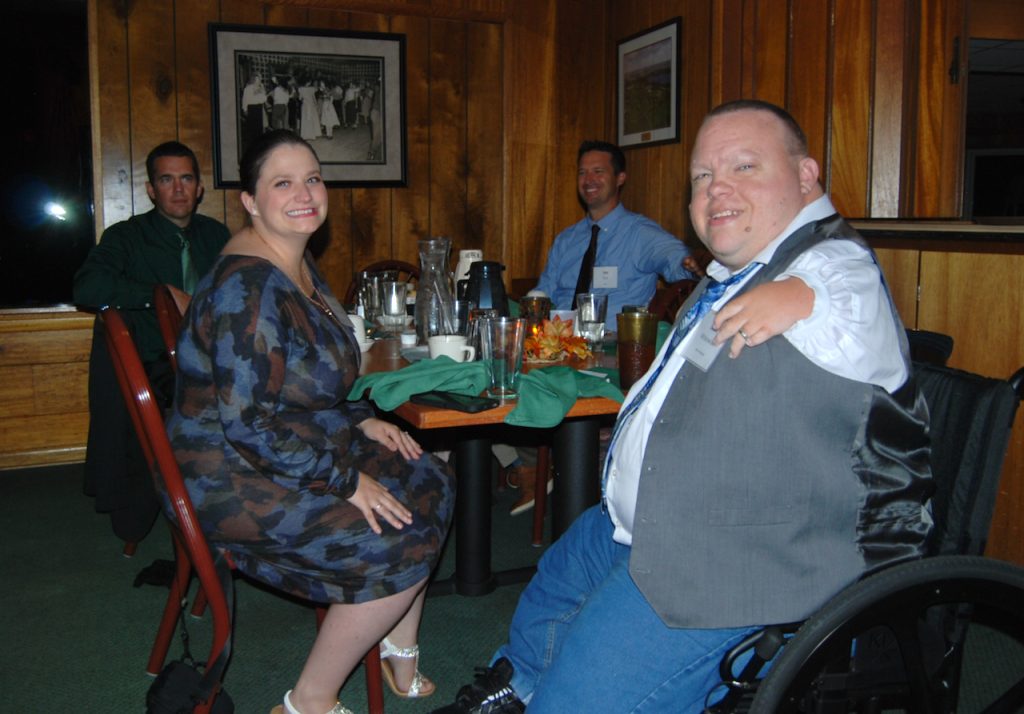
Sondra and Scott Miskowiak celebrate their third wedding anniversary during Saturday’s event. The couple is from Janesville.
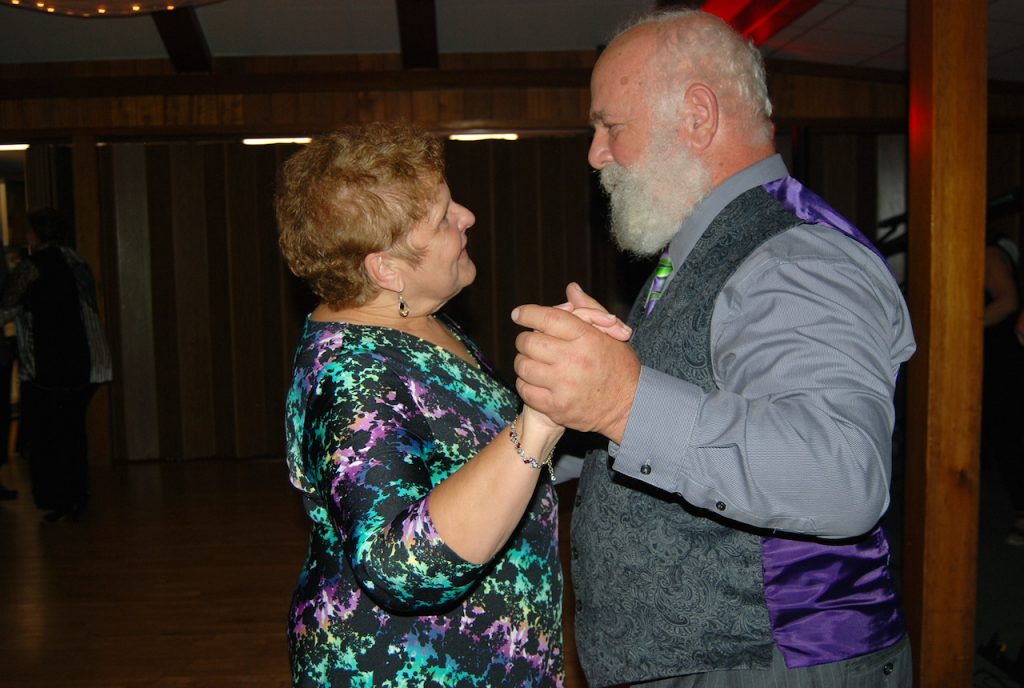
Connie and Mark Hurley glide across the floor.
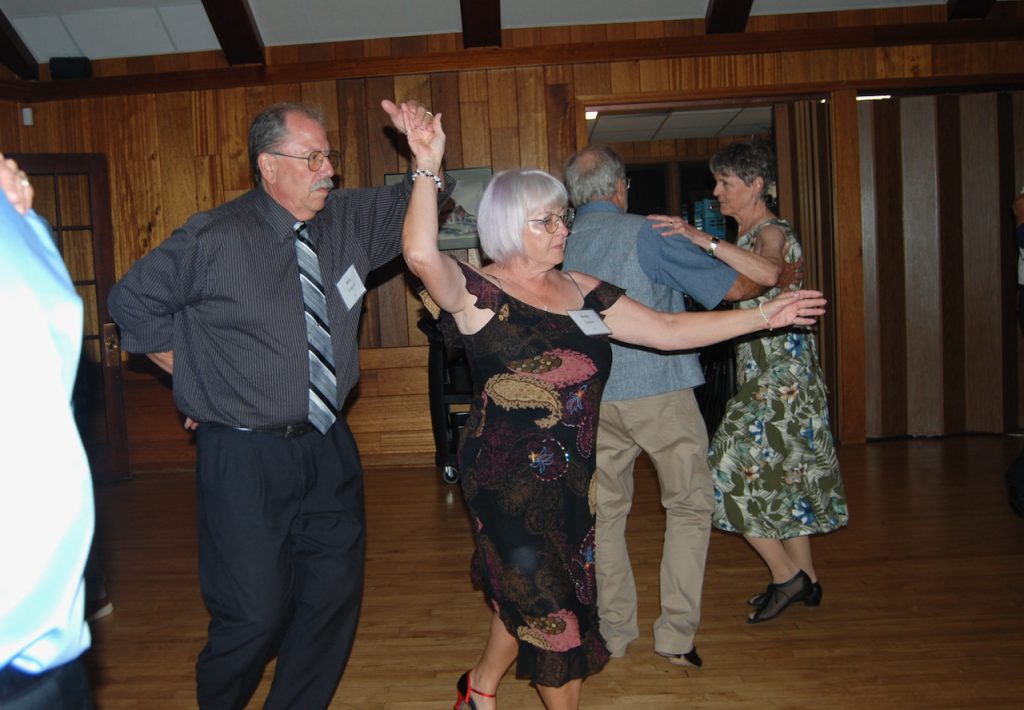
Jerry and Becky Tjugum travel across the floor.
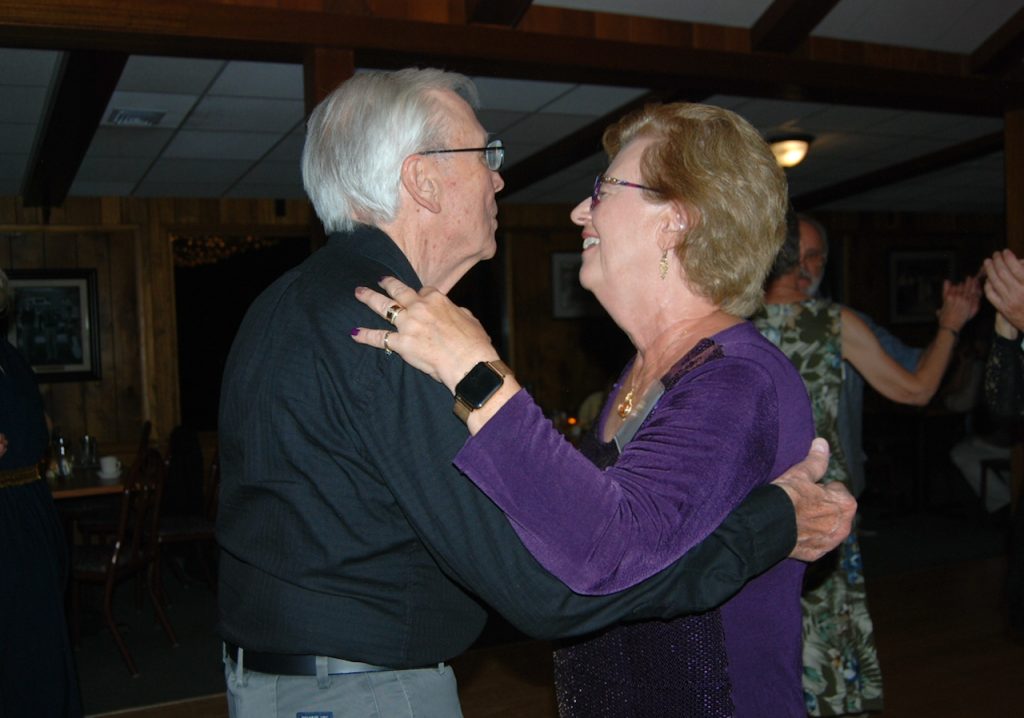
Richard and Myrna Ziegler, Jefferson, find their stride.
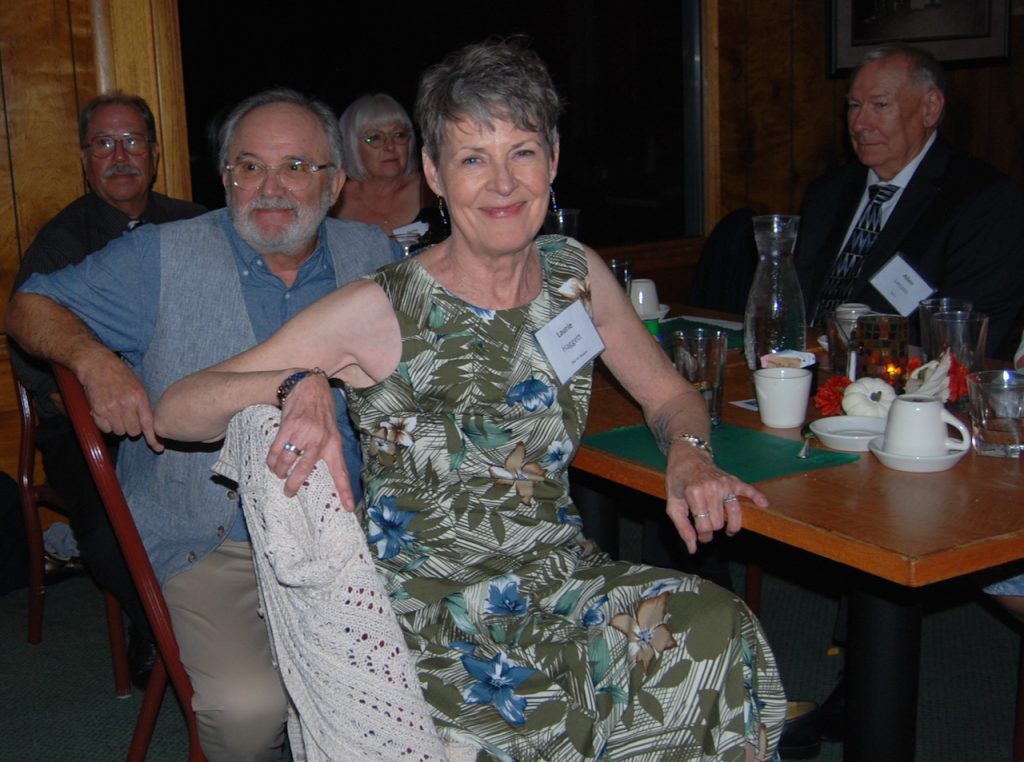
Steve Kelly and Lauri Haggard, both of Whitewater, takes a short break from dancing.

Guitar player and singer Andy Yaun performs Saturday. According to the band’s website, he joined the band when he was 15. Bass player and singer Ken Heim, who also is Marcy Heim’s husband, recalled that when Yaun joined the group, 10 years ago, he was not yet able to drive a car.
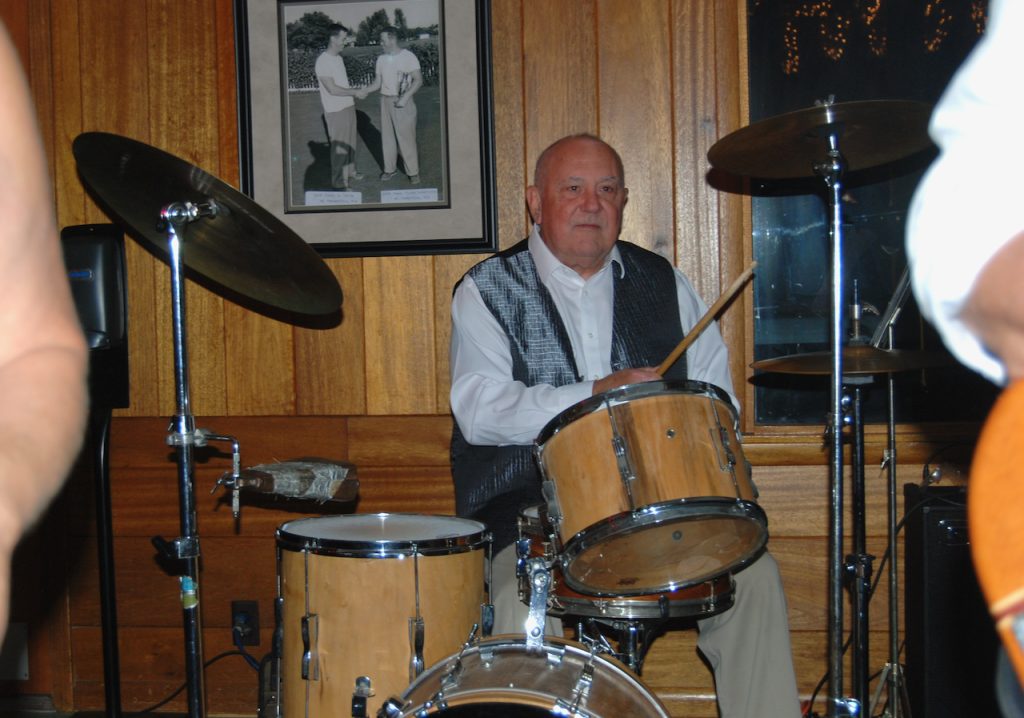
Marcy and the Highlights drummer Pat Green performs during Saturday’s Club 46 event. Ken Heim said Green has been with the band, on and off, for 25 years.

Bass guitar player and singer Ken Heim brings the music to the dance floor during Saturday’s Club 46 dinner and dancing social event.
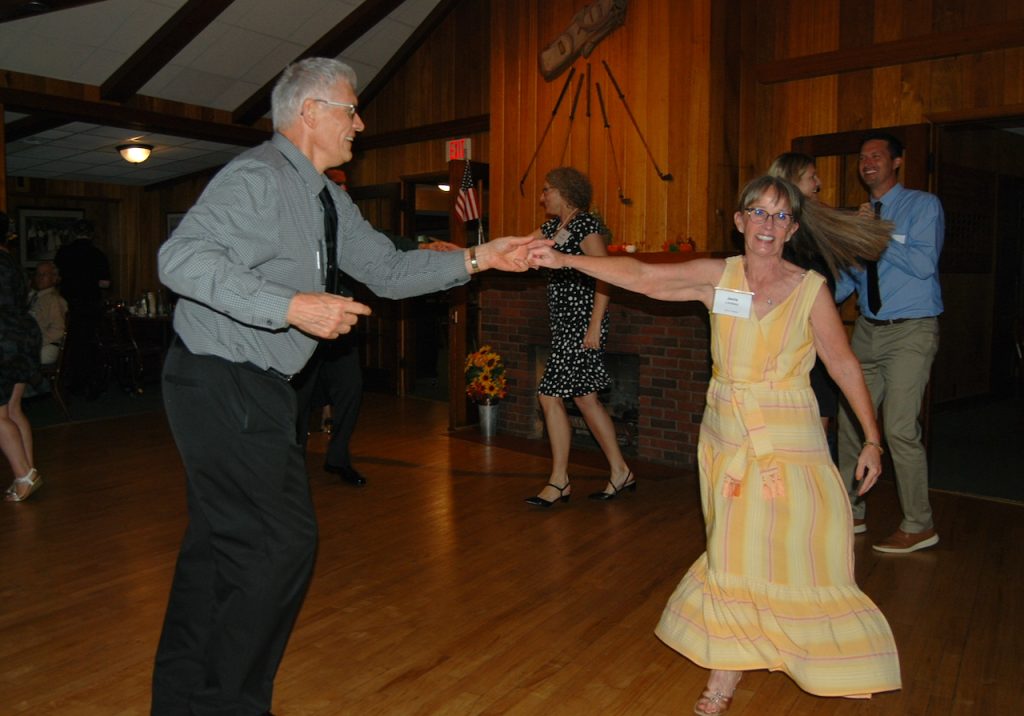
Janis Lindsey and her dance partner Don Freidig move across the dance floor.
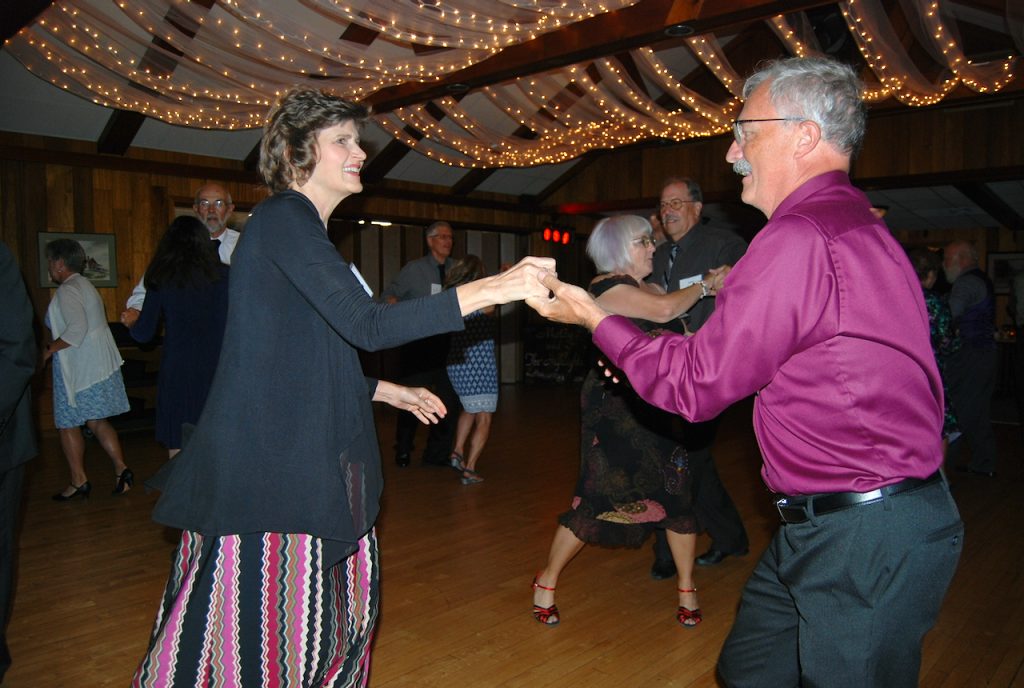
Tod and Lori Kaddatz, both members of the Club 46 organizing committee, dance. The couple is from Jefferson.
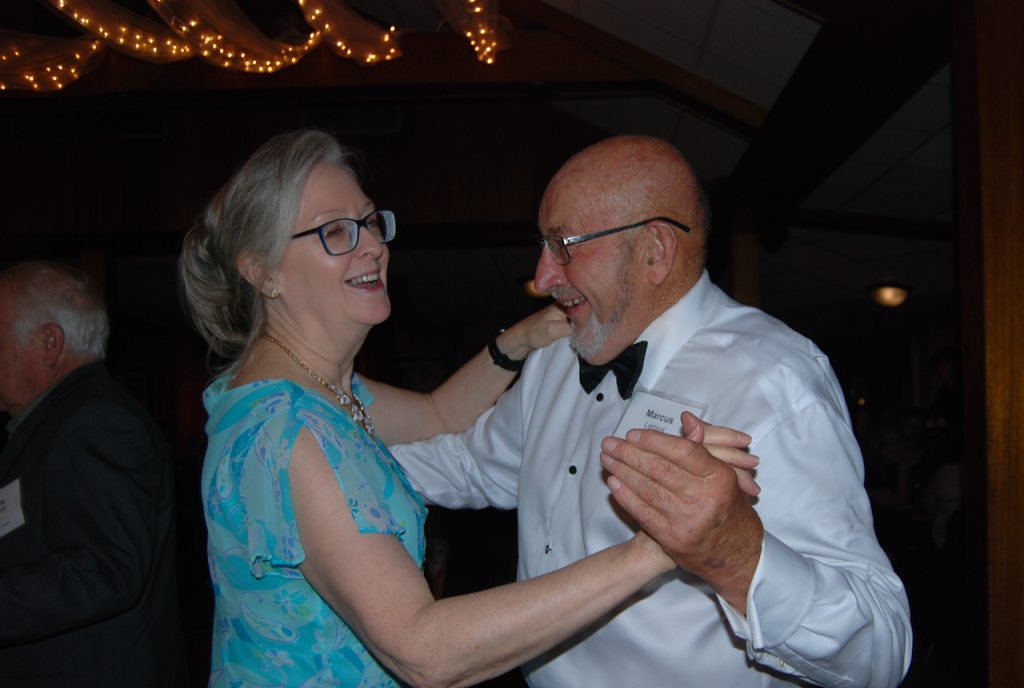
Marcus Lenius and his dance partner Pati Brown enjoy the evening.
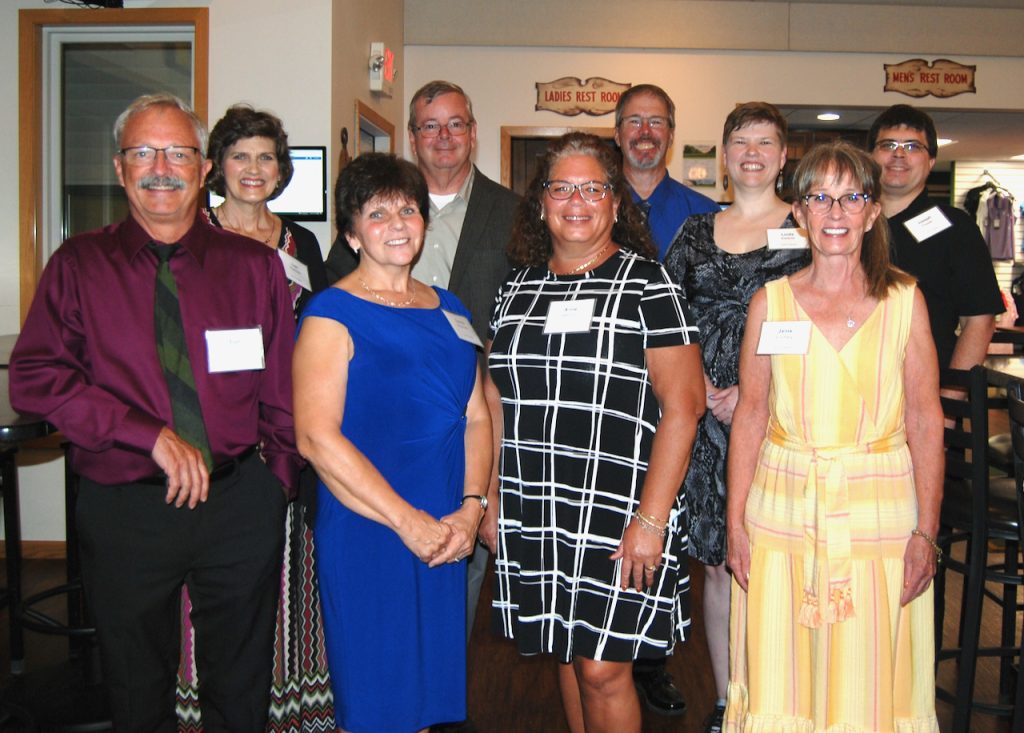
Tod and Lori Kaddatz, from left, Teresa Brawders, Jim Wesner, Anne Wesner, Alan Brawders, Linda Kiesow, Janis Lindsey, and Joseph Plasek gather during the Club 46 dinner and dancing social event. The group includes members of the club’s organizing committee and club members who served as dance instructors during the evening’s event.
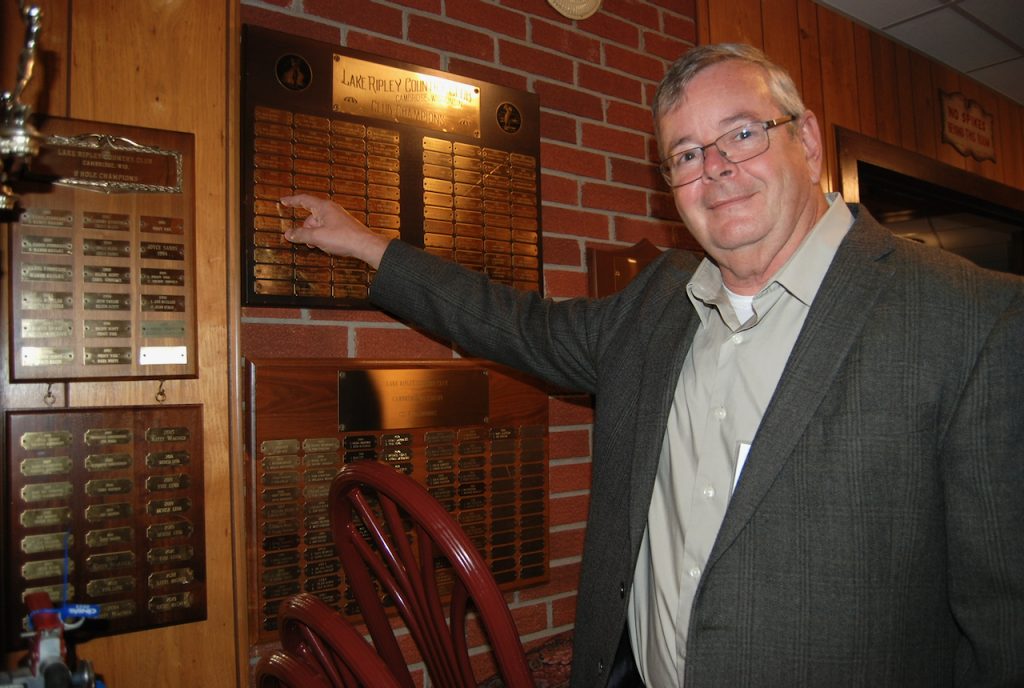
Jim Wesner, who serves as the club’s unofficial historian, points to the name of a former Fort Atkinson resident and founding member of the social club, the late Wilson Beebe, whom, he said, was an avid golfer. He won the Fort Atkinson City Golf Tournament in 1939, 1950 and 1951.
Kim McDarison photos.
Women Who Care announce 2024 priorities: school nursing, cancer screenings, Meals on Wheels
(Originally published Oct. 13, 2023.)
Update: According to a club spokesperson, a complete list of schools aided by the Women Who Care behavioral health services program includes St. Joseph’s Catholic School in Fort Atkinson, the Cambridge School District and St. John’s Lutheran School in Jefferson.
By Chris Spangler
A group of women, who have dubbed themselves, “Women Who Care,” assembled last month to discuss their mission and upcoming initiatives.
According to its website, Women Who Care is a philanthropic group committed to making a difference in the health and well-being of its communities.
The group, through its initiatives, serves the Whitewater, Jefferson and Fort Atkinson school districts by helping students overcome the effects of stress, anxiety, depression, and trauma that impedes their ability to participate fully in their education.
The group met for its quarterly business and social event on Sept. 24, at the Bridge, a restaurant located in Fort Atkinson’s downtown area, during which time the group outlined three areas of focus for 2024. They are the school nursing program, cancer screenings and Meals on Wheels.
According to the group, improving the health and well-being of area residents of all ages is a focus.
Members advocate for the building of meaningful relationships, loving families and vibrant communities. The group works in partnership with the Fort HealthCare Foundation, and seeks to build on the understanding that the health and well-being of the community is tied to people’s connection with each other.
Additionally, the group finds its shared purpose, according to its members, by building and enhancing personal and professional relationships with one another, learning together about area health challenges and seeking out ways to help their loved ones and neighbors to live healthier lives.
During the recently held quarterly meeting, group member Rochelle Mitchell welcomed guests and outlined future and past projects supported by the group.
Among projects outlined, Mitchell said that Women Who Care is committing $13,180 for 2023-24 to support school nurses in 11 districts with a total of 18,000-plus students.
Additionally, she said, Women Who Care will provide vision and hearing screening equipment and mental health first aid training to district school nurses. Nurses will be trained with equipment such as Stop the Bleed kits, which teach three quick techniques to help save a life before someone bleeds out.
Mitchell also shared past efforts the group has supported during its 19 years. They have included funding school-based behavioral health counselors and school nursing services, including motivational interviewing and ACES (Adverse Childhood Experience (Trauma) training.
ACES targets stress and trauma that can interrupt healthy child development, putting youngsters at risk for lifelong health issues, including obesity, autoimmune disease, diabetes, heart disease, poor mental health, alcoholism and even reduced life expectancy by as much as 20 years, she noted. Multiple challenges can put individuals at a greater risk for adverse outcomes, including poor school performance, unemployment, and the development of high-risk health behaviors, such as smoking and drug use.
Motivational interviewing is a counseling method used by the school nurses that helps students find the motivation to change their behavior. The nurses use motivational interviewing to guide students to find their own motivation to make necessary changes for success, Mitchell explained.
In addition, Mitchell said that Women Who Care has contributed $11,900 to the Rock River Community Clinic to purchase scientific electrode sensors, a pharmacy refrigerator to store vaccines and a nitrous oxide regulator for the community dental clinic.
Group history
According to a history offered by the group online, Women Who Care traces its roots to 2004, when the Women’s Giving Circle was established by the Fort Memorial Hospital Foundation. A group of area women gathered for quarterly lunches for information and inspiration about their health and well-being. Member contributions helped fund various services throughout Fort HealthCare and the community, including hospital equipment, new health and wellness services, and scholarships.
In 2014, some members suggested expanding the group by engaging members to determine ways in which they could make a measurable impact on the health and well-being of people in the area. A Governing Committee was formed, and the group started identifying opportunities for service.
In the spring of 2015, members voted to focus on the health of area youth for its first project as Women Who Care. At the time, the Whitewater Unified School District was seeking assistance for students who needed behavioral health services, so the group funded a pilot project to have a counselor available in the school to serve students whose behavioral health needs interfered with their ability to focus on their education.
That grew into the program that today serves the Whitewater, Jefferson and Fort Atkinson school districts, helping students overcome the effects of stress, anxiety, depression, and trauma that impedes their ability to participate fully in their education.
In 2019, Women Who Care funded an educational opportunity for Fort HealthCare’s school nurses serving nine area school districts. The nurses were able to train on helping students manage chronic disease such as diabetes, high blood pressure or epilepsy; take medications that require assistance; and assist students in need of support for behavioral health.
Women Who Care meets four times a year, with two lunches and two evening social events. The recent September gathering featured magician James Ember, a social hour, hors d’oeuvres and a gift basket raffle.
Upcoming gatherings include luncheons on Thursday, Nov. 9, at the Hoard Historical Museum and on Thursday, Feb. 29, 2024, in Classroom A of Fort Memorial Hospital. Both take place from noon to 1 p.m.
Mitchell noted that Women Who Care always welcomes women who are interested in networking and philanthropy. To join the organization, visit www.forthealthcare.com/wwc.
For more information, contact the group by email: WomenWhoCareforthc.com or phone: 920-568-5406.

A member of the Women Who Care group checks in at the registration table during a quarterly meeting held at the Bridge in downtown Fort Atkinson last month.
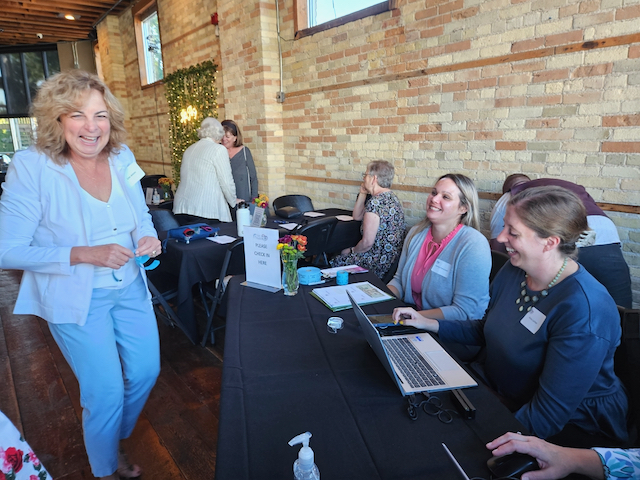
Lisa Jensen, vice president of Nursing Services and chief nursing officer at Fort HealthCare, at left, arrives at the Women Who Care registration table. The group’s business and social event was held last month at the Bridge in downtown Fort Atkinson.
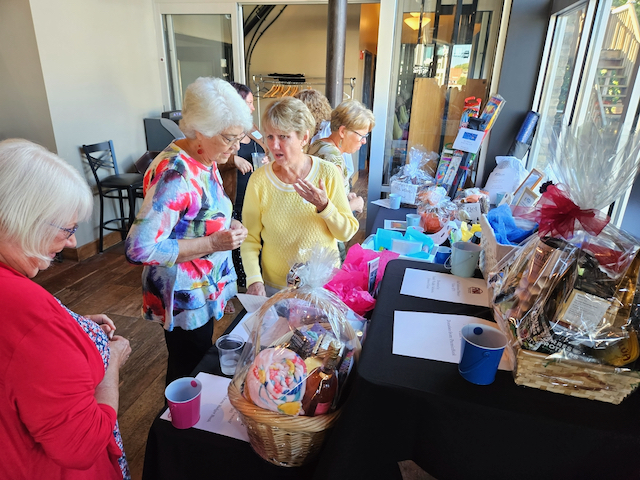
Women Who Care members and guests view the gift baskets in a silent auction to raise funds for the group’s philanthropic efforts.
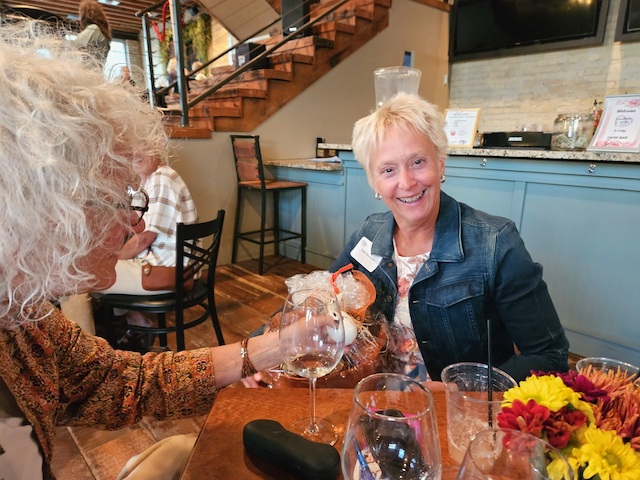
Woman Who Care member Pam Severson learns that she is the winner of a gift basket in a silent auction.

Marie Wiesmann, at left, and Lori Leary enjoy one another’s company during the Women Who Care event held last month.
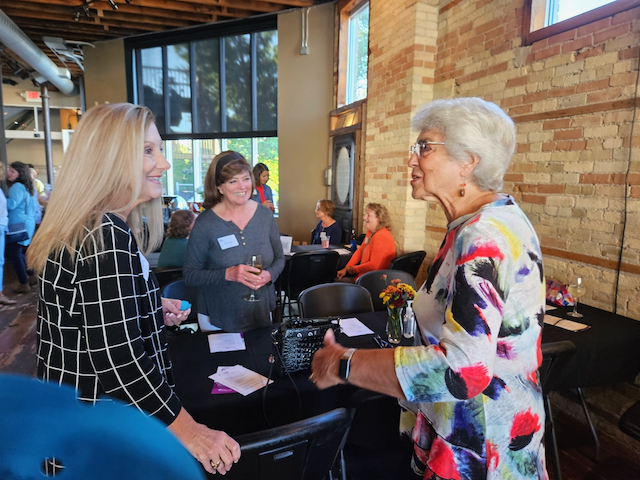
Chris Ott, from left, Eve Horton Pierce and Diane Abendroth visit during the Woman Who Care event held last month.

Visiting the serving line are Dana Trainer, from left, Betty Covey and Diane Abendroth.

Gina Elmore, at left, assists magician James Ember as he performs tricks using Rubik’s Cubes. Ember also used playing cards to perform his magic, which was presented to the entire group and at individual tables, providing a “close-up” experience.
Chris Spangler photos.
‘Flourishing First Steps’ preschool program provides learning opportunities for area families
(Originally published Oct. 15, 2023.)
By Kim McDarison
On a Wednesday morning earlier this month, Molly Fuller, “Flourishing First Steps” program coordinator, greeted 10 preschool-aged children and their caregivers as they arrived at the Early Childhood Center, a two-room learning facility housed within the School District of Fort Atkinson’s Purdy Elementary School.
Fuller, standing in the doorway of the facility, exuded an effervescent combination of warmth and excitement as each family crossed the threshold and was directed to a classroom within the center designed to intrigue children, ages birth to 3 years.
A second room accommodates “Mini Pre-K” students who are defined as children not yet old enough to attend 4-K.
Inside, Purdy Elementary School Early Childhood Special Education teacher Beth Nelson helped make families familiar with the dynamics of the birth-to-3 classroom, and engaged with children, as she smiled and conversed with each one.
The program, which kicked off on October 2, offers two classes, each held on Mondays and Wednesdays, over a three-week interval, including one designed for “Itty Bitty Pre-K” learners, defined as children, ages birth to 24 months old, and a second designed for “Mini Pre-K” learners, ages 25 months to 4 years.
In addition to her role as Flourishing First Steps coordinator, Fuller serves as a part-time special education aide at Purdy Elementary School. Nelson, she said, is responsible for developing the program’s curriculum.
Together, the women, over the course of a 45-minute period, watched and worked with children and caregivers as they explored — with aid from the women or independently — several stations, with each offering small children a fun activity, while additionally working to develop and strengthen a skill, or set of skills, children would one day need as they become learners in a traditional 4K through high school setting.
The program is free, and offered to “any child in any town,” Fuller noted in a news release introducing the program last month.
Within the earlier release, Fuller wrote: “These enrichment sessions will offer parents/caregivers and children the opportunity to learn a multitude of things through peer interaction, free play, sensory/art activities, and literacy. Children will have the opportunity to strengthen their skills through exploration, discovery, and creative experiences.
“Parents/Caregivers will have the opportunity to not only learn new and exciting ways to interact with their child/children during these sessions, but will be able to ask questions of our early childhood staff about developmental milestones.”
On the month’s first Wednesday, which was the second class within the first session, children picked their own stations to explore, with caregivers and the two program facilitators following eagerly behind.
Fuller and Nelson watched the skills and interests displayed by each child, further encouraging them to find another station that would bring additional appeal and development.
Children moved from areas offering books and puppetry, to spaces filled with trucks and toys, built for interactive play. Many stations offered items with diverse and stimulating textures. Mothers with infants found each other or helped older children while the smallest participants absorbed the activity in the room.
Among opportunities for development and learning was a water table, which, signage at the station noted, “fosters cognitive development and can teach math and science concepts.”
Additionally, the station helps build motor skills and coordination, the sign noted.
A suggested use of the water table was to wash toy dishes or give a baby doll a bath, activities that, according to the station’s literature, “builds pretend play skills and self-help skills.”
Another station invited children to “play with scarves.” Working with scarves and cardboard tubes, Fuller engaged with learners as they developed fine motor skills by pushing a scarf through a tube, and increased their vocabularies, by learning “position words,” such as “on,” “under,” “over.”
After approximately 40 minutes of robust and interactive play, the children and their caregivers gathered to listen to a story read by Fuller.
Parents left the room armed with new ideas about how to interact with the children and literature explaining the deeper value of each station, and ways they can create a similar experience at home.
Fort Atkinson’s Flourishing First Steps program was opened for registration in September. Mere hours after registration opened, the first three-week session, including both age-related program sections, filled, Fuller said.
Each class is able to accommodate 12 children.
While the first session will soon complete, a new set of classes will open Monday, Oct. 30, and run through Wednesday, Nov. 15.
Registration for the three-week session, including both age brackets, opens tomorrow.
A third session is scheduled to begin Monday, Nov. 27.
To register for the program, visit the following link: fortschools.org/firststeps.
All sessions will be held at Purdy Elementary School, 719 S. Main St., Fort Atkinson.
The program requires that a parent or caregiver remains in the room with their child/children for the duration of each session.
For more information about the program, contact Fuller by email: firststeps@fortschools.org.
An earlier story, introducing the program, is here: https://fortatkinsononline.com/district-to-offer-flourishing-first-steps-programming-for-preschool-aged-children/.
Photos from an Itty-Bitty Pre-K learners class, held Wednesday, Oct. 4, follow.

Flourishing First Steps program coordinator Molly Fuller and E.J. Rowland, Whitewater, explore tubes and scarves. The activity was one of many offered to children attended the Itty Bitty Pre-K learners class held earlier this month. The class is designed to engage children between the ages of birth and 24 months.

Julianna Latella, 3, Whitewater, draws with some company provided by Flourishing First Steps program facilitator Beth Nelson.

Flourishing First Steps program facilitator Beth Nelson, at right, engages with baby Ardella, 18-months, and her mother, Sam Shepherd, of Fort Atkinson.

Mom, Kayla Espinoza, Fort Atkinson, at left, and her daughter, Nora, 18 months, along with Giovanni, 1, and his mom, Jasman Fernandes, both of Whitewater, socialize.

Flourishing First Steps program coordinator Molly Fuller and Nora Espinoza, 18 months, Fort Atkinson, play with a scarf. The activity helps children develop an understanding of such words as “on,” “under,” and “over.”

Mila Garcia, 16 months, Fort Atkinson, finds a toy pumpkin. Various items made available to learners encourage an understanding of shapes, colors, and textures.

The Latella siblings, both of Whitewater, including Leo, at left, 1, and Julianna, 3, explore toys and interact with Flourishing First Steps program facilitator Beth Nelson.

Flourishing First Steps program coordinator Molly Fully, one of two program facilitators, interacts with children.

Barrett Siecinski, 13 months, of Fort Atkinson, pauses momentarily before deciding which station next to explore.

Ellie Brand, 21 months, and her mother, Megan, both of Fort Atkinson, explore a toy together. The pair is one of several families finding quality time interacting together as well as with other families to promote socialization.

Toddlers Leo Latella, Whitewater, from left, E.J. Rowland, Whitewater, and Barrett Siecinski, Fort Atkinson, gather around a water table.

Children and caregivers participating in Flourishing First Steps pre-school programming provided through the School District of Fort Atkinson explore various activities. Each class is 45-minutes and offers a mix of stations designed to attract and intrigue students as they learn through play.

Mila Garcia and her mom, Adrianna, explore a hammock.

Ellie Brand, 21 months, Fort Atkinson plays and socializes while her mother, Megan, watches from nearby.

Flourishing First Steps program coordinator Molly Fuller shares pictures in a book, the content of which instructs children: “I can do it too!”
Kim McDarison photos.
Fort Beautification Council brings cow replicas to town
(Originally published Oct. 16, 2023.)
By Kim McDarison
Four life-sized cow replicas, each representing one of seven dairy cow breeds featured by the Fort Atkinson Beautification Council in its “parade of cows” project, made their debut in downtown Fort Atkinson Saturday, as part of a celebration of the project as it nears completion, Fort Atkinson Beautification Council President Jude Hartwick said Monday.
The cows, including replicas painted to resemble a Jersey, Brown Swiss, Holstein and Guernsey, were presented to the community while housed in the back of a trailer to keep them safe from the rain, Hartwick said.
The replicas, which were painted by local artist Larry Schultz, have yet to receive a coat of clear paint to help them weather the elements, Hartwick noted, adding that he believed the final step in the painting process would be completed on all seven replicas in time for each to be permanently placed within the city’s downtown area sometime in advance of the Thanksgiving holiday.
As part of the unveiling celebration held Saturday, Wisconsin’s Alice in Dairyland Ashley Hagenow arrived in Fort Atkinson and visited the Fort Farmers Market. She next arrived at the W.D. Hoard and Sons Company facility, 28 W. Milwaukee Ave., where she was able to view the replicas and speak with members of the public who arrived at the unveiling celebration.
The W.D. Hoard and Sons facility is one of the locations where a cow will be permanently placed after a clear coat is applied, Hartwick explained.
During the ceremony, participants were treated to free cookies and milk. Cookies, in the shape of cows, were provided by Fort Atkinson-based Papa Brunk’s bakery, Hartwick said.
Additionally, he said, some 70 people were invited inside the W.D. Hoard building where two speakers, including W.D. Hoard associate editor on the “Hoard Dairyman” magazine team Katelyn Allen and Fort Atkinson Beautification Council Vice President and Parade of Cows Project Chairman Alan Cook, addressed the group.
Offering comments, Cook spoke about the project, and the idea for its creation, which, he explained, originated with his daughter who thought the west side of the city could benefit from some ornamentation.
Speaking with Fort Atkinson Online last month, Cook said about three years ago, his daughter, Kylene Anderson, suggested the idea of a cow replica placed in such a manner that those entering the city from the west side could see it. She suggested, Cook said, that the cow replica might be painted to resemble a cow in honor of the Hetts family farm which operated in the area.
Cook said he brought the idea to the Beautification Council, which embraced the idea and expanded it to include all seven dairy cow breeds with their placement spread throughout the downtown area.
During her comments Allen spoke about the importance of agriculture, dairy farming, and the long association Fort Atkinson has had with dairy as a regional, staple industry.
The full parade
Updating information shared earlier with Fort Atkinson Online, Hartwick said the full parade of seven replicas, including their sponsors and placement, is as follows:
• Jersey: Described by Schultz as a “dark Jersey,” the replica, which was nearly completed on Wednesday, will soon be placed near the Fort Atkinson Area Chamber of Commerce building, 244 N. Main St. The location is near the replica’s sponsor: Pete’s Tire and Auto Shop, 2 Madison Ave.
• Brown Swiss: the replica which was undergoing transformation on Wednesday is that of a Brown Swiss cow which will soon be placed near Frostie Freeze, 208 Madison Ave. The replica is sponsored by Whitewater-based Sunshine Genetics.
• Black and White Holstein: A replica of a Holstein cow will be placed near Subway in Fort Atkinson, 1550 Madison Ave. The fiberglass replica is sponsored by Crescent Beauty Farm, which is owned by the Hetts Family.
• Guernsey: Brian Knox and W.D. Hoard and Sons Company are the sponsors of a Guernsey cow replica which will be placed near the company’s downtown printing office, 28 Milwaukee Ave.
• Red and White Holstein: Deb Lundy, who, along with her family, operates a dairy farm in Jefferson, is the sponsor of a Red and White Holstein replica which will be placed near Jones Market, Fort Atkinson, 601 Jones Ave.
• Ayrshire: The Fort Community Credit Union or FCCU will be sponsoring a replica which will be painted to resemble an Ayrshire cow. The replica will be placed near the credit union’s office at 800 Madison Ave.
• Milking Shorthorn: The Tourism Office of the Fort Atkinson Area Chamber of Commerce will be sponsoring a replica of a Milking Shorthorn cow, which will be placed near NASCO.
The models
Each cow also is modeled after an actual cow. In September, Cook presented Fort Atkinson Online with representations of five of the seven models, including:
• The Brown Swiss replica, which is painted in the likeness of “Top Acres Present ET.” A photograph of the animal was provided by Sunshine Genetics.
• The Jersey cow replica, which is painted in the likeness of “Kunia Moon.” The cow’s picture was provided by Brandenburg Dairy Farm, Cook noted.
• The Guernsey cow replica, which is painted in the likeness of “Rolling Prairie Bella Blue.” The cow’s picture was provided by the Hoard’s Dairyman Farm.
• The Black and White Holstein, which is painted in the likeness of “Gene Acres Felicia May Fury.” The animal’s likeness was provided by Crescent Beauty Farm.
• The Red and White Holstein, which is painted in the likeness of “Silver-Rock TT Barbara.” The likeness was provided by Lundy Farms.
On Monday, Hartwick said all of the cow replicas have since found models. The two remaining breeds — the Milking Shorthorn and the Ayrshire — will be modeled after bovines presented by the Hebbe and Gerner families.
Cook said the Ayrshire replica will be painted in the likeness of “Hillside View Darling,” who once lived on the former Heb-Ayr farm located to the east of the city of Fort Atkinson.
The Milking Shorthorn will be painted in the likeness of “Weg Acres Majors Faith,” who once lived on a farm owned by the Gerner family called “Weg Acres.” The farm is located northeast of the city of Fort Atkinson.
Pictures from Saturday’s unveiling ceremony follow.
Earlier stories about the cow parade are here: https://fortatkinsononline.com/coming-to-life-cow-replicas-are-receiving-paint-second-downtown-mural-to-follow/ and here: https://fortatkinsononline.com/beautification-council-planning-cow-parade/.

Wisconsin’s Alice in Dairyland Ashley Hagenow, at left, and W.D. Hoard associate editor on the “Hoard Dairyman” magazine team Katelyn Allen present to unveiling ceremony participants the Guernsey cow replica which will be placed near the company’s downtown printing office, 28 Milwaukee Ave. The women hold cookies in the shape of cows which were provided to event-goers and made by Brunk’s Bakery in Fort Atkinson.

Wisconsin’s Alice in Dairyland Ashley Hagenow, at left, and area artist Larry Schultz, who painted the cow replicas, greet unveiling ceremony participants from the back of a trailer, which, on Saturday, kept the four replicas inside safe from the morning’s rain. The two flank the Guernsey cow replica which will be placed near the W.D. Hoard Dairyman downtown printing office, 28 Milwaukee Ave., after a coat of clear protective paint is applied.

Fort Atkinson Beautification Council Vice President and Parade of Cows Project Chairman Alan Cook, addresses a group of event-goers from inside the W.D. Hoard downtown printing facility. Cook spoke about the project, and the idea for its creation, which, he explained, originated with his daughter who thought the west side of the city could benefit from some ornamentation.
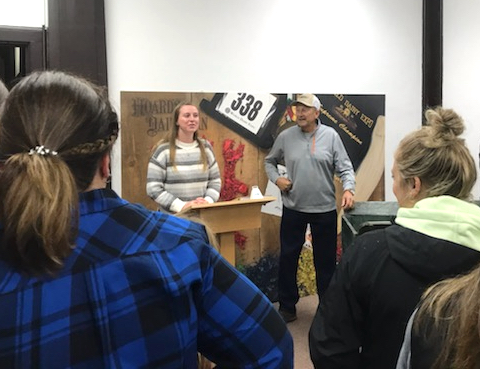
At the podium W.D. Hoard associate editor on the “Hoard Dairyman” magazine team Katelyn Allen shares thoughts about the dairy industry and its importance, both generally, and in Fort Atkinson.
Contributed photos.
Council approves ordinance allowing ATVs on city streets; goes into effect next spring
(Originally published Nov. 8, 2023.)
By Chris Spangler
The Fort Atkinson City Council on Tuesday gave the green light for all-terrain and utility-task vehicles to travel on city streets starting next spring.
The vote was 4-1, with councilman Davin Lescohier the lone dissenter.
In past discussions, he had expressed concern that city staff, along with City Manager Rebecca Houseman and Police Chief Adrian Bump, had recommended delaying any decisions on ATV/UTV use within the city until the state provides additional direction regarding the applicability of state motor vehicle laws to ATVs.
During a July Ordinance Committee meeting, Bump had voiced concerns about the safety of riders and passengers of ATVs, which — with their low-pressure tires and lack of safety features such as speedometers, horns, headlights, turn signals or taillights — are not intended for use on public roads. He also cited the lack of a helmet requirement, potential noise and exhaust problems and the fact that unlike in northern Wisconsin communities, Fort Atkinson has no ATV/UTV trail systems or businesses that complement them.
In addition, he mentioned a dearth of state enforcement regarding requirements for a driver’s license or insurance and a concern that no state law impacts the issue of open intoxicants in or on an ATV or UTV.
Also noted during earlier meetings were state Department of Natural Resources (DNR) statistics reporting that during the first nine months of 2023, ATV/UTV crashes had claimed the lives of 26 people. More than 50% of the fatalities in 2023 (14) occurred on public highways, roads, or routes as designated by the state or local municipality.
A subsequent amended draft resolution included language requiring operators to follow multiple motor vehicle-related statutes. Changes were:
• All operators must be 18 years or older, hold a valid driver’s license and be able to provide proof of insurance and registration by request of law enforcement officers.
• All operators must use protective eyewear. Also, ATVs and UTVs must have windshields of sufficient height to meet the eye protection requirement as with motorcycles in existing state statutes.
• ATVs and UTVs may not be operated on city streets between 10 p.m. and 5 a.m.
• Headlights will be always present and on.
• Operators must obey all traffic rules and regulations.
• Penalties for violations will range from $50 to $200.
• The ordinance will be reviewed every six months via staff report. In addition, it will be automatically repealed in two years if no further action is taken by the council.
• The effective date will be April 8, 2024, to provide time to post signage and to train police in ATV/UTV state laws, the local ordinance and other enforcement issues. Additionally, the CAD/RMS system and the citation software must be updated to include ordinance violations and fine amounts.
Council remarks
Two of the five city council members spoke at Tuesday’s meeting, both indicating that their earlier concerns about ATVs in the city had been abated.
Councilperson Eric Schultz said he did not feel confident that the State of Wisconsin would act swiftly in fixing concerns about ATVs and UTVs.
“Originally, I was 100% on board with the city manager and police chief’s recommendations to not allow ATV and UTV use on our roads; however, I wanted to do my own research, test my own biases and opinions,” he said, noting that he visited ATV clubs and even test-drove their vehicles.
“As a bicyclist and motorcyclist, I felt safer and more comfortable on a UTV than I do on a bicycle or motorcycle,” Schultz said. “Almost all city streets are limited to a maximum 35 miles per hour or lower, and I can attest that this felt entirely safe.”
He stated that most of the fatality data presented earlier to the council were related to the driver him or herself and traveling on county highways, which have ditches and higher speed limits.
“Concerning the economic benefit, we’ve had restaurant and bar owners sign a petition asking to allow them. As a motorcyclist, I take daytrips and stop at gas stations, restaurants. I pay for oil changes and parts. Although the economic impact may be marginal, in my opinion, it is still positive,” Schultz concluded.
Echoing Schultz’s comments was Councilperson Mason Becker.
“I originally had a lot of concerns, not about ATVs themselves, but just some of the safety implications and their use on city streets,” he said. “But I think we’ve had a very good and very open public process in looking at this ordinance, and we ended up crafting a very well-worded ordinance that took care of essentially any safety concerns that I originally had.”
He said he received mixed feedback from the public on the proposal. However, he also talked to two colleagues in neighboring communities who at first were against their ATV ordinances, but after their approval, had seen no problems.
“One thing I’ve said before is that one of the roles the council has is to provide oversight of things we’ve passed. We’re going to be looking at this. I know the clubs have put forth a ton of advocacy for responsible ridership and I know they will continue to do so,” Becker said. “And I know we are going to have check-ins on this every six months and we’re going to see how this is working out in our community, and if we do have major safety issues, we always can revisit those at a later time.
“But I’m very optimistic that this is going to provide a new avenue for recreation in our community, maybe bringing new visitors into Fort Atkinson, so I am comfortable at this point in moving forward with this,” he concluded.
Other business
In other business Tuesday, the council:
• Approved a small animal-collection contract with the Humane Society of Jefferson County.
According to City Clerk/Treasurer Michelle Ebbert, the Humane Society will charge Fort Atkinson $2.67 per 12,412 city residents, which totals $33,140.04 per year. That reflects a 3.7% cost increase from last year.
However, the Humane Society also applies a 1.5% discount if the city pays the contract in full in January. With the discount, the annual fee is $32,642.94, a savings of $497.10.
• Approved a Class B intoxicating liquor license for The Langholf (sic). Located at 225 S. Main St., it is in the former Blue Stem Market Collective building, now owned by the Sweet Spot Coffee Shop LLC, Whitewater.
• Approved a Class A fermented-beverage license allowing beer to be sold at Family Dollar, Suite A at 1517 Madison Ave.
• Amended the city Land Division and Development ordinance relating to updating and acting new park impact fees.
• Heard a budget update from Houseman.

Fort Atkinson Municipal Building, file photo/Kim McDarison.
DOT reveals plans for roundabout at Highway 106 and County N; cites safety as reason
(Originally published Nov. 14, 2023.)
By Chris Spangler
State officials recently received citizen input on building a roundabout at the intersection of State Highway 106 and Jefferson County Highway N.
A public involvement meeting on the proposed project was held Wednesday, Nov. 8, at the Town of Koshkonong Hall.
Representing the Southwest Region of the Wisconsin Department of Transportation (DOT) were project manager Matthew Lamb and project engineer Tijler DeyMarcos.
“The purpose of this project is to improve safety at this intersection,” DeyMarcos said. “This intersection was identified in the 2019 Locations of Interest Report via the (federal) Highway Safety Improvement Program known as HSIP.”
He reported that from 2013-2018, 13 crashes occurred at that location just east of Fort Atkinson.
“Of those crashes, eight were right-angle crashes all caused by drivers on County N failing the yield to Highway 106 traffic,” DeyMarcos said. “This resulted in three minor injuries and five property damage-only crashes.”
He also shared crash data from 2019-2023.
“Over the current five-year period, there were 12 total crashes. Eight of those were right-angle crashes, once again all caused by drivers on County N failing to yield to the Highway 106 traffic. This resulted in two serious injuries and three minor injuries.
It was concluded that this intersection has a crash pattern of failure to yield,” DeyMarcos explained.
Addressing those concerns, he said, the Bureau of Traffic Operations developed an Intersection Control Valuation Report.
“This report takes into account numerous factors, including traffic forecast, crash history, crash patterns, oversized/overweight vehicle frequency and other environmental factors,” DeyMarcos said, adding that it considered three alternatives: do nothing, install traffic signals or build a roundabout.
He pointed out that doing nothing would not improve safety, while traffic flow did not warrant traffic lights.
“The preferred alternative is to reconstruct the intersection into a single-land roundabout. This should reduce the potential for serious-type crashes, along with providing an operationally efficient intersection where most vehicles are going to be able to get through with only minor delays,” DeyMarcos said.
He shared a graphic indicating conflict points where vehicle paths diverge, merge or cross and which are likely to cause rear-end, sideswipe and right-angle crashes, respectively.
“There are 32 total conflict points at the current intersection. Sixteen of them are crossing,” he said. “For the single-lane roundabout alternative, there are only eight total conflict points and none of them are crossing. This will reduce the potential for serious injury or crashes.”
DeyMarcos said the roundabout effectively removes those crossing conflict points by simply going around them.
Roundabout design
Proposed improvements include reconstructing the intersection into a single-land roundabout and replacing culverts.
DeyMarcos said that asphalt pavement was chosen for the exterior of the intersection to match existing pavement. Concrete will be used for the interior because it typically is easier to use in construction and has been proven to better hold up to heavy truck traffic that might be slowing or stopping at the entrances to the roundabout.
He said islands will not only separate traffic, but also cause it to slow down while entering the roundabout.
“The roundabout is designed to accommodate a multitude of large truck traffic,” he said, citing 40-foot trucks such as a typical U-Haul to 83-foot semi tractor-trailers.
During initial public outreach, he said, the DOT received some suggestions for vehicle accommodations. They include ensuring the roundabout is able to accommodate combines, snowplows, 43-foot grain trucks and lowboys with a 53-foot trailer.
“In summary, this roundabout was designed to accommodate every single vehicle that was mentioned,” DeyMarcos said, cautioning that the design is very preliminary and will be adjusted as input is received and further study is done.
He added, “A DOT Intersection Control Evaluation Report concluded that a roundabout was the only feasible option to boost safety, as it has proven to reduce serious-type injury crashes while preserving an acceptable level of service for traffic flow.”
Detour routes
DeyMarcos said that the Highway 106/N intersection would be closed to through-traffic during the reconstruction. There would be temporary driveway closures during the work, with property owners informed beforehand.
“The reason why we prefer to detour or to close the intersection is that it typically results in a lower bid price and it usually results in a shorter construction time frame,” he said.
State Highway 106 traffic would be detoured along U.S. Highway 12 from Fort Atkinson to Whitewater and then State Highway 59 from Whitewater to Palmyra. County Highway N traffic is anticipated to be detoured on Business State Highway 26 and then State Highway 89 through Fort Atkinson to Highway 12 and then County Highway M to Highway N.
An environmental study is expected to be completed in the summer of 2024, with the complete design study report and roundabout geometrics finalization by that fall. Real-estate acquisition would start in the winter of 2024. Final plans would be completed in the winter of 2026 with construction beginning in the spring of 2027.
“We will be acquiring real estate in the form of temporary and permanent easements to perform grading operations and future maintenance in proposed ditches,” DeyMarcos said.
The pricetag for the roundabout is estimated between $2 million and $4 million, with 90 percent being funded through HSIP and 10 percent through the state.
Public questions and input
Responding to questions from attendees, Lamb said roundabouts in a rural setting usually take about three months to build.
Curt Abendroth remarked that it appeared that the project was based on fewer than two crashes a year.
“The worry is that if we leave the intersection as it is, it could result in more serious injuries or even fatalities in the future because there is that failure to yield,” DeyMarcos replied, explaining that the resulting right-angle crashes are the most dangerous because there is less of a buffer between the driver and striking vehicle.
Lamb added that the DOT has been seeing progressively more serious crashes.
Another attendee asked if speed was studied.
“Most accidents will be in the eastbound traffic and there is a curve there,” he said. “People come around 70, 75 miles an hour and by the time you’ve made your decision to come out (into the intersection), sometimes those cars are upon you very quickly.”
He suggested that were the 45-mph speed limit extended to the intersection, the crash rate might drop about 90 percent.
DeyMarcos replied that speed has been a consideration.
Lamb said that speed studies are based on the 80-percentile traffic speed and that’s what dictates many of the speed limits. In this case, the stretch of road does not warrant 45 mph.
“That’s not going to slow them down,” he said.
Abendroth suggested installing speed bumps along Highway N prior to the Highway 106 intersection to slow down vehicles.
“Speedbumps are usually reserved for very slow speeds, like 25- mph and 30-mph areas. So if you put it on 55, people aren’t going to have enough time to slow down,” Lamb said.
He emphasized that the speed on Highway 106 is not the problem. Rather, the problem is people on Highway N crossing Highway 106.
“(Highway) 106 could be going 100 miles an hour and it wouldn’t matter because N (traffic) is supposed to stop,” Lamb said.
Frankie Fuller asked whether the roundabout will have room or even a dedicated lane for bicycles.
Lamb said that the five-foot-wide shoulders should help provide space. In addition, the roundabout speed limit is 20 to 30 mph max, so bicyclists should be safer that they currently are crossing that intersection.
“Typically, if we were going to accommodate bikes, it would be through specialized paths. Our multi-mobile engineer determined that this intersection isn’t qualified for that, but we can definitely speak to her about that,” Lamb said.
Jefferson County Highway Department operations manager Brian Udovich was in attendance and said that the current county bicycle map does not recommend these routes for bicyclists due to traffic volume and speed and the fact that they are not near recreational trails.
Continuing, another attendee said he favors this change. Not only will the roundabout slow traffic, but large trucks won’t have to stop to turn, he said.
“I wouldn’t put grass in the middle; it will just be a hayfield,” he added, referring to the center island. “I’d rather see through the roundabout.”
Several attendees agreed that the roundabouts along State Highway 26 in Watertown are “the worst” because motorists must turn left to enter and then immediately turn right. The roundabout at State Highway 60 and County Highway F near Ixonia is good for passenger vehicles, but a little small for trucks, they said.
“It makes no sense. (Highway) 106 seems straight; N’s a little goofy,” a man said.
“We have learned a lot over the years. At some of our original roundabouts, we have had to go back and adjust and modify them because, like everything, we learn as we go through. We’re hoping we’ve caught those lessons from others,” Lamb said.
Responding to a question about lighting, he said that that lower-wattage LED bulbs will be used.
“The intent is to gradually increase light as people enter (the roundabout), give them lights so they can see what’s happening and then, as they exit, lower the lighting,” Lamb said.
He said the bottom line of the project is improving safety.
“Usually when we have these projects, there have been a number of fatalities. This is the first one I’ve come across we haven’t had one yet. I really don’t want to see one. If we can address it by eliminating the possibility of having it by removing that accident type, that would be the best,” he said.
“The concern is we can’t control the driver. The roundabout we can use … and it will help force people to slow down.”
For more information, Lamb may be contacted at by email: Matthew.lamb@dot.wi.gov. The project website address is: https://wisconsindot.gov/Pages/projects/by-region/sw/wis106-countyn/default.aspx.
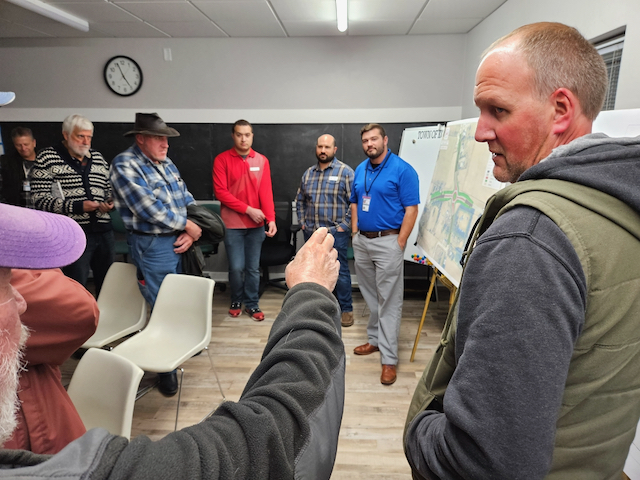
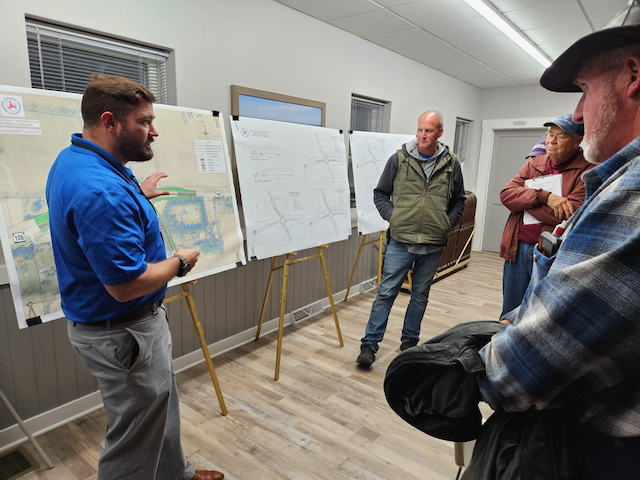
Two photos above: State Department of Transportation officials visit with members of the public prior to a Nov. 8 meeting regarding building a roundabout at the intersection of State Highway 106 and Jefferson County Highway N.

A DOT supplied schematic shows the planned roundabout at the intersection of State Highway 106 and County Highway N in the town of Koshkonong.

A map supplied by the DOT shows proposed detour routes which will be in place during the planned roundabout’s construction. The routes are marked in red.
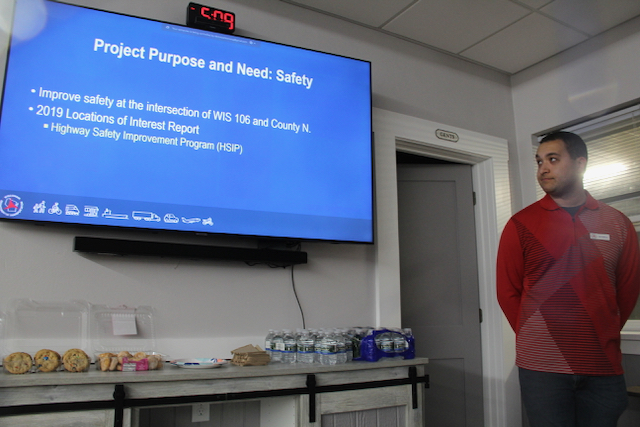
Department of Transportation project engineer Tijler DeyMarcos outlines details of the proposed roundabout.
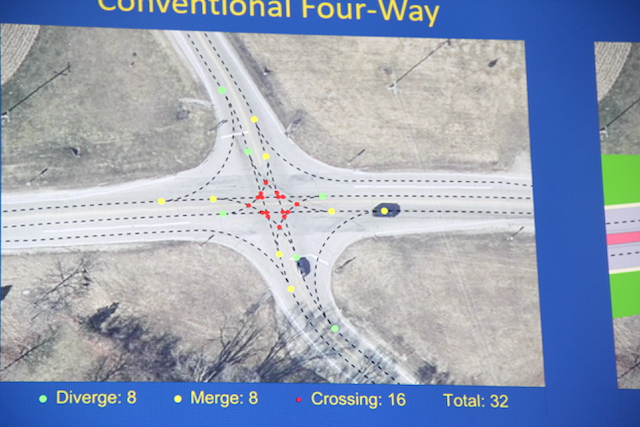
The DOT supplied graphic above shows 32 conflict points at the Highway 106/County N intersection, where vehicle paths diverge, merge or cross and which are likely to cause rear-end, sideswipe and right-angle crashes, respectively. Sixteen of them are crossing conflict points, department official said.
Chris Spangler photos.
DPI releases 2022-23 district, school report cards
(Originally published Nov. 18, 2023.)
The Wisconsin Department of Public Instruction (DPI) Tuesday released its 2022-23 school year district report cards.
According to a DPI news release: “Statewide, achievement improved from 2021-22 to 2022-23, though for many schools and districts, 2022-23 achievement performance is lower than pre-pandemic levels.”
The release noted that, following the pandemic, “report card achievement scores, overall scores, and ratings may have decreased despite upward trending achievement performance.”
Additionally, the release stated: “This is the first report card that does not include achievement data from assessments occurring prior to the start of the COVID-19 pandemic. The DPI urges caution when interpreting scores and ratings due to impacts resulting from the pandemic.”
School achievement report cards, published annually, include data on multiple indicators for multiple school years across four priority areas: achievement, growth, target group outcomes, and an area titled “on-track to graduation.”
Districts are given an “overall accountability score,” placing them, and their schools, into one of five overall accountability ratings: “Significantly Exceeds Expectations,” represented with five stars; “Exceeds Expectations,” represented with four stars; “Meets Expectations,” represented with three stars; “Meets Few Expectations,” represented with two stars, and “Fails to Meet Expectations,” represented with one star.
Overall statewide findings
As stated in the release, of 378 public school districts receiving report card ratings for 2022-23 school year, 357, or 94%, met, exceeded or significantly exceeded expectations. Among districts receiving report card scores for both the 2022-23 and 2021-22 school years, 19 increased by one rating category compared to the prior year, 52 decreased by one rating category, and 306 had no change in rating.
There were 2,098 report cards produced for public schools for 2022-23. Among public schools, 158, or 8%, were unable to be scored due to insufficient data. Of the scored public school report cards, 1,601, or 83%, met, exceeded or significantly exceeded expectations. Among public schools receiving scored report cards for both 2022-23 and 2021-22, 255 increased in rating at least one category compared to the prior year, 394 decreased in rating at least one category, and 1,254 had no change in rating.
Additionally, the release noted, there were 405 private schools participating in a Private School Choice Program for 2022-23. Of scored private choice school report cards, 136, or 80%, met, exceeded or significantly exceeded expectations. Among private choice schools receiving a score for both 2022-23 and 2021-22, 26 increased in rating at least one category compared to the prior year, 48 decreased in rating at least one category, and 80 had no change in rating. Some 235 private choice schools, or 58%, were unable to be scored due to insufficient data. This is in part due to the tested choice student population being too small to meet the conditions required to produce report cards, either because of low test participation rates, or total choice student population size.
Further, the release stated, along with achievement, growth, and graduation rates, another component of the report cards is chronic absenteeism, which is the percentage of students enrolled for at least 90 days who missed more than 10% of school days. Wisconsin students, attending both public and choice schools, had a 23% chronic absenteeism rate for 2021-22, the most recent year of data for absenteeism. In line with national trends, this represents an increase from 2017-18 through 2019-20 of 13%, and 2020-2 of 16%. The DPI continues to work with schools, districts, and CESAs to support strategies to decrease chronic absenteeism rates.
Individualized 2022-23 data for area districts
School districts within and surrounding the Fort Atkinson Online readership area received the following overall accountability scores:
Fort Atkinson
According to the 2022-23 report card, the district educates students in grades K4-12, and has 2,523 students enrolled. Of that population, 7.4% use the state’s open enrollment program. The district’s overall score is 69.1, which is up from last year, when the district’s overall score was 68.3. Both scores fall within the “meets expectations,” category represented by three stars. The full report 2022-23 card is here: http://fortatkinsononline.com/wp-content/uploads/2023/11/DRCDetail_Public_Fort_Atkinson_2022-23_006510.pdf.
Whitewater
According to the 2022-23 report card, the district educates students in grades K4-12, and has 1,986 students enrolled. Of that population, 3% use the state’s open enrollment program. The district’s overall score is 61.9, which is up from last year, when the district’s overall score was 61.6. Both scores fall within the “meets expectations,” category represented by three stars. The full report 2022-23 card is here: http://fortatkinsononline.com/wp-content/uploads/2023/11/DRCDetail_Public_Whitewater_Unified_2022-23_004160.pdf.
Jefferson
According to the 2022-23 report card, the district educates students in grades K4-12, and has 1,731 students enrolled. Of that population, 13.6% use the state’s open enrollment program. The district’s overall score is 63.5, which is down from last year, when the district’s overall score was 64.7. Both scores fall within the “meets expectations,” category represented by three stars. The full report 2022-23 card is here: http://fortatkinsononline.com/wp-content/uploads/2023/11/DRCDetail_Public_Jefferson_2022-23_006733.pdf.
Milton
According to the 2022-23 report card, the district educates students in grades K4-12, and has 3,425 students enrolled. Of that population, 10.9% use the state’s open enrollment program. The district’s overall score is 69.0, which is up from last year, when the district’s overall score was 68.3. Both scores fall within the “meets expectations,” category represented by three stars. The full report 2022-23 card is here: http://fortatkinsononline.com/wp-content/uploads/2023/11/DRCDetail_Public_Milton_2022-23_006991.pdf.
Palmyra-Eagle
According to the 2022-23 report card, the district educates students in grades K4-12, and has 574 students enrolled. Of that population, 8% use the state’s open enrollment program. The district’s overall score is 67.3, which is down from last year, when the district’s overall score was 68.0. Both scores fall within the “meets expectations,” category represented by three stars. The full report 2022-23 card is here: http://fortatkinsononline.com/wp-content/uploads/2023/11/DRCDetail_Public_Palmyra-Eagle_Area_2022-23_003578.pdf.
Watertown
According to the 2022-23 report card, the district educates students in grades K4-12, and has 3,202 students enrolled. Of that population, 2.9% use the state’s open enrollment program. The district’s overall score is 64.9, which is down from last year, when the district’s overall score was 66.1. Both scores fall within the “meets expectations,” category represented by three stars. The full report 2022-23 card is here: http://fortatkinsononline.com/wp-content/uploads/2023/11/DRCDetail_Public_Watertown_Unified_2022-23_002410.pdf.
Janesville
According to the 2022-23 report card, the district educates students in grades K4-12, and has 9,526 students enrolled. Of that population, 6.3% use the state’s open enrollment program. The district’s overall score is 57.3, which is down from last year, when the district’s overall score was 60.2. The scores fall within the “meets few expectations,” represented by two stars, and “meets expectations” represented by three stars, categories, respectively. The full report 2022-23 card is here: http://fortatkinsononline.com/wp-content/uploads/2023/11/DRCDetail_Public_Janesville_2022-23_006597.pdf.
Delavan-Darien
According to the 2022-23 report card, the district educates students in grades K4-12, and has 1,817 students enrolled. Of that population, 4.5% use the state’s open enrollment program. The district’s overall score is 63.8, which is up from last year, when the district’s overall score was 62.8. Both scores fall within the “meets expectations,” category represented by three stars. The full report 2022-23 card is here: http://fortatkinsononline.com/wp-content/uploads/2023/11/DRCDetail_Public_Delavan-Darien_2022-23_002730.pdf.
Lake Mills
According to the 2022-23 report card, the district educates students in grades K4-12, and has 1,511 students enrolled. Of that population, 7.1% use the state’s open enrollment program. The district’s overall score is 72.0, which is up from last year, when the district’s overall score was 71.9. Both scores fall within the “exceeds expectations,” category represented by four stars. The full report 2022-23 card is here: http://fortatkinsononline.com/wp-content/uploads/2023/11/DRCDetail_Public_Lake_Mills_Area_2022-23_006785.pdf.
Elkhorn
According to the 2022-23 report card, the district educates students in grades K4-12, and has 3,281 students enrolled. Of that population, 17.7% use the state’s open enrollment program. The district’s overall score is 70.0, which is down from last year, when the district’s overall score was 71.9. Both scores fall within the “exceeds expectations,” category represented by four stars. The full report 2022-23 card is here: http://fortatkinsononline.com/wp-content/uploads/2023/11/DRCDetail_Public_Elkhorn_Area_2022-23_002827.pdf.
2022-23 data for schools within the School District of Fort Atkinson
Overall accountability scores earned by each school within the School District of Fort Atkinson follow.
Barrie Elementary
Within the 2022-23 school year, the building held 223 students, with 6.7% participating through the open enrollment program. The school earned an overall accountability score of 83.5 which is up from last year’s score of 83.2. Both scores fall within the “significantly exceeds expectations,” category, which is represented by five stars.
Luther Elementary
Within the 2022-23 school year, the building held 226 students, with 4.9% participating through the open enrollment program. The school earned an overall accountability score of 89.9 which is up from last year’s score of 78.8. The scores fall within the “significantly exceeds expectations,” represented by five stars, and “exceeds expectations” represented by four stars, categories, respectively.
Purdy Elementary
Within the 2022-23 school year, the building held 268 students, with 5.6% participating through the open enrollment program. The school earned an overall accountability score of 84.5 which is up from last year’s score of 70.2. The scores fall within the “significantly exceeds expectations,” represented by five stars, and “exceeds expectations” represented by four stars, categories, respectively.
Rockwell Elementary
Within the 2022-23 school year, the building held 231 students, with 7.8% participating through the open enrollment program. The school earned an overall accountability score of 80.4 which is up from last year’s score of 70.2. Both scores fall within the “exceeds expectations,” category represented by four stars.
Fort Atkinson Middle School
Within the 2022-23 school year, the building held 504 students, with 8.3% participating through the open enrollment program. The school earned an overall accountability score of 77.9 which is up from last year’s score of 76.6. Both scores fall within the “exceeds expectations,” category represented by four stars.
Fort Atkinson High School
Within the 2022-23 school year, the building held 960 students, with 7.6% participating through the open enrollment program. The school earned an overall accountability score of 55.0 which is down from last year’s score of 57.3. Both scores fall within the “meets few expectations,” category represented by two stars.
2022-23 data for schools within the Whitewater Unified School District
Overall accountability scores earned by each school within the Whitewater Unified School District follow.
Lakeview Elementary
Within the 2022-23 school year, the building held 193 students, with 4.7% participating through the open enrollment program. The school earned an overall accountability score of 68.8 which is up from last year’s score of 67.0. Both scores fall within the “meets expectations,” category represented by three stars.
Lincoln Elementary
Within the 2022-23 school year, the building held 382 students, with 3.9% participating through the open enrollment program. The school earned an overall accountability score of 61.0 which is up from last year’s score of 58.2. Both scores fall within the “meets expectations,” category represented by three stars.
Washington Elementary
Within the 2022-23 school year, the building held 325 students, with 0.9% participating through the open enrollment program. The school earned an overall accountability score of 76.6 which is down from last year’s score of 80.3. Both scores fall within the “exceeds expectations,” category represented by four stars.
Whitewater Middle School
Within the 2022-23 school year, the building held 444 students, with 1.4% participating through the open enrollment program. The school earned an overall accountability score of 60.6 which is up from last year’s score of 54.3. The scores fall within the “meets expectations,” represented by three stars, and “meets few expectations” represented by two stars, categories, respectively.
Whitewater High School
Within the 2022-23 school year, the building held 612 students, with 3.6% participating through the open enrollment program. The school earned an overall accountability score of 58.6 which is down from last year’s score of 64.8. Both scores fall within the “meets expectations,” category represented by three stars.
More about school report cards
According to the release, the DPI publishes school and district report cards annually, as required by Wis. Stat. 115.385. Report cards include data for multiple school years across four priority areas: Achievement, Growth, Target Group Outcomes, and On-Track to Graduation. The Achievement and Growth priority areas are weighted based on a district or school percentage of economically disadvantaged pupils, as required by state law. A district or school’s overall accountability score places it into one of five overall accountability ratings: Significantly Exceeds Expectations (five stars), Exceeds Expectations (four stars), Meets Expectations (three stars), Meets Few Expectations (two stars), and Fails to Meet Expectations (one star). Report cards use up to three years of data, including achievement data from 2020-21, 2021-22, and 2022-23.
For detailed district and school report cards, visit the DPI’s website. The DPI recommends careful review of not only the report card front page, but of the multiple pages of student performance data broken down by student group and across years to highlight trends and deepen analysis of group, school, and district performance. Additional information on report cards can also be found on the DPI’s Office of Educational Accountability webpage.
A story about last year’s school report cards is here: https://fortatkinsononline.com/dpi-releases-2021-22-district-school-report-cards/.

The graphic above, as supplied by the Wisconsin Department of Public Instruction (DPI), shows a portion of the 10-page accountability report card for the School District of Fort Atkinson in the 2022-23 school year.
DPI releases 2022-23 ACT, PreACT Secure, Forward Exam scores
(Originally published Nov. 18, 2023.)
By Kim McDarison
The Wisconsin Department of Public Instruction (DPI) has released ACT, PreACT Secure and Forward exam scores earned by students during the 2022-23 school year in districts from across the state.
The scores, which were released last month, offer data from the three exams which together comprise the Wisconsin Student Assessment System (WSAS).
According to information released regarding student test scores across the state, “standardized testing results for the 2022-23 school year show Wisconsin public school students are continuing to recover in proficiency rates after the learning disruption caused by the COVID-19 pandemic.”
As stated in the release, “public school student proficiency rates in English language arts and mathematics were at 38.9 percent and 37.4 percent, respectively, for 2022-23. This data represents an overall improvement in public school student achievement in comparison to the previous two school years — 2020-21 and 2021-22 — though testing data indicates proficiency rates are not yet back to pre-pandemic levels, with the exception of an increase in proficiency in the ELA section of the ACT. Public-school student subgroups also experienced increases in proficiency when compared to 2021-22. Students participating in the state’s Private School Choice Programs had proficiency rates of 22.1 percent (ELA) and 17.9 percent (mathematics) in 2022-23.”
Additionally, the release noted: “A 2021 study by the U.S. Department of Education found performance level expectations in Wisconsin are among the highest in the nation compared to proficiency standards of the National Assessment of Educational Progress (NAEP).
“Statewide participation rates for public school students increased about 1 percentage point from 2021-22 to approximately 95% of eligible students being tested, while PSCP student participation declined 2 percentage points from the previous school year to approximately 80% for 2022-23.”
Further, the release noted, testing data released in October is part of the Wisconsin Student Assessment System (WSAS), a statewide program designed to provide information about what students know in core academic areas at a given time and to help educators and schools understand where additional support may be needed.
The WSAS includes the Forward Exam given in Grades 3-8 and 10, the PreACT Secure given in Grades 9 and 10, the ACT with writing in Grade 11, and Dynamic Learning Maps, which is given across all tested grades to students with the most significant cognitive disabilities. Results from the WSAS are a foundational component of the state-legislated school and district report cards.
A story about the report card data released this month is here: https://fortatkinsononline.com/dpi-releases-2022-23-district-school-report-cards/.
“These standardized, large-scale assessments represent only one measure of student achievement, and should be used in conjunction with other measures to provide a full picture of student learning. It is advised to use caution when comparing assessment data for groups of students across years as differences between years in test participation rates and/or the makeup of student groups are important considerations when interpreting proficiency rates,” the release stated.
State and district averages
ACT (taken by all students in grade 11)
According to the information made available on the DPI website, the statewide composite average score for all students in grade 11 taking the ACT during the 2022-23 school year was 19.3. The score is slightly up from the 2021-22 school year, when it was reported at 19.2.
The highest score a student can achieve on the test is 36.
According to statistics collected by worldpopulationreview.com, a listing of composite ACT scores earned by students within each U.S. state, compiled in 2023, reports an average composite score in Wisconsin of 19.4. A state-by-state ranking made by worldpopulationreview.com in 2023 is here: https://worldpopulationreview.com/state-rankings/average-act-score-by-state.
In 2022-23, the average scores earned by 11th-grade students taking the ACT exam, served by school districts within the broader Fort Atkinson Online readership area, followed by the same score earned by students within each district last year, are as follows:
Fort Atkinson: 19.9, up from last year’s score of 19.3
Lake Mills: 19.8, up from last year’s score of 19.2
Elkhorn: 19.2, up from last year’s score of 19.1
Milton: 20.2, up from last year’s score of 18.9
Palmyra-Eagle: 17.6, down from last year’s score of 18.5
Watertown: 18.6, up from last year’s score of 18.3
Jefferson: 17.7, down from last year’s score of 18.2
Janesville: 17.8, down from last year’s score of 18.2
Whitewater: 17.2, down from last year’s score of 17.6
Delavan-Darien: 17.3, up from last year’s score of 17
PreAct Secure (taken by students in grades 9 and 10)
Last school year, students in grades 9 and 10 were given the ACT Aspire test. The average ACT Aspire score earned by all students statewide taking the exam in the area of English language arts in 2021-22 among ninth-graders was 425.2 and 10th-graders, 426.8.
The highest score a student can earn is 460.
This year, according to information released by DPI in its October news release, students in grades 9 and 10 took the PreACT Secure exam.
According to information found on the DPI website, the PreAct Secure “is a summative assessment given to 9th and 10th grade students, that is aligned to the ACT and ACT College and Career Readiness Standards. PreACT Secure measures what students have learned in the areas of English, reading, mathematics and science.”
The site notes that the exam “closely mirrors the ACT.”
During the 2022-23 school year, the average scores earned by ninth- and tenth-grade students taking the PreACT secure exam within school districts across the broader Fort Atkinson Online readership area, are shown below. The scores are broken into two categories: language arts and mathematics.
Fort Atkinson: Language arts, ninth-graders, 16.1; tenth-graders, 18.4, and mathematics, ninth-graders, 16.8; tenth-graders, 18.9
Lake Mills: Language arts, ninth-graders, 17.5; tenth-graders, 18.8, and mathematics, ninth-graders, 18.5; tenth-graders, 19.0
Elkhorn: Language arts, ninth-graders, 16.8; tenth-graders, 18.2, and mathematics, ninth-graders, 17.4; tenth-graders, 18.7
Milton: Language arts, ninth-graders, 16.9; tenth-graders, 17.8, and mathematics, ninth-graders, 17.8; tenth-graders, 18.0
Palmyra-Eagle: Language arts, ninth-graders, 14.6; tenth-graders, 16.3, and mathematics, ninth-graders, 17.1; tenth-graders, 18.0
Watertown: Language arts, ninth-graders, 16.4; tenth-graders, 16.9, and mathematics, ninth-graders, 17.3; tenth-graders, 18.6
Jefferson: Language arts, ninth-graders, 16.1; tenth-graders, 17.0, and mathematics, ninth-graders, 16.2; tenth-graders, 17.6
Janesville: Language arts, ninth-graders, 15.6; tenth-graders, 16.5, and mathematics, ninth-graders, 16.2; tenth-graders, 17.0
Whitewater: Language arts, ninth-graders, 15.2; tenth-graders, 15.9, and mathematics, ninth-graders, 16.2; tenth-graders, 17.9
Delavan-Darien: Language arts, ninth-graders, 15.2; tenth-graders, 16.7, and mathematics, ninth-graders, 16.7; tenth-graders, 17.4
Forward Exam (taken by students in Grades 3-8 and 10)
The Forward Exam is administered to students statewide in grades 3-8 in the subjects of English language arts and math; grades 4 in science, and grades 4, 8 and 10 in social studies. Results are calculated using a “scale score.”
State averages
In 2022-23, average statewide Forward Exam scores are as follows:
• English language arts, grade 3, 553, up from last year’s score of 551; grade 4, 585, up from last year’s score of 579; grade 5, 594, slightly up from last year’s score of 595; grade 6, 605, up from last year’s score of 603; grade 7, 623, up from last year’s score of 619, and grade 8, 629, up from last year’s score of 623.
• Math, grade 3, 554, which is the same as last year’s score; grade 4, 578, up from last year’s score of 575; grade 5, 603, up from last year’s score of 601; grade 6, 612, up from last year’s score of 606; grade 7, 621, up from last year’s score of 618, and grade 8, 639, up from last year’s score of 636.
• Science, grade 4, 497, which is the same as last year’s score.
•Social studies, grade 4, 500, slightly down from last year’s score of 501; grade 8, 701, slightly up from last year’s score of 700, and grade 10, 797, slightly down from last year’s score of 799.
Forward scores in Fort Atkinson
Students taking the Forward exam in Fort Atkinson on average earned the following scores:
English language: grade 3, 564, down from last year’s score of 559; grade 4, 604, up from last year’s score of 590; grade 5, 606, up from last year’s score of 601; grade 6, 616, down from last year’s score of 618; grade 7, 637, up from last year’s score of 630, and grade 8, 641, up from last year’s score of 635.
Math: grade 3, 558, up from last year’s score of 554; grade 4, 598, up from last year’s score of 581; grade 5, 615, up from last year’s score of 606; grade 6, 615, down from last year’s score of 619; grade 7, 638, up from last year’s score of 626, and grade 8, 653, up from last year’s score of 649.
Science: grade 4, 510, up from last year’s score of 498.
Social studies: grade 4, 515, up from last year’s score of 507; grade 8, 710, up from last year’s score of 702, and grade 10, 812, which is the same score as last year.
Forward scores in Whitewater
Students taking the Forward exam in Whitewater on average earned the following scores:
English language: grade 3, 548, down from last year’s score of 554; grade 4, 568, up from last year’s score of 584; grade 5, 592, up from last year’s score of 590; grade 6, 593, the same as last year’s score; grade 7, 621, up from last year’s score of 614, and grade 8, 621, up from last year’s score of 615.
Math: grade 3, 553, up from last year’s score of 544; grade 4, 570, up from last year’s score of 564; grade 5, 608, up from last year’s score of 591; grade 6, 598, up from last year’s score of 595; grade 7, 613. down from last year’s score of 616, and grade 8, 627, up from last year’s score of 618.
Science: grade 4, 489, down from last year’s score of 504.
Social studies: grade 4, 495, down from last year’s score of 510; grade 8, 699, down from last year’s score of 703, and grade 10, 795, down from last year’s score of 779.
Information about public school performance is made available by school and by district on the WISEdash Public Portal.
Student performance data for Wisconsin’s three parental choice programs are posted via the Parental Choice Program data page.
For more information about student assessment in Wisconsin, visit: https://dpi.wi.gov/assessment.
An earlier story about assessment tools, along with scores earned statewide and within the Fort Atkinson Online readership area last year, is here: https://fortatkinsononline.com/wisconsin-dpi-releases-2021-22-act-act-aspire-forward-exam-scores/.

A graph, as supplied by the Wisconsin Department of Public Instruction, shows average “scale scores” earned by Fort Atkinson students taking the Forward exam in the subject of language arts. The language arts section of the test is administered to students in grades 3-8.
Fort residents donate holiday children’s playhouse to Hoard Museum
(Originally published Dec. 10, 2023.)
Merrilee Lee, director of the Hoard Historical Museum, Fort Atkinson, has announced that the organization is the recipient of a children’s play space, decorated to resemble a gingerbread house.
The recent addition to the museum’s holiday attractions will be used to augment existing programming, held at the museum annually each December, including the annual contest during which participants build smaller replicas of gingerbread houses made from eatable materials, Lee noted.
According to information released but the museum, the basic elements of the gingerbread house were designed and constructed by Fort Atkinson resident Phil Niemeyer.
With the basic elements in place, Trudianne Thom, also a resident of Fort Atkinson, provided the decorative work which transformed the structure into a gingerbread house, Lee added.
Among play elements designed into the structure is a mail slot, and decorative work includes “chimney and trim work around the door and windows,” Lee noted within the release.
Since its debut, children have expressed awe and excitement about the play-sized gingerbread house, Lee wrote.
She added that both Niemeyer and Thom serve as volunteers at the museum and donated their time to create the new holiday piece.
Those hoping to visit the new play structure may do so during the museum’s regular hours of operation, Tuesdays through Saturdays, 9:30 a.m. to 4:30 p.m. through the remainder of 2023.
Visits to the gingerbread house are free and open to the public.
Holiday hours at the museum
Additional information notes that the museum will be closed for the holidays from Friday, Dec. 22, through Tuesday, Dec. 26.
The museum will be open Wednesday, Dec. 27 through Friday, Dec. 29.
It will again close beginning Saturday, Dec. 30, and remain closed through “late January,” 2024, the release stated.
The museum will open to those interested in making an appointment, beginning Tuesday, Jan. 23, 2024.
The museum will close during the aforementioned dates to allow for cleaning and maintenance to be performed within the building, Lee stated.
The Hoard Historical and National Dairy Shrine museums are located at 401 Whitewater Ave.
For more information, contact the museum by phone: 920-397-9914, or email: info@hoardmuseum.org, and visit its website: www.hoardmuseum.org.
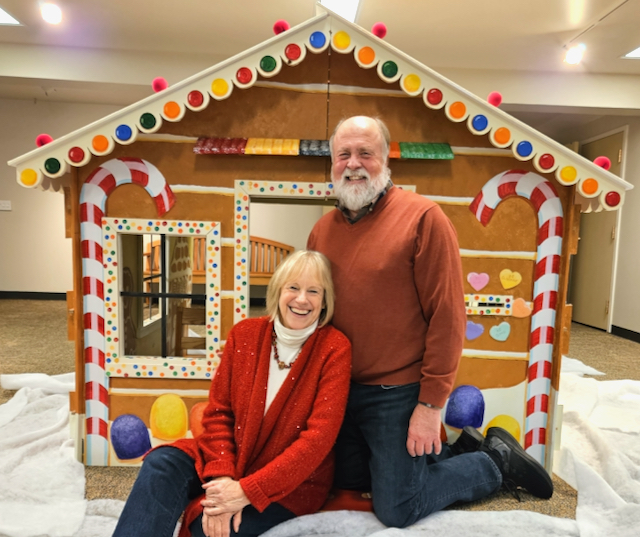
Fort Atkinson residents Trudianne and Gary Thom express their enthusiasm about a newly built and donated holiday-themed children’s playhouse found at the Hoard Historical Museum. The structure was built and donated by Fort Atkinson resident Phil Niemeyer, not pictured, and decorated, with the artist donating her time, by Trudianne Thom. Chris Spangler photo for Fort Atkinson Online.
Obituaries salute firemen killed in 1923 crash
(Originally published Dec. 15, 2023.)
Editor’s note: This is the third in a series of stories which will be published on Fort Atkinson Online documenting the fatal firetruck crash of Dec. 17, 1923, which was described by the then-“Jefferson County Union” as the “worst tragedy in the city’s history.”
By Chris Spangler
Only eight days before Christmas, December 1923 went from merry to mournful.
That was Sunday, Dec. 17, when a firetruck crashed just west of Fort Atkinson while responding to a Rockdale blaze. It claimed the lives of three firemen and injured three others.
“All Fort Atkinson is grief-stricken as a result of the terrible tragedy,” an article in the Dec. 21, 1923, edition of the then-weekly Jefferson County Union read. “Each man who rode the ill-fated truck did so because of his love of duty to the Fort Atkinson Fire Department, as well as his desire to help in time of need.”
The Dec. 28, 1923, issue of the newspaper contained an article with the headline “Fort Atkinson honors its victims of firetruck accident.”
“Not since the ex-Governor W.D. Hoard funeral here on Nov. 25, 1918, has Fort Atkinson paid such honor to its dead as was shown in the last sad rites for the three victims of the terrible firetruck tragedy: Frank Hoffman, Herman Smith and William Gross,” it began.
It reported that 128 firemen representing 15 cities attended the Thursday funerals of Hoffman and Smith. On Sunday, 187 from 16 communities attended Gross’ funeral.
They came from Jefferson, Whitewater, Watertown, Portage, Columbus, Horicon, Oconomowoc, Johnson Creek, Lake Mills, Cambridge, Edgerton, Madison, Janesville, Deerfield, Stoughton and Fort Atkinson.
Among the notables in attendance were William Wipperman, Portage, president of the Wisconsin State Firemen’s Association, and four other officers and former officers of the organization.
Following is obituary information about the firefighters who lost their lives that day. It is gleaned from the Dec. 21 and 28 issues of the Union.
Frank E. Hoffman
Frank E. Hoffman, 42, was secretary and treasurer of the Hoffman Lumber Company, located in 1923 where Ace Hardware now stands. He was co-owner with his brother, Harry.
Born Sept. 20, 1881, he was the son of German immigrant Frank Hoffman (1845-1913) and Amelia Hoffman (1844-1936).
He married Clara V. Barney on Sept. 7, 1904. She died in 1961 at age 79.
According to the Dec. 21, 1923, issue of the Jefferson County Union, they had one daughter, Geraldine. She passed away in 1995.
A member of the Masonic Lodge and Odd Fellows, Hoffman was a member of the fire department for 18 years.
“Frank Hoffman, big strong, healthy Frank Hoffman, was a man of most generous impulses and his great good nature and kindly disposition made him a favorite with all who came in contact with him,” according to the obituary. “As a husband and father, he was all that the best could picture and his home life was happy to the point of ideal.”
It continued: “His taking away in the prime of life and in the shadow of tragedy is indeed a severe blow to his wife and child, and has occasioned deep sorrow within the circle of his relatives and is a loss to the community at large. Sympathy for the bereaved ones is general and unbounded.”
Funeral services were held at the Hoffman home on East Sherman Avenue at 10:30 a.m. Thursday, Dec. 20. Interment was in Evergreen Cemetery.
The Dec. 28 issue of the Union reported that more than 500 people passed through the Hoffman home in the morning, including the 108 visiting firefighters, 71 local firemen, city officials led by Mayor W.H. Weld, 101 Masons and 112 Odd Fellows members. The firemen, Masons and Odd Fellows marched from East Sherman Avenue to the Northside cemetery.
Herman W. Smith
Herman Wesly (sic) Smith, 59, was a local blacksmith known as “Herm” and “a highly respected citizen and businessman.”
Born Sept. 11, 1864, in Rome, he was the son of John Smith (1823-67) and Margaret Landgraf Smith (1828-1918), both German immigrants.
He married Wilhelmina (“Minnie”) Augusta Seavert on May 1, 1890. She died in 1949 at age 81.
Their children included Clifford Wesley Smith (1892-1955) of Milwaukee, Pearl Helen Smith (1894-95) and Cecil Fred Smith (1908-2002) of Fort Atkinson.
Smith resided in Fort Atkinson for 40 years.
“He was an expert at his profession and many a piece of iron has he heated, shaped and hammered in his forge and his anvil,” according to the Jefferson County Union. “When the fire department of the city hall was recently remodeled, it was ‘Herm’ Smith who was called upon to turn out the required iron fittings for the automatic opening doors, etc.
“Probably no man in the city took as much pride in the new fire pumper as did he, and although he had been connected with the fire department for 40 years, being one of the oldest firemen in the city in point of service, his interest in the department never lagged and leisure hours found him at the firehouse waiting for the call to duty,” the article read.
A member of the Masonic Lodge, he also was a member of Hook and Ladder Co. and the (Eureka Hose & Ladder Company) EFU.
Visitation was at his Clarence Street home, followed by funeral services at the Congregational Church. He was buried in Evergreen Cemetery.
On Dec. 28, the Union reported that “the Congregational church was overflowing on Thursday afternoon for Smith’s funeral.” Among the attendees were 128 firemen, 99 Masons, city officials and hundreds of farmers. They also marched to the cemetery afterward.
William M. Gross
William Merit “Bill” Gross, 54, of 217 Edward St., was employed for a number of years by the Northwestern Manufacturing Co. and Creamery Package Co. For the past six months, he had been engaged by the city as a firetruck driver, the article reported.
Born Aug. 8, 1869, in Richmond, Minn., he was the son of Christian Gross (1828-79) and Louise Brandel Gross (1842-1916).
He married Sarah Jane “Jennie” Holden. She died Nov. 4, 1951, at age 85.
Children included Ethel M. Gross Henderson (1892-1945) of Rockford, Ill.; William Theodore Gross (1894-1993) of Milwaukee and Marshall E. Gross (1897-1975) of Fort Atkinson. The obituary referenced four children, but only three were listed.
“Bill Gross was a good-hearted man and a splendid husband and father. Since being appointed truck driver, he had never failed to be on the job at his appointed hours and took a deep interest in the fire department and the equipment, making a thorough study of the new pumper and its fine points of operation,” the obituary read.
The funeral was held Sunday, Dec. 23, with 187 firemen from 16 communities attending.
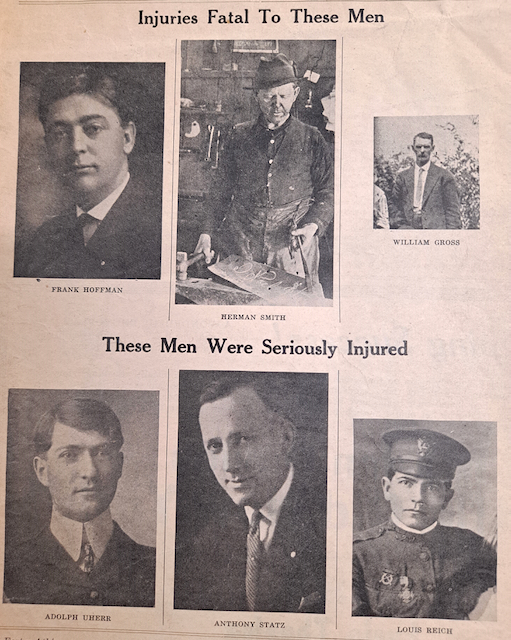
Council awards $14 million Public Works construction project to Clinton-based company
(Originally published Jan. 6, 2024.)
By Chris Spangler
The Fort Atkinson City Council on Thursday chose a Clinton firm to build a new operations facility for the city’s Public Works and Parks departments.
Meeting two days later than usual due to the New Year’s holiday, the council unanimously approved a recommendation by the Janesville architectural firm Angus-Young to award the bid to Gilbank Construction Co. of Clinton.
Gilbank submitted the lowest base construction bid of $11.544 million. A 5% contingency budget of $577,200 brings the total to an estimated $12.12 million.
The other three bidders, submitting contingency proposals, were Miron Construction Co. Inc., Madison/Milwaukee, $11,821,531; Hunzinger Construction Co., Brookfield, $13.169 million; and Joe Daniels Construction Co. Inc., Madison, $13,581,482.
Plans call for building a 79,557-square-foot Public Works and Parks departments operations facility and 900-ton salt storage shed, renovating the Parks Department garage and undertaking associated site improvements.
The work at the current southside facility is being enabled by the scheduled Feb. 1 permanent closure of James Place from Janesville Avenue to Talcott Street.
According to a memo from Angus-Young project architect Brad Werginz, the four base bids for building the project ranged from $11.544 million to $13,581,482, with the two lowest bidders within 2.4% of each other.
“The low bidder … is a highly qualified general contractor with the expertise and experience necessary to construct a quality building for the city of Fort Atkinson,” Werginz wrote. “Most notably, Gilbank Construction completed the Public Works Facility for the City of Delavan in 2020.”
Director of Public Works Andy Selle echoed that sentiment Thursday.
“We were very happy with where these numbers came in,” he said. “The council is probably aware of the $15-$20 million range we’ve been talking about during this process, now going on over a year … I think we’re sitting in a really good spot, frankly, to be on the low end of that by the time we finish this project.”
Along with the construction bid and contingency, project “soft costs” include $1,166,975 for the land, design, utility relocation, permitting and construction oversight. Adding in the $545,000 for furnishings and equipment, the estimated total is $13,833,175.
“We’ve still got a little ways to go, but we’re looking at something under $14 million right now today with our best estimates, and I think that’s something to be proud of …,” Selle said.
He reported that the 5% contingency budget of $577,200 was added to the base bid total to plan for unforeseen situations. The council authorized him and City Manager Rebecca Houseman to approve change orders up to $20,000.
Construction could begin Jan. 22, with substantial completion dates for the salt shed and large-vehicle parking garage of April 16 and Nov. 1, respectively. The project’s final completion date is expected to be June 1, 2025.
Responding to council members’ questions, Selle said the cost of deconstruction of current buildings is included in the Gilbank bid.
“The city residents, I’m sure, will be happy to hear how much lower this has come in …,” council member Eric Schultz said, asking whether Selle felt the project might use less than the 5% contingency.
Selle explained that the city had a 5% contingency for the wastewater treatment plant project and right now, there is about $10,000 left. However, he acknowledged that 5% “is a little tight.”
He said that Werginz had recommended a 10% contingency, but he, Selle, felt that more than $1 million in contingency would be too much.
“We can always come back to the council and say ‘we’ve run into something significant that we didn’t anticipate and we need more,’” he said. “So, to answer your question, no, it might not be enough, but I am comfortable asking for (5%).”
In addition, Selle mentioned that Gilbank also was the low bidder for an on-site truck scale system costing $115,000. However, it was decided to forego the scale at this time.
“We were looking at that for salt management,” Selle said, adding that he spoke with stormwater and state Department of Natural Resources experts who said that any requirement to weigh the amount of salt used during snow- and ice events would be coming “very, very far in the future.”
Council member Kyle Jaeckel, who noted that his family’s company purchased a truck scale about two years ago, agreed that waiting is best.
“Although this did come in well under our budget, this is a huge expense for our city,” Schultz said of the project overall.
However, he pointed out that were the city to do nothing, maintenance of the city garage facilities alone would cost about $5 million.
“This probably is the best financial choice for the long term. As elected members of this community, we asked to not only take a look at what it would cost today or over the course of paying this off, but also what’s the best decision to make for the long term,” Schultz said.
Waiting to undertake the work would be more costly down the road, he added.
Wirginz agreed, saying that he oversaw a project very similar in scope to Fort Atkinson’s in 2017, and now seven years later, its pricetag would be about 50% higher.
“This is a large investment, but it is a multigenerational investment,” council member Mason Becker said.
He noted that some members of the public have asked why this project was not undertaken, say, a decade ago when the facility was starting to have issues.
“You look where the city was economically nine, 10 years ago; we just simply weren’t ready,” Becker said. “It would have been really hard to justify the cost. But now I think we can say that this is a step that the city needs to take and needs to be done.”
He added that city officials did look at other sites, such as the former Loeb-Lorman metal-recycling property, but found that this “is the most fiscally responsible step that we can take right now.”
On a motion by Schultz that was seconded by Jaeckel, the council unanimously voted to award the construction bid to Gilbank and approve the 5% contingency.
Also Thursday, the council approved a recommendation to maintain Angus-Young’s services to guide the city through 480 days of construction.
Council member Davin Lescohier made a motion to hire Angus-Young for construction-period services at a price not to exceed $121,000. This was seconded by Becker and unanimously approved.
Pool heater
Also on Thursday, the council unanimously approved buying a Pentair MegaTherm commercial pool heater from Richter Heating & Air Conditioning of Watertown.
It will be purchased with 2024 Aquatic Center Capital Improvement Project (CIP) funds for a cost not to exceed $35,822.
The second bidder for the pool heater was Neuman Pools of Beaver Dam, with a price of $56,578.80.
Fort Atkinson Parks and Recreation Director Brooke Franseen said she researched the $20,756.80 difference in bids. Potential reasons included a slight difference between switches on the two models that did not affect the heater’s work, the inclusion of a $50,000 service contract by Neuman (the city already uses Richter for service on a case-by-case basis) and the possibility that some companies experiencing labor shortages and/or full calendars might be submitting higher quotes.
Franseen noted that the current Fort Family Aquatic Center pool heater was purchased in 2008.
“Typically, pool heaters have a lifespan of 11 to 15 years, which prompted staff to budget for a new pool heater in the 2024 CIP. At the beginning of the 2023 summer season, the Fort Family Aquatic Center pool heater experienced a malfunction, resulting in a series of disruptions to operations and services,” she said.
“The malfunction prompted staff to engage Richter Heating and Cooling, the city’s pool service contractor, for multiple service calls to address the issues with the heater. During the short time the heater was down, the water was cold, which impacted the overall experience for families enjoying the pool and participants in the swim lessons,” Franseen added.
She noted that several contractors pointed out deficiencies in the current heater, including melting wires and other structural issues that compromise its functionality.
The 2024 CIP budgeted $39,000 for replacing the pool heater. The funding source is the 2024-25 borrowing.
Becker made a motion to purchase the heater from Richter. This was seconded by Lescohier and unanimously approved.
Public comment
Two persons spoke during the meeting’s public comment period Thursday.
John Donohue, 1550 Raveen St., read portions of a letter that the Whitewater Common Council on Dec. 19 decided to send to President Joe Biden and other state and federal elected officials regarding the “challenges” that immigration has placed on law enforcement and city resources as a whole.
Planned to be signed by the Whitewater Police Chief Dan Meyer, City Manager John Weidl and common council members, the letter states that since 2022, the city has seen a rapid increase in the arrival of immigrants from Nicaragua and Venezuela.
“We estimate that there are roughly 800 to 1,000 individuals who have arrived here in that short time. Each individual has a different reason for coming here: some are fleeing a corrupt government, others are simply looking for a better opportunity to prosper. Regardless of the individual situations these people need resources like anyone else, and their arrival has put great strain on our existing resources,” the letter reads.
It states that communication, transportation, housing and documentation/identification concerns are among the top obstacles the city is facing and must address. It also indicates an increase in police traffic stops and criminal behavior.
The letter asks the elected officials for support in the form of direct funding or the ability to apply for a community grant to address these concerns.
“This is a crucial humanitarian issue, and our city needs government assistance in order to continue to serve our entire community properly,” the letter concludes.
The full letter may be found here: http://whitewaterwise.com/wp-content/uploads/2024/01/Letter-to-President-Biden.pdf.
Donohue told the council that Fort Atkinson could face similar problems.
“It may be noted that as a candidate for this city council a year ago, I raised a concern with city staff that it was not a question of if, but a question of when we would experience the various logistical and law enforcement challenges of a sudden shift in our city’s demographics similar to Whitewater and other communities,” Donohue told the Fort Atkinson council.
“It remains, as before, a matter of when — and, of course, how — we are to address the challenges of a sudden demographic shift in our city,” he added.
Donohue warned that the city’s law enforcement, healthcare and first-responder infrastructures will be tested, and pointed out that the city already is experiencing a housing shortfall.
“It would be incumbent on city staff, elected officials, to make clear to our public how the demographic shift will be managed when it occurs,” he said, urging that the discussion start now.
Also speaking was John Hausz, 104 Jefferson St., who encouraged the city council to recite the Pledge of Allegiance at the start of each meeting.
Stating that both the school and county boards do it, he presented the council with a resolution he drafted to that effect.
Hausz also listed “things that I have noticed in the previous administration that have never been taken care of.”
He mentioned the decision to place steel lightpoles along Madison Avenue and an invasive plant growing on what Hausz called the “Shah property,” the residential subdivision located in the area behind Kwik Trip, Culver’s and Pick ’n Save.
“Another mistake that the previous administration made — and this may have been the school board or MATC — (was that) they put up them windmill generators. Boy, that was a real winner, wasn’t it?” Hausz said. “I actually watched one blow up while I was driving by one day.”
Other business
In other business Thursday, the council:
• Learned that Parks and Recreation Department Director Brooke Franseen is leaving to accept a position with the School District of Clinton.
“Brooke has done an incredible job in her role for the past four years, and behalf of the city council and staff, I wish her success in her new position,” City Manager Houseman said.
She said that it is expected that the open position will be posted in the next few weeks.
• Saluted Fort Atkinson Police Office Ryan Walters on being the 33rd State Assembly District’s 2023 “First Responder of the Year.” A story will soon be published about the recognition of Walters.
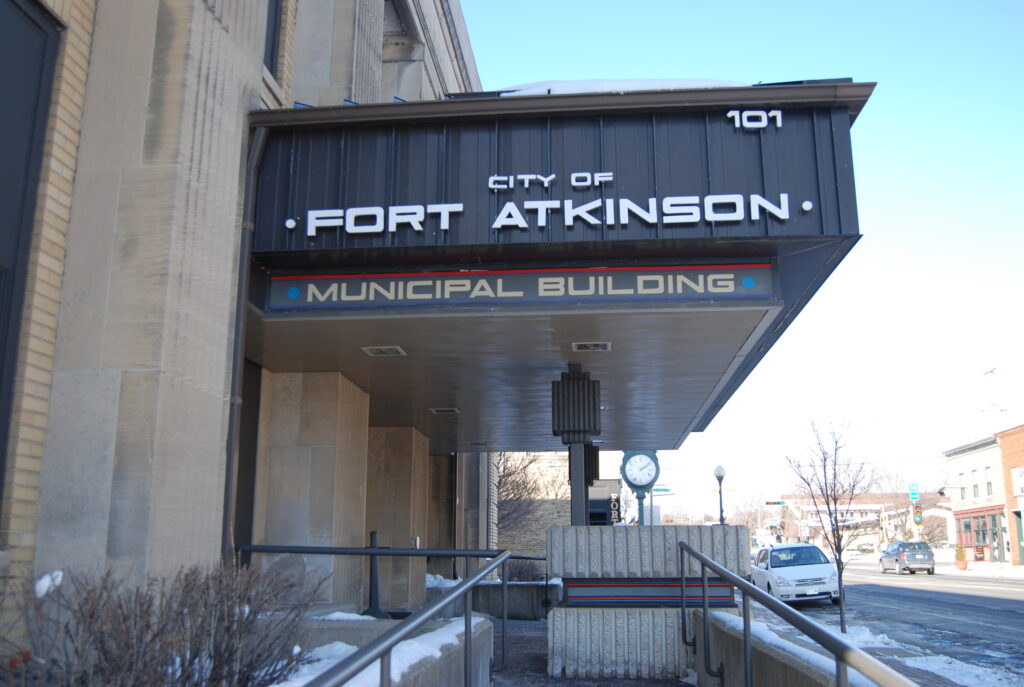
Fort Atkinson Municipal Building, file photo/Kim McDarison.
Fort resident, UW-Whitewater housing director, Tumbarello, receives distinguished service award
(Originally published Jan. 24, 2024.)
Editor’s note: The following story was submitted for publication by the University of Wisconsin-Whitewater marketing and communication department.
Fort Atkinson resident and Executive Director of University Housing at UW-Whitewater Terry Tumbarello’s typical day at the office is often atypical to any other day he’s had in his 26 years on the university’s campus.
On a November morning following the Thanksgiving break, his meeting topics included esports, university dining, budget, and a discussion with a student about the heating in their dorm room.
“On any given week, you could look at my calendar, and I think you’d be shocked at the types of meetings I have,” said Tumbarello, who is in his second year as executive director of University Housing.
“Every day is different, and I love that.”
Thanks to his knack for tackling a vast array of situations and challenges, coupled with his ability to lead a department that continues to evolve to meet student needs, Tumbarello earned one of the highest honors given to housing and residence life professionals in higher education.
Last November, he was announced as winner of the William B. Sweet Distinguished Service Award from the Upper Midwest Region-Association of College and University Housing Officers (UMR-ACUHO) at the organization’s annual conference. The Upper Midwest Region includes Iowa, Kansas, Minnesota, Missouri, Nebraska, North Dakota, South Dakota, Wisconsin and the Canadian province of Manitoba.
The organization’s most prestigious honor, the award is given to an individual who represents a standard of excellence through contributions and dedication to the regional and international housing association and profession. The winner’s service should leave a positive and lasting impact, and they should be viewed as a role model for colleagues and new professionals.
Tumbarello received nominations from four different people on four different campuses in three different states, including former UW-Whitewater colleague Greg Thompson, who now works as director of residence education at the University of Iowa.
“It’s humbling and flattering — a tremendous honor,” Tumbarello said. “I was thrilled that it was done at the conference when I could have some of our staff present.”
Thompson met Tumbarello at a UMR-ACUHO conference and worked with him as a coordinator for leadership and academic initiatives at UW-Whitewater during the 2006-07 academic year.
“When I reflect on the legacy of Bill Sweet, and the intent of this prestigious award, I can think of no one more deserving than Terry,” Thompson wrote in the nomination. “He has dedicated his life, his passion and his time to the advancement of housing as a professional field.”
Housing that supports academic success and personal growth
As executive director, Tumbarello’s main responsibilities include planning and directing the administrative operation, financial affairs, and programmatic aspects of University Housing, including room assignments, support services, staffing and training, educational programming, facility renovation, policy/procedure development, and central office management team supervision. Tumbarello is no stranger to university leadership positions — he served as interim dean of students in 2015-16.
While the upkeep, maintenance and renovation of each residence hall remains a priority, University Housing supports student success on a day-to-day basis through a robust slate of programming.
Tumbarello and his team oversee UW-Whitewater’s Boxes and Walls program, an interactive diversity experience created for the campus community that encourages people to think outside of the box by throwing away stereotypes and tearing down walls of oppression. Boxes and Walls was recognized in 2020 by the National Association of Student Personnel Administrators (NASPA) with the Region IV Equity, Diversity & Inclusion Award.
The 2023 programming, which was held Oct. 15-19 at Esker Hall, showcased Black, LGBTQ+, mental health, physical disability and LatinX experiences. Each experience was designed to allow participants to feel and/or sense what life is like from those various diverse perspectives.
“It continues to evolve every year to meet the needs of students,” Tumbarello said.
UW-Whitewater’s Learning Community program, a collaboration among University Housing, the First Year Experience office and several academic programs, invites first-year students to live and study with peers who share similar interests and includes 17 communities in 2023-24.
“It’s a tremendous experience for those students,” Tumbarello said of the program.
The Learning Community concept was also recently developed for students who are enrolled at UW-Whitewater at Rock County and living in the residence halls on the Whitewater campus.
“Most years we have anywhere from 100 to 115 students from Rock,” Tumbarello said. “This year, for the first year ever, we created a special living option for those students to live together in a particular residence hall so we could put targeted programming and support services to better meet their needs.”
University Housing also supports academic success center programming in Wells Hall, where more than 1,200 students live; Jitters, a coffee house run by student volunteers that’s open 5-6 nights per week; and the campus’s recently-launched esports studio, which is located in Wells and is also supported by the university’s Center for Inclusive Transition, Education, and Employment (CITEE).
According to recent surveys, residents are consistently satisfied with their on-campus housing experience at UW-Whitewater. University Housing rated highly when compared to its peer institutions, and residents were particularly satisfied with the department’s ability to:
• Enhance their ability to live cooperatively
• Respect other students
• Help them interact with residents who are different from them (i.e., race, gender, beliefs)
• Enhance their ability to use campus resources to support their academic success
“Our students indicate that they find it to be a significant value,” Tumbarello added. “They tell us that it positively contributes to their learning and their ability to be academically successful here.”
A campus that cares
Tumbarello’s people-centric approach carries over to the University Housing team, which includes 60 full-time staff members, 10 graduate assistants and more than 400 student assistants. University Housing is “on the clock” year-round, underscoring the importance of a unified, organized staff.
“We continue to have really high luck in recruiting and retaining and attracting the most talented staff in the country,” Tumbarello said.
He estimates that more than 50 former University Housing staff members are currently employed at other institutions around the country in housing, residence life or student affairs. Several of them were on hand as he received his distinguished service award last month.
“In my time here, I’ve had more than 300 grad assistants graduate and matriculate to other student affairs positions and housing positions all over the country,” Tumbarello said.
Last summer, University Housing held a reunion — more than 100 current and former staff members attended, including all five of the department’s directors and all 15 of the associate directors who’ve worked at UW-Whitewater over the last 50 years.
“We had a couple who were RAs together at Wells in 1971 who are married, we had people who graduated last year, and we had everything in between,” Tumbarello said.
The loyalty of current and former staff members reflects Tumbarello, who has built a legacy of excellence in Whitewater with his vast network of current and former employees through programming and facility renovations that contribute to the university’s vibrant campus life.
“We care about our students,” Tumbarello said. “It’s not just lip service or buzz words or taglines. We truly care. I’ve never, ever once felt that we weren’t making a difference. I think that’s likely what keeps me going.”

Terry Tumbarello
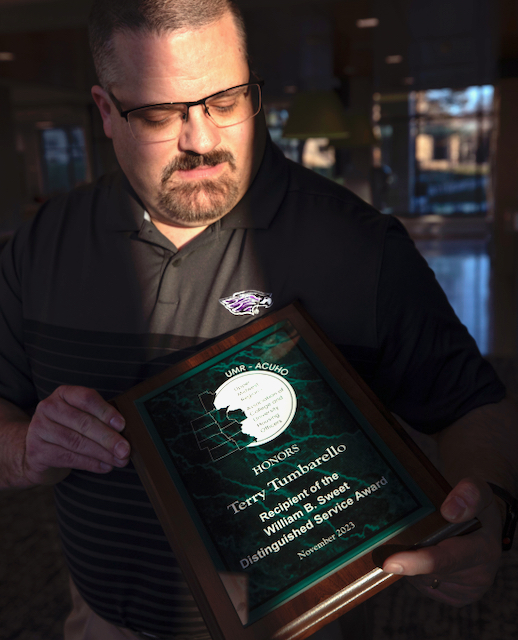
Fort Atkinson resident and Executive Director of University Housing at UW-Whitewater Terry Tumbarello displays his William B. Sweet Distinguished Service Award from the Upper Midwest Region-Association of College and University Housing Officers. The Upper Midwest Region includes Iowa, Kansas, Minnesota, Missouri, Nebraska, North Dakota, South Dakota, Wisconsin and the Canadian province of Manitoba. Tumbarello was presented with the award late last year.
Photos courtesy of UW-Whitewater/Craig Schreiner.